Glossary
Plant Care Library
S
Sago Palm
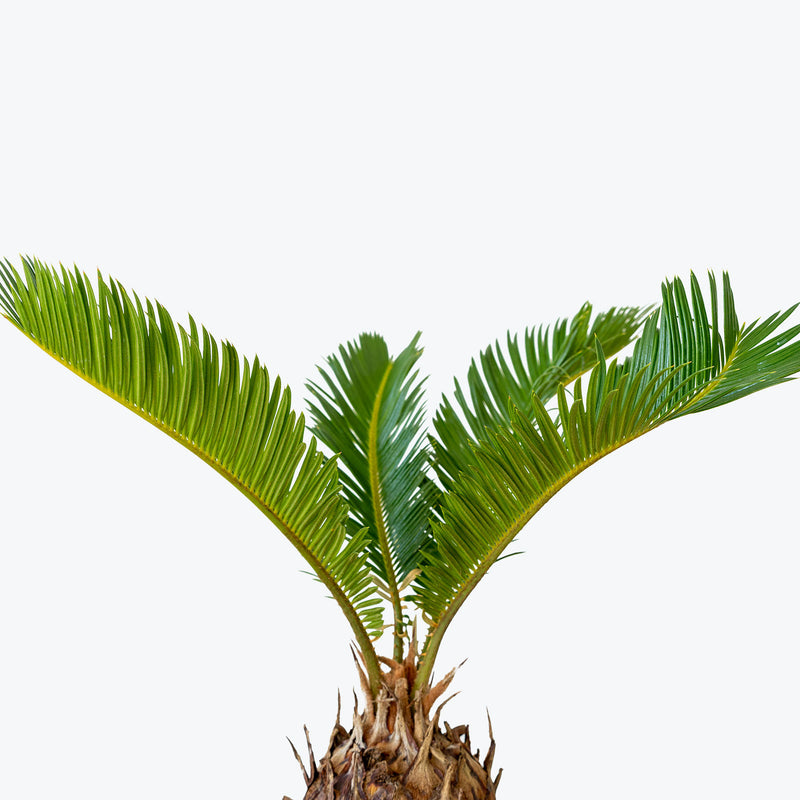
How to care for Sago Palm
They enjoy some direct sun, but they'll also do well in bright, indirect light. It is best to place this plant somewhere where it will receive some nice morning sun, or a couple hours of afternoon sun, and then indirect light the rest of the day.
They will thrive in bright light, but also can tolerate medium light. A good medium-light place in your home would be in the middle of a room that has a regular size window. They can be placed anywhere between the middle of the room and the window. Remember that plants will grow based on how much light they receive.
They like the soil to be relatively dry before the next watering. That usually takes about 2 weeks in an average home environment. It will vary depending on the time of year, your environment and lighting conditions, but for them, it's always safer to underwater or water when you see signs of lack of water (i.e. droopy, floppy, or soft leaves). Expect to water more often in brighter light and less often in lower light.
They can live in any average home humidity condition and are fairly hardy.
Sago palms are extremely slow-growing and often put out only one new frond each year. It can easily take a sago palm five or six years to achieve its full pot size of 2 feet. Also, they are poisonous, so keep them out of reach of inquisitive children and pets.
This plant is extremely toxic to pets and should not be kept around any animals that have a tendency to eat houseplants as it will lead to severe reactions..
Learn MoreView PlantSansevieria Bantel's Sensation
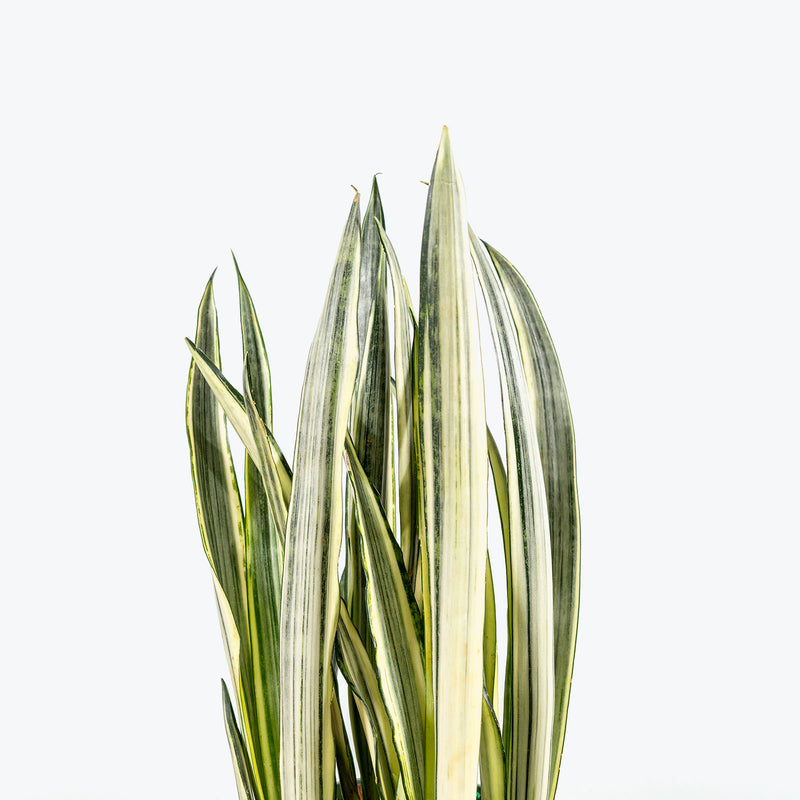
How to care for Sansevieria Bantel's Sensation
Sansevieria Bantel's Sensation should not be in a position to see the sun directly, although early morning or late evening sun is fine. Filtered sunlight through a sheer curtain is best and most homes are comprised primarily of indirect sunlight. The best spot for them is where they do not see the sun during the majority of the day but still get bright, indirect light.
Sansevieria Bantel's Sensation will do well in low light, but will grow faster with brighter light. A low light plant can pretty much survive anyplace inside your home as long as you have a window in the room. Remember, low light does not mean no light and plants will grow based on how much light they receive.
Sansevieria Bantel's Sensation likes the soil to be completely dry before the next watering. That usually takes about 4 weeks in an average home environment. It will vary depending on the time of year, your environment and lighting conditions, but for them, it's always safer to underwater or water when you see signs of lack of water (i.e. wrinkly or soft leaves). Water a little more often in the warmer months.
Their humidity requirement is low, so do not mist Sansevieria Bantel's Sensation or put them in a terrarium.
Sansevieria Bantel's Sensation is super easy to take care of, being able to handle all kinds of light levels and is known for its air-purifying capabilities. Just make sure to not overwater them and try not to let water sit between their leaves. Some dry tips are completely normal on Snake Plants. Repot only when the plant has outgrown its container, which is generally every few years. Use a well-draining potting mix specifically designed for succulents or cacti.
Sansevieria Bantel's Sensation is moderately toxic and can cause some adverse reactions when ingested so it is best to not let your pets eat it, which we advise for all plants in general. The severity of the reaction will depend on how much of the plant is ingested but, if you know your pet typically does not eat your plants, this plant will be suitable for your home..
Learn MoreView PlantSansevieria Black Coral
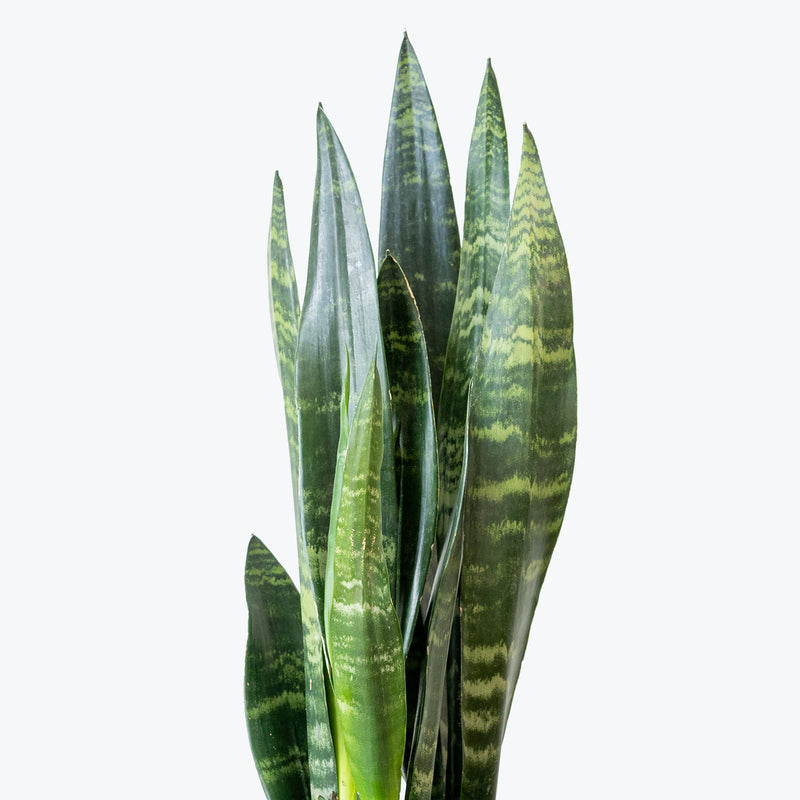
How to care for Sansevieria Black Coral
Sansevieria Black Coral should not be in a position to see the sun directly, although early morning or late evening sun is fine. Filtered sunlight through a sheer curtain is best and most homes are comprised primarily of indirect sunlight. The best spot for them is where they do not see the sun during the majority of the day but still get bright, indirect light.
Sansevieria Black Coral will do well in low light, but will grow faster with brighter light. A low light plant can pretty much survive anyplace inside your home as long as you have a window in the room. Remember, low light does not mean no light and plants will grow based on how much light they receive.
Sansevieria Black Coral likes the soil to be completely dry before the next watering. That usually takes about 4 weeks in an average home environment. It will vary depending on the time of year, your environment and lighting conditions, but for them, it's always safer to underwater or water when you see signs of lack of water (i.e. wrinkly or soft leaves). Water a little more often in the warmer months.
Sansevieria Black Coral humidity requirement is low, so do not mist them or put them in a terrarium.
Sansevieria Black Coral is super easy to take care of, being able to handle all kinds of light levels and is known for their air-purifying capabilities. Just make sure to not overwater them and try not to let water sit between their leaves. Some dry tips are completely normal on Snake Plants.
Sansevieria Black Coral is moderately toxic and can cause some adverse reactions when ingested so it is best to not let your pets eat it, which we advise for all plants in general. The severity of the reaction will depend on how much of the plant is ingested but, if you know your pet typically does not eat your plants, this plant will be suitable for your home..
Learn MoreView PlantSansevieria Black Dragon
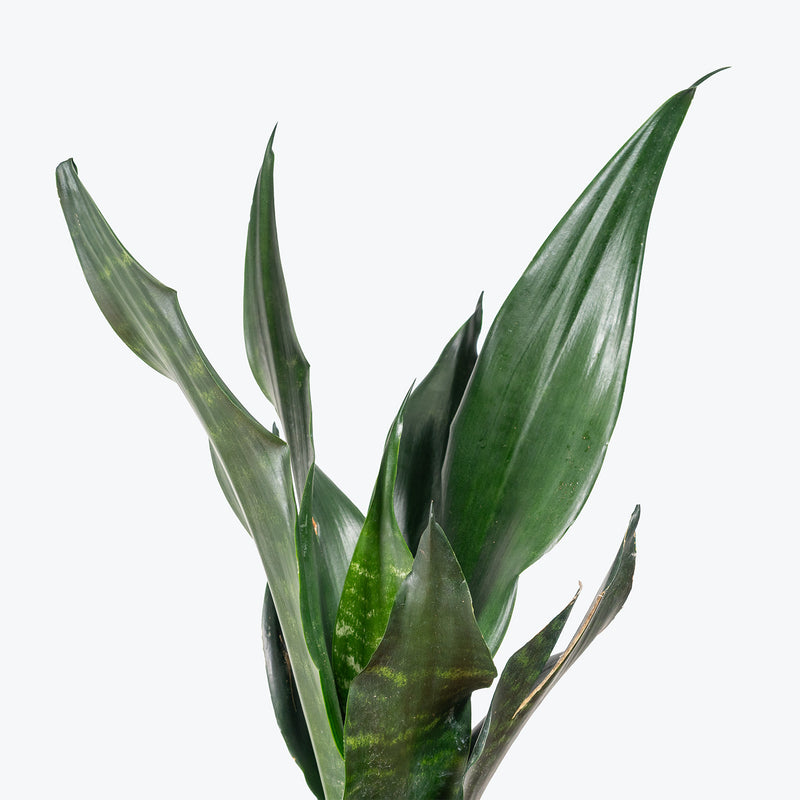
How to care for Sansevieria Black Dragon
Sansevieria Black Dragon should not be in a position to see the sun directly, although early morning or late evening sun is fine. Filtered sunlight through a sheer curtain is best and most homes are comprised primarily of indirect sunlight. The best spot for them is where they do not see the sun during the majority of the day but still get bright, indirect light.
Sansevieria Black Dragon will do well in low light, but will grow faster with brighter light. A low light plant can pretty much survive anyplace inside your home as long as you have a window in the room. Remember, low light does not mean no light and plants will grow based on how much light they receive.
Sansevieria Black Dragon likes the soil to be completely dry before the next watering. That usually takes about 4 weeks in an average home environment. It will vary depending on the time of year, your environment and lighting conditions, but for them, it's always safer to underwater or water when you see signs of lack of water (i.e. wrinkly or soft leaves). Water a little more often in the warmer months.
Sansevieria Black Dragon can live in any average home humidity condition and are fairly hardy.
Use a fast-draining cactus or succulent soil mix to prevent root rot. Fertilize lightly once or twice per year during spring and summer. Wipe leaves occasionally to maintain their glossy, dark sheen. Sansevieria Black Dragon is extremely hardy and doubles as a natural air purifier, making it perfect for low-maintenance plant lovers.
Sansevieria Black Dragon is moderately toxic and can cause some adverse reactions when ingested so it is best to not let your pets eat it, which we advise for all plants in general. The severity of the reaction will depend on how much of the plant is ingested but, if you know your pet typically does not eat your plants, this plant will be suitable for your home..
Learn MoreView PlantSansevieria Black Gold
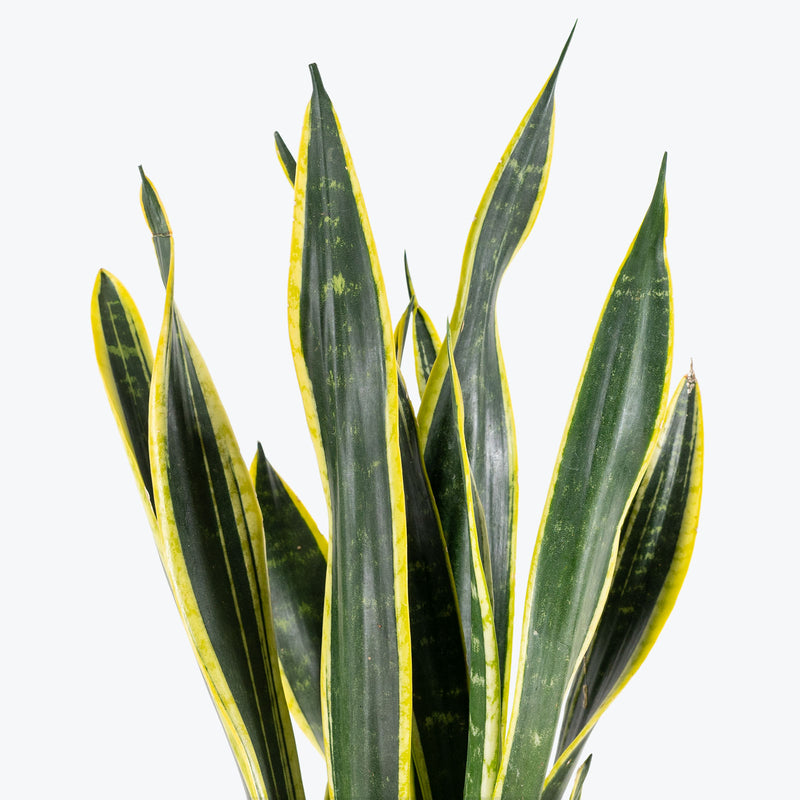
How to care for Sansevieria Black Gold
They should not be in a position to see the sun directly, although early morning or late evening sun is fine. Filtered sunlight through a sheer curtain is best and most homes are comprised primarily of indirect sunlight. The best spot for them is where they do not see the sun during the majority of the day but still get bright, indirect light.
They will do well in low light, but will grow faster with brighter light. A low light plant can pretty much survive anyplace inside your home as long as you have a window in the room. Remember, low light does not mean no light and plants will grow based on how much light they receive.
They like the soil to be completely dry before the next watering. That usually takes about 4 weeks in an average home environment. It will vary depending on the time of year, your environment and lighting conditions, but for them, it's always safer to underwater or water when you see signs of lack of water (i.e. wrinkly or soft leaves). Water a little more often in the warmer months.
Their humidity requirement is low, so do not mist them or put them in a terrarium.
They are super easy to take care of, being able to handle all kinds of light levels and are known for their air-purifying capabilities. Just make sure to not overwater them and try not to let water sit between their leaves. Some dry tips are completely normal on Snake Plants.
This plant is moderately toxic and can cause some adverse reactions when ingested so it is best to not let your pets eat it, which we advise for all plants in general. The severity of the reaction will depend on how much of the plant is ingested but, if you know your pet typically does not eat your plants, this plant will be suitable for your home..
Learn MoreView PlantSansevieria Boncel Variegata
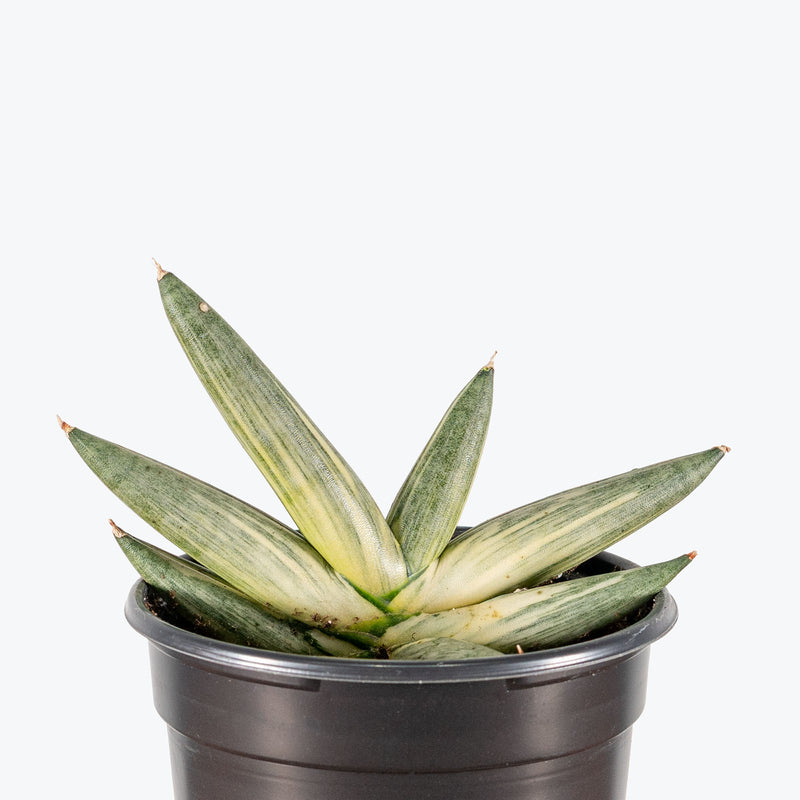
How to care for Sansevieria Boncel Variegata
Sansevieria Boncel Variegata should not be in a position to see the sun directly, although early morning or late evening sun is fine. Filtered sunlight through a sheer curtain is best and most homes are comprised primarily of indirect sunlight. The best spot for them is where they do not see the sun during the majority of the day but still get bright, indirect light.
Sansevieria Boncel Variegata will do well in low light, but will grow faster with brighter light. A low light plant can pretty much survive anyplace inside your home as long as you have a window in the room. Remember, low light does not mean no light and plants will grow based on how much light they receive.
Sansevieria Boncel Variegata likes the soil to be completely dry before the next watering. That usually takes about 4 weeks in an average home environment. It will vary depending on the time of year, your environment and lighting conditions, but for them, it's always safer to underwater or water when you see signs of lack of water (i.e. wrinkly or soft leaves). Water a little more often in the warmer months.
Their humidity requirement is low, so do not mist Boncel Variegata or put them in a terrarium.
Sansevieria Boncel Variegata is super easy to take care of, being able to handle all kinds of light levels and are known for their air-purifying capabilities. Just make sure to not overwater them and try not to let water sit between their leaves. Avoid over-fertilization as this can harm the plant. Occasionally wipe the leaves with a damp cloth to remove dust and enhance the plant's appearance. This practice also helps in preventing pest infestations. Some dry tips are completely normal on Snake Plants.
Sansevieria Boncel Variegata is moderately toxic and can cause some adverse reactions when ingested so it is best to not let your pets eat it, which we advise for all plants in general. The severity of the reaction will depend on how much of the plant is ingested but, if you know your pet typically does not eat your plants, this plant will be suitable for your home..
Learn MoreView PlantSansevieria Canary
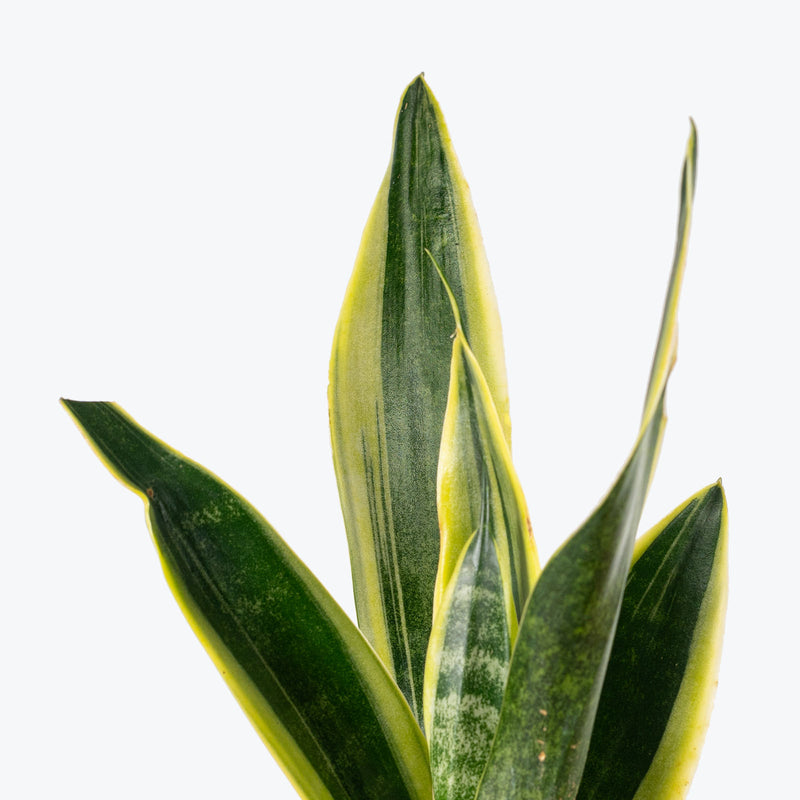
How to care for Sansevieria Canary
Sansevieria Canary should not be in a position to see the sun directly, although early morning or late evening sun is fine. Filtered sunlight through a sheer curtain is best and most homes are comprised primarily of indirect sunlight. The best spot for them is where they do not see the sun during the majority of the day but still get bright, indirect light.
Sansevieria Canary will do well in low light, but will grow faster with brighter light. A low light plant can pretty much survive anyplace inside your home as long as you have a window in the room. Remember, low light does not mean no light and plants will grow based on how much light they receive.
Sansevieria Canary likes the soil to be completely dry before the next watering. This can take up to 4 weeks in an average home environment but it will vary depending on the time of year, your environment and lighting conditions. For them, it's always safer to underwater or water when you see signs of lack of water (i.e. wrinkly or soft leaves). Water a little more often in the warmer months.
Sansevieria Canary can live in any average home humidity condition and are fairly hardy.
Sansevieria Canary doesn't require frequent repotting, as it prefers to be slightly root-bound. Ensure proper drainage and use well-draining soil to prevent root rot. To maintain the plant's health and appearance, remove any dead or yellowing leaves as needed. Be cautious when handling the leaves, as they can be sharp. Fertilize with a general-purpose houseplant fertilizer at half-strength once or twice during the growing season (spring and summer). Avoid fertilizing in the fall and winter when the plant's growth naturally slows. Wipe the leaves with a damp cloth occasionally to remove dust.
Sansevieria Canary is moderately toxic and can cause some adverse reactions when ingested so it is best to not let your pets eat it, which we advise for all plants in general. The severity of the reaction will depend on how much of the plant is ingested but, if you know your pet typically does not eat your plants, this plant will be suitable for your home..
Learn MoreView PlantSansevieria Chanin
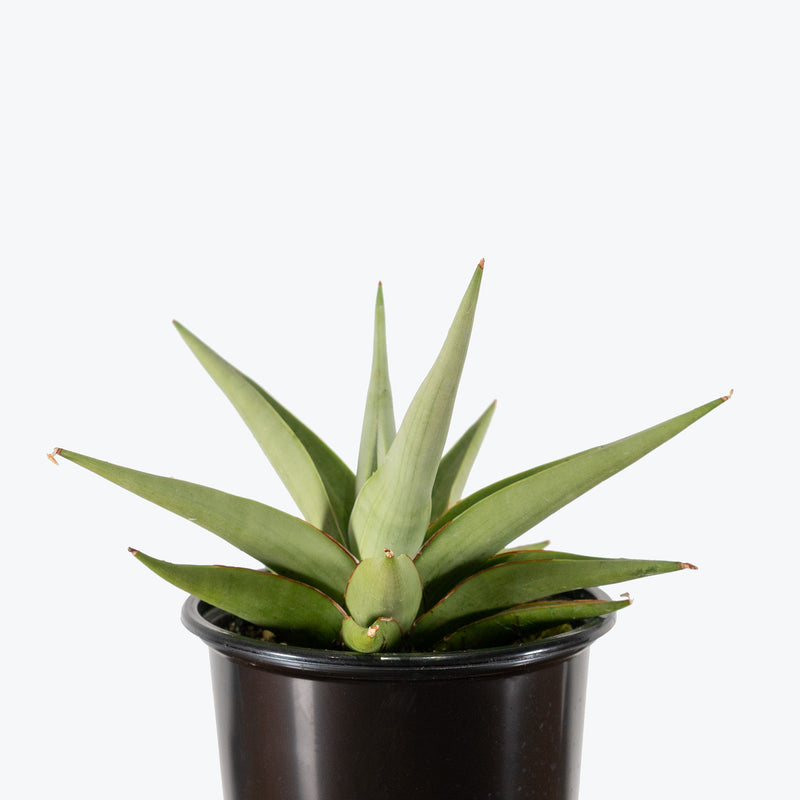
How to care for Sansevieria Chanin
Sansevieria Chanin should not be in a position to see the sun directly, although early morning or late evening sun is fine. Filtered sunlight through a sheer curtain is best and most homes are comprised primarily of indirect sunlight. The best spot for them is where they do not see the sun during the majority of the day but still get bright, indirect light.
Sansevieria Chanin will do well in low light, but will grow faster with brighter light. A low light plant can pretty much survive anyplace inside your home as long as you have a window in the room. Remember, low light does not mean no light and plants will grow based on how much light they receive.
Sansevieria Chanin likes the soil to be completely dry before the next watering. This can take up to 4 weeks in an average home environment but it will vary depending on the time of year, your environment and lighting conditions. For them, it's always safer to underwater or water when you see signs of lack of water (i.e. wrinkly or soft leaves). Water a little more often in the warmer months.
Their humidity requirement is low, so do not mist Sansevieria Chanin or put them in a terrarium.
Sansevieria Chanin is super easy to take care of. It can handle all kinds of light levels and is known for its air-purifying capabilities. Just make sure not to overwater it and try not to let water sit between its leaves. Clean the leaves occasionally with a soft, dry cloth to maintain their matte texture and appearance. Be mindful of pests such as spider mites and treat as necessary.
Sansevieria Chanin is moderately toxic and can cause some adverse reactions when ingested so it is best to not let your pets eat it, which we advise for all plants in general. The severity of the reaction will depend on how much of the plant is ingested but, if you know your pet typically does not eat your plants, this plant will be suitable for your home..
Learn MoreView PlantSansevieria Cleopatra
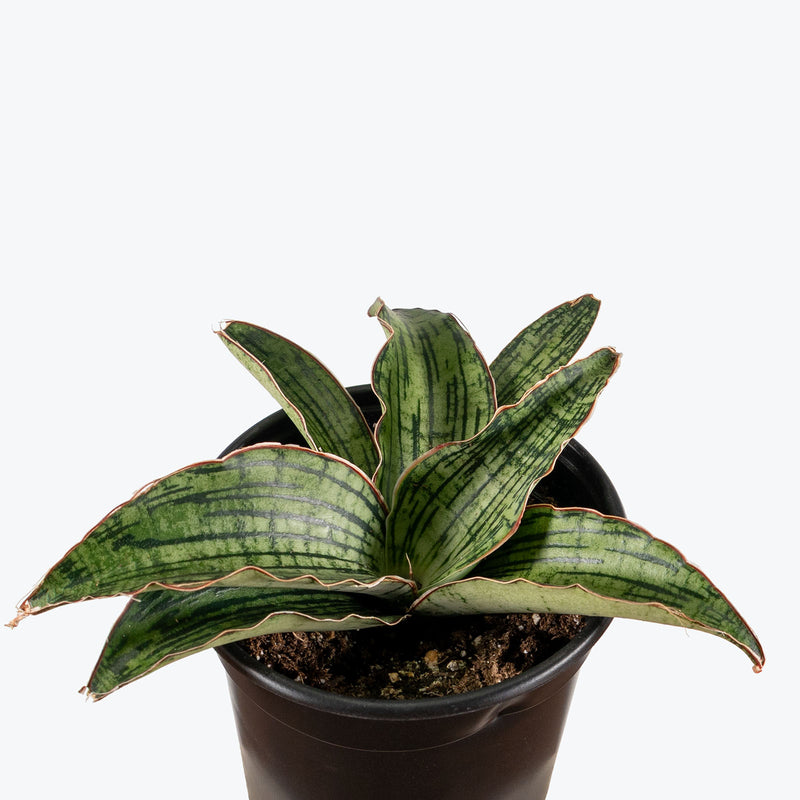
How to care for Sansevieria Cleopatra
Sansevieria Cleopatra should not be in a position to see the sun directly, although early morning or late evening sun is fine. Filtered sunlight through a sheer curtain is best and most homes are comprised primarily of indirect sunlight. The best spot for them is where they do not see the sun during the majority of the day but still get bright, indirect light.
Sansevieria Cleopatra will do well in low light, but will grow faster with brighter light. A low light plant can pretty much survive anyplace inside your home as long as you have a window in the room. Remember, low light does not mean no light and plants will grow based on how much light they receive.
Sansevieria Cleopatra likes the soil to be completely dry before the next watering. This can take up to 4 weeks in an average home environment but it will vary depending on the time of year, your environment and lighting conditions. For them, it's always safer to underwater or water when you see signs of lack of water (i.e. wrinkly or soft leaves). Water a little more often in the warmer months.
Sansevieria Cleopatra can live in any average home humidity condition and are fairly hardy.
Use a sandy, well-draining soil mix to mimic its arid origins. Rotate Sansevieria Cleopatra occasionally to keep the rosette symmetrical. Slow growing by nature, but patience is rewarded with beautifully patterned, long-lasting foliage. An excellent choice for low-maintenance collectors.
Sansevieria Cleopatra is moderately toxic and can cause some adverse reactions when ingested so it is best to not let your pets eat it, which we advise for all plants in general. The severity of the reaction will depend on how much of the plant is ingested but, if you know your pet typically does not eat your plants, this plant will be suitable for your home..
Learn MoreView PlantSansevieria Cylindrica
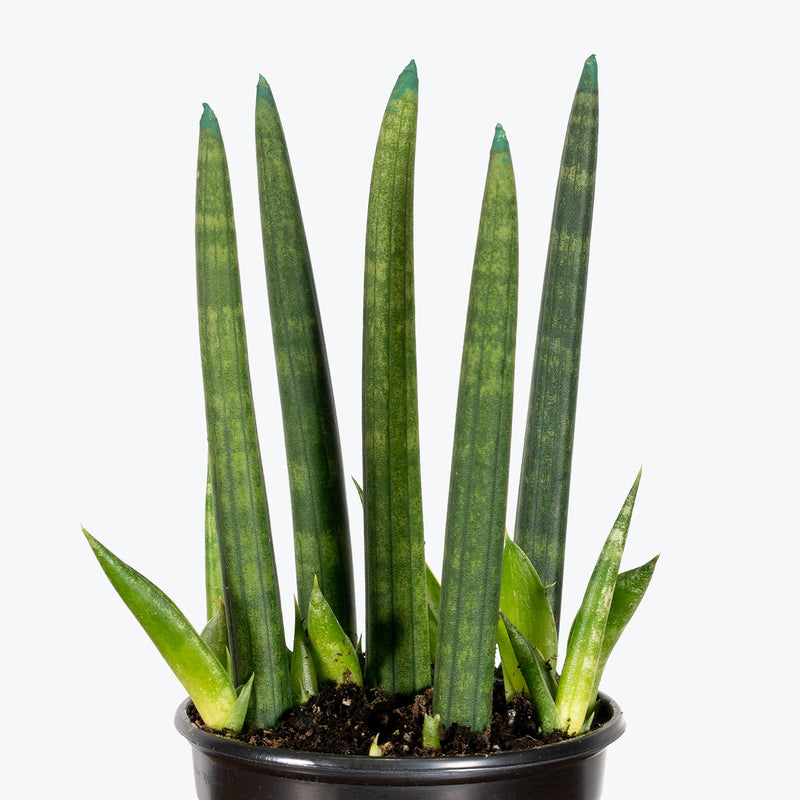
How to care for Sansevieria Cylindrica
They should not be in a position to see the sun directly, although early morning or late evening sun is fine. Filtered sunlight through a sheer curtain is best and most homes are comprised primarily of indirect sunlight. The best spot for them is where they do not see the sun during the majority of the day but still get bright, indirect light.
They will do well in low light, but will grow faster with brighter light. A low light plant can pretty much survive anyplace inside your home as long as you have a window in the room. Remember, low light does not mean no light and plants will grow based on how much light they receive.
They like the soil to be completely dry before the next watering. This can take up to 4 weeks in an average home environment but it will vary depending on the time of year, your environment and lighting conditions. For them, it's always safer to underwater or water when you see signs of lack of water (i.e. wrinkly or soft leaves). Water a little more often in the warmer months.
Their humidity requirement is low, so do not mist them or put them in a terrarium.
They are super easy to take care of and able to handle all kinds of light levels, just make sure to not overwater them and try not to let water sit between their leaves. Some dry tips are completely normal on Snake Plants and they are actually known for their air-purifying capabilities.
This plant is moderately toxic and can cause some adverse reactions when ingested so it is best to not let your pets eat it, which we advise for all plants in general. The severity of the reaction will depend on how much of the plant is ingested but, if you know your pet typically does not eat your plants, this plant will be suitable for your home..
Learn MoreView PlantSansevieria Cylindrica Braid
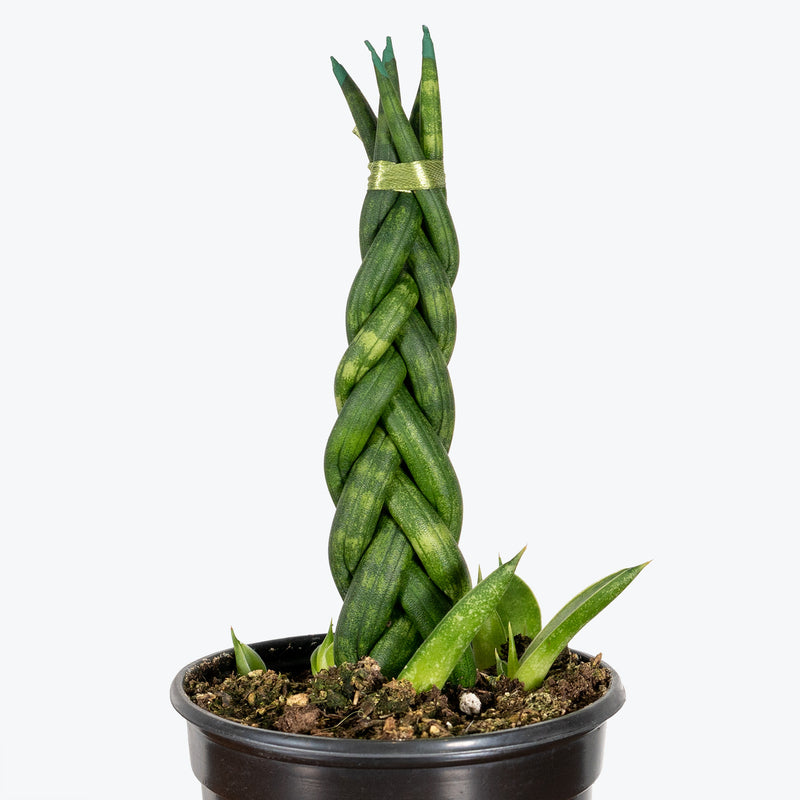
How to care for Sansevieria Cylindrica Braid
They should not be in a position to see the sun directly, although early morning or late evening sun is fine. Filtered sunlight through a sheer curtain is best and most homes are comprised primarily of indirect sunlight. The best spot for them is where they do not see the sun during the majority of the day but still get bright, indirect light.
They will do well in low light, but will grow faster with brighter light. A low light plant can pretty much survive anyplace inside your home as long as you have a window in the room. Remember, low light does not mean no light and plants will grow based on how much light they receive.
They like the soil to be completely dry before the next watering. This can take up to 4 weeks in an average home environment but it will vary depending on the time of year, your environment and lighting conditions. For them, it's always safer to underwater or water when you see signs of lack of water (i.e. wrinkly or soft leaves). Water a little more often in the warmer months.
Their humidity requirement is low, so do not mist them or put them in a terrarium.
The braided variety will have to be maintained and rebraided together as the plant grows. New growth that comes up from the soil will not be braided but it can either be removed or allowed to grow a little wild. Snake Plants are super easy to take care of and able to handle all kinds of light levels, just make sure to not overwater them and try not to let water sit between their leaves. Some dry tips are completely normal!
This plant is moderately toxic and can cause some adverse reactions when ingested so it is best to not let your pets eat it, which we advise for all plants in general. The severity of the reaction will depend on how much of the plant is ingested but, if you know your pet typically does not eat your plants, this plant will be suitable for your home..
Learn MoreView PlantSansevieria Cylindrica Spaghetti
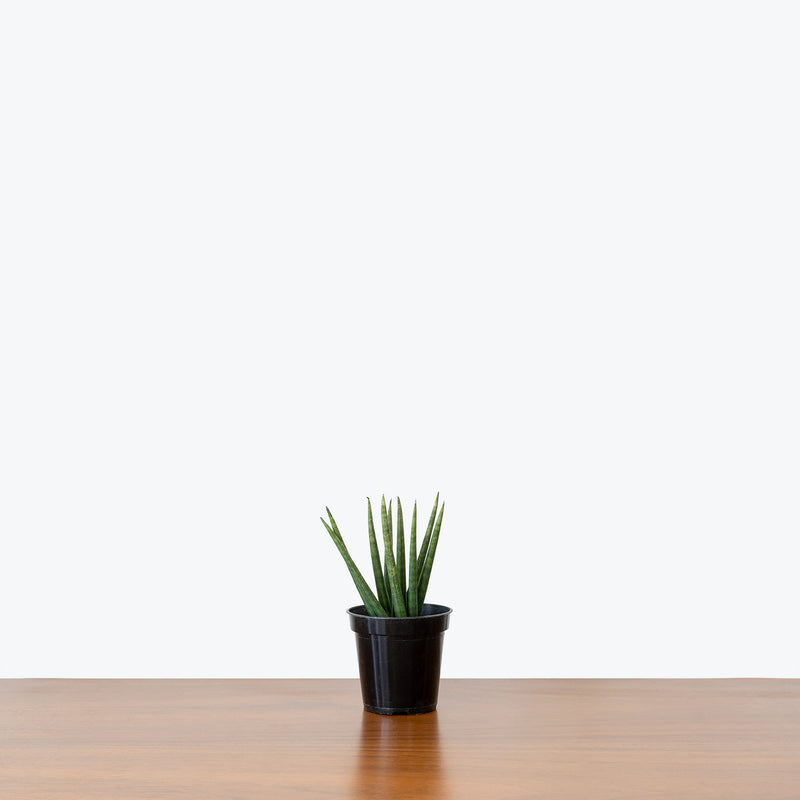
How to care for Sansevieria Cylindrica Spaghetti
They should not be in a position to see the sun directly, although early morning or late evening sun is fine. Filtered sunlight through a sheer curtain is best and most homes are comprised primarily of indirect sunlight. The best spot for them is where they do not see the sun during the majority of the day but still get bright, indirect light.
They will do well in low light, but will grow faster with brighter light. A low light plant can pretty much survive anyplace inside your home as long as you have a window in the room. Remember, low light does not mean no light and plants will grow based on how much light they receive.
They like the soil to be completely dry before the next watering. That usually takes about 4 weeks in an average home environment. It will vary depending on the time of year, your environment and lighting conditions, but for them, it's always safer to underwater or water when you see signs of lack of water (i.e. wrinkly or soft leaves). Water a little more often in the warmer months.
Their humidity requirement is low, so do not mist them or put them in a terrarium.
They are super easy to take care of, being able to handle all kinds of light levels and are known for their air-purifying capabilities. Just make sure to not overwater them and try not to let water sit between their leaves. Some dry tips are completely normal on Snake Plants.
This plant is moderately toxic and can cause some adverse reactions when ingested so it is best to not let your pets eat it, which we advise for all plants in general. The severity of the reaction will depend on how much of the plant is ingested but, if you know your pet typically does not eat your plants, this plant will be suitable for your home..
Learn MoreView PlantSansevieria Dwarf Starfish
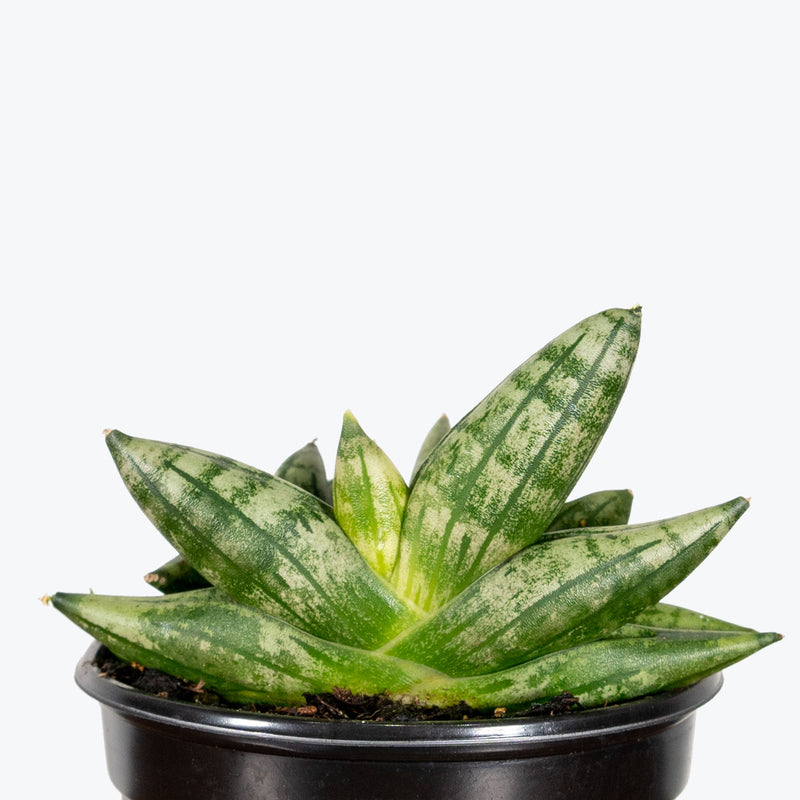
How to care for Sansevieria Dwarf Starfish
Sansevieria Dwarf Starfish should not be in a position to see the sun directly, although early morning or late evening sun is fine. Filtered sunlight through a sheer curtain is best and most homes are comprised primarily of indirect sunlight. The best spot for them is where they do not see the sun during the majority of the day but still get bright, indirect light.
Sansevieria Dwarf Starfish will do well in low light, but will grow faster with brighter light. A low light plant can pretty much survive anyplace inside your home as long as you have a window in the room. Remember, low light does not mean no light and plants will grow based on how much light they receive.
Sansevieria Dwarf Starfish likes the soil to be completely dry before the next watering. That usually takes about 4 weeks in an average home environment. It will vary depending on the time of year, your environment and lighting conditions, but for them, it's always safer to underwater or water when you see signs of lack of water (i.e. wrinkly or soft leaves). Water a little more often in the warmer months.
Their humidity requirement is low, so do not mist Sansevieria Dwarf Starfish or put them in a terrarium.
Sansevieria Dwarf Starfish is super easy to take care of, being able to handle all kinds of light levels and are known for their air-purifying capabilities. Just make sure to not overwater them and try not to let water sit between their leaves. They are slow growers and do not require frequent fertilization. Dust the leaves occasionally to keep them clean and healthy. This plant is generally very low-maintenance and does not require frequent repotting. Some dry tips are completely normal on Snake Plants.
Sansevieria Dwarf Starfish is moderately toxic and can cause some adverse reactions when ingested so it is best to not let your pets eat it, which we advise for all plants in general. The severity of the reaction will depend on how much of the plant is ingested but, if you know your pet typically does not eat your plants, this plant will be suitable for your home..
Learn MoreView PlantSansevieria Fabi
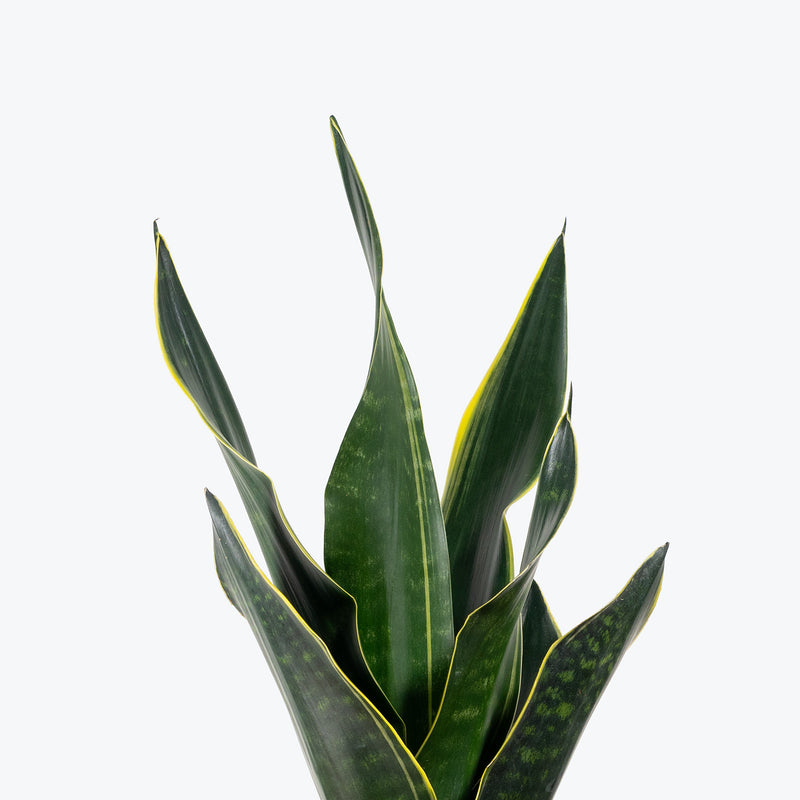
How to care for Sansevieria Fabi
Sansevieria Fabi should not be in a position to see the sun directly, although early morning or late evening sun is fine. Filtered sunlight through a sheer curtain is best and most homes are comprised primarily of indirect sunlight. The best spot for them is where they do not see the sun during the majority of the day but still get bright, indirect light.
Sansevieria Fabi will do well in low light, but will grow faster with brighter light. A low light plant can pretty much survive anyplace inside your home as long as you have a window in the room. Remember, low light does not mean no light and plants will grow based on how much light they receive.
Sansevieria Fabi like the soil to be completely dry before the next watering. This can take up to 4 weeks in an average home environment but it will vary depending on the time of year, your environment and lighting conditions. For them, it's always safer to underwater or water when you see signs of lack of water (i.e. wrinkly or soft leaves). Water a little more often in the warmer months.
Sansevieria Fabi humidity requirement is low, so do not mist them or put them in a terrarium.
Sansevieria Fabi is super easy to take care of, incredibly hardy, and known for their air-purifying capabilities. The more light a plant gets, the more water it needs, but make sure you do not overwater them and try not to let water sit in between or on their leaves for extended periods of time. Avoid fertilizing in the winter when the plant's growth naturally slows. Sansevieria Fabi is very low-maintenance, making it an ideal plant for beginners.
Sansevieria Fabi is moderately toxic and can cause some adverse reactions when ingested so it is best to not let your pets eat it, which we advise for all plants in general. The severity of the reaction will depend on how much of the plant is ingested but, if you know your pet typically does not eat your plants, this plant will be suitable for your home..
Learn MoreView PlantSansevieria Fernwood Mikado
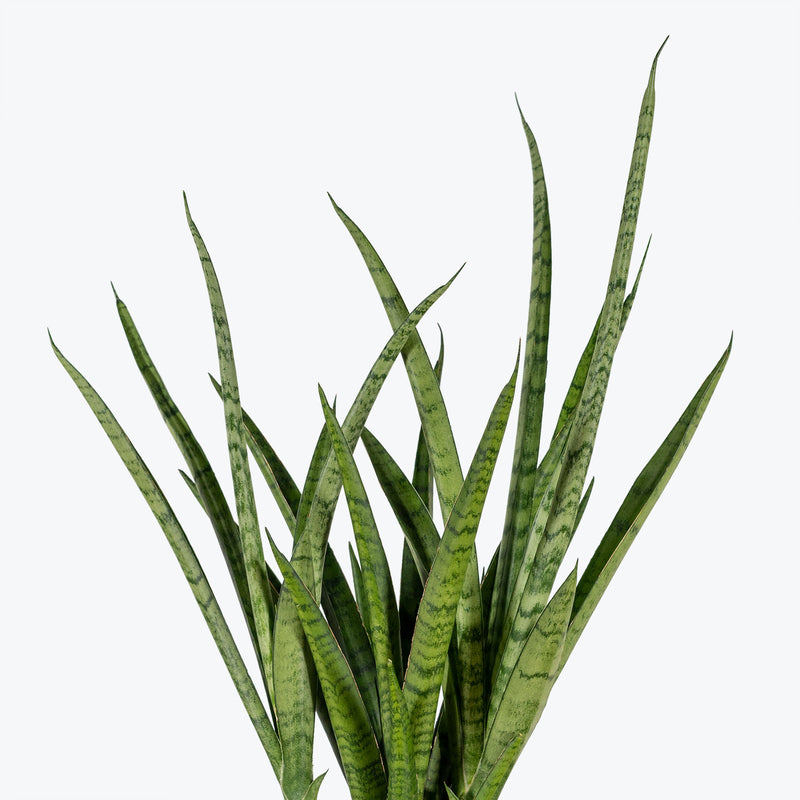
How to care for Sansevieria Fernwood Mikado
Sansevieria Fernwood Mikado should not be in a position to see the sun directly, although early morning or late evening sun is fine. Filtered sunlight through a sheer curtain is best and most homes are comprised primarily of indirect sunlight. The best spot for them is where they do not see the sun during the majority of the day but still get bright, indirect light.
Sansevieria Fernwood Mikado will do well in low light, but will grow faster with brighter light. A low light plant can pretty much survive anyplace inside your home as long as you have a window in the room. Remember, low light does not mean no light and plants will grow based on how much light they receive.
Sansevieria Fernwood Mikado likes the soil to be completely dry before the next watering. That usually takes about 4 weeks in an average home environment. It will vary depending on the time of year, your environment and lighting conditions, but for them, it's always safer to underwater or water when you see signs of lack of water (i.e. wrinkly or soft leaves). Water a little more often in the warmer months.
Sansevieria Fernwood Mikado humidity requirement is low, so do not mist them or put them in a terrarium.
Sansevieria Fernwood Mikado is super easy to take care of, being able to handle all kinds of light levels and are known for their air-purifying capabilities. Just make sure to not overwater them and try not to let water sit between their leaves. Some dry tips are completely normal on Snake Plants.
Sansevieria Fernwood Mikado is moderately toxic and can cause some adverse reactions when ingested so it is best to not let your pets eat it, which we advise for all plants in general. The severity of the reaction will depend on how much of the plant is ingested but, if you know your pet typically does not eat your plants, this plant will be suitable for your home..
Learn MoreView PlantSansevieria Francisii Spiky
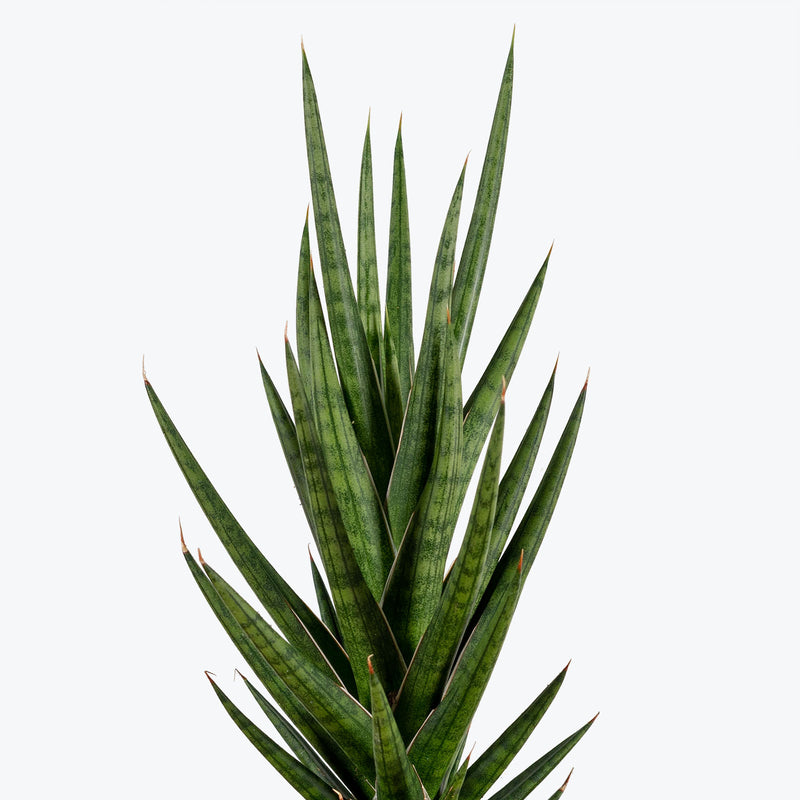
How to care for Sansevieria Francisii Spiky
They should not be in a position to see the sun directly, although early morning or late evening sun is fine. Filtered sunlight through a sheer curtain is best and most homes are comprised primarily of indirect sunlight. The best spot for them is where they do not see the sun during the majority of the day but still get bright, indirect light.
They will do well in low light, but will grow faster with brighter light. A low light plant can pretty much survive anyplace inside your home as long as you have a window in the room. Remember, low light does not mean no light and plants will grow based on how much light they receive.
They like the soil to be completely dry before the next watering. That usually takes about 4 weeks in an average home environment. It will vary depending on the time of year, your environment and lighting conditions, but for them, it's always safer to underwater or water when you see signs of lack of water (i.e. wrinkly or soft leaves)
Their humidity requirement is low, so do not mist them or put them in a terrarium.
They are super easy to take care of and known for their air purifying capabilities. Just make sure you do not overwater them and try not to get water on their leaves.
This plant is moderately toxic and can cause some adverse reactions when ingested so it is best to not let your pets eat it, which we advise for all plants in general. The severity of the reaction will depend on how much of the plant is ingested but, if you know your pet typically does not eat your plants, this plant will be suitable for your home..
Learn MoreView PlantSansevieria Futura Robusta
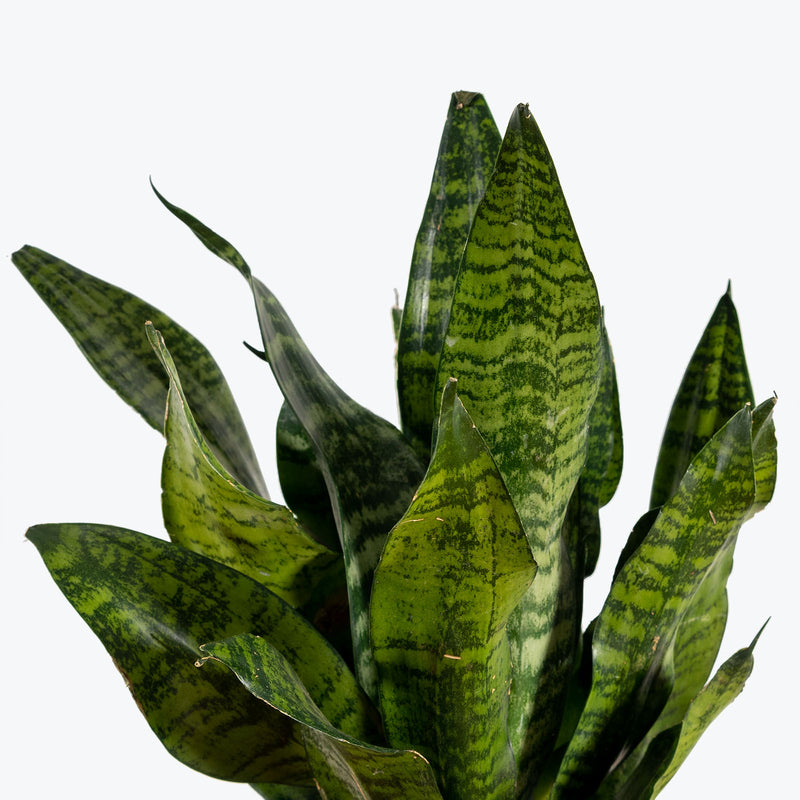
How to care for Sansevieria Futura Robusta
They should not be in a position to see the sun directly, although early morning or late evening sun is fine. Filtered sunlight through a sheer curtain is best and most homes are comprised primarily of indirect sunlight. The best spot for them is where they do not see the sun during the majority of the day but still get bright, indirect light.
They will do well in low light, but will grow faster with brighter light. A low light plant can pretty much survive anyplace inside your home as long as you have a window in the room. Remember, low light does not mean no light and plants will grow based on how much light they receive.
They like the soil to be completely dry before the next watering. That usually takes about 4 weeks in an average home environment. It will vary depending on the time of year, your environment and lighting conditions, but for them, it's always safer to underwater or water when you see signs of lack of water (i.e. wrinkly or soft leaves). Water a little more often in the warmer months.
Their humidity requirement is low, so do not mist them or put them in a terrarium.
They are super easy to take care of, incredibly hardy, and known for their air-purifying capabilities. The more light a plant gets the more water it needs, but make sure you do not overwater them and try not to get water in between their leaves.
This plant is moderately toxic and can cause some adverse reactions when ingested so it is best to not let your pets eat it, which we advise for all plants in general. The severity of the reaction will depend on how much of the plant is ingested but, if you know your pet typically does not eat your plants, this plant will be suitable for your home..
Learn MoreView PlantSansevieria Futura Superba
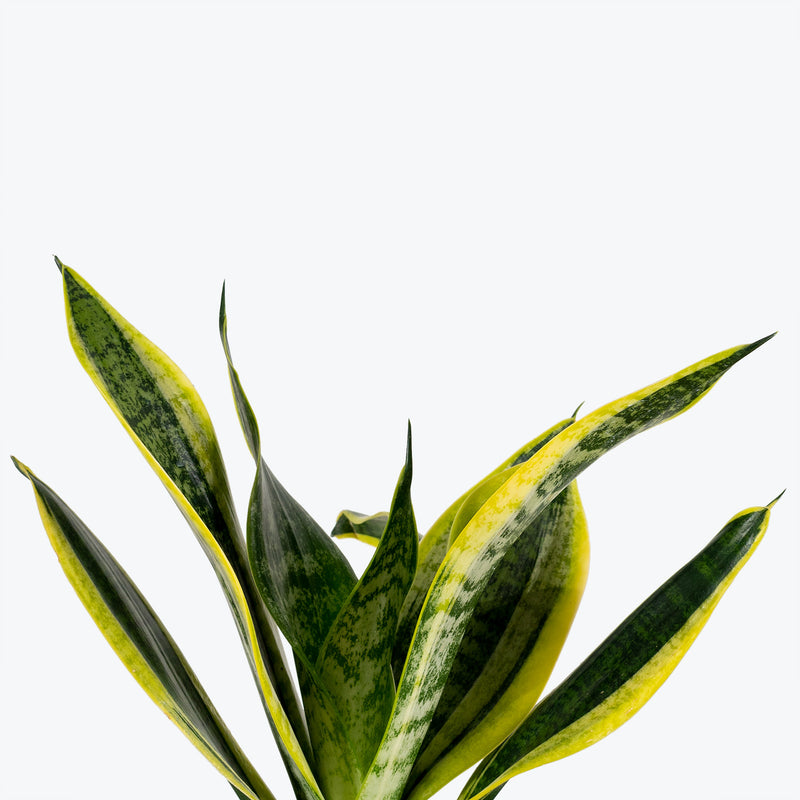
How to care for Sansevieria Futura Superba
They should not be in a position to see the sun directly, although early morning or late evening sun is fine. Filtered sunlight through a sheer curtain is best and most homes are comprised primarily of indirect sunlight. The best spot for them is where they do not see the sun during the majority of the day but still get bright, indirect light.
They will do well in low light, but will grow faster with brighter light. A low light plant can pretty much survive anyplace inside your home as long as you have a window in the room. Remember, low light does not mean no light and plants will grow based on how much light they receive.
They like the soil to be completely dry before the next watering. That usually takes about 4 weeks in an average home environment. It will vary depending on the time of year, your environment and lighting conditions, but for them, it's always safer to underwater or water when you see signs of lack of water (i.e. wrinkly or soft leaves). Water a little more often in the warmer months.
Their humidity requirement is low, so do not mist them or put them in a terrarium.
They are super easy to take care of, incredibly hardy, and known for their air-purifying capabilities. The more light a plant gets the more water it needs, but make sure you do not overwater them and try not to get water on their leaves.
This plant is moderately toxic and can cause some adverse reactions when ingested so it is best to not let your pets eat it, which we advise for all plants in general. The severity of the reaction will depend on how much of the plant is ingested but, if you know your pet typically does not eat your plants, this plant will be suitable for your home..
Learn MoreView PlantSansevieria Golden Flame
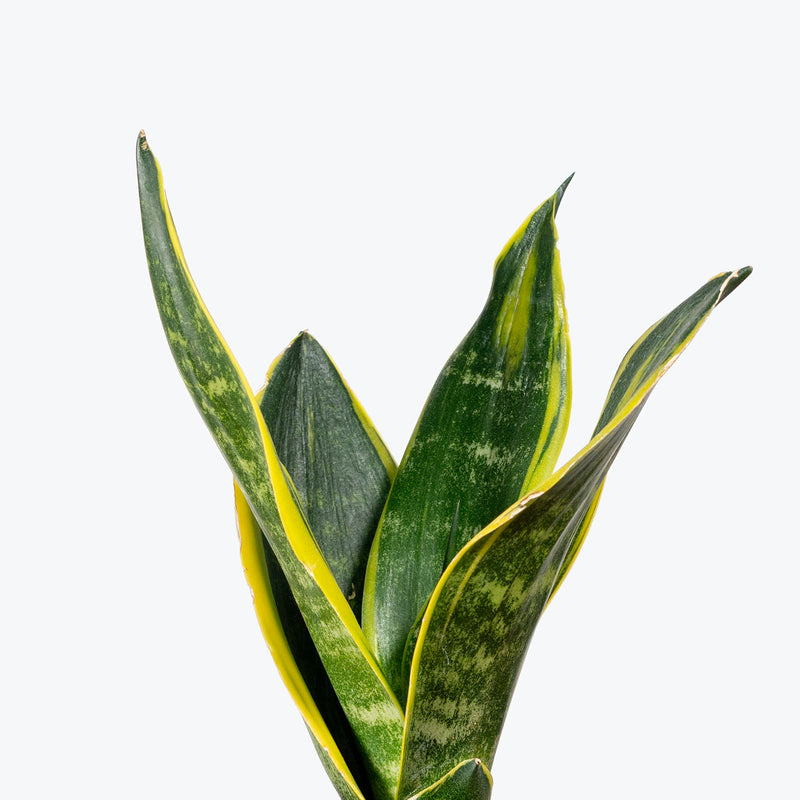
How to care for Sansevieria Golden Flame
Sansevieria Golden Flame should not be in a position to see the sun directly, although early morning or late evening sun is fine. Filtered sunlight through a sheer curtain is best and most homes are comprised primarily of indirect sunlight. The best spot for them is where they do not see the sun during the majority of the day but still get bright, indirect light.
Sansevieria Golden Flame will do well in low light, but will grow faster with brighter light. A low light plant can pretty much survive anyplace inside your home as long as you have a window in the room. Remember, low light does not mean no light and plants will grow based on how much light they receive.
Sansevieria Golden Flame likes the soil to be completely dry before the next watering. This can take up to 4 weeks in an average home environment but it will vary depending on the time of year, your environment and lighting conditions. For them, it's always safer to underwater or water when you see signs of lack of water (i.e. wrinkly or soft leaves). Water a little more often in the warmer months.
Sansevieria Golden Flame can live in any average home humidity condition and are fairly hardy.
To maintain its golden colouration, give Sansevieria Golden Flame bright, indirect light with occasional morning sun. Use a cactus or succulent potting mix to ensure sharp drainage, and never allow the plant to sit in water. This plant is extremely drought-tolerant — when in doubt, wait to water. Clean the leaves occasionally to keep their shine and help photosynthesis. Rotate the pot every few weeks to encourage balanced growth and prevent leaning.
Sansevieria Golden Flame is moderately toxic and can cause some adverse reactions when ingested so it is best to not let your pets eat it, which we advise for all plants in general. The severity of the reaction will depend on how much of the plant is ingested but, if you know your pet typically does not eat your plants, this plant will be suitable for your home..
Learn MoreView PlantSansevieria Golden Hahnii
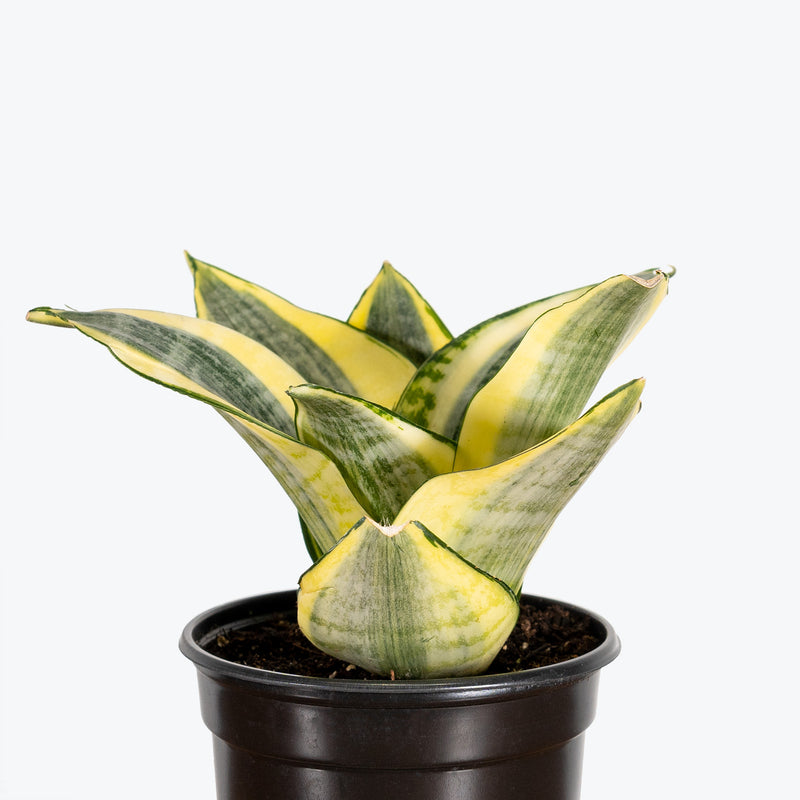
How to care for Sansevieria Golden Hahnii
They should not be in a position to see the sun directly, although early morning or late evening sun is fine. Filtered sunlight through a sheer curtain is best and most homes are comprised primarily of indirect sunlight. The best spot for them is where they do not see the sun during the majority of the day but still get bright, indirect light.
They will do well in low light, but will grow faster with brighter light. A low light plant can pretty much survive anyplace inside your home as long as you have a window in the room. Remember, low light does not mean no light and plants will grow based on how much light they receive.
They like the soil to be completely dry before the next watering. This can take up to 4 weeks in an average home environment but it will vary depending on the time of year, your environment and lighting conditions. For them, it's always safer to underwater or water when you see signs of lack of water (i.e. wrinkly or soft leaves). Water a little more often in the warmer months.
Their humidity requirement is low, so do not mist them or put them in a terrarium.
They are super easy to take care of and able to handle all kinds of light levels, just make sure to not overwater them and try not to let water sit between their leaves. Some dry tips are completely normal on Snake Plants and they are actually known for their air-purifying capabilities
This plant is moderately toxic and can cause some adverse reactions when ingested so it is best to not let your pets eat it, which we advise for all plants in general. The severity of the reaction will depend on how much of the plant is ingested but, if you know your pet typically does not eat your plants, this plant will be suitable for your home..
Learn MoreView PlantSansevieria Hahnii Black Jade
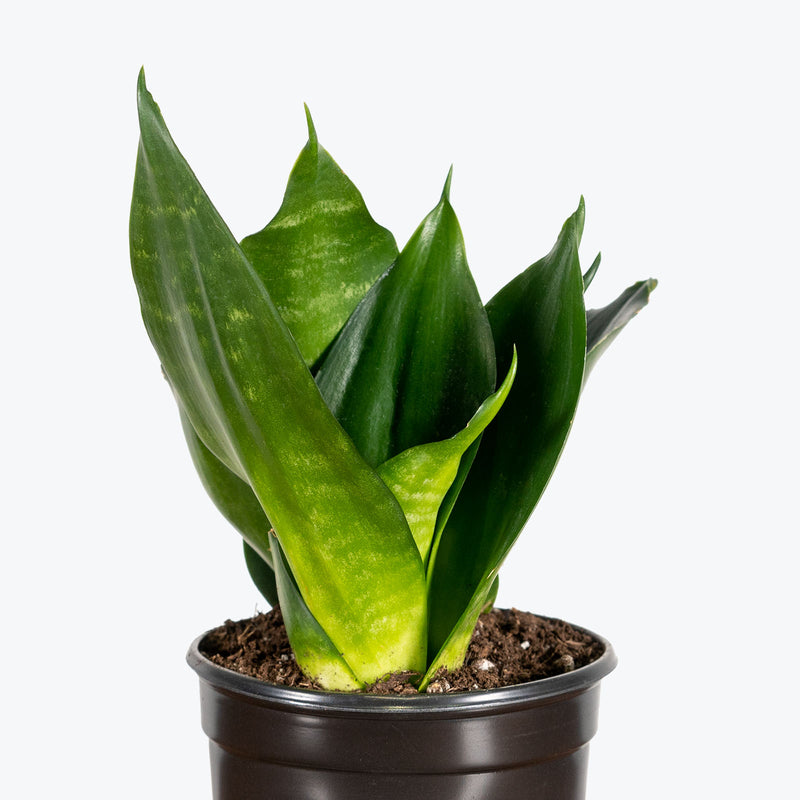
How to care for Sansevieria Hahnii Black Jade
They should not be in a position to see the sun directly, although early morning or late evening sun is fine. Filtered sunlight through a sheer curtain is best and most homes are comprised primarily of indirect sunlight. The best spot for them is where they do not see the sun during the majority of the day but still get bright, indirect light.
They will do well in low light, but will grow faster with brighter light. A low light plant can pretty much survive anyplace inside your home as long as you have a window in the room. Remember, low light does not mean no light and plants will grow based on how much light they receive.
They like the soil to be completely dry before the next watering. This can take up to 4 weeks in an average home environment but it will vary depending on the time of year, your environment and lighting conditions. For them, it's always safer to underwater or water when you see signs of lack of water (i.e. wrinkly or soft leaves). Water a little more often in the warmer months.
Their humidity requirement is low, so do not mist them or put them in a terrarium.
They are super easy to take care of and able to handle all kinds of light levels, just make sure to not overwater them and try not to let water sit between their leaves. Some dry tips are completely normal on Snake Plants and they are actually known for their air-purifying capabilities.
This plant is moderately toxic and can cause some adverse reactions when ingested so it is best to not let your pets eat it, which we advise for all plants in general. The severity of the reaction will depend on how much of the plant is ingested but, if you know your pet typically does not eat your plants, this plant will be suitable for your home..
Learn MoreView PlantSansevieria Hahnii Black Star
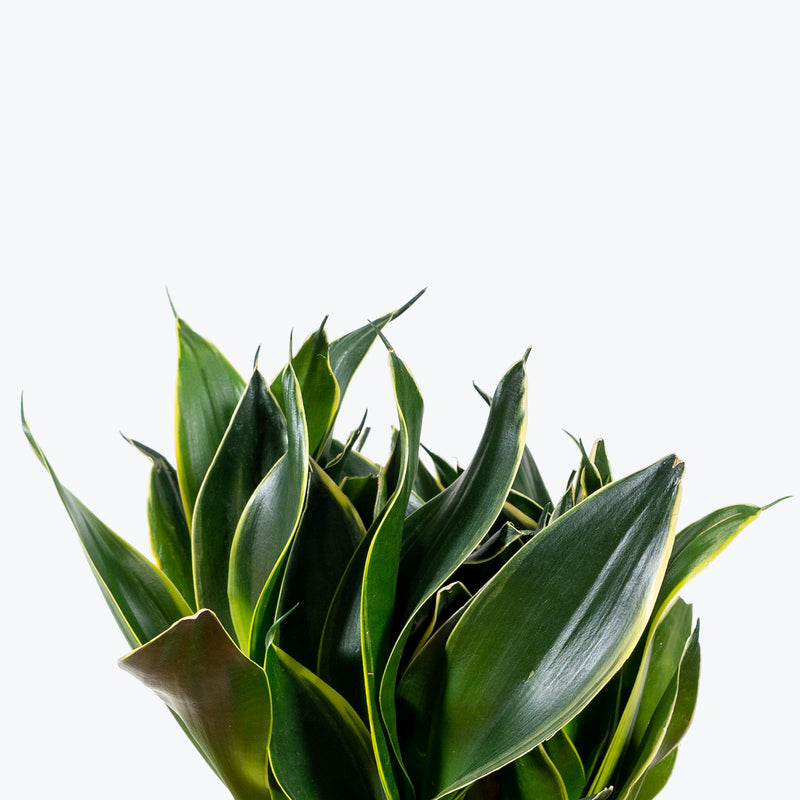
How to care for Sansevieria Hahnii Black Star
They should not be in a position to see the sun directly, although early morning or late evening sun is fine. Filtered sunlight through a sheer curtain is best and most homes are comprised primarily of indirect sunlight. The best spot for them is where they do not see the sun during the majority of the day but still get bright, indirect light.
They will do well in low light, but will grow faster with brighter light. A low light plant can pretty much survive anyplace inside your home as long as you have a window in the room. Remember, low light does not mean no light and plants will grow based on how much light they receive.
They like the soil to be completely dry before the next watering. This can take up to 4 weeks in an average home environment but it will vary depending on the time of year, your environment and lighting conditions. For them, it's always safer to underwater or water when you see signs of lack of water (i.e. wrinkly or soft leaves). Water a little more often in the warmer months.
Their humidity requirement is low, so do not mist them or put them in a terrarium.
They are super easy to take care of and able to handle all kinds of light levels, just make sure to not overwater them and try not to let water sit between their leaves. Some dry tips are completely normal on Snake Plants and they are actually known for their air-purifying capabilities.
This plant is moderately toxic and can cause some adverse reactions when ingested so it is best to not let your pets eat it, which we advise for all plants in general. The severity of the reaction will depend on how much of the plant is ingested but, if you know your pet typically does not eat your plants, this plant will be suitable for your home..
Learn MoreView PlantSansevieria Hahnii Silver Frost
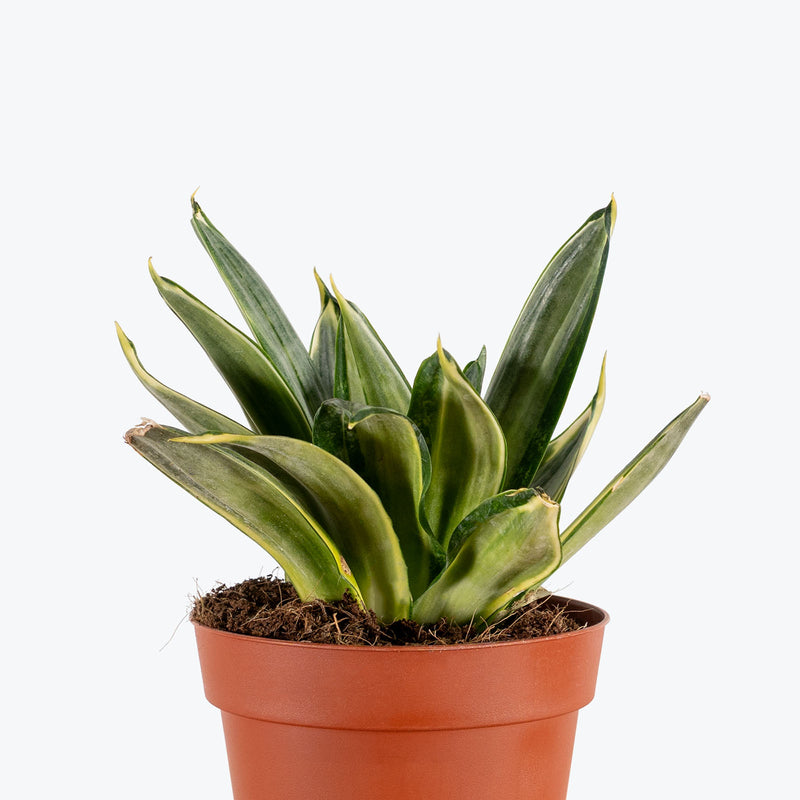
How to care for Sansevieria Hahnii Silver Frost
Sansevieria Hahnii Silver Frost should not be in a position to see the sun directly, although early morning or late evening sun is fine. Filtered sunlight through a sheer curtain is best and most homes are comprised primarily of indirect sunlight. The best spot for them is where they do not see the sun during the majority of the day but still get bright, indirect light.
Sansevieria Hahnii Silver Frost will do well in low light, but will grow faster with brighter light. A low light plant can pretty much survive anyplace inside your home as long as you have a window in the room. Remember, low light does not mean no light and plants will grow based on how much light they receive.
Sansevieria Hahnii Silver Frost likes the soil to be completely dry before the next watering. This can take up to 4 weeks in an average home environment but it will vary depending on the time of year, your environment and lighting conditions. For them, it's always safer to underwater or water when you see signs of lack of water (i.e. wrinkly or soft leaves). Water a little more often in the warmer months.
Their humidity requirement is low, so do not mist Sansevieria Hahnii Silver Frost or put them in a terrarium.
Sansevieria Hahnii Silver Frost is super easy to take care of and able to handle all kinds of light levels, just make sure to not overwater them and try not to let water sit between their leaves. Some dry tips are completely normal on Snake Plants and they are known for their air-purifying capabilities. The plant's compact size means it rarely needs repotting; do so only when it outgrows its pot, typically every few years.
Sansevieria Hahnii Silver Frost is moderately toxic and can cause some adverse reactions when ingested so it is best to not let your pets eat it, which we advise for all plants in general. The severity of the reaction will depend on how much of the plant is ingested but, if you know your pet typically does not eat your plants, this plant will be suitable for your home..
Learn MoreView PlantSansevieria Javanica
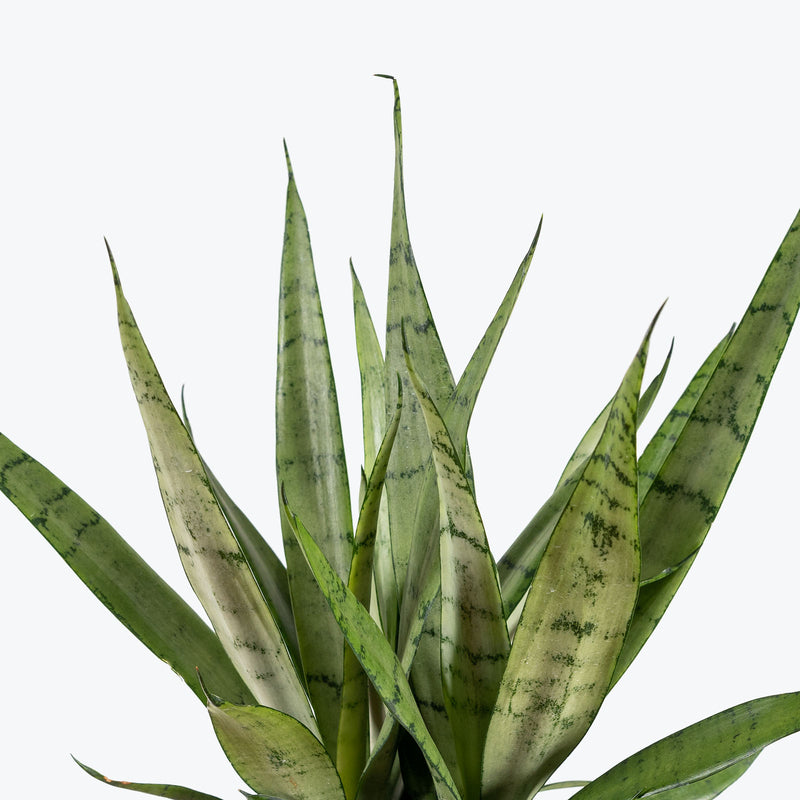
How to care for Sansevieria Javanica
They should not be in a position to see the sun directly, although early morning or late evening sun is fine. Filtered sunlight through a sheer curtain is best and most homes are comprised primarily of indirect sunlight. The best spot for them is where they do not see the sun during the majority of the day but still get bright, indirect light.
They will do well in low light, but will grow faster with brighter light. A low light plant can pretty much survive anyplace inside your home as long as you have a window in the room. Remember, low light does not mean no light and plants will grow based on how much light they receive.
They like the soil to be completely dry before the next watering. This can take up to 4 weeks in an average home environment but it will vary depending on the time of year, your environment and lighting conditions. For them, it's always safer to underwater or water when you see signs of lack of water (i.e. wrinkly or soft leaves). Water a little more often in the warmer months.
They can live in any average home humidity condition and are fairly hardy.
The Javanese Snake Plant doesn't require frequent repotting, as it prefers to be slightly root-bound. Ensure proper drainage and use well-draining soil to prevent root rot. To maintain the plant's health and appearance, remove any dead or yellowing leaves as needed. Be cautious when handling the leaves, as they can be sharp.
This plant is moderately toxic and can cause some adverse reactions when ingested so it is best to not let your pets eat it, which we advise for all plants in general. The severity of the reaction will depend on how much of the plant is ingested but, if you know your pet typically does not eat your plants, this plant will be suitable for your home..
Learn MoreView PlantSansevieria Kirkii Silver Blue
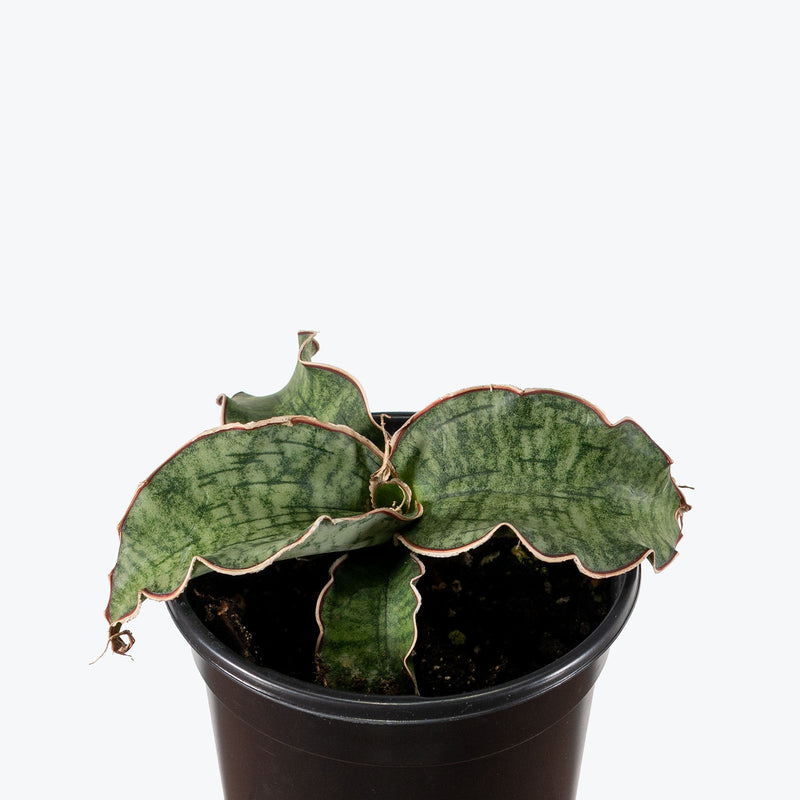
How to care for Sansevieria Kirkii Silver Blue
Sansevieria Kirkii Silver Blue should not be in a position to see the sun directly, although early morning or late evening sun is fine. Filtered sunlight through a sheer curtain is best and most homes are comprised primarily of indirect sunlight. The best spot for them is where they do not see the sun during the majority of the day but still get bright, indirect light.
Sansevieria Kirkii Silver Blue will do well in low light, but will grow faster with brighter light. A low light plant can pretty much survive anyplace inside your home as long as you have a window in the room. Remember, low light does not mean no light and plants will grow based on how much light they receive.
Sansevieria Kirkii Silver Blue likes the soil to be completely dry before the next watering. This can take up to 4 weeks in an average home environment but it will vary depending on the time of year, your environment and lighting conditions. For them, it's always safer to underwater or water when you see signs of lack of water (i.e. wrinkly or soft leaves). Water a little more often in the warmer months.
Their humidity requirement is low, so do not mist Sansevieria Kirkii Silver Blue or put them in a terrarium.
Sansevieria Kirkii Silver Blue is super easy to take care of. It can handle all kinds of light levels and is known for its air-purifying capabilities. Just make sure not to overwater it and try not to let water sit between its leaves. The plant's robust nature means it generally requires little maintenance beyond the occasional removal of dead or damaged leaves to keep it looking its best.
Sansevieria Kirkii Silver Blue is moderately toxic and can cause some adverse reactions when ingested so it is best to not let your pets eat it, which we advise for all plants in general. The severity of the reaction will depend on how much of the plant is ingested but, if you know your pet typically does not eat your plants, this plant will be suitable for your home..
Learn MoreView PlantSansevieria La Rubia
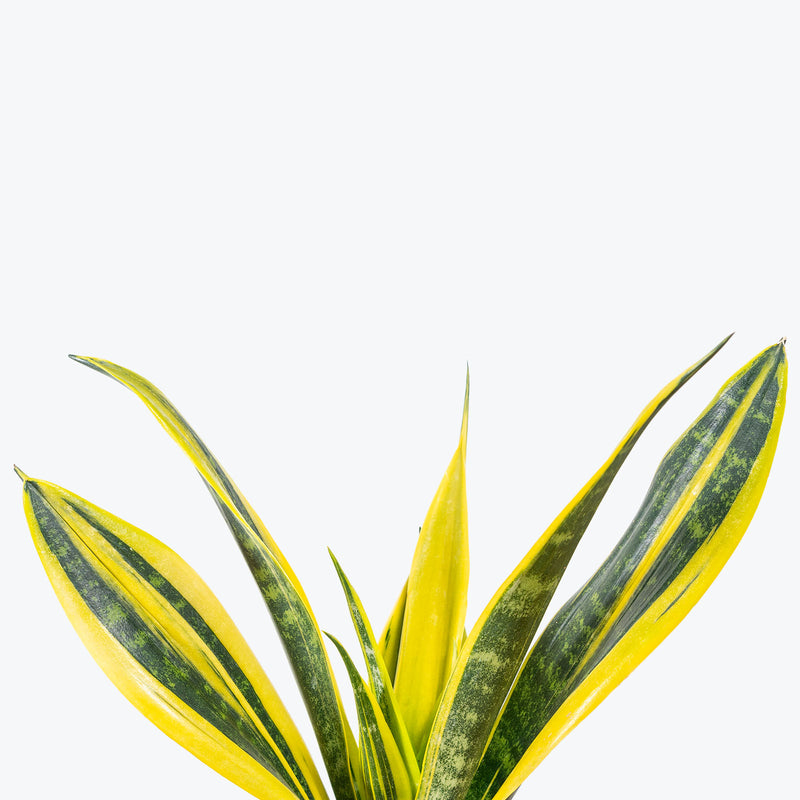
How to care for Sansevieria La Rubia
They should not be in a position to see the sun directly, although early morning or late evening sun is fine. Filtered sunlight through a sheer curtain is best and most homes are comprised primarily of indirect sunlight. The best spot for them is where they do not see the sun during the majority of the day but still get bright, indirect light.
They will do well in low light, but will grow faster with brighter light. A low light plant can pretty much survive anyplace inside your home as long as you have a window in the room. Remember, low light does not mean no light and plants will grow based on how much light they receive.
They like the soil to be completely dry before the next watering. This can take up to 4 weeks in an average home environment but it will vary depending on the time of year, your environment and lighting conditions. For them, it's always safer to underwater or water when you see signs of lack of water (i.e. wrinkly or soft leaves). Water a little more often in the warmer months.
Their humidity requirement is low, so do not mist them or put them in a terrarium.
They are super easy to take care of, incredibly hardy, and known for their air-purifying capabilities. The more light a plant gets the more water it needs, but make sure you do not overwater them and try not to let water sit in between or on their leaves for extended periods of time.
This plant is moderately toxic and can cause some adverse reactions when ingested so it is best to not let your pets eat it, which we advise for all plants in general. The severity of the reaction will depend on how much of the plant is ingested but, if you know your pet typically does not eat your plants, this plant will be suitable for your home..
Learn MoreView PlantSansevieria Lauren
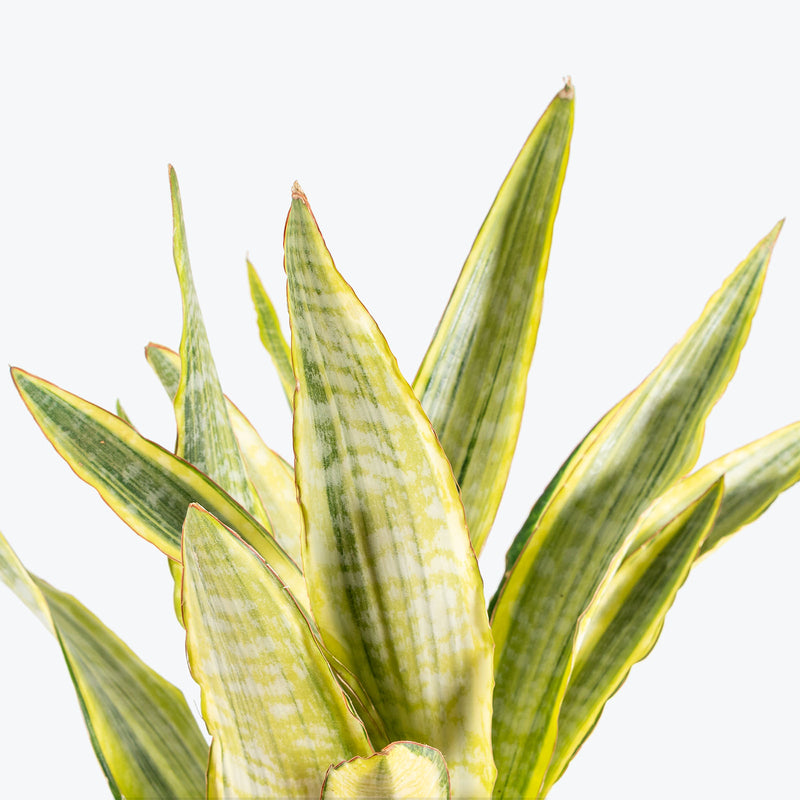
How to care for Sansevieria Lauren
Sansevieria Lauren should not be in a position to see the sun directly, although early morning or late evening sun is fine. Filtered sunlight through a sheer curtain is best and most homes are comprised primarily of indirect sunlight. The best spot for them is where they do not see the sun during the majority of the day but still get bright, indirect light.
Sansevieria Lauren will do well in low light, but will grow faster with brighter light. A low light plant can pretty much survive anyplace inside your home as long as you have a window in the room. Remember, low light does not mean no light and plants will grow based on how much light they receive.
Sansevieria Lauren likes the soil to be completely dry before the next watering. That usually takes about 4 weeks in an average home environment. It will vary depending on the time of year, your environment and lighting conditions, but for them, it's always safer to underwater or water when you see signs of lack of water (i.e. wrinkly or soft leaves). Water a little more often in the warmer months.
Their humidity requirement is low, so do not mist Sansevieria Lauren or put them in a terrarium.
Sansevieria Lauren is super easy to take care of, being able to handle all kinds of light levels and is known for their air-purifying capabilities. Just make sure to not overwater them and try not to let water sit between their leaves. The sturdy leaves can accumulate dust, so gently wipe them with a damp cloth occasionally to keep them clean and healthy. Some dry tips are completely normal on Snake Plants.
Sansevieria Lauren is moderately toxic and can cause some adverse reactions when ingested so it is best to not let your pets eat it, which we advise for all plants in general. The severity of the reaction will depend on how much of the plant is ingested but, if you know your pet typically does not eat your plants, this plant will be suitable for your home..
Learn MoreView PlantSansevieria Laurentii
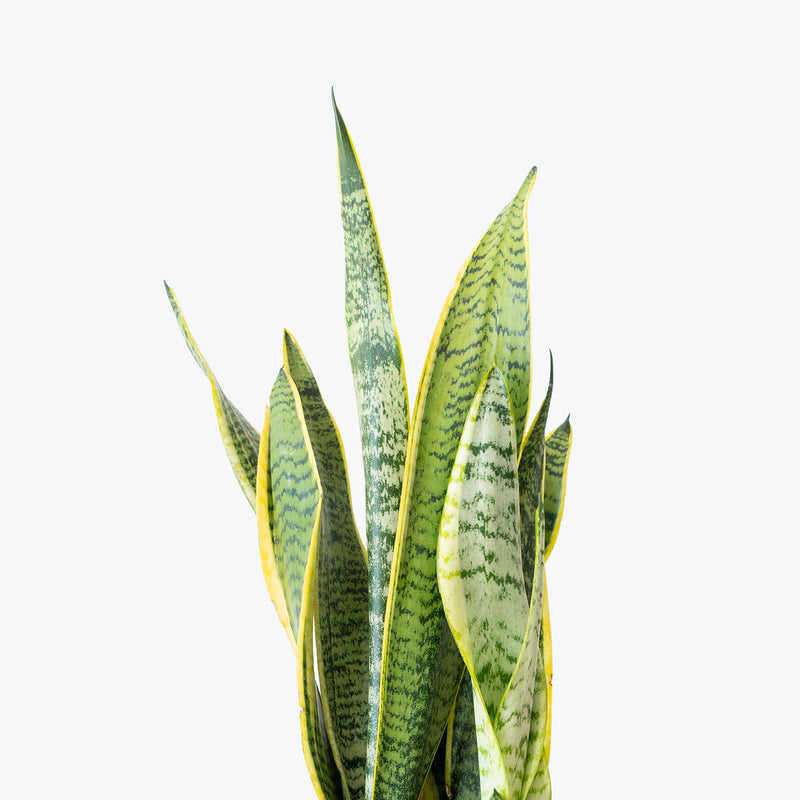
How to care for Sansevieria Laurentii
Sansevieria Laurentii should not be in a position to see the sun directly, although early morning or late evening sun is fine. Filtered sunlight through a sheer curtain is best and most homes are comprised primarily of indirect sunlight. The best spot for them is where they do not see the sun during the majority of the day but still get bright, indirect light.
Sansevieria Laurentii will do well in low light, but will grow faster with brighter light. A low light plant can pretty much survive anyplace inside your home as long as you have a window in the room. Remember, low light does not mean no light and plants will grow based on how much light they receive.
Sansevieria Laurentii likes the soil to be completely dry before the next watering. That usually takes about 4 weeks in an average home environment. It will vary depending on the time of year, your environment and lighting conditions, but for them, it's always safer to underwater or water when you see signs of lack of water (i.e. wrinkly or soft leaves). Water a little more often in the warmer months.
Sansevieria Laurentii humidity requirement is low, so do not mist them or put them in a terrarium.
Sansevieria Laurentii is super easy to take care of, being able to handle all kinds of light levels and is known for its air-purifying capabilities. Just make sure to not overwater them and try not to let water sit between their leaves. Some dry tips are completely normal on Snake Plants. If the leaves become dusty, wipe them down with a damp cloth to allow the plant to breathe and absorb light more effectively.
Sansevieria Laurentii is moderately toxic and can cause some adverse reactions when ingested so it is best to not let your pets eat it, which we advise for all plants in general. The severity of the reaction will depend on how much of the plant is ingested but, if you know your pet typically does not eat your plants, this plant will be suitable for your home..
Learn MoreView PlantSansevieria Lavranos Blue Clone Variegated
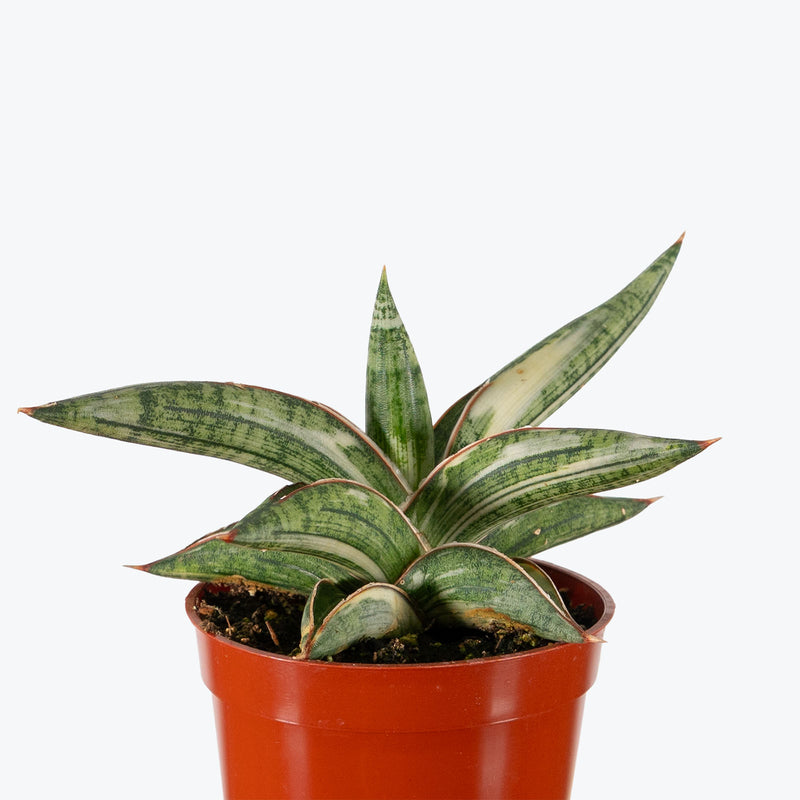
How to care for Sansevieria Lavranos Blue Clone Variegated
Sansevieria Lavranos Blue Clone Variegated should not be in a position to see the sun directly, although early morning or late evening sun is fine. Filtered sunlight through a sheer curtain is best and most homes are comprised primarily of indirect sunlight. The best spot for them is where they do not see the sun during the majority of the day but still get bright, indirect light.
Sansevieria Lavranos Blue Clone Variegated will do well in low light, but will grow faster with brighter light. A low light plant can pretty much survive anyplace inside your home as long as you have a window in the room. Remember, low light does not mean no light and plants will grow based on how much light they receive.
Sansevieria Lavranos Blue Clone Variegated likes the soil to be completely dry before the next watering. This can take up to 4 weeks in an average home environment but it will vary depending on the time of year, your environment and lighting conditions. For them, it's always safer to underwater or water when you see signs of lack of water (i.e. wrinkly or soft leaves). Water a little more often in the warmer months.
Sansevieria Lavranos Blue Clone Variegated can live in any average home humidity condition and are fairly hardy.
Use a gritty, fast-draining mix (cactus or succulent soil with added perlite). Fertilize lightly once or twice a year in spring and summer. Wipe leaves occasionally to highlight their blue-green sheen and variegated streaks. This slow-growing cultivar prefers to stay slightly root-bound and is exceptionally drought resistant.
Sansevieria Lavranos Blue Clone Variegated is moderately toxic and can cause some adverse reactions when ingested so it is best to not let your pets eat it, which we advise for all plants in general. The severity of the reaction will depend on how much of the plant is ingested but, if you know your pet typically does not eat your plants, this plant will be suitable for your home..
Learn MoreView PlantSansevieria Lilliput
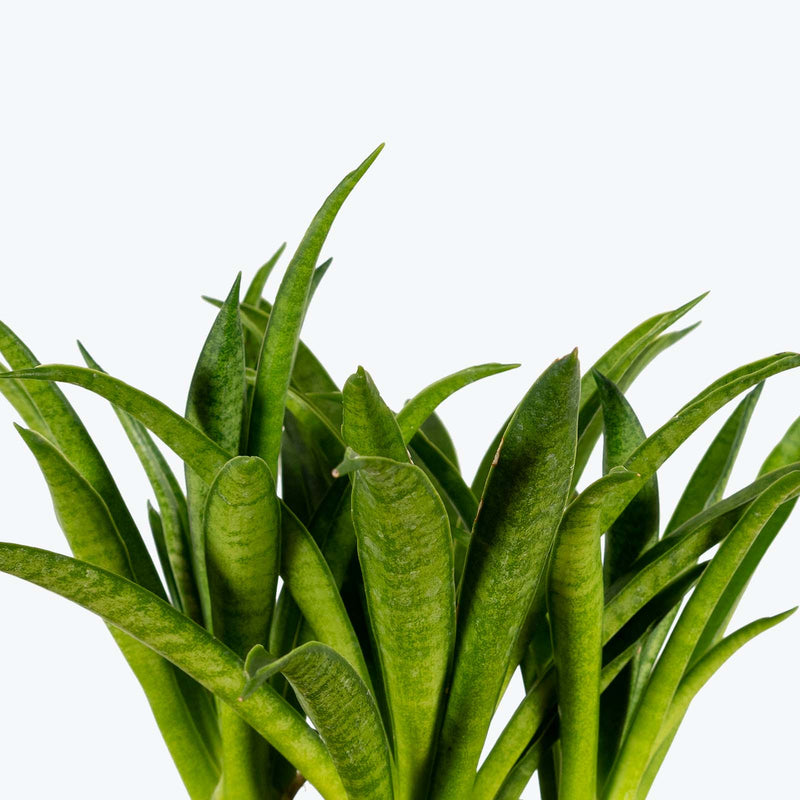
How to care for Sansevieria Lilliput
They should not be in a position to see the sun directly, although early morning or late evening sun is fine. Filtered sunlight through a sheer curtain is best and most homes are comprised primarily of indirect sunlight. The best spot for them is where they do not see the sun during the majority of the day but still get bright, indirect light.
They will do well in low light, but will grow faster with brighter light. A low light plant can pretty much survive anyplace inside your home as long as you have a window in the room. Remember, low light does not mean no light and plants will grow based on how much light they receive.
They like the soil to be completely dry before the next watering. This can take up to 4 weeks in an average home environment but it will vary depending on the time of year, your environment and lighting conditions. For them, it's always safer to underwater or water when you see signs of lack of water (i.e. wrinkly or soft leaves). Water a little more often in the warmer months.
They can live in any average home humidity condition and are fairly hardy.
Sansevieria Lilliput is renowned for its easy-care nature. Ensure to water it only when the soil is completely dry, considering its succulent characteristics that allow it to store moisture in its leaves. Slowly water the soil and ensure that it is not left soaking wet.
This plant is moderately toxic and can cause some adverse reactions when ingested so it is best to not let your pets eat it, which we advise for all plants in general. The severity of the reaction will depend on how much of the plant is ingested but, if you know your pet typically does not eat your plants, this plant will be suitable for your home..
Learn MoreView PlantSansevieria Masoniana Whale Fin
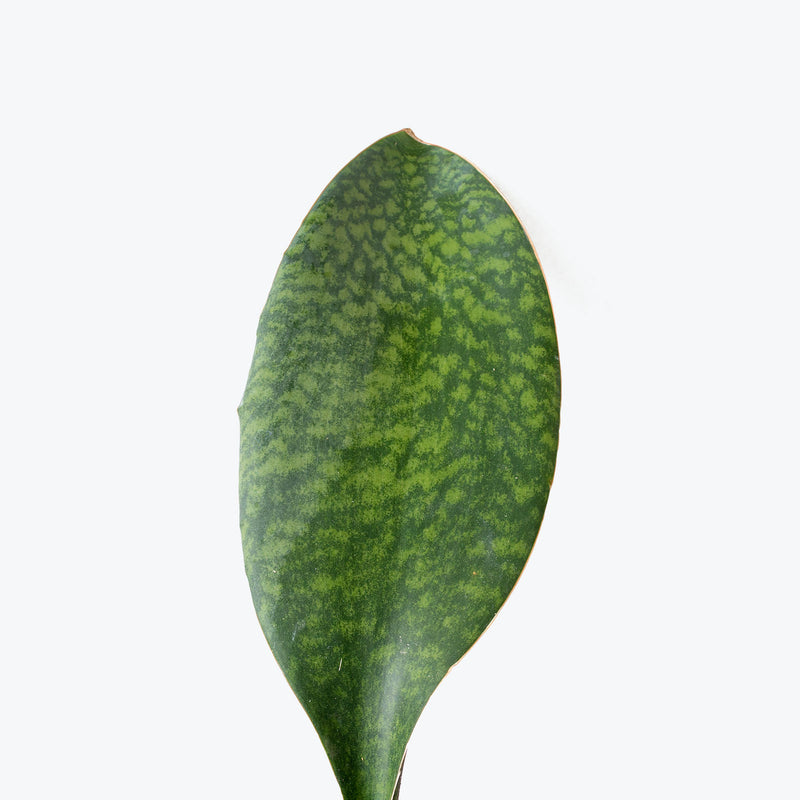
How to care for Sansevieria Masoniana Whale Fin
Sansevieria Masoniana should not be in a position to see the sun directly, although early morning or late evening sun is fine. Filtered sunlight through a sheer curtain is best and most homes are comprised primarily of indirect sunlight. The best spot for them is where they do not see the sun during the majority of the day but still get bright, indirect light.
Sansevieria Masoniana will do well in low light, but will grow faster with brighter light. A low light plant can pretty much survive anyplace inside your home as long as you have a window in the room. Remember, low light does not mean no light and plants will grow based on how much light they receive.
Sansevieria Masoniana likes the soil to be completely dry before the next watering. That usually takes about 4 weeks in an average home environment. It will vary depending on the time of year, your environment and lighting conditions, but for them, it's always safer to underwater or water when you see signs of lack of water (i.e. wrinkly or soft leaves). Water a little more often in the warmer months.
Their humidity requirement is low, so do not mist Sansevieria Masoniana or put them in a terrarium.
Sansevieria Masoniana are super easy to take care of and known for their air purifying capabilities. Just make sure you do not overwater Sansevieria Masoniana and try not to get water on their leaves. Due to its slow growth and large leaf size, it rarely needs repotting. When repotting is necessary, choose a pot only slightly larger than the previous one to prevent overwatering issues.
Sansevieria Masoniana is moderately toxic and can cause some adverse reactions when ingested so it is best to not let your pets eat it, which we advise for all plants in general. The severity of the reaction will depend on how much of the plant is ingested but, if you know your pet typically does not eat your plants, this plant will be suitable for your home..
Learn MoreView PlantSansevieria Masoniana Whale Fin Variegata
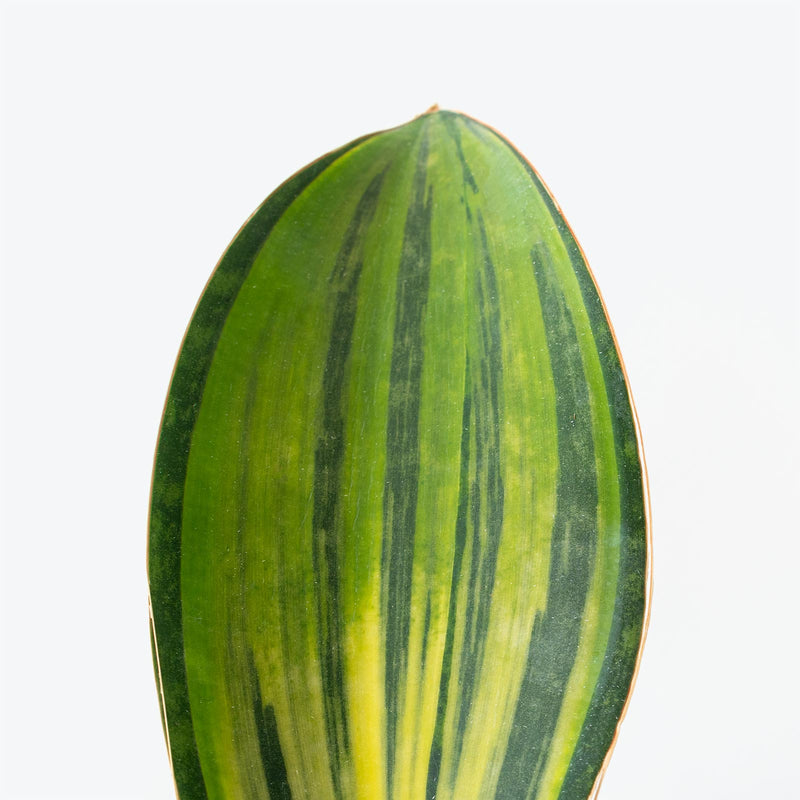
How to care for Sansevieria Masoniana Whale Fin Variegata
They should not be in a position to see the sun directly, although early morning or late evening sun is fine. Filtered sunlight through a sheer curtain is best and most homes are comprised primarily of indirect sunlight. The best spot for them is where they do not see the sun during the majority of the day but still get bright, indirect light.
They will do well in low light, but will grow faster with brighter light. A low light plant can pretty much survive anyplace inside your home as long as you have a window in the room. Remember, low light does not mean no light and plants will grow based on how much light they receive.
They like the soil to be completely dry before the next watering. That usually takes about 4 weeks in an average home environment. It will vary depending on the time of year, your environment and lighting conditions, but for them, it's always safer to underwater or water when you see signs of lack of water (i.e. wrinkly or soft leaves). Water a little more often in the warmer months.
Their humidity requirement is low, so do not mist them or put them in a terrarium.
They are super easy to take care of, being able to handle all kinds of light levels and are known for their air-purifying capabilities. Just make sure to not overwater them and try not to let water sit between their leaves. Some dry tips are completely normal on Snake Plants.
This plant is moderately toxic and can cause some adverse reactions when ingested so it is best to not let your pets eat it, which we advise for all plants in general. The severity of the reaction will depend on how much of the plant is ingested but, if you know your pet typically does not eat your plants, this plant will be suitable for your home..
Learn MoreView PlantSansevieria Midnight Shine
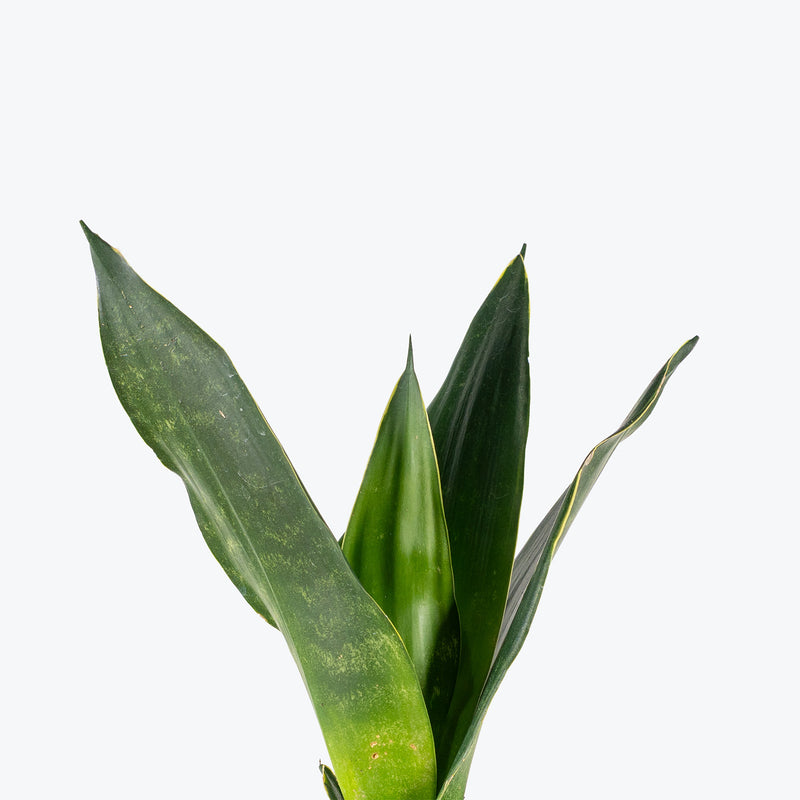
How to care for Sansevieria Midnight Shine
Sansevieria Midnight Shine should not be in a position to see the sun directly, although early morning or late evening sun is fine. Filtered sunlight through a sheer curtain is best and most homes are comprised primarily of indirect sunlight. The best spot for them is where they do not see the sun during the majority of the day but still get bright, indirect light.
Sansevieria Midnight Shine will do well in low light, but will grow faster with brighter light. A low light plant can pretty much survive anyplace inside your home as long as you have a window in the room. Remember, low light does not mean no light and plants will grow based on how much light they receive.
Sansevieria Midnight Shine likes the soil to be completely dry before the next watering. This can take up to 4 weeks in an average home environment but it will vary depending on the time of year, your environment and lighting conditions. For them, it's always safer to underwater or water when you see signs of lack of water (i.e. wrinkly or soft leaves). Water a little more often in the warmer months.
Sansevieria Midnight Shine can live in any average home humidity condition and are fairly hardy.
Use a well-draining cactus or succulent soil mix to prevent root rot. Fertilize lightly once or twice per year during the growing season. Wipe leaves with a soft cloth to keep their natural shine. Sansevieria Midnight Shine is a hardy, air-purifying plant—ideal for those seeking low-maintenance elegance with a bold visual impact.
Sansevieria Midnight Shine is moderately toxic and can cause some adverse reactions when ingested so it is best to not let your pets eat it, which we advise for all plants in general. The severity of the reaction will depend on how much of the plant is ingested but, if you know your pet typically does not eat your plants, this plant will be suitable for your home..
Learn MoreView PlantSansevieria Ming Manee
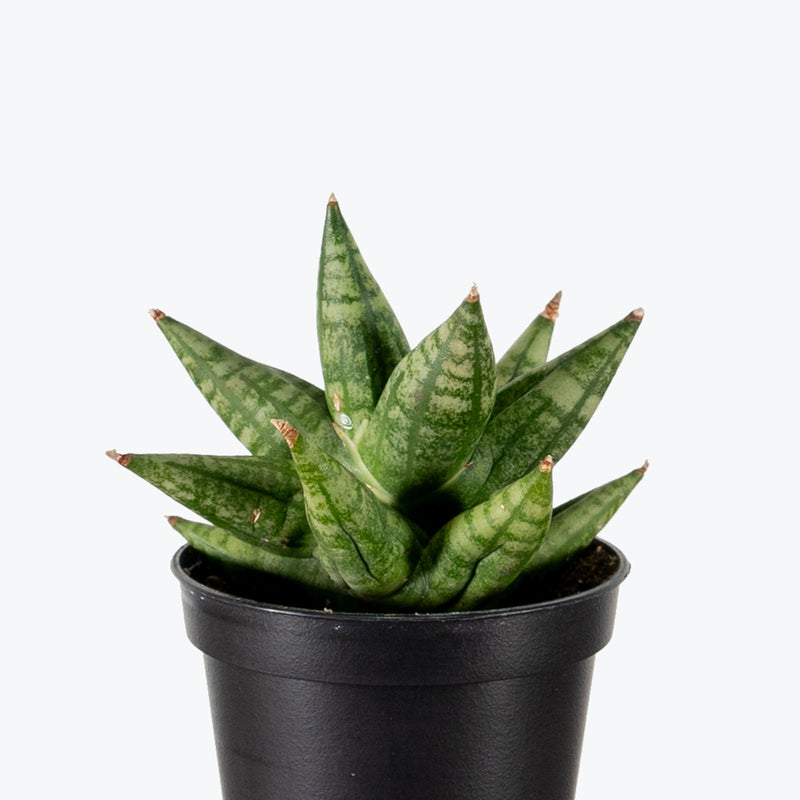
How to care for Sansevieria Ming Manee
Sansevieria Ming Manee should not be in a position to see the sun directly, although early morning or late evening sun is fine. Filtered sunlight through a sheer curtain is best and most homes are comprised primarily of indirect sunlight. The best spot for them is where they do not see the sun during the majority of the day but still get bright, indirect light.
Sansevieria Ming Manee will do well in low light, but will grow faster with brighter light. A low light plant can pretty much survive anyplace inside your home as long as you have a window in the room. Remember, low light does not mean no light and plants will grow based on how much light they receive.
Sansevieria Ming Manee likes the soil to be completely dry before the next watering. That usually takes about 4 weeks in an average home environment. It will vary depending on the time of year, your environment and lighting conditions, but for them, it's always safer to underwater or water when you see signs of lack of water (i.e. wrinkly or soft leaves). Water a little more often in the warmer months.
Their humidity requirement is low, so do not mist Sansevieria Ming Manee or put them in a terrarium.
Being a slow-growing plant, Sansevieria Ming Manee rarely needs repotting. When repotting, use a well-draining soil mix intended for cacti or succulents to ensure excellent drainage. They are super easy to take care of, being able to handle all kinds of light levels and are known for their air-purifying capabilities. Just make sure to not overwater them and try not to let water sit between their leaves. Some dry tips are completely normal on Snake Plants.
Sansevieria Ming Manee is moderately toxic and can cause some adverse reactions when ingested so it is best to not let your pets eat it, which we advise for all plants in general. The severity of the reaction will depend on how much of the plant is ingested but, if you know your pet typically does not eat your plants, this plant will be suitable for your home..
Learn MoreView PlantSansevieria Moonshine
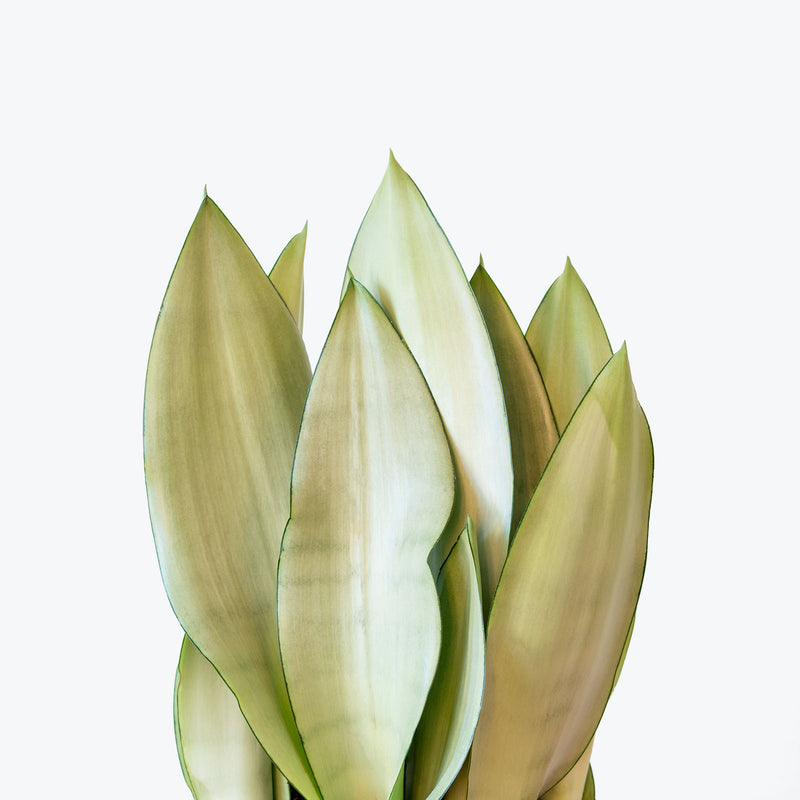
How to care for Sansevieria Moonshine
Sansevieria Moonshine should not be in a position to see the sun directly, although early morning or late evening sun is fine. Filtered sunlight through a sheer curtain is best and most homes are comprised primarily of indirect sunlight. The best spot for them is where they do not see the sun during the majority of the day but still get bright, indirect light.
Sansevieria Moonshine will do well in low light, but will grow faster with brighter light. A low light plant can pretty much survive anyplace inside your home as long as you have a window in the room. Remember, low light does not mean no light and plants will grow based on how much light they receive.
Sansevieria Moonshine likes the soil to be completely dry before the next watering. That usually takes about 4 weeks in an average home environment. It will vary depending on the time of year, your environment and lighting conditions, but for them, it's always safer to underwater or water when you see signs of lack of water (i.e. wrinkly or soft leaves). Water a little more often in the warmer months.
Their humidity requirement is low, so do not mist Sansevieria Moonshine or put them in a terrarium.
Sansevieria Moonshine is super easy to take care of, being able to handle all kinds of light levels and is known for its air-purifying capabilities. Just make sure to not overwater them and try not to let water sit between their leaves. Some dry tips are completely normal on Snake Plants. Occasionally wipe the leaves with a damp cloth to remove dust and prevent pest infestations. This plant is very low maintenance and does not require frequent repotting.
Sansevieria Moonshine is moderately toxic and can cause some adverse reactions when ingested so it is best to not let your pets eat it, which we advise for all plants in general. The severity of the reaction will depend on how much of the plant is ingested but, if you know your pet typically does not eat your plants, this plant will be suitable for your home..
Learn MoreView PlantSansevieria Night Owl
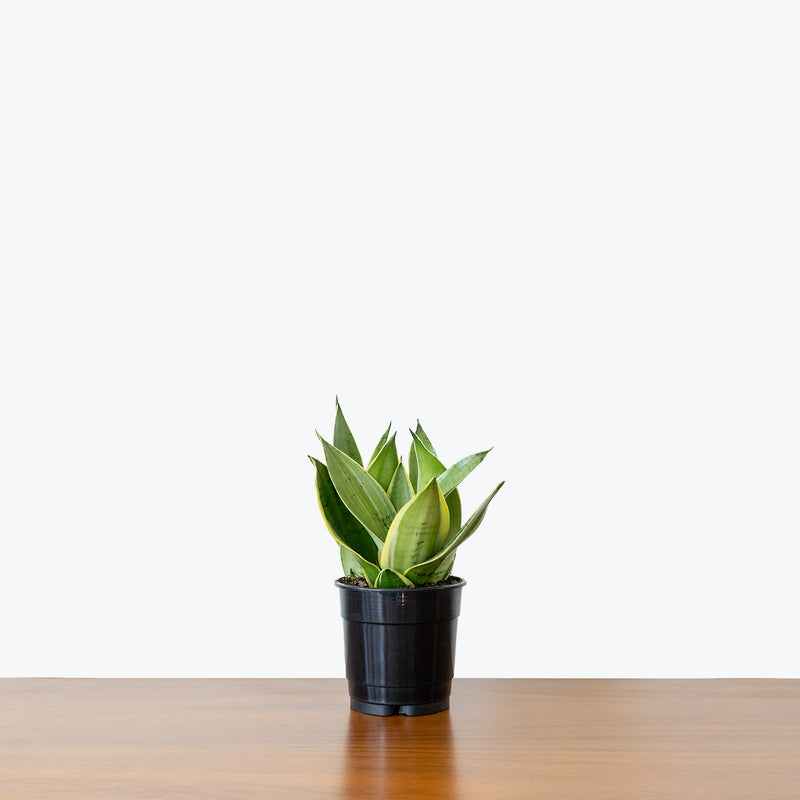
How to care for Sansevieria Night Owl
They should not be in a position to see the sun directly, although early morning or late evening sun is fine. Filtered sunlight through a sheer curtain is best and most homes are comprised primarily of indirect sunlight. The best spot for them is where they do not see the sun during the majority of the day but still get bright, indirect light.
They will do well in low light, but will grow faster with brighter light. A low light plant can pretty much survive anyplace inside your home as long as you have a window in the room. Remember, low light does not mean no light and plants will grow based on how much light they receive.
They like the soil to be completely dry before the next watering. That usually takes about 4 weeks in an average home environment. It will vary depending on the time of year, your environment and lighting conditions, but for them, it's always safer to underwater or water when you see signs of lack of water (i.e. wrinkly or soft leaves). Water a little more often in the warmer months.
Their humidity requirement is low, so do not mist them or put them in a terrarium.
They are super easy to take care of, being able to handle all kinds of light levels and are known for their air-purifying capabilities. Just make sure to not overwater them and try not to let water sit between their leaves. Some dry tips are completely normal on Snake Plants.
This plant is moderately toxic and can cause some adverse reactions when ingested so it is best to not let your pets eat it, which we advise for all plants in general. The severity of the reaction will depend on how much of the plant is ingested but, if you know your pet typically does not eat your plants, this plant will be suitable for your home..
Learn MoreView PlantSansevieria Piano

How to care for Sansevieria Piano
Sansevieria Piano should not be in a position to see the sun directly, although early morning or late evening sun is fine. Filtered sunlight through a sheer curtain is best and most homes are comprised primarily of indirect sunlight. The best spot for them is where they do not see the sun during the majority of the day but still get bright, indirect light.
Sansevieria Piano will do well in low light, but will grow faster with brighter light. A low light plant can pretty much survive anyplace inside your home as long as you have a window in the room. Remember, low light does not mean no light and plants will grow based on how much light they receive.
Sansevieria Piano likes the soil to be completely dry before the next watering. This can take up to 4 weeks in an average home environment but it will vary depending on the time of year, your environment and lighting conditions. For them, it's always safer to underwater or water when you see signs of lack of water (i.e. wrinkly or soft leaves). Water a little more often in the warmer months.
Their humidity requirement is low, so do not mist Sansevieria Piano or put them in a terrarium.
Sansevieria Piano are super easy to take care of, being able to handle all kinds of light levels and are known for their air-purifying capabilities. Just make sure not to overwater them and try not to let water sit between their leaves. The stiff, upright leaves should be dusted occasionally to keep them looking their best and to prevent any potential pest issues. Some dry tips are completely normal on Snake Plants.
Sansevieria Piano is moderately toxic and can cause some adverse reactions when ingested so it is best to not let your pets eat it, which we advise for all plants in general. The severity of the reaction will depend on how much of the plant is ingested but, if you know your pet typically does not eat your plants, this plant will be suitable for your home..
Learn MoreView PlantSansevieria Pyramid
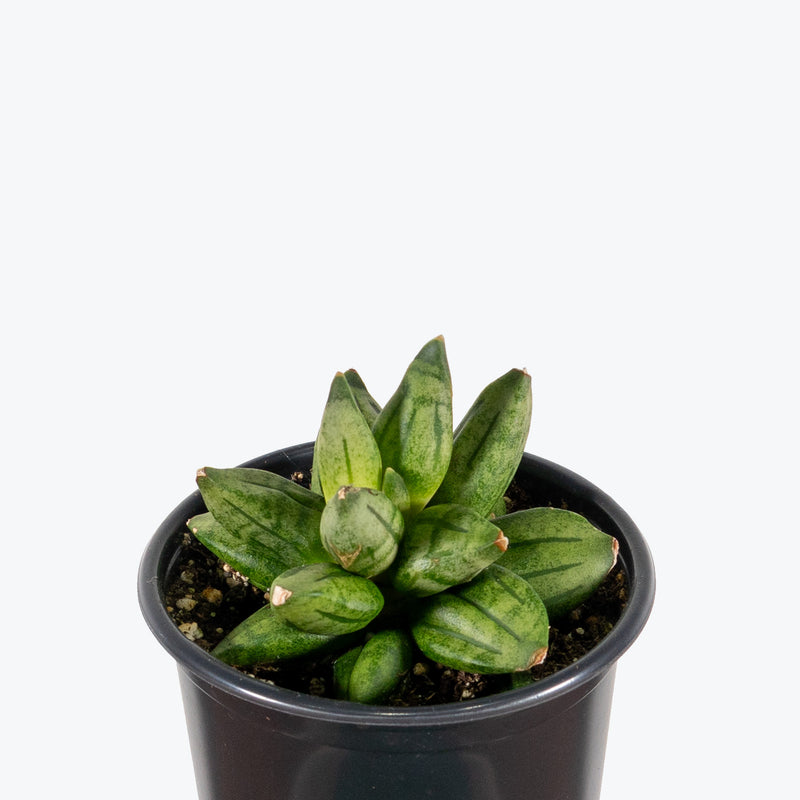
How to care for Sansevieria Pyramid
Sansevieria Pyramid should not be in a position to see the sun directly, although early morning or late evening sun is fine. Filtered sunlight through a sheer curtain is best and most homes are comprised primarily of indirect sunlight. The best spot for them is where they do not see the sun during the majority of the day but still get bright, indirect light.
Sansevieria Pyramid will do well in low light, but will grow faster with brighter light. A low light plant can pretty much survive anyplace inside your home as long as you have a window in the room. Remember, low light does not mean no light and plants will grow based on how much light they receive.
Sansevieria Pyramid likes the soil to be completely dry before the next watering. This can take up to 4 weeks in an average home environment but it will vary depending on the time of year, your environment and lighting conditions. For them, it's always safer to underwater or water when you see signs of lack of water (i.e. wrinkly or soft leaves). Water a little more often in the warmer months.
Sansevieria Pyramid can live in any average home humidity condition and are fairly hardy.
Sansevieria Pyramid is low-maintenance and highly resilient. Use a gritty, well-draining soil mix to prevent root rot. Fertilize lightly 2–3 times per year during the growing season. Wipe leaves occasionally to keep them dust-free and highlight their sculptural form.
Sansevieria Pyramid is moderately toxic and can cause some adverse reactions when ingested so it is best to not let your pets eat it, which we advise for all plants in general. The severity of the reaction will depend on how much of the plant is ingested but, if you know your pet typically does not eat your plants, this plant will be suitable for your home..
Learn MoreView PlantSansevieria Samurai
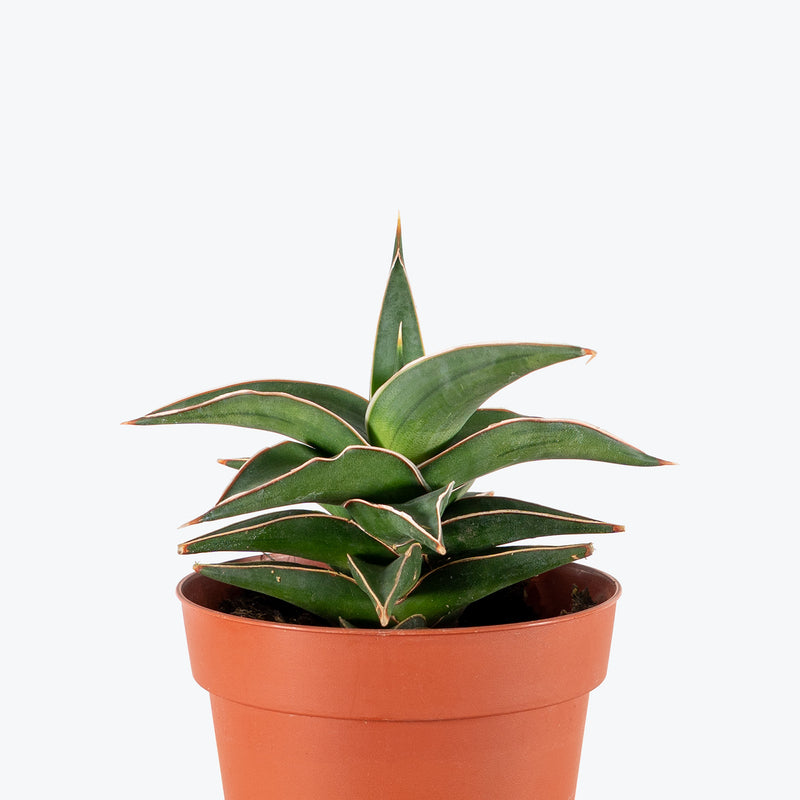
How to care for Sansevieria Samurai
Sansevieria Samurai should not be in a position to see the sun directly, although early morning or late evening sun is fine. Filtered sunlight through a sheer curtain is best and most homes are comprised primarily of indirect sunlight. The best spot for them is where they do not see the sun during the majority of the day but still get bright, indirect light.
Sansevieria Samurai will do well in low light, but will grow faster with brighter light. A low light plant can pretty much survive anyplace inside your home as long as you have a window in the room. Remember, low light does not mean no light and plants will grow based on how much light they receive.
Sansevieria Samurai likes the soil to be completely dry before the next watering. That usually takes about 4 weeks in an average home environment. It will vary depending on the time of year, your environment and lighting conditions, but for them, it's always safer to underwater or water when you see signs of lack of water (i.e. wrinkly or soft leaves). Water a little more often in the warmer months.
Their humidity requirement is low, so do not mist Sansevieria Samurai or put them in a terrarium.
Use a cactus or succulent potting mix in a container with excellent drainage. Sansevieria Samurai stores water in its thick leaves, so be sure not to overwater. Rotate occasionally for even shape and colouring. Place in bright light to encourage deeper leaf grooves and red edging. As it matures, it will slowly form a compact cluster of pups around the base—let them grow in or separate them to share.
Sansevieria Samurai is moderately toxic and can cause some adverse reactions when ingested so it is best to not let your pets eat it, which we advise for all plants in general. The severity of the reaction will depend on how much of the plant is ingested but, if you know your pet typically does not eat your plants, this plant will be suitable for your home..
Learn MoreView PlantSansevieria Sayuri
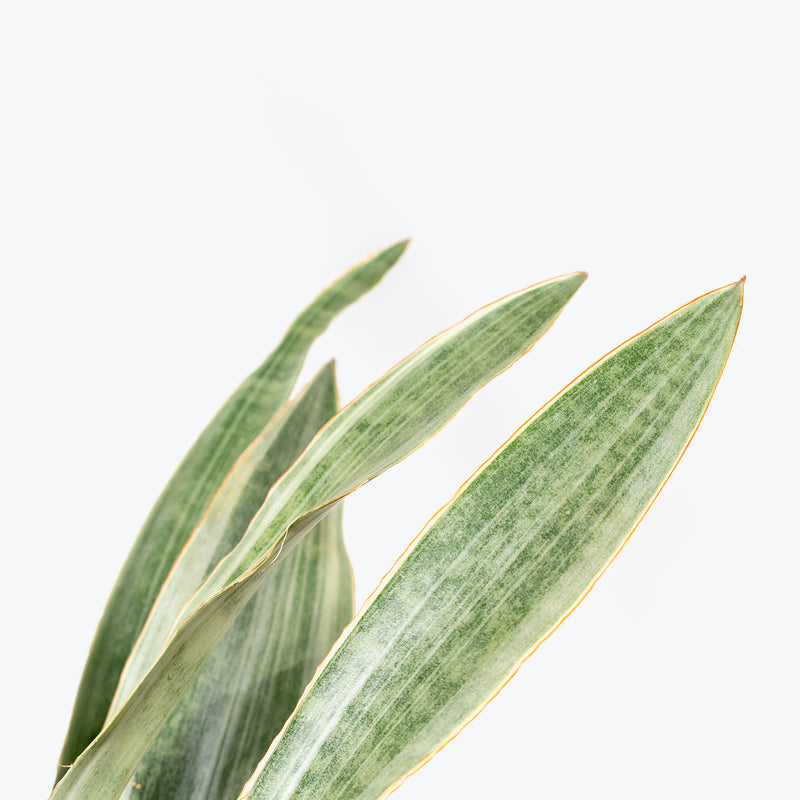
How to care for Sansevieria Sayuri
Sansevieria Sayuri should not be in a position to see the sun directly, although early morning or late evening sun is fine. Filtered sunlight through a sheer curtain is best and most homes are comprised primarily of indirect sunlight. The best spot for them is where they do not see the sun during the majority of the day but still get bright, indirect light.
Sansevieria Sayuri will do well in low light, but will grow faster with brighter light. A low light plant can pretty much survive anyplace inside your home as long as you have a window in the room. Remember, low light does not mean no light and plants will grow based on how much light they receive.
Sansevieria Sayuri likes the soil to be completely dry before the next watering. That usually takes about 4 weeks in an average home environment. It will vary depending on the time of year, your environment and lighting conditions, but for them, it's always safer to underwater or water when you see signs of lack of water (i.e. wrinkly or soft leaves). Water a little more often in the warmer months.
Their humidity requirement is low, so do not mist Sansevieria Sayuri or put them in a terrarium.
Sansevieria Sayuri is super easy to take care of, being able to handle all kinds of light levels and is known for its air-purifying capabilities. Just make sure to not overwater them and try not to let water sit between their leaves. Clean the leaves occasionally with a soft, damp cloth to remove dust and maintain the glossy appearance of the foliage. Some dry tips are completely normal on Snake Plants.
Sansevieria Sayuri is moderately toxic and can cause some adverse reactions when ingested so it is best to not let your pets eat it, which we advise for all plants in general. The severity of the reaction will depend on how much of the plant is ingested but, if you know your pet typically does not eat your plants, this plant will be suitable for your home..
Learn MoreView PlantSansevieria Silver Laurentii
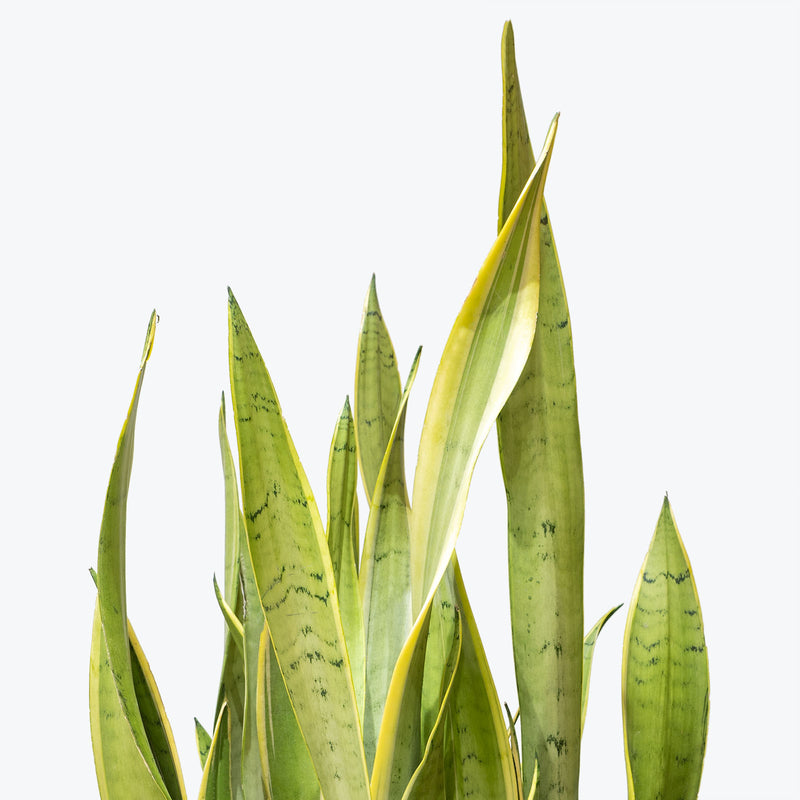
How to care for Sansevieria Silver Laurentii
They should not be in a position to see the sun directly, although early morning or late evening sun is fine. Filtered sunlight through a sheer curtain is best and most homes are comprised primarily of indirect sunlight. The best spot for them is where they do not see the sun during the majority of the day but still get bright, indirect light.
They will do well in low light, but will grow faster with brighter light. A low light plant can pretty much survive anyplace inside your home as long as you have a window in the room. Remember, low light does not mean no light and plants will grow based on how much light they receive.
They like the soil to be completely dry before the next watering. This can take up to 4 weeks in an average home environment but it will vary depending on the time of year, your environment and lighting conditions. For them, it's always safer to underwater or water when you see signs of lack of water (i.e. wrinkly or soft leaves). Water a little more often in the warmer months.
Their humidity requirement is low, so do not mist them or put them in a terrarium.
They are super easy to take care of, since they are able to handle all kinds of light levels, and are known for their air-purifying capabilities. Just make sure to not overwater them and try not to let water sit between their leaves. Some dry tips are completely normal on Snake Plants.
This plant is moderately toxic and can cause some adverse reactions when ingested so it is best to not let your pets eat it, which we advise for all plants in general. The severity of the reaction will depend on how much of the plant is ingested but, if you know your pet typically does not eat your plants, this plant will be suitable for your home..
Learn MoreView PlantSansevieria Silver Princess
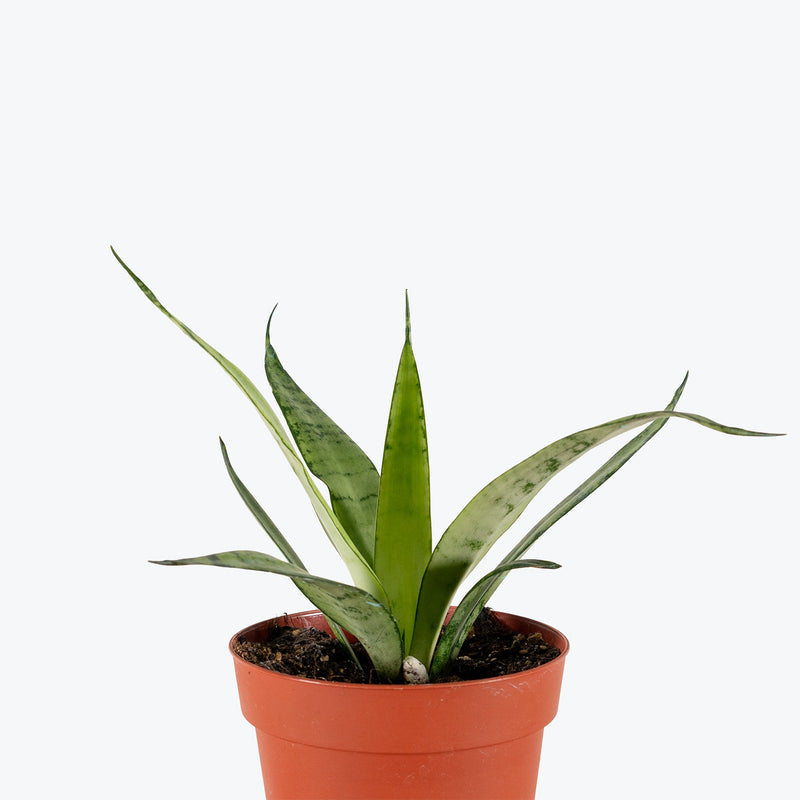
How to care for Sansevieria Silver Princess
Sansevieria Silver Princess should not be in a position to see the sun directly, although early morning or late evening sun is fine. Filtered sunlight through a sheer curtain is best and most homes are comprised primarily of indirect sunlight. The best spot for them is where they do not see the sun during the majority of the day but still get bright, indirect light.
Sansevieria Silver Princess will do well in low light, but will grow faster with brighter light. A low light plant can pretty much survive anyplace inside your home as long as you have a window in the room. Remember, low light does not mean no light and plants will grow based on how much light they receive.
Sansevieria Silver Princess likes the soil to be completely dry before the next watering. This can take up to 4 weeks in an average home environment but it will vary depending on the time of year, your environment and lighting conditions. For them, it's always safer to underwater or water when you see signs of lack of water (i.e. wrinkly or soft leaves). Water a little more often in the warmer months.
Sansevieria Silver Princess can live in any average home humidity condition and are fairly hardy.
Plant in a gritty, fast-draining soil mix to prevent root rot. Fertilize lightly once or twice per year during the growing season. Wipe leaves occasionally to highlight their silver sheen. Sansevieria Silver Princess is one of the easiest houseplants to maintain and an excellent air purifier.
Sansevieria Silver Princess is moderately toxic and can cause some adverse reactions when ingested so it is best to not let your pets eat it, which we advise for all plants in general. The severity of the reaction will depend on how much of the plant is ingested but, if you know your pet typically does not eat your plants, this plant will be suitable for your home..
Learn MoreView PlantSansevieria Starfish
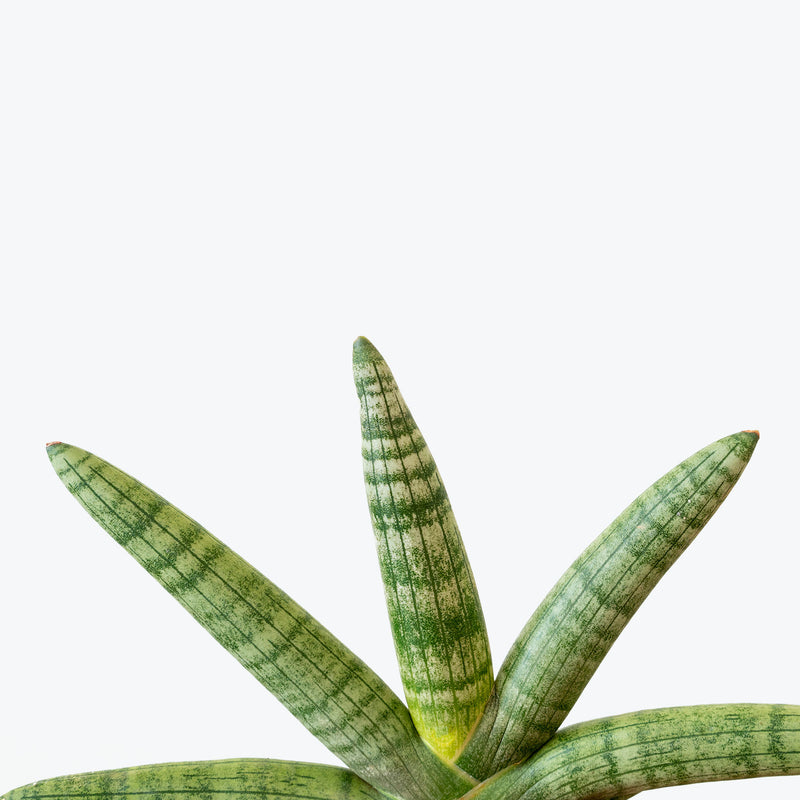
How to care for Sansevieria Starfish
Sansevieria Starfish should not be in a position to see the sun directly, although early morning or late evening sun is fine. Filtered sunlight through a sheer curtain is best and most homes are comprised primarily of indirect sunlight. The best spot for them is where they do not see the sun during the majority of the day but still get bright, indirect light.
Sansevieria Starfish will do well in low light, but will grow faster with brighter light. A low light plant can pretty much survive anyplace inside your home as long as you have a window in the room. Remember, low light does not mean no light and plants will grow based on how much light they receive.
Sansevieria Starfish likes the soil to be completely dry before the next watering. That usually takes about 4 weeks in an average home environment. It will vary depending on the time of year, your environment and lighting conditions, but for them, it's always safer to underwater or water when you see signs of lack of water (i.e. wrinkly or soft leaves). Water a little more often in the warmer months.
Sansevieria Starfish humidity requirement is low, so do not mist them or put them in a terrarium.
Sansevieria Starfish are super easy to take care of, being able to handle all kinds of light levels and are known for their air-purifying capabilities. Just make sure to not overwater them and try not to let water sit between their leaves. They are slow growers and do not require frequent fertilization. Clean the leaves occasionally to remove dust and other particulates that can accumulate, especially in a less humid environment. Some dry tips are completely normal on Snake Plants.
Sansevieria Starfish is moderately toxic and can cause some adverse reactions when ingested so it is best to not let your pets eat it, which we advise for all plants in general. The severity of the reaction will depend on how much of the plant is ingested but, if you know your pet typically does not eat your plants, this plant will be suitable for your home..
Learn MoreView PlantSansevieria Sweet Celery
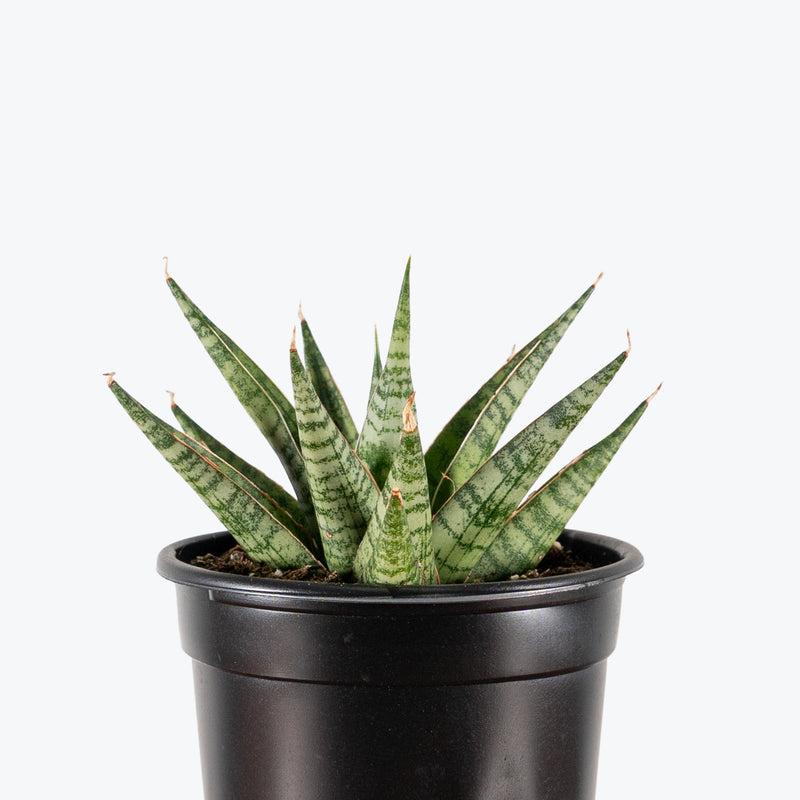
How to care for Sansevieria Sweet Celery
Sansevieria Sweet Celery should not be in a position to see the sun directly, although early morning or late evening sun is fine. Filtered sunlight through a sheer curtain is best and most homes are comprised primarily of indirect sunlight. The best spot for them is where they do not see the sun during the majority of the day but still get bright, indirect light.
Sansevieria Sweet Celery will do well in low light, but will grow faster with brighter light. A low light plant can pretty much survive anyplace inside your home as long as you have a window in the room. Remember, low light does not mean no light and plants will grow based on how much light they receive.
Sansevieria Sweet Celery likes the soil to be completely dry before the next watering. This can take up to 4 weeks in an average home environment but it will vary depending on the time of year, your environment and lighting conditions. For them, it's always safer to underwater or water when you see signs of lack of water (i.e. wrinkly or soft leaves). Water a little more often in the warmer months.
Sansevieria Sweet Celery can live in any average home humidity condition and are fairly hardy.
Use a well-draining cactus or succulent mix to prevent root rot. Fertilize Sansevieria Sweet Celery lightly once or twice a year during the growing season with a diluted cactus fertilizer. Wipe leaves occasionally to showcase their silvery texture. Like most Sansevierias, it’s nearly indestructible and doubles as an effective air purifier.
Sansevieria Sweet Celery is moderately toxic and can cause some adverse reactions when ingested so it is best to not let your pets eat it, which we advise for all plants in general. The severity of the reaction will depend on how much of the plant is ingested but, if you know your pet typically does not eat your plants, this plant will be suitable for your home..
Learn MoreView PlantSansevieria Tigressa Shark Fin
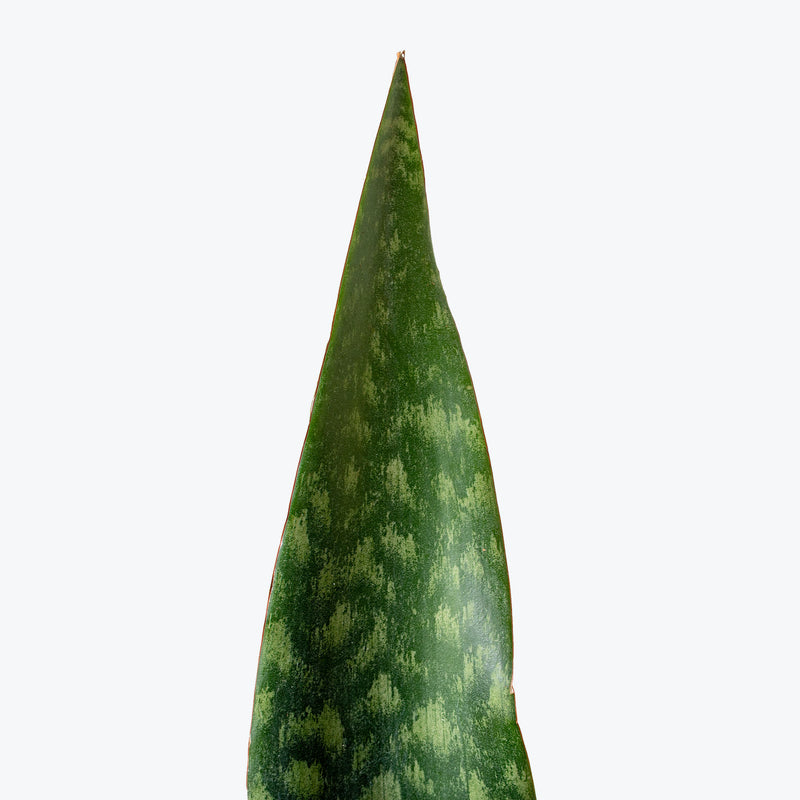
How to care for Sansevieria Tigressa Shark Fin
They should not be in a position to see the sun directly, although early morning or late evening sun is fine. Filtered sunlight through a sheer curtain is best and most homes are comprised primarily of indirect sunlight. The best spot for them is where they do not see the sun during the majority of the day but still get bright, indirect light.
They will do well in low light, but will grow faster with brighter light. A low light plant can pretty much survive anyplace inside your home as long as you have a window in the room. Remember, low light does not mean no light and plants will grow based on how much light they receive.
They like the soil to be completely dry before the next watering. That usually takes about 4 weeks in an average home environment. It will vary depending on the time of year, your environment and lighting conditions, but for them, it's always safer to underwater or water when you see signs of lack of water (i.e. wrinkly or soft leaves). Water a little more often in the warmer months.
Their humidity requirement is low, so do not mist them or put them in a terrarium.
They are super easy to take care of, being able to handle all kinds of light levels and are known for their air-purifying capabilities. Just make sure to not overwater them and try not to let water sit between their leaves. Some dry tips are completely normal on Snake Plants.
This plant is moderately toxic and can cause some adverse reactions when ingested so it is best to not let your pets eat it, which we advise for all plants in general. The severity of the reaction will depend on how much of the plant is ingested but, if you know your pet typically does not eat your plants, this plant will be suitable for your home..
Learn MoreView PlantSansevieria Whitney
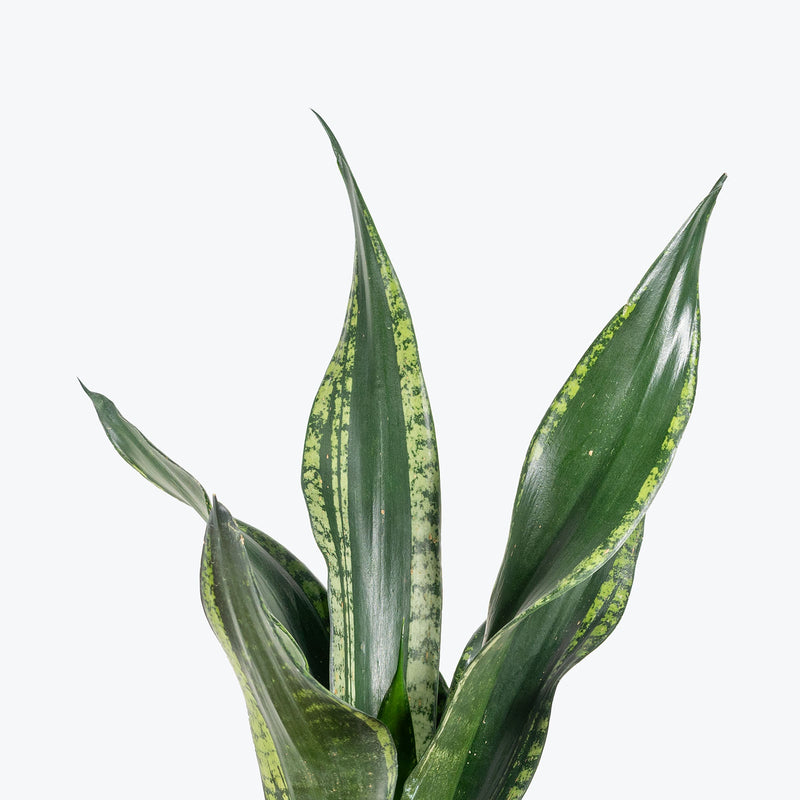
How to care for Sansevieria Whitney
Sansevieria Whitney should not be in a position to see the sun directly, although early morning or late evening sun is fine. Filtered sunlight through a sheer curtain is best and most homes are comprised primarily of indirect sunlight. The best spot for them is where they do not see the sun during the majority of the day but still get bright, indirect light.
Sansevieria Whitney will do well in low light, but will grow faster with brighter light. A low light plant can pretty much survive anyplace inside your home as long as you have a window in the room. Remember, low light does not mean no light and plants will grow based on how much light they receive.
Sansevieria Whitney likes the soil to be completely dry before the next watering. This can take up to 4 weeks in an average home environment but it will vary depending on the time of year, your environment and lighting conditions. For them, it's always safer to underwater or water when you see signs of lack of water (i.e. wrinkly or soft leaves). Water a little more often in the warmer months.
Their humidity requirement is low, so do not mist Sansevieria Whitney or put them in a terrarium.
Sansevieria Whitney is super easy to take care of, incredibly hardy, and known for their air-purifying capabilities. The more light a plant gets the more water it needs, but make sure you do not overwater them and try not to let water sit in between or on their leaves for extended periods of time. Cleaning the leaves occasionally with a damp cloth can help maintain their shine and health, removing dust and potential pests.
Sansevieria Whitney is moderately toxic and can cause some adverse reactions when ingested so it is best to not let your pets eat it, which we advise for all plants in general. The severity of the reaction will depend on how much of the plant is ingested but, if you know your pet typically does not eat your plants, this plant will be suitable for your home..
Learn MoreView PlantSansevieria Wintergreen
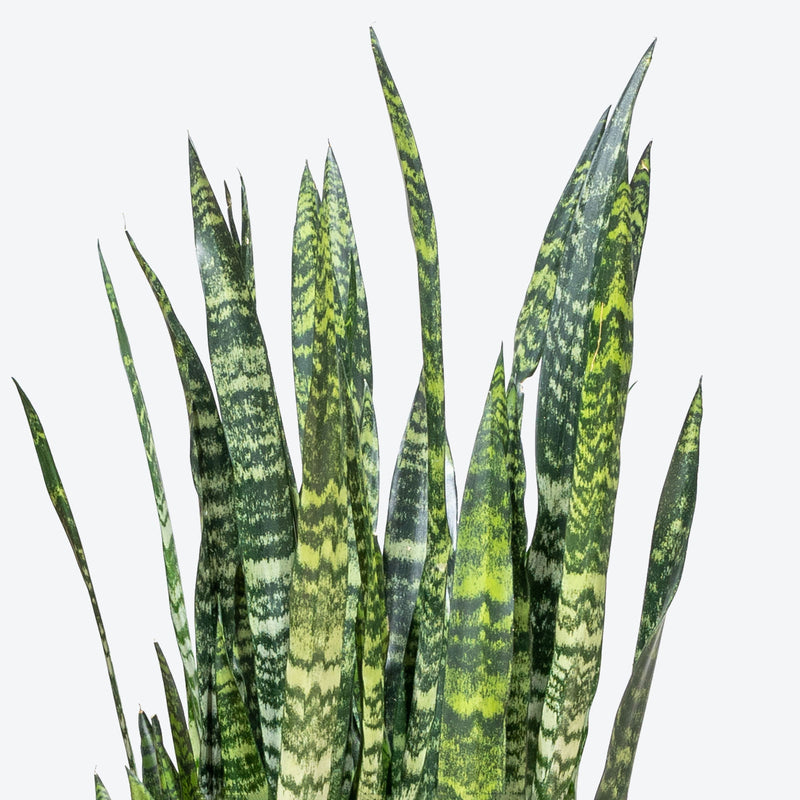
How to care for Sansevieria Wintergreen
They should not be in a position to see the sun directly, although early morning or late evening sun is fine. Filtered sunlight through a sheer curtain is best and most homes are comprised primarily of indirect sunlight. The best spot for them is where they do not see the sun during the majority of the day but still get bright, indirect light.
They will do well in low light, but will grow faster with brighter light. A low light plant can pretty much survive anyplace inside your home as long as you have a window in the room. Remember, low light does not mean no light and plants will grow based on how much light they receive.
They like the soil to be completely dry before the next watering. This can take up to 4 weeks in an average home environment but it will vary depending on the time of year, your environment and lighting conditions. For them, it's always safer to underwater or water when you see signs of lack of water (i.e. wrinkly or soft leaves). Water a little more often in the warmer months.
Their humidity requirement is low, so do not mist them or put them in a terrarium.
They are super easy to take care of, being able to handle all kinds of light levels and are known for their air-purifying capabilities. Just make sure to not overwater them and try not to let water sit between their leaves. Some dry tips are completely normal on Snake Plants.
This plant is moderately toxic and can cause some adverse reactions when ingested so it is best to not let your pets eat it, which we advise for all plants in general. The severity of the reaction will depend on how much of the plant is ingested but, if you know your pet typically does not eat your plants, this plant will be suitable for your home..
Learn MoreView PlantSansevieria Yaya
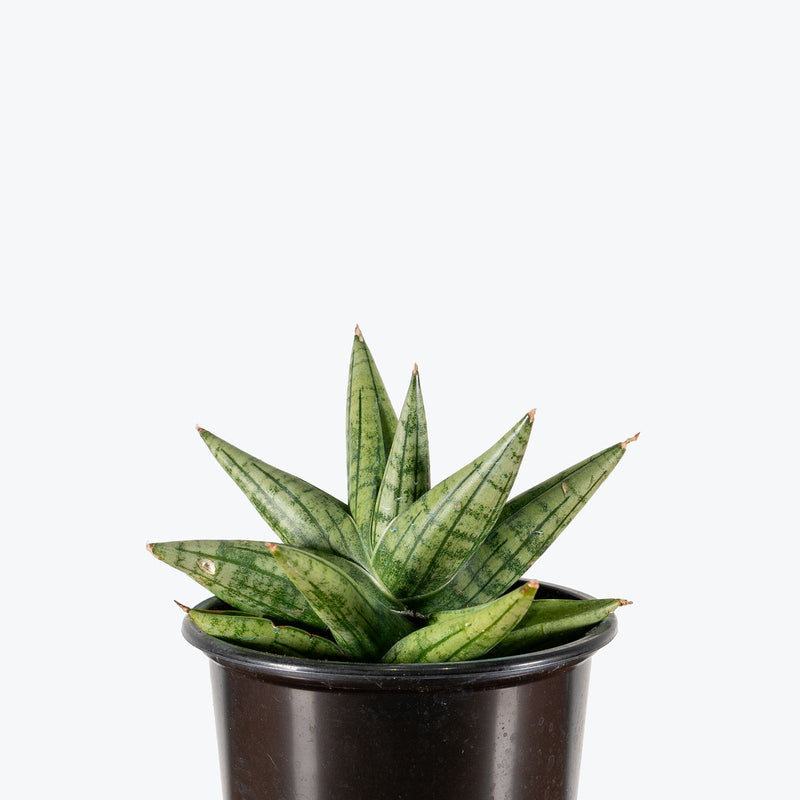
How to care for Sansevieria Yaya
Sansevieria Yaya should not be in a position to see the sun directly, although early morning or late evening sun is fine. Filtered sunlight through a sheer curtain is best and most homes are comprised primarily of indirect sunlight. The best spot for them is where they do not see the sun during the majority of the day but still get bright, indirect light.
Sansevieria Yaya will do well in low light, but will grow faster with brighter light. A low light plant can pretty much survive anyplace inside your home as long as you have a window in the room. Remember, low light does not mean no light and plants will grow based on how much light they receive.
Sansevieria Yaya likes the soil to be completely dry before the next watering. This can take up to 4 weeks in an average home environment but it will vary depending on the time of year, your environment and lighting conditions. For them, it's always safer to underwater or water when you see signs of lack of water (i.e. wrinkly or soft leaves). Water a little more often in the warmer months.
Their humidity requirement is low, so do not mist Sansevieria Yaya or put them in a terrarium.
Sansevieria Yaya is super easy to take care of. It can handle all kinds of light levels and is known for its air-purifying capabilities. Just make sure not to overwater it and try not to let water sit between its leaves. Dust the leaves regularly to keep them clean, and check periodically for pests, such as spider mites and mealybugs.
Sansevieria Yaya is moderately toxic and can cause some adverse reactions when ingested so it is best to not let your pets eat it, which we advise for all plants in general. The severity of the reaction will depend on how much of the plant is ingested but, if you know your pet typically does not eat your plants, this plant will be suitable for your home..
Learn MoreView PlantSansevieria Yellow Flame
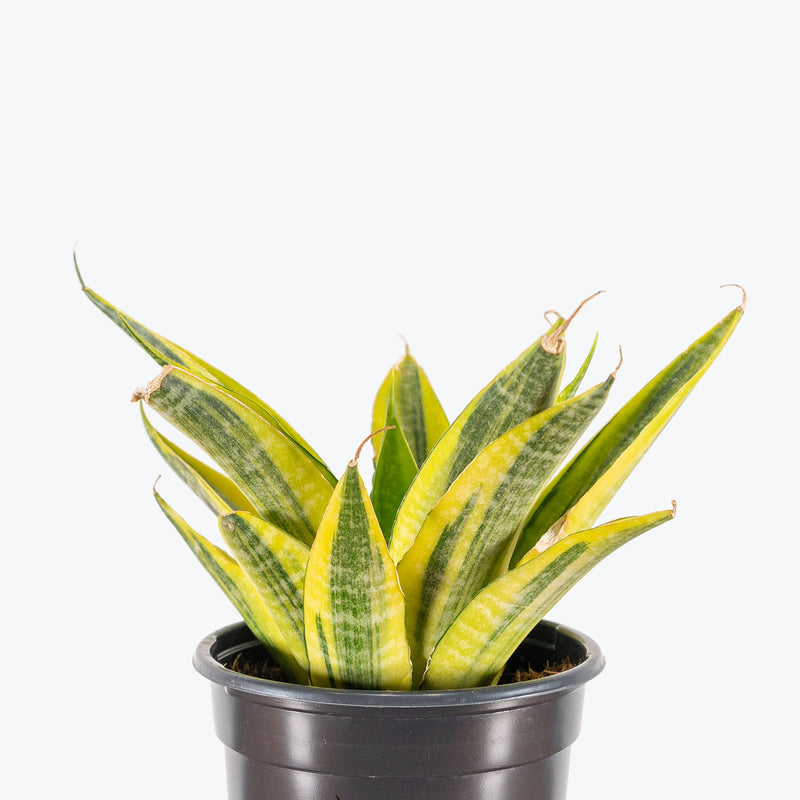
How to care for Sansevieria Yellow Flame
Sansevieria Yellow Flame should not be in a position to see the sun directly, although early morning or late evening sun is fine. Filtered sunlight through a sheer curtain is best and most homes are comprised primarily of indirect sunlight. The best spot for them is where they do not see the sun during the majority of the day but still get bright, indirect light.
Sansevieria Yellow Flame will do well in low light, but will grow faster with brighter light. A low light plant can pretty much survive anyplace inside your home as long as you have a window in the room. Remember, low light does not mean no light and plants will grow based on how much light they receive.
Sansevieria Yellow Flame likes the soil to be completely dry before the next watering. This can take up to 4 weeks in an average home environment but it will vary depending on the time of year, your environment and lighting conditions. For them, it's always safer to underwater or water when you see signs of lack of water (i.e. wrinkly or soft leaves). Water a little more often in the warmer months.
Sansevieria Yellow Flame can live in any average home humidity condition and are fairly hardy.
Fertilize Sansevieria Yellow Flame sparingly; once or twice a year during the growing season with a balanced, water-soluble fertilizer is sufficient. Snake plants generally do not require frequent feeding. Be cautious about repotting—Sansevieria prefers to be root-bound and only needs repotting every few years.
Sansevieria Yellow Flame is moderately toxic and can cause some adverse reactions when ingested so it is best to not let your pets eat it, which we advise for all plants in general. The severity of the reaction will depend on how much of the plant is ingested but, if you know your pet typically does not eat your plants, this plant will be suitable for your home..
Learn MoreView PlantSansevieria Yellowstone
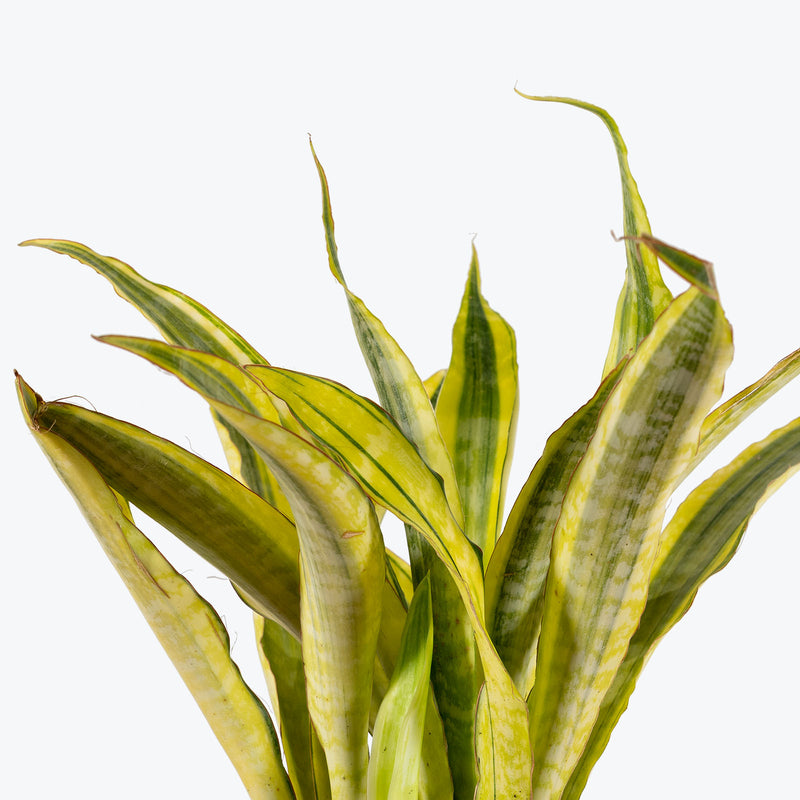
How to care for Sansevieria Yellowstone
Sansevieria Yellowstone should not be in a position to see the sun directly, although early morning or late evening sun is fine. Filtered sunlight through a sheer curtain is best and most homes are comprised primarily of indirect sunlight. The best spot for them is where they do not see the sun during the majority of the day but still get bright, indirect light.
Sansevieria Yellowstone will do well in low light, but will grow faster with brighter light. A low light plant can pretty much survive anyplace inside your home as long as you have a window in the room. Remember, low light does not mean no light and plants will grow based on how much light they receive.
Sansevieria Yellowstone likes the soil to be completely dry before the next watering. That usually takes about 4 weeks in an average home environment. It will vary depending on the time of year, your environment and lighting conditions, but for them, it's always safer to underwater or water when you see signs of lack of water (i.e. wrinkly or soft leaves). Water a little more often in the warmer months.
Their humidity requirement is low, so do not mist Sansevieria Yellowstone or put them in a terrarium.
Sansevieria Yellowstone is super easy to take care of, being able to handle all kinds of light levels and is known for its air-purifying capabilities. Just make sure to not overwater them and try not to let water sit between their leaves. Periodically wipe the leaves with a soft, damp cloth to remove dust and maintain their vibrant appearance. Some dry tips are completely normal on Snake Plants.
Sansevieria Yellowstone is moderately toxic and can cause some adverse reactions when ingested so it is best to not let your pets eat it, which we advise for all plants in general. The severity of the reaction will depend on how much of the plant is ingested but, if you know your pet typically does not eat your plants, this plant will be suitable for your home..
Learn MoreView PlantSansevieria Zeylanica
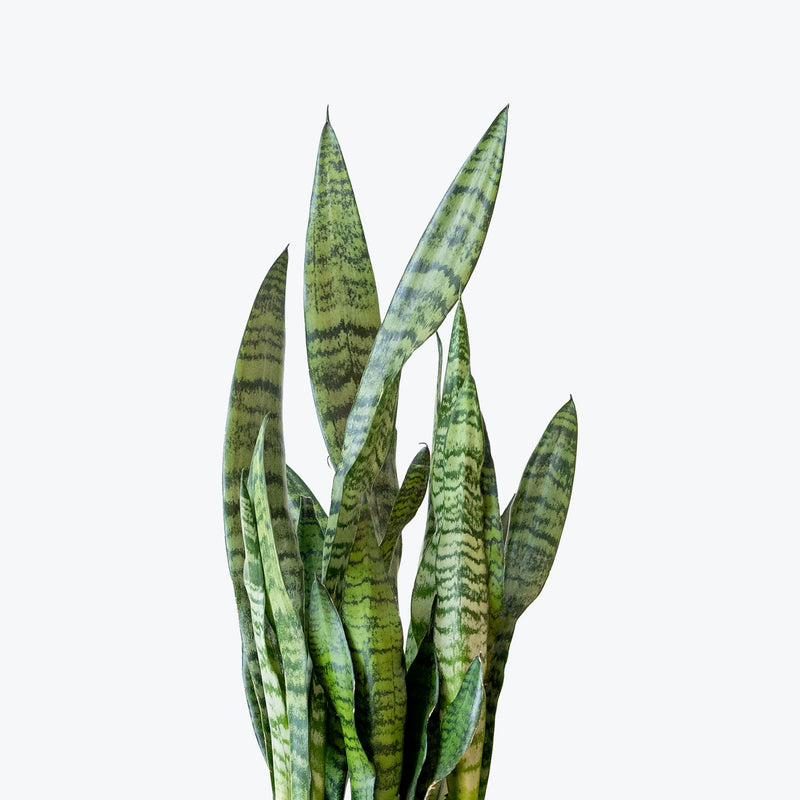
How to care for Sansevieria Zeylanica
Sansevieria Zeylanica should not be in a position to see the sun directly, although early morning or late evening sun is fine. Filtered sunlight through a sheer curtain is best and most homes are comprised primarily of indirect sunlight. The best spot for them is where they do not see the sun during the majority of the day but still get bright, indirect light.
Sansevieria Zeylanica will do well in low light, but will grow faster with brighter light. A low light plant can pretty much survive anyplace inside your home as long as you have a window in the room. Remember, low light does not mean no light and plants will grow based on how much light they receive.
Sansevieria Zeylanica likes the soil to be completely dry before the next watering. That usually takes about 4 weeks in an average home environment. It will vary depending on the time of year, your environment and lighting conditions, but for them, it's always safer to underwater or water when you see signs of lack of water (i.e. wrinkly or soft leaves). Water a little more often in the warmer months.
Sansevieria Zeylanica humidity requirement is low, so do not mist them or put them in a terrarium.
Sansevieria Zeylanica is super easy to take care of, being able to handle all kinds of light levels and is known for its air-purifying capabilities. Just make sure to not overwater them and try not to let water sit between their leaves. Some dry tips are completely normal on Snake Plants. This plant benefits from being pot-bound, so repotting is only necessary when the roots outgrow the pot, typically every 2-3 years.
Sansevieria Zeylanica is moderately toxic and can cause some adverse reactions when ingested so it is best to not let your pets eat it, which we advise for all plants in general. The severity of the reaction will depend on how much of the plant is ingested but, if you know your pet typically does not eat your plants, this plant will be suitable for your home..
Learn MoreView PlantSansevieria Zeylanica Fan
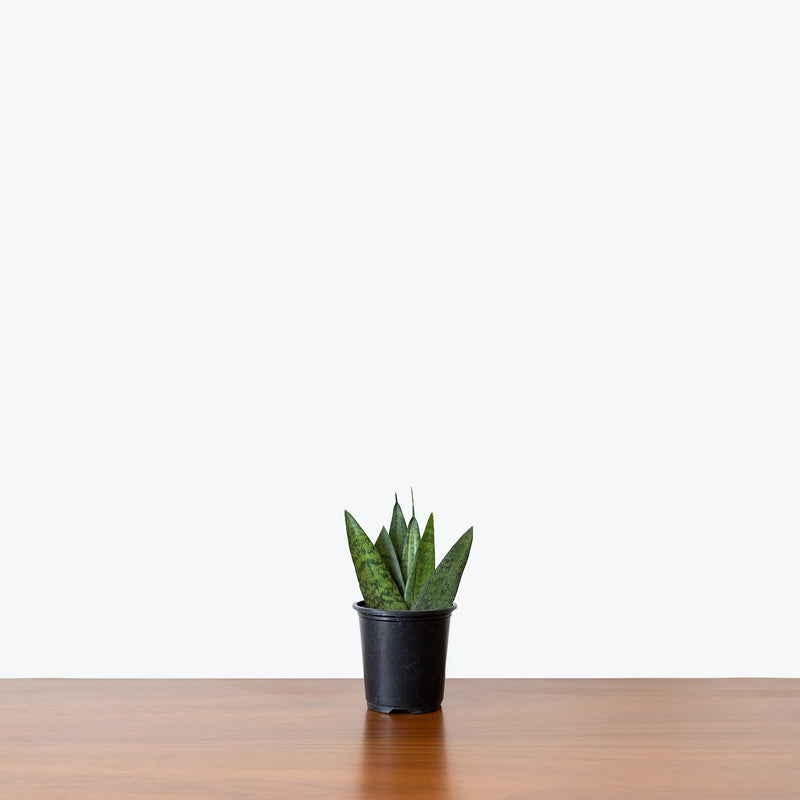
How to care for Sansevieria Zeylanica Fan
They should not be in a position to see the sun directly, although early morning or late evening sun is fine. Filtered sunlight through a sheer curtain is best and most homes are comprised primarily of indirect sunlight. The best spot for them is where they do not see the sun during the majority of the day but still get bright, indirect light.
They will do well in low light, but will grow faster with brighter light. A low light plant can pretty much survive anyplace inside your home as long as you have a window in the room. Remember, low light does not mean no light and plants will grow based on how much light they receive.
They like the soil to be completely dry before the next watering. That usually takes about 4 weeks in an average home environment. It will vary depending on the time of year, your environment and lighting conditions, but for them, it's always safer to underwater or water when you see signs of lack of water (i.e. wrinkly or soft leaves). Water a little more often in the warmer months.
Their humidity requirement is low, so do not mist them or put them in a terrarium.
They are super easy to take care of, being able to handle all kinds of light levels and are known for their air-purifying capabilities. Just make sure to not overwater them and try not to let water sit between their leaves. Some dry tips are completely normal on Snake Plants.
This plant is moderately toxic and can cause some adverse reactions when ingested so it is best to not let your pets eat it, which we advise for all plants in general. The severity of the reaction will depend on how much of the plant is ingested but, if you know your pet typically does not eat your plants, this plant will be suitable for your home..
Learn MoreView PlantSarracenia Farnhamii
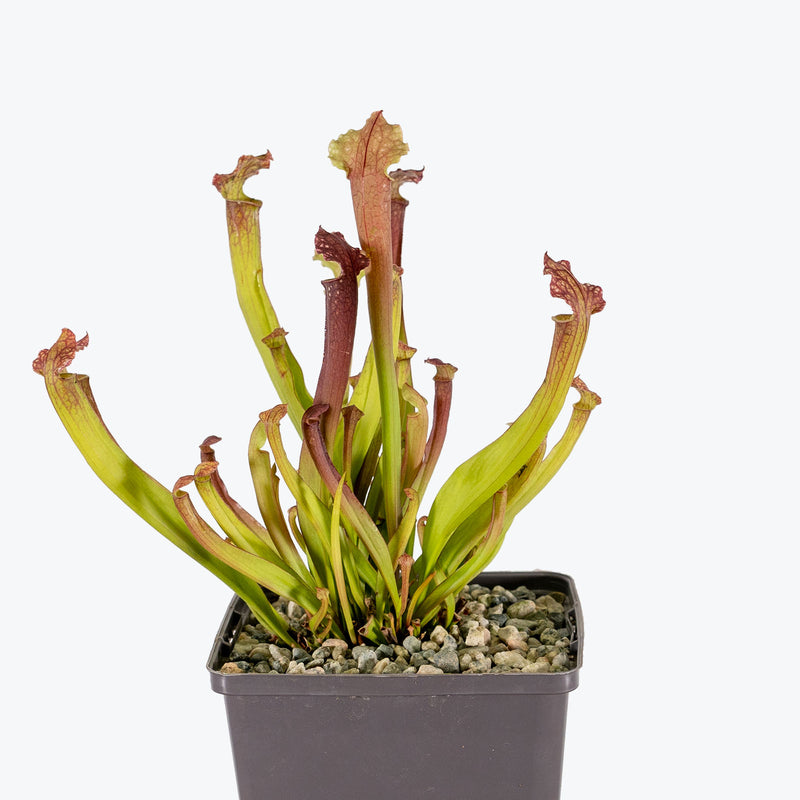
How to care for Sarracenia Farnhamii
Sarracenia Farnhamii enjoys some direct sun, but they'll also do well in bright, indirect light. It is best to place this plant somewhere where it will receive some nice morning sun, or a couple hours of afternoon sun, and then indirect light the rest of the day.
Sarracenia Farnhamii will do best in bright light. A nice bright place inside your home would be on the window sill or a stool that is right next to a window, either with or without blinds, depending on if the plant can handle sun. Remember that plants will grow based on how much light they receive.
Sarracenia Farnhamii likes the soil to stay consistently moist, but not soaking wet. Give them water whenever just the surface of the soil is starting to get dry. Expect to water more often in brighter light and less often in lower light.
Sarracenia Farnhamii likes a high humidity environment, give them a mist daily or as often as possible. Alternatively, you can put them around a humidifier. Although they won't die if they don't receive enough humidity, their leaves may have some dry, crunchy, or yellow edges.
As a carnivorous plant, Sarracenia Farnhamii does not require fertilization and instead derives its nutrients from the insects it traps. Do not attempt to feed it with household bugs or meat. During the winter, this plant goes dormant and requires less water and light.
You can feel comfortable having Sarracenia Farnhamii around your home in the potential case where your pet feels like nibbling on it. However, we typically recommend keeping your pets from eating any of your houseplants..
View PlantSarracenia Maroon
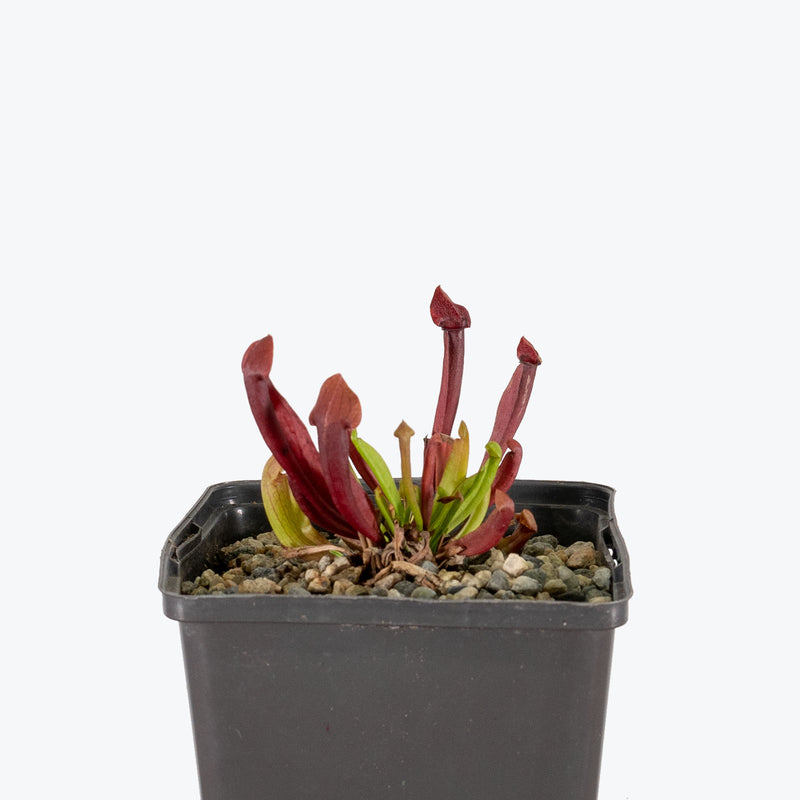
How to care for Sarracenia Maroon
They enjoy some direct sun, but they'll also do well in bright, indirect light. It is best to place this plant somewhere where it will receive some nice morning sun, or a couple hours of afternoon sun, and then indirect light the rest of the day.
They will do best in bright light. A nice bright place inside your home would be on the window sill or a stool that is right next to a window, either with or without blinds, depending on if the plant can handle sun. Remember that plants will grow based on how much light they receive.
They like the soil to stay consistently moist, but not soaking wet. Give them water whenever just the surface of the soil is starting to get dry. Expect to water more often in brighter light and less often in lower light.
They like a high humidity environment, give them a mist daily or as often as possible. Alternatively, you can put them around a humidifier. Although they won't die if they don't receive enough humidity, their leaves may have some dry, crunchy, or yellow edges.
Sarracenia 'Maroon' does not require fertilization as it obtains its nutrients from the insects it catches. Avoid feeding it with household bugs or meat. During winter, this plant enters a dormancy period and requires less water and light.
You can feel comfortable having this plant around your home in the potential case where your pet feels like nibbling on it. However, we typically recommend keeping your pets from eating any of your houseplants..
View PlantSarracenia Pitcher Plant
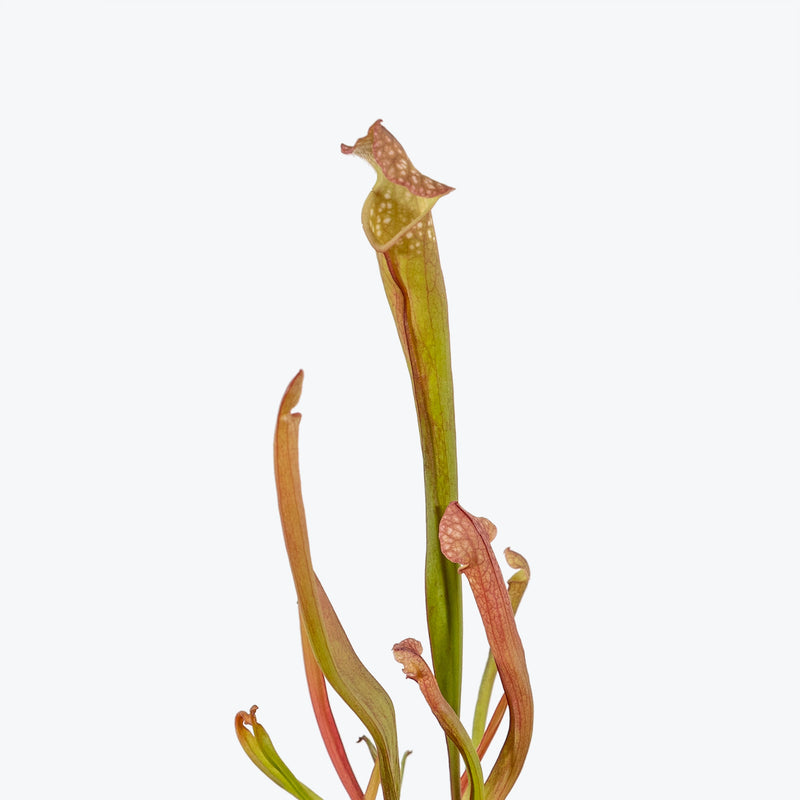
How to care for Sarracenia Pitcher Plant
They enjoy some direct sun, but they'll also do well in bright, indirect light. It is best to place this plant somewhere where it will receive some nice morning sun, or a couple hours of afternoon sun, and then indirect light the rest of the day.
They will do best in bright light. A nice bright place inside your home would be on the window sill or a stool that is right next to a window, either with or without blinds, depending on if the plant can handle sun. Remember that plants will grow based on how much light they receive.
They like the soil to stay consistently moist, but not soaking wet. Give them water whenever just the surface of the soil is starting to get dry. Expect to water more often in brighter light and less often in lower light.
They can live in any average home humidity condition and are fairly hardy unless you have a very dry home or place your plant in excessively dry air such as above a radiator.
Keep your plant in a warm room and water it with distilled or rain water. Chemicals in our tap water can often burn the pitchers. If you are growing the plant where it cannot catch insects for long periods, you can add an occasional small insect such as a fruit fly or fungus gnat.
You can feel comfortable having this plant around your home in the potential case where your pet feels like nibbling on it. However, we typically recommend keeping your pets from eating any of your houseplants..
View PlantSarracenia Purpurea Venosa
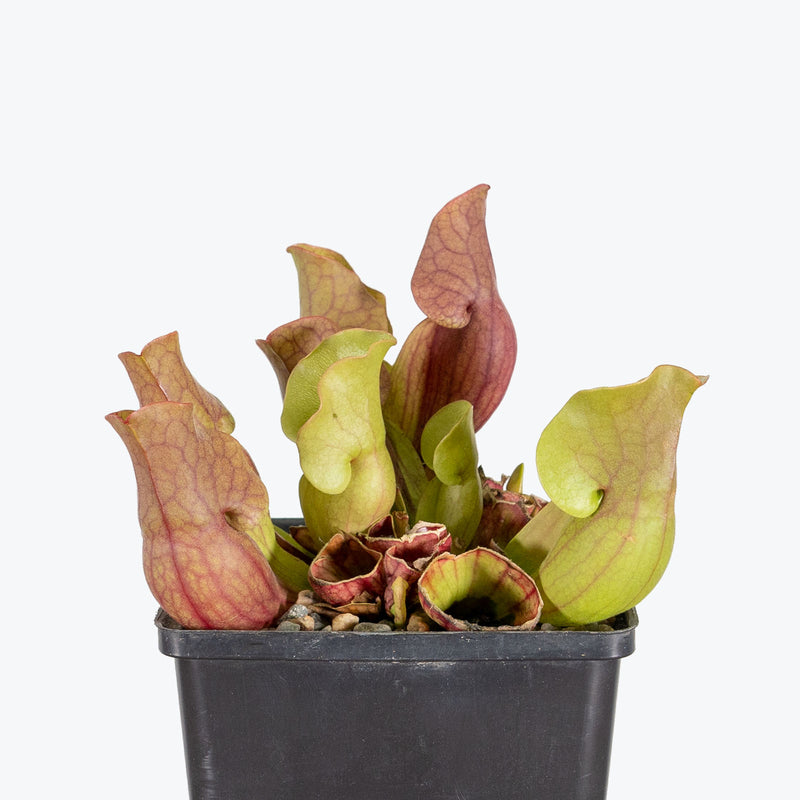
How to care for Sarracenia Purpurea Venosa
Sarracenia Purpurea Venosa enjoys some direct sun, but they'll also do well in bright, indirect light. It is best to place this plant somewhere where it will receive some nice morning sun, or a couple hours of afternoon sun, and then indirect light the rest of the day.
Sarracenia Purpurea Venosa will do best in bright light. A nice bright place inside your home would be on the window sill or a stool that is right next to a window, either with or without blinds, depending on if the plant can handle sun. Remember that plants will grow based on how much light they receive.
Sarracenia Purpurea Venosa likes the soil to stay consistently moist, but not soaking wet. Give them water whenever just the surface of the soil is starting to get dry. Expect to water more often in brighter light and less often in lower light.
Sarracenia Purpurea Venosa likes a high humidity environment, give them a mist daily or as often as possible. Alternatively, you can put them around a humidifier. Although they won't die if they don't receive enough humidity, their leaves may have some dry, crunchy, or yellow edges.
Plant in a mixture of sphagnum peat moss and perlite or sand to ensure proper drainage and acidity. Do not use fertilizers or soil additives, as these can harm the plant. During the winter, Sarracenia Purpurea Venosa will enter a dormancy period where it requires cooler temperatures and less water. Allow some of the pitchers to die back naturally during this time.
You can feel comfortable having Sarracenia Purpurea Venosa around your home in the potential case where your pet feels like nibbling on it. However, we typically recommend keeping your pets from eating any of your houseplants..
View PlantSarracenia Velvet
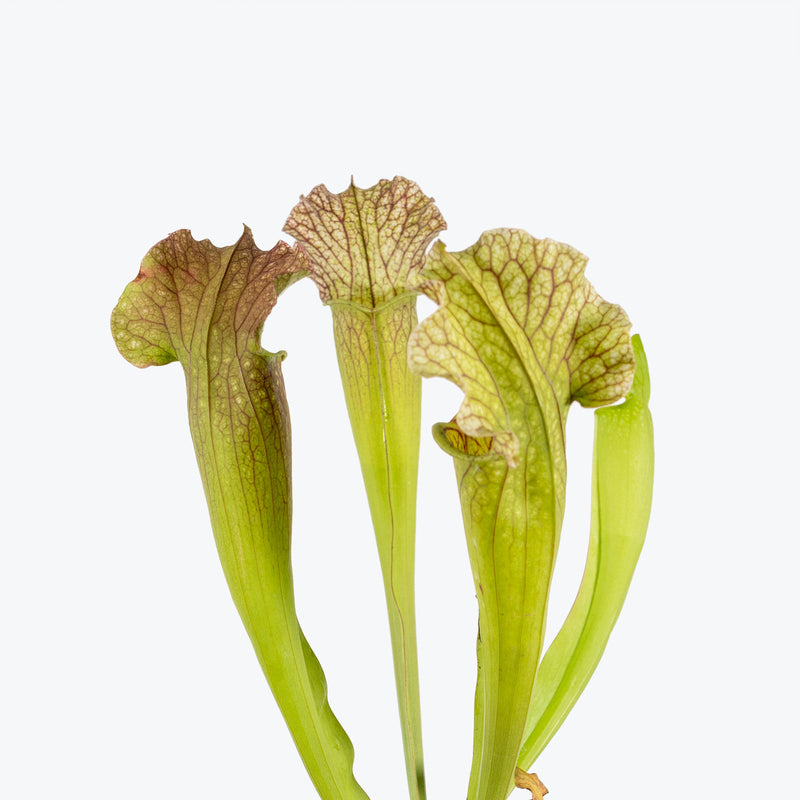
How to care for Sarracenia Velvet
They enjoy some direct sun, but they'll also do well in bright, indirect light. It is best to place this plant somewhere where it will receive some nice morning sun, or a couple hours of afternoon sun, and then indirect light the rest of the day.
They will do best in bright light. A nice bright place inside your home would be on the window sill or a stool that is right next to a window, either with or without blinds, depending on if the plant can handle sun. Remember that plants will grow based on how much light they receive.
They like the soil to stay consistently moist, but not soaking wet. Give them water whenever just the surface of the soil is starting to get dry. Expect to water more often in brighter light and less often in lower light.
They like a high humidity environment, give them a mist daily or as often as possible. Alternatively, you can put them around a humidifier. Although they won't die if they don't receive enough humidity, their leaves may have some dry, crunchy, or yellow edges.
Sarracenia 'Velvet' does not require fertilization as it obtains its nutrients from the insects it traps. Avoid feeding it household bugs or meat. During the winter, this plant enters a dormancy period and needs less water and light.
You can feel comfortable having this plant around your home in the potential case where your pet feels like nibbling on it. However, we typically recommend keeping your pets from eating any of your houseplants..
View PlantSchismatoglottis Silver Borneo
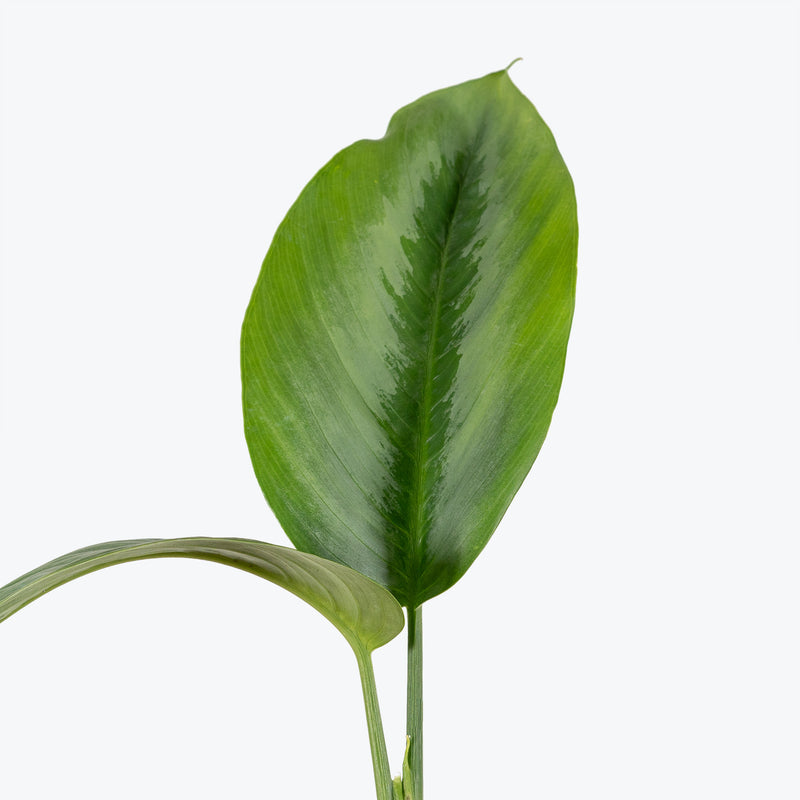
How to care for Schismatoglottis Silver Borneo
They should not be in a position to see the sun directly, although early morning or late evening sun is fine. Filtered sunlight through a sheer curtain is best and most homes are comprised primarily of indirect sunlight. The best spot for them is where they do not see the sun during the majority of the day but still get bright, indirect light.
They will do well in medium light but will grow faster with brighter light. A good medium-light place in your home would be in the middle of a room that has a regular size window. Remember that plants will grow based on how much light they receive.
They need to be watered when the top half of the soil is dry to the touch. That usually takes about 1 week in an average home environment. It will vary depending on the time of year, your environment and lighting conditions, but it's always safer to underwater or give the soil a check before you water again. Expect to water more often in brighter light and less often in lower light.
They will do well in average humidity environments but will appreciate a little bit of humidity if provided, give them a mist daily or get a humidifier.
Ensure you use a well-draining potting mix, rich in organic matter, to replicate its natural habitat. Regularly check for any signs of pests like spider mites or aphids, especially under the leaves. Avoid leaving water on the leaves for extended periods to prevent fungal infections.
This plant is moderately toxic and can cause some adverse reactions when ingested so it is best to not let your pets eat it, which we advise for all plants in general. The severity of the reaction will depend on how much of the plant is ingested but, if you know your pet typically does not eat your plants, this plant will be suitable for your home..
View PlantSchismatoglottis Thailand
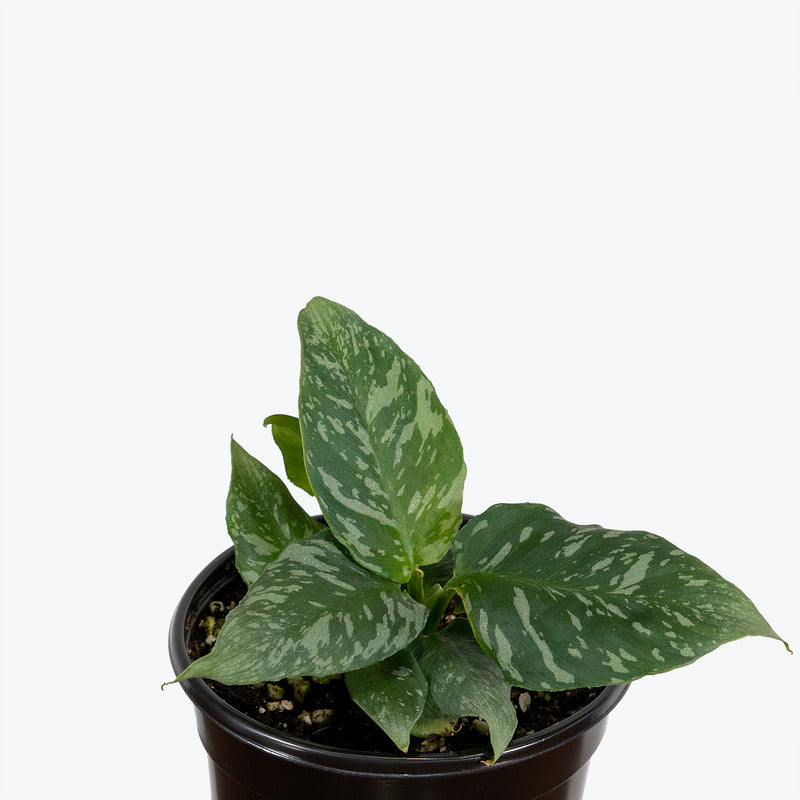
How to care for Schismatoglottis Thailand
They should not be in a position to see the sun directly, although early morning or late evening sun is fine. Filtered sunlight through a sheer curtain is best and most homes are comprised primarily of indirect sunlight. The best spot for them is where they do not see the sun during the majority of the day but still get bright, indirect light.
They will do well in medium light but will grow faster with brighter light. A good medium-light place in your home would be in the middle of a room that has a regular size window. Remember that plants will grow based on how much light they receive.
They need to be watered when the top half of the soil is dry to the touch. That usually takes about 1 week in an average home environment. It will vary depending on the time of year, your environment and lighting conditions, but it's always safer to underwater or give the soil a check before you water again. Expect to water more often in brighter light and less often in lower light.
They will do well in average humidity environments but will appreciate a little bit of humidity if provided, give them a mist daily or get a humidifier.
It is important to keep them watered during the active growing period, but be sure to water according to the light levels the plant is in and to let the water drain after doing so. Also, cut back on watering during the winter months, allowing the soil to mostly dry out. A well-draining media is key here!
This plant is moderately toxic and can cause some adverse reactions when ingested so it is best to not let your pets eat it, which we advise for all plants in general. The severity of the reaction will depend on how much of the plant is ingested but, if you know your pet typically does not eat your plants, this plant will be suitable for your home..
View PlantSchismatoglottis Wallichi
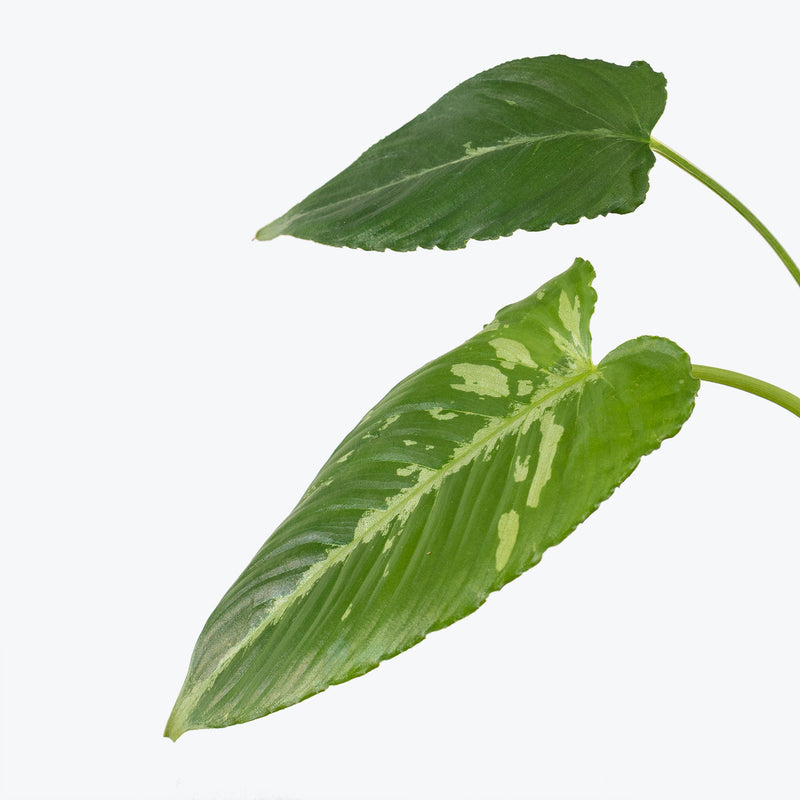
How to care for Schismatoglottis Wallichi
They should not be in a position to see the sun directly, although early morning or late evening sun is fine. Filtered sunlight through a sheer curtain is best and most homes are comprised primarily of indirect sunlight. The best spot for them is where they do not see the sun during the majority of the day but still get bright, indirect light.
They will do well in medium light but will grow faster with brighter light. A good medium-light place in your home would be in the middle of a room that has a regular size window. Remember that plants will grow based on how much light they receive.
They need to be watered when the top half of the soil is dry to the touch. That usually takes about 1 week in an average home environment. It will vary depending on the time of year, your environment and lighting conditions, but it's always safer to underwater or give the soil a check before you water again. Expect to water more often in brighter light and less often in lower light.
They will do well in average humidity environments but will appreciate a little bit of humidity if provided, give them a mist daily or get a humidifier.
It is important to keep them watered during the active growing period, but be sure to water according to the light levels the plant is in and to let the water drain after doing so. Also, cut back on watering during the winter months, allowing the soil to mostly dry out. A well-draining media is key here!
This plant is moderately toxic and can cause some adverse reactions when ingested so it is best to not let your pets eat it, which we advise for all plants in general. The severity of the reaction will depend on how much of the plant is ingested but, if you know your pet typically does not eat your plants, this plant will be suitable for your home..
View PlantSchwarz's Barrel Cactus
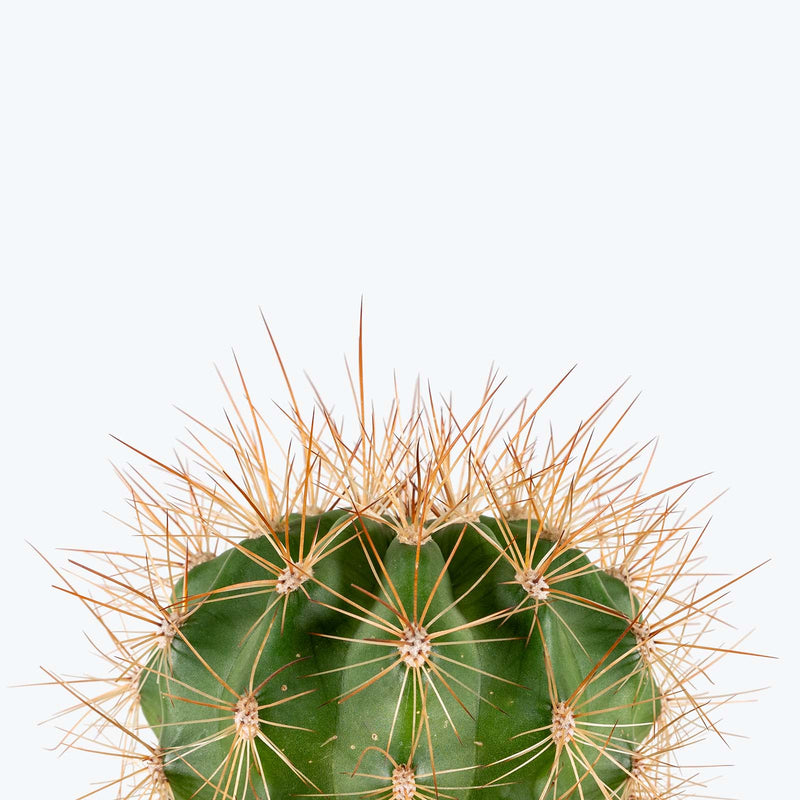
How to care for Schwarz's Barrel Cactus
Schwarz's Barrel Cactus enjoys some direct sun, but they'll also do well in bright, indirect light. It is best to place this plant somewhere where it will receive some nice morning sun, or a couple hours of afternoon sun, and then indirect light the rest of the day.
Schwarz's Barrel Cactus will do best in bright light. A nice bright place inside your home would be on the window sill or a stool that is right next to a window, either with or without blinds, depending on if the plant can handle sun. Remember that plants will grow based on how much light they receive.
Schwarz's Barrel Cactus likes the soil to be completely dry before the next watering. That usually takes about 4 weeks in an average home environment. It will vary depending on the time of year, your environment and lighting conditions, but for them, it's always safer to underwater or water when you see signs of lack of water (i.e. wrinkly or soft leaves). Water a little more often in the warmer months!
Their humidity requirement is low, so do not mist Schwarz's Barrel Cactus or put them in an enclosed terrarium.
Use a well-draining soil mix specifically designed for cacti and succulents. Fertilize sparingly with a cactus-specific fertilizer during the growing season to support flowering and overall health but avoid over-fertilizing, which can harm the plant. When handling Schwarz's Barrel Cactus, take caution due to its heavy spines, using gloves and tools to avoid injury.
Schwarz's Barrel Cactus is moderately toxic and can cause some adverse reactions when ingested so it is best to not let your pets eat it, which we advise for all plants in general. The severity of the reaction will depend on how much of the plant is ingested but, if you know your pet typically does not eat your plants, this plant will be suitable for your home..
Learn MoreView PlantScilla Leopard Lily
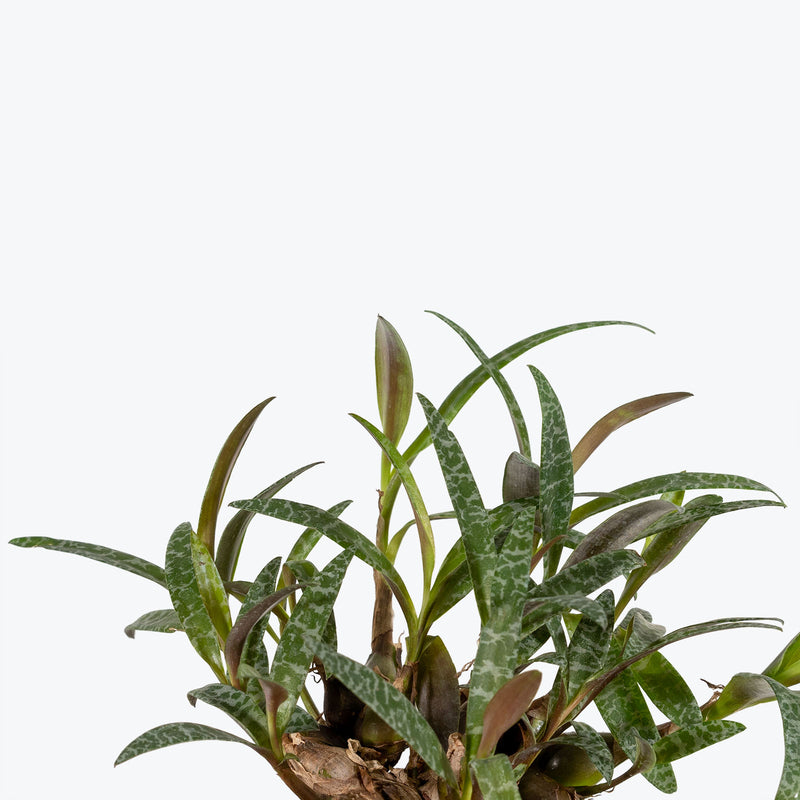
How to care for Scilla Leopard Lily
They enjoy some direct sun, but they'll also do well in bright, indirect light. It is best to place this plant somewhere where it will receive some nice morning sun, or a couple hours of afternoon sun, and then indirect light the rest of the day.
They will do best in bright light. A nice bright place inside your home would be on the window sill or a stool that is right next to a window, either with or without blinds, depending on if the plant can handle sun. Remember that plants will grow based on how much light they receive.
They like the soil to be relatively dry before the next watering. That usually takes about 2 weeks in an average home environment. It will vary depending on the time of year, your environment and lighting conditions, but for them, it's always safer to underwater or water when you see signs of lack of water (i.e. droopy, floppy, or soft leaves). Expect to water more often in brighter light and less often in lower light.
They can live in any average home humidity condition and are fairly hardy.
If you wish for the foliage of your plant to remain compact and produce lots of bulbs, keep your plant in very bright light. Over time, it may produce tiny flowers on long stems in the summer months. You can even separate the bulbs to propagate and share with your friends!
This plant is moderately toxic and can cause some adverse reactions when ingested so it is best to not let your pets eat it, which we advise for all plants in general. The severity of the reaction will depend on how much of the plant is ingested but, if you know your pet typically does not eat your plants, this plant will be suitable for your home..
View PlantScindapsus Black Splash
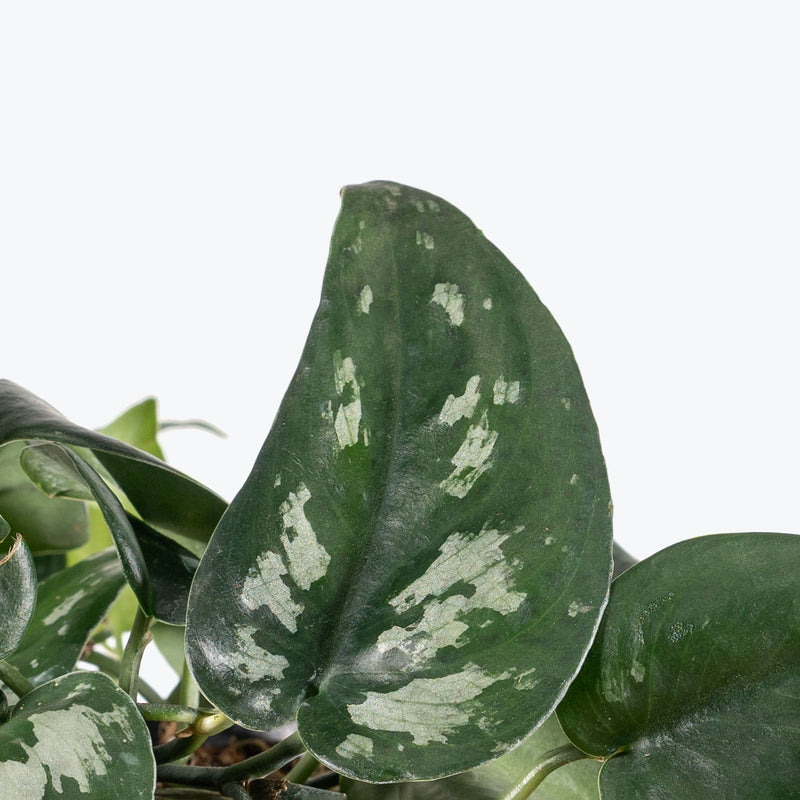
How to care for Scindapsus Black Splash
Scindapsus Black Splash should not be in a position to see the sun directly, although early morning or late evening sun is fine. Filtered sunlight through a sheer curtain is best and most homes are comprised primarily of indirect sunlight. The best spot for them is where they do not see the sun during the majority of the day but still get bright, indirect light.
Scindapsus Black Splash will thrive in medium to bright light, but also can tolerate low light. A good medium-light place in your home would be in the middle of a room that has a regular size window. They can be placed almost anywhere in the room but remember, plants will grow based on how much light they receive.
Scindapsus Black Splash likes the soil to be relatively dry before the next watering. That usually takes about 2 weeks in an average home environment. It will vary depending on the time of year, your environment and lighting conditions, but for them, it's always safer to underwater or water when you see signs of lack of water (i.e. droopy, floppy, or soft leaves). Expect to water more often in brighter light and less often in lower light.
Scindapsus Black Splash can live in any average home humidity condition and are fairly hardy.
Use a chunky, well-draining soil mix and a pot with drainage holes. Wipe leaves occasionally to keep their dark shimmer vibrant. Rotate Scindapsus Black Splash monthly to maintain even growth. It can trail or climb — add a moss pole or let it cascade freely.
Scindapsus Black Splash is moderately toxic and can cause some adverse reactions when ingested so it is best to not let your pets eat it, which we advise for all plants in general. The severity of the reaction will depend on how much of the plant is ingested but, if you know your pet typically does not eat your plants, this plant will be suitable for your home..
Learn MoreView PlantScindapsus Jade Satin
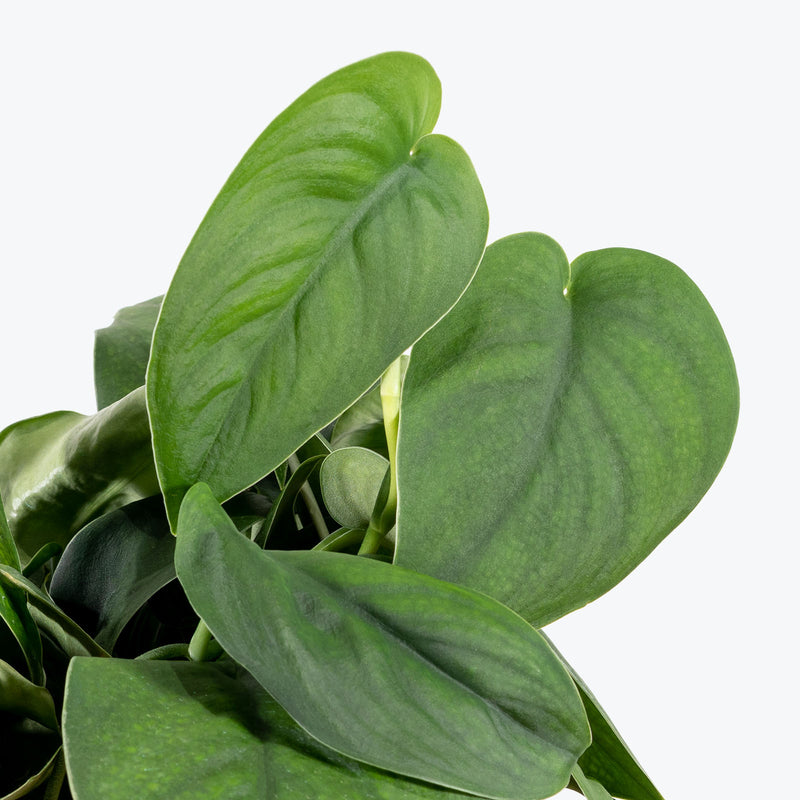
How to care for Scindapsus Jade Satin
Scindapsus Jade Satin should not be in a position to see the sun directly, as it is too intense for them. Filtered sunlight through a sheer curtain is fine and most homes are comprised primarily of indirect sunlight. The best spot for them is where they do not see the sun during the majority of the day but still get bright, indirect light.
Scindapsus Jade Satin will thrive in medium to bright light, but also can tolerate low light. A good medium-light place in your home would be in the middle of a room that has a regular size window. They can be placed almost anywhere in the room but remember, plants will grow based on how much light they receive.
Scindapsus Jade Satin likes the soil to be relatively dry before the next watering. That usually takes about two weeks in an average home environment. It will vary depending on the time of year, your environment and lighting conditions, but for them, it's always safer to underwater or water when you see signs of lack of water (i.e. droopy, floppy, or soft leaves). Water more often in the warmer months.
Scindapsus Jade Satin can live in any average home humidity condition and is fairly hardy.
Scindapsus Jade Satin is super easy to take care of and known for their air purifying capabilities. Just make sure you do not overwater them.
Scindapsus Jade Satin is moderately toxic and can cause some adverse reactions when ingested so it is best to not let your pets eat it, which we advise for all plants in general. The severity of the reaction will depend on how much of the plant is ingested but, if you know your pet typically does not eat your plants, this plant will be suitable for your home..
Learn MoreView PlantScindapsus Pictus Argyraeus
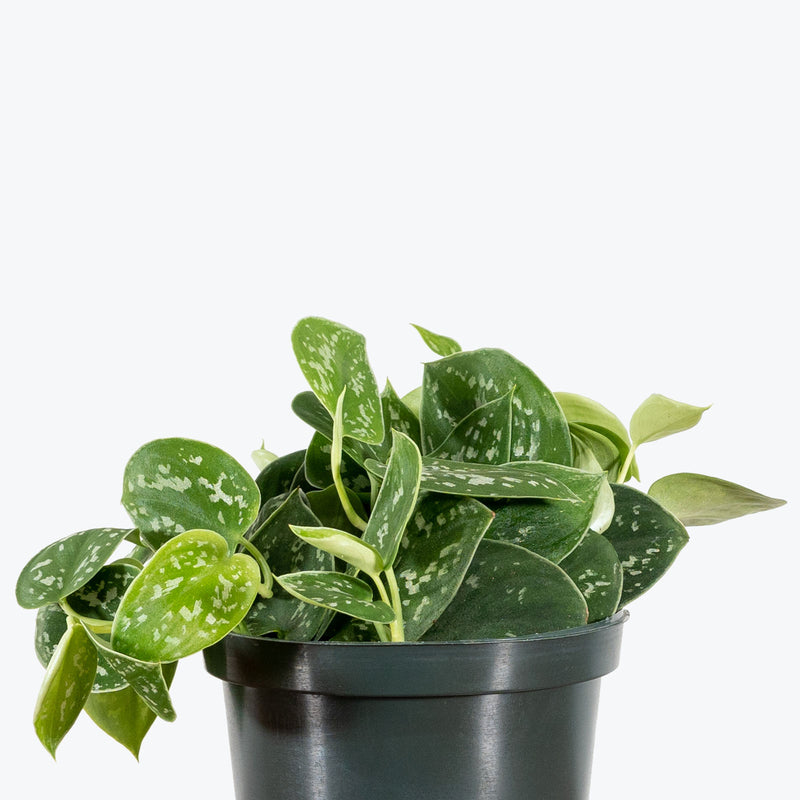
How to care for Scindapsus Pictus Argyraeus
Scindapsus Pictus Argyraeus should not be in a position to see the sun directly, although early morning or late evening sun is fine. Filtered sunlight through a sheer curtain is best and most homes are comprised primarily of indirect sunlight. The best spot for them is where they do not see the sun during the majority of the day but still get bright, indirect light.
Scindapsus Pictus Argyraeus will thrive in medium to bright light, but also can tolerate low light. A good medium-light place in your home would be in the middle of a room that has a regular size window. They can be placed almost anywhere in the room but remember, plants will grow based on how much light they receive.
Scindapsus Pictus Argyraeus likes the soil to be relatively dry before the next watering. That usually takes about 2 weeks in an average home environment. It will vary depending on the time of year, your environment and lighting conditions, but for them, it's always safer to underwater or water when you see signs of lack of water (i.e. droopy, floppy, or soft leaves). Expect to water more often in brighter light and less often in lower light.
Scindapsus Pictus Argyraeus can live in any average home humidity condition and are fairly hardy.
Scindapsus Pictus Argyraeus is super easy to take care of and has an amazing payoff, with its large, silvery leaves. Watch that you don't overwater this plant as it would much rather have dry soil than have it too wet for too long. Mist your plant daily if you want to increase the humidity around it, your plant will always thank you for that.
Scindapsus Pictus Argyraeus is moderately toxic and can cause some adverse reactions when ingested so it is best to not let your pets eat it, which we advise for all plants in general. The severity of the reaction will depend on how much of the plant is ingested but, if you know your pet typically does not eat your plants, this plant will be suitable for your home..
Learn MoreView PlantScindapsus Pictus Exotica
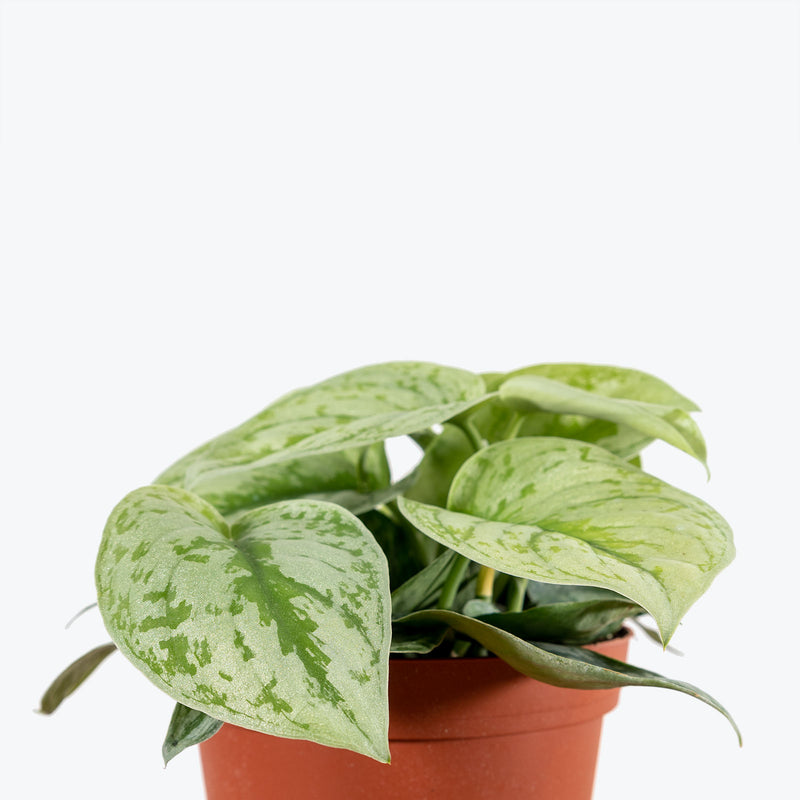
How to care for Scindapsus Pictus Exotica
Scindapsus Pictus Exotica should not be in a position to see the sun directly, as it is too intense for them. Filtered sunlight through a sheer curtain is fine and most homes are comprised primarily of indirect sunlight. The best spot for them is where they do not see the sun during the majority of the day but still get bright, indirect light.
Scindapsus Pictus Exotica will thrive in medium to bright light, but also can tolerate low light. A good medium-light place in your home would be in the middle of a room that has a regular size window. They can be placed almost anywhere in the room but remember, plants will grow based on how much light they receive.
Scindapsus Pictus Exotica likes the soil to be relatively dry before the next watering. That usually takes about two weeks in an average home environment. It will vary depending on the time of year, your environment and lighting conditions, but for them, it's always safer to underwater or water when you see signs of lack of water (i.e. droopy, floppy, or soft leaves). Water more often in the warmer months.
Scindapsus Pictus Exotica can live in any average home humidity condition and are fairly hardy.
Scindapsus Pictus Exotica are super easy to take care of and have an amazing payoff, with their large, silvery leaves. Watch that you don't overwater this plant as it would much rather have dry soil than have it too wet for too long. Mist your plant daily if you want to increase the humidity around it, your plant will always thank you for that.
Scindapsus Pictus Exotica is moderately toxic and can cause some adverse reactions when ingested so it is best to not let your pets eat it, which we advise for all plants in general. The severity of the reaction will depend on how much of the plant is ingested but, if you know your pet typically does not eat your plants, this plant will be suitable for your home..
Learn MoreView PlantScindapsus Platinum Java
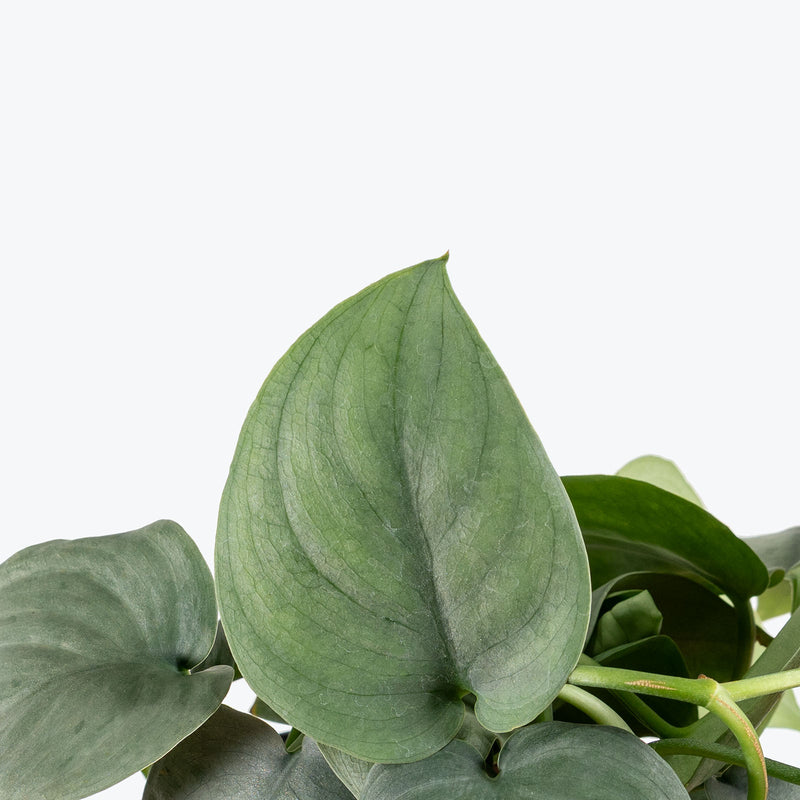
How to care for Scindapsus Platinum Java
Scindapsus Platinum Java should not be in a position to see the sun directly, although early morning or late evening sun is fine. Filtered sunlight through a sheer curtain is best and most homes are comprised primarily of indirect sunlight. The best spot for them is where they do not see the sun during the majority of the day but still get bright, indirect light.
Scindapsus Platinum Java will thrive in medium to bright light, but also can tolerate low light. A good medium-light place in your home would be in the middle of a room that has a regular size window. They can be placed almost anywhere in the room but remember, plants will grow based on how much light they receive.
Scindapsus Platinum Java likes the soil to be relatively dry before the next watering. That usually takes about 2 weeks in an average home environment. It will vary depending on the time of year, your environment and lighting conditions, but for them, it's always safer to underwater or water when you see signs of lack of water (i.e. droopy, floppy, or soft leaves). Expect to water more often in brighter light and less often in lower light.
Scindapsus Platinum Java can live in any average home humidity condition and are fairly hardy.
Provide Scindapsus Platinum Java with bright indirect light to promote large, silvery leaves. Watch that you don't overwater this plant as it would much rather have dry soil than have it too wet for too long. Regularly wipe the leaves with a damp cloth to remove dust and help maintain the vibrant sheen of the foliage.
Scindapsus Platinum Java is moderately toxic and can cause some adverse reactions when ingested so it is best to not let your pets eat it, which we advise for all plants in general. The severity of the reaction will depend on how much of the plant is ingested but, if you know your pet typically does not eat your plants, this plant will be suitable for your home..
Learn MoreView PlantScindapsus Silver Cloud
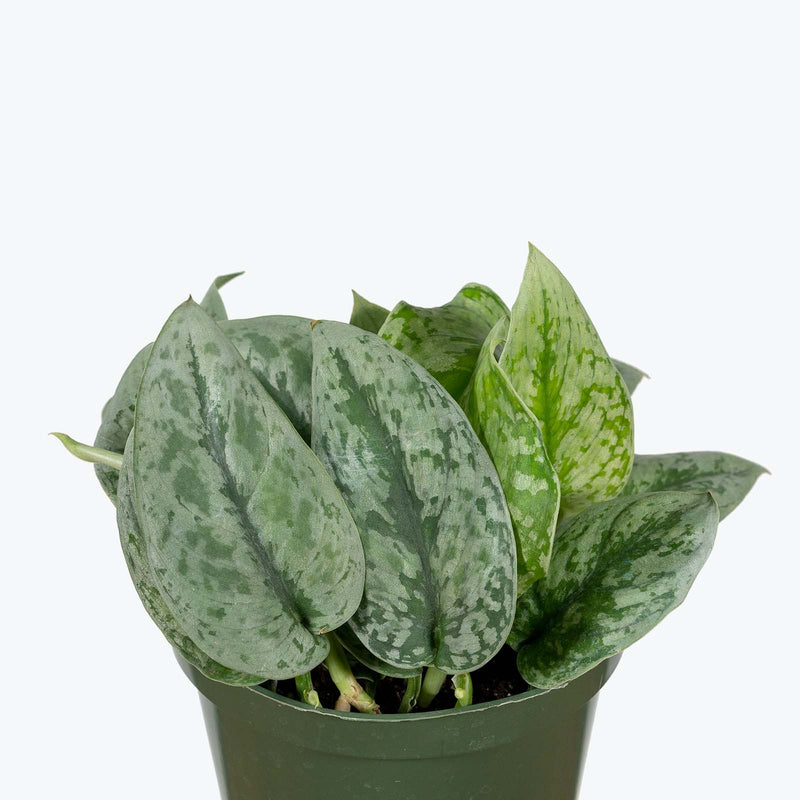
How to care for Scindapsus Silver Cloud
Scindapsus Silver Cloud should not be in a position to see the sun directly, although early morning or late evening sun is fine. Filtered sunlight through a sheer curtain is best and most homes are comprised primarily of indirect sunlight. The best spot for them is where they do not see the sun during the majority of the day but still get bright, indirect light.
Scindapsus Silver Cloud will thrive in medium to bright light, but also can tolerate low light. A good medium-light place in your home would be in the middle of a room that has a regular size window. They can be placed almost anywhere in the room but remember, plants will grow based on how much light they receive.
Scindapsus Silver Cloud likes the soil to be relatively dry before the next watering. That usually takes about 2 weeks in an average home environment. It will vary depending on the time of year, your environment and lighting conditions, but for them, it's always safer to underwater or water when you see signs of lack of water (i.e. droopy, floppy, or soft leaves). Expect to water more often in brighter light and less often in lower light.
Scindapsus Silver Cloud can live in any average home humidity condition and are fairly hardy.
Scindapsus Silver Cloud are super easy to take care of and have an amazing payoff, with their large, silvery leaves. Watch that you don't overwater this plant as it would much rather have dry soil than have it too wet for too long. Mist your plant daily if you want to increase the humidity around it, your plant will always thank you for that.
Scindapsus Silver Cloud is moderately toxic and can cause some adverse reactions when ingested so it is best to not let your pets eat it, which we advise for all plants in general. The severity of the reaction will depend on how much of the plant is ingested but, if you know your pet typically does not eat your plants, this plant will be suitable for your home..
Learn MoreView PlantScindapsus Silver Hero
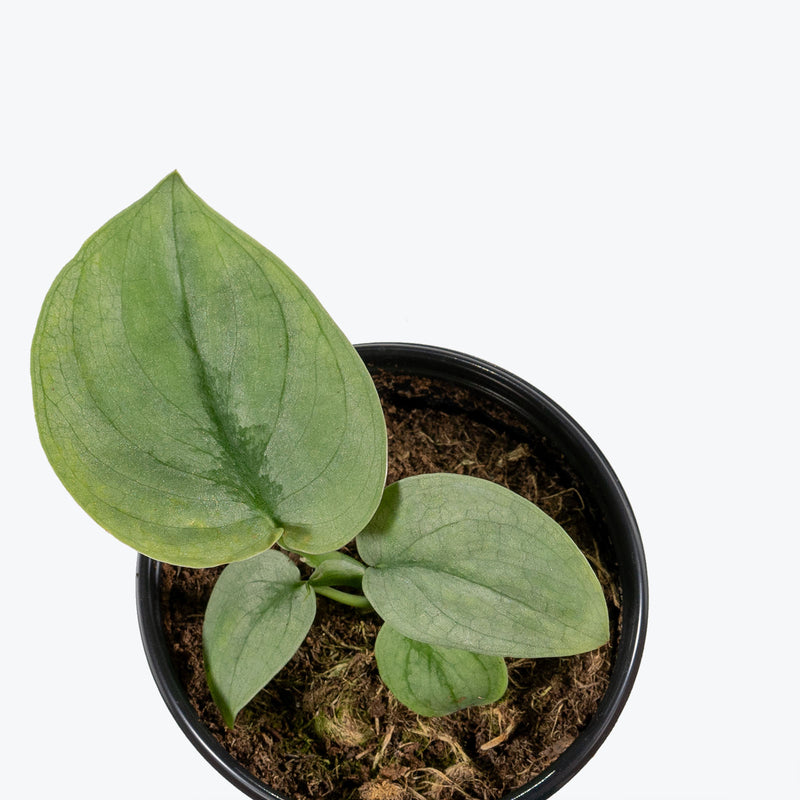
How to care for Scindapsus Silver Hero
Scindapsus Silver Hero should not be in a position to see the sun directly, although early morning or late evening sun is fine. Filtered sunlight through a sheer curtain is best and most homes are comprised primarily of indirect sunlight. The best spot for them is where they do not see the sun during the majority of the day but still get bright, indirect light.
Scindapsus Silver Hero will thrive in medium to bright light, but also can tolerate low light. A good medium-light place in your home would be in the middle of a room that has a regular size window. They can be placed almost anywhere in the room but remember, plants will grow based on how much light they receive.
Scindapsus Silver Hero likes the soil to be relatively dry before the next watering. That usually takes about 2 weeks in an average home environment. It will vary depending on the time of year, your environment and lighting conditions, but for them, it's always safer to underwater or water when you see signs of lack of water (i.e. droopy, floppy, or soft leaves). Expect to water more often in brighter light and less often in lower light.
Scindapsus Silver Hero can live in any average home humidity condition and are fairly hardy.
Regularly clean Scindapsus Silver Hero's leaves to maintain their shine and health. Prune the vines to encourage fuller growth or to maintain the desired shape. Fertilize with a balanced, water-soluble fertilizer during the growing season, but do so sparingly.
Scindapsus Silver Hero is moderately toxic and can cause some adverse reactions when ingested so it is best to not let your pets eat it, which we advise for all plants in general. The severity of the reaction will depend on how much of the plant is ingested but, if you know your pet typically does not eat your plants, this plant will be suitable for your home..
Learn MoreView PlantScindapsus Silver Splash
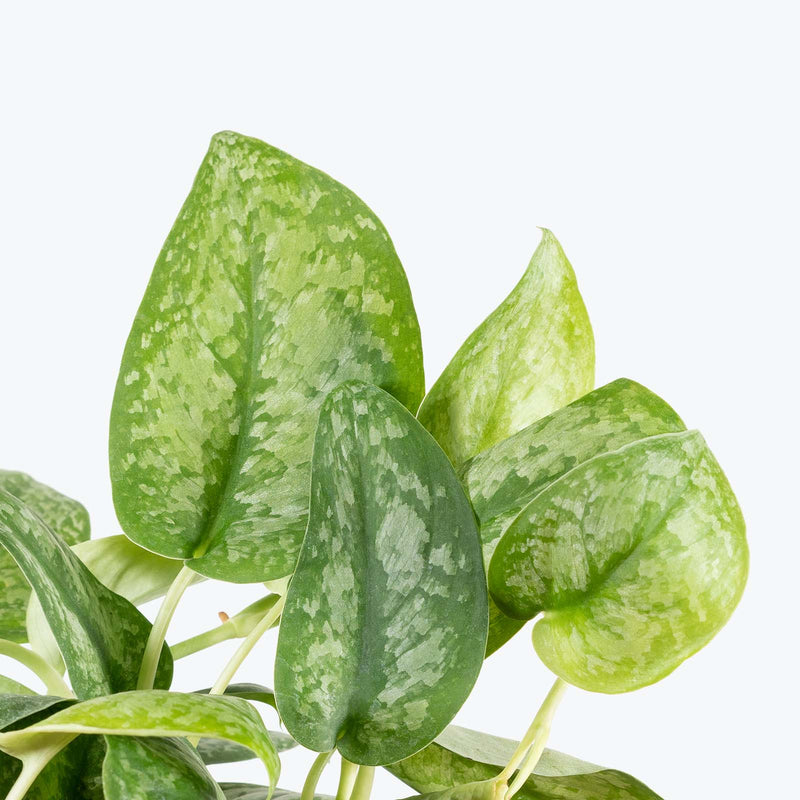
How to care for Scindapsus Silver Splash
Scindapsus Silver Splash should not be in a position to see the sun directly, although early morning or late evening sun is fine. Filtered sunlight through a sheer curtain is best and most homes are comprised primarily of indirect sunlight. The best spot for them is where they do not see the sun during the majority of the day but still get bright, indirect light.
Scindapsus Silver Splash will thrive in medium to bright light, but also can tolerate low light. A good medium-light place in your home would be in the middle of a room that has a regular size window. They can be placed almost anywhere in the room but remember, plants will grow based on how much light they receive.
Scindapsus Silver Splash likes the soil to be relatively dry before the next watering. That usually takes about 2 weeks in an average home environment. It will vary depending on the time of year, your environment and lighting conditions, but for them, it's always safer to underwater or water when you see signs of lack of water (i.e. droopy, floppy, or soft leaves). Expect to water more often in brighter light and less often in lower light.
Scindapsus Silver Splash can live in any average home humidity condition and are fairly hardy.
To maintain the signature soft silver patterning, place your Scindapsus Silver Splash in bright, indirect light — too little light can dull its signature sheen. This plant prefers to dry out between waterings and thrives in a chunky, well-draining mix. Occasionally rotate the pot to ensure even growth and prevent leggy vines. If vines become sparse, prune to encourage bushiness and use cuttings to propagate. It appreciates stable temperatures and consistent conditions, echoing its tropical highland origins.
Scindapsus Silver Splash is moderately toxic and can cause some adverse reactions when ingested so it is best to not let your pets eat it, which we advise for all plants in general. The severity of the reaction will depend on how much of the plant is ingested but, if you know your pet typically does not eat your plants, this plant will be suitable for your home..
Learn MoreView PlantScindapsus Silvery Ann
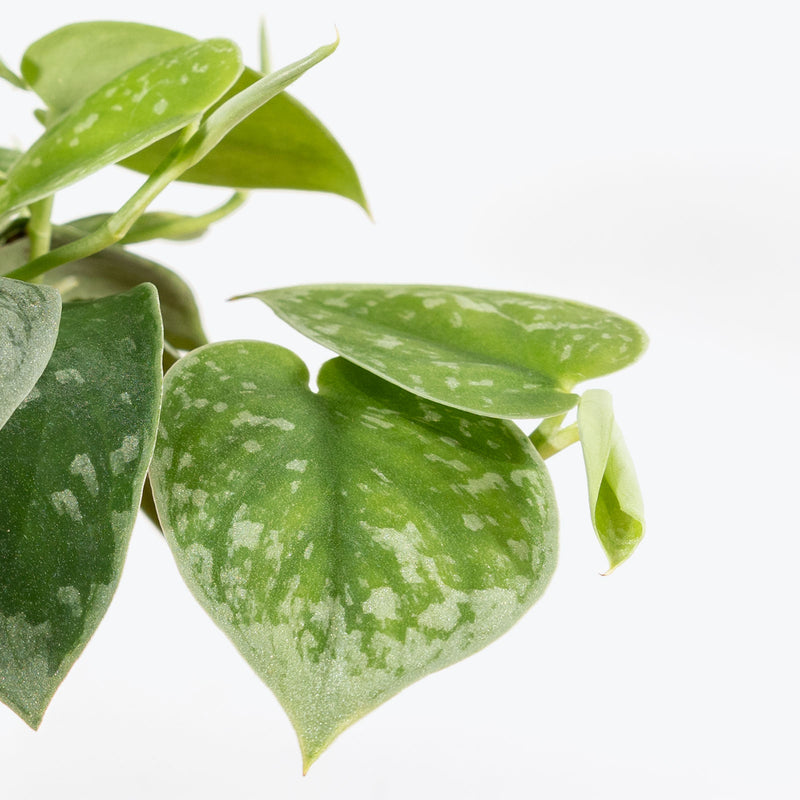
How to care for Scindapsus Silvery Ann
Scindapsus Silvery Ann should not be in a position to see the sun directly, although early morning or late evening sun is fine. Filtered sunlight through a sheer curtain is best and most homes are comprised primarily of indirect sunlight. The best spot for them is where they do not see the sun during the majority of the day but still get bright, indirect light.
Scindapsus Silvery Ann will thrive in medium to bright light, but also can tolerate low light. A good medium-light place in your home would be in the middle of a room that has a regular size window. They can be placed almost anywhere in the room but remember, plants will grow based on how much light they receive.
Scindapsus Silvery Ann likes the soil to be relatively dry before the next watering. That usually takes about 2 weeks in an average home environment. It will vary depending on the time of year, your environment and lighting conditions, but for them, it's always safer to underwater or water when you see signs of lack of water (i.e. droopy, floppy, or soft leaves). Expect to water more often in brighter light and less often in lower light.
Scindapsus Silvery Ann can live in any average home humidity condition and are fairly hardy.
Scindapsus Silvery Ann are super easy to take care of and have an amazing payoff, with their large, silvery leaves. Watch that you don't overwater this plant as it would much rather have dry soil than have it too wet for too long. Mist your plant daily if you want to increase the humidity around it, your plant will always thank you for that.
Scindapsus Silvery Ann is moderately toxic and can cause some adverse reactions when ingested so it is best to not let your pets eat it, which we advise for all plants in general. The severity of the reaction will depend on how much of the plant is ingested but, if you know your pet typically does not eat your plants, this plant will be suitable for your home..
Learn MoreView PlantScindapsus Treubii Dark Form
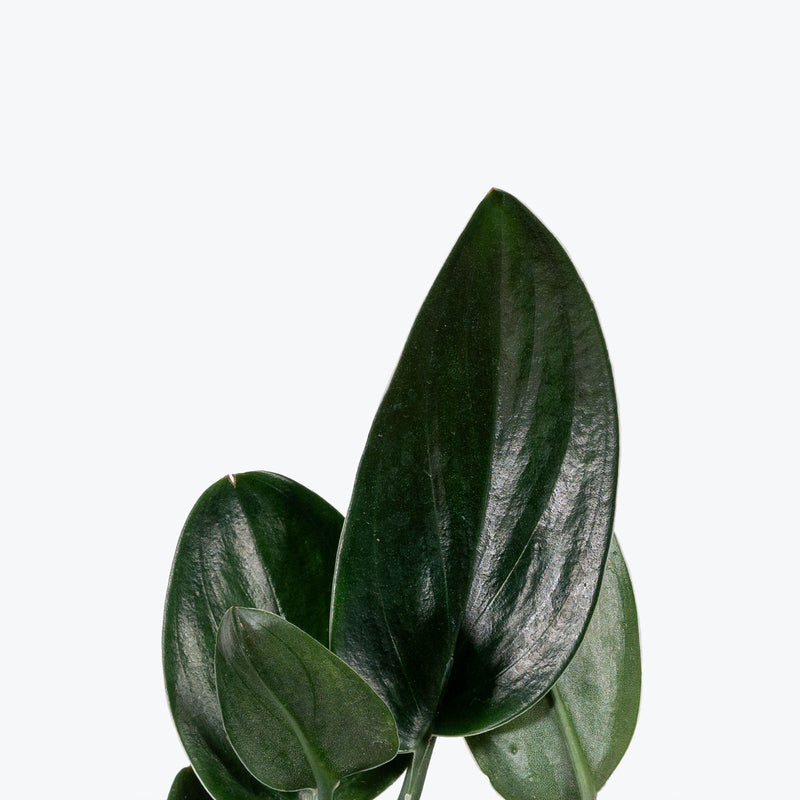
How to care for Scindapsus Treubii Dark Form
Scindapsus Treubii Dark Form should not be in a position to see the sun directly, although early morning or late evening sun is fine. Filtered sunlight through a sheer curtain is best and most homes are comprised primarily of indirect sunlight. The best spot for them is where they do not see the sun during the majority of the day but still get bright, indirect light.
Scindapsus Treubii Dark Form will thrive in bright light, but also can tolerate medium light. A good medium-light place in your home would be in the middle of a room that has a regular size window. They can be placed anywhere between the middle of the room and the window. Remember that plants will grow based on how much light they receive.
Scindapsus Treubii Dark Form needs to be watered when the top half of the soil is dry to the touch. That usually takes about 1 week in an average home environment. It will vary depending on the time of year, your environment and lighting conditions, but it's always safer to underwater or give the soil a check before you water again. Expect to water more often in brighter light and less often in lower light.
Scindapsus Treubii Dark Form will do well in average humidity environments but will appreciate a little bit of humidity if provided, give them a mist daily or get a humidifier.
Scindapsus Treubii Dark Form benefits from regular feeding with a diluted, balanced fertilizer during the growing season (spring through summer). Clean the leaves with a soft, damp cloth to remove dust and help the plant photosynthesize efficiently. Repot every 2-3 years or when it becomes root-bound.
Scindapsus Treubii Dark Form is moderately toxic and can cause some adverse reactions when ingested so it is best to not let your pets eat it, which we advise for all plants in general. The severity of the reaction will depend on how much of the plant is ingested but, if you know your pet typically does not eat your plants, this plant will be suitable for your home..
Learn MoreView PlantScindapsus Treubii Moonlight
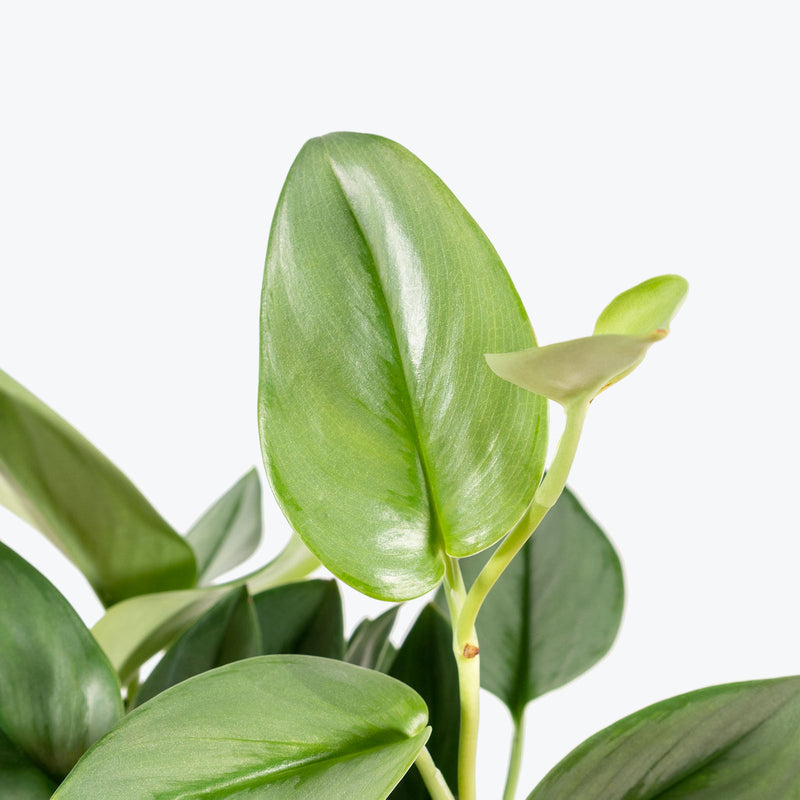
How to care for Scindapsus Treubii Moonlight
Scindapsus Treubii Moonlight should not be in a position to see the sun directly, although early morning or late evening sun is fine. Filtered sunlight through a sheer curtain is best and most homes are comprised primarily of indirect sunlight. The best spot for them is where they do not see the sun during the majority of the day but still get bright, indirect light.
Scindapsus Treubii Moonlight will thrive in bright light, but also can tolerate medium light. A good medium-light place in your home would be in the middle of a room that has a regular size window. They can be placed anywhere between the middle of the room and the window. Remember that plants will grow based on how much light they receive.
Scindapsus Treubii Moonlight needs to be watered when the top half of the soil is dry to the touch. That usually takes about 1 week in an average home environment. It will vary depending on the time of year, your environment and lighting conditions, but it's always safer to underwater or give the soil a check before you water again. Expect to water more often in brighter light and less often in lower light.
Scindapsus Treubii Moonlight will do well in average humidity environments but will appreciate a little bit of humidity if provided, give them a mist daily or get a humidifier.
Scindapsus Treubii Moonlight are super easy to take care of, just be mindful that they grow quite slowly and make sure you do not overwater them.
Scindapsus Treubii Moonlight is moderately toxic and can cause some adverse reactions when ingested so it is best to not let your pets eat it, which we advise for all plants in general. The severity of the reaction will depend on how much of the plant is ingested but, if you know your pet typically does not eat your plants, this plant will be suitable for your home..
Learn MoreView PlantScindapsus Tricolor Borneo
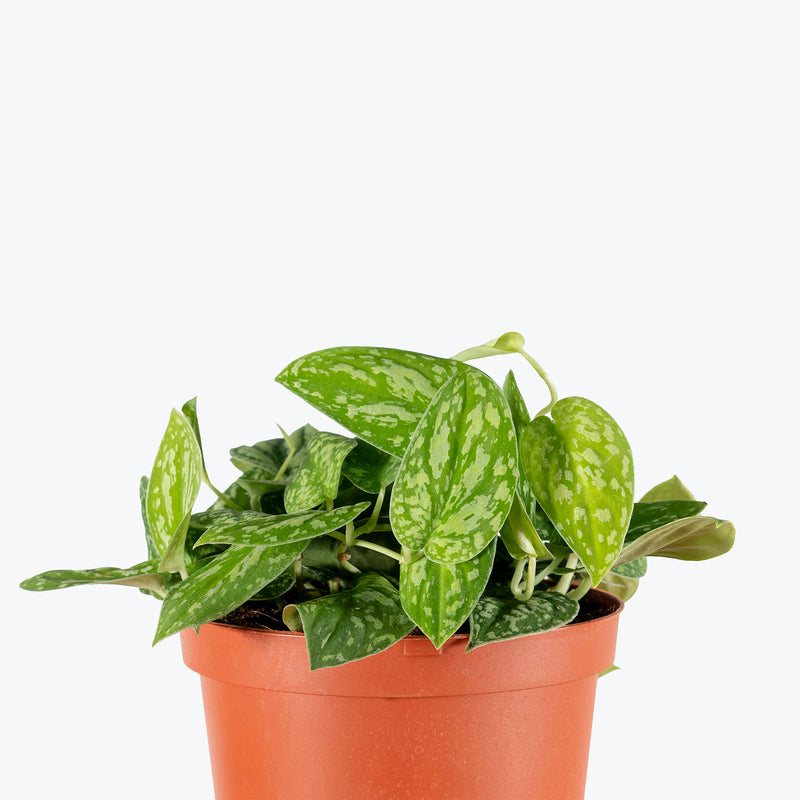
How to care for Scindapsus Tricolor Borneo
Scindapsus Tricolor Borneo should not be in a position to see the sun directly, although early morning or late evening sun is fine. Filtered sunlight through a sheer curtain is best and most homes are comprised primarily of indirect sunlight. The best spot for them is where they do not see the sun during the majority of the day but still get bright, indirect light.
Scindapsus Tricolor Borneo will thrive in medium to bright light, but also can tolerate low light. A good medium-light place in your home would be in the middle of a room that has a regular size window. They can be placed almost anywhere in the room but remember, plants will grow based on how much light they receive.
Scindapsus Tricolor Borneo likes the soil to be relatively dry before the next watering. That usually takes about 2 weeks in an average home environment. It will vary depending on the time of year, your environment and lighting conditions, but for them, it's always safer to underwater or water when you see signs of lack of water (i.e. droopy, floppy, or soft leaves). Expect to water more often in brighter light and less often in lower light.
Scindapsus Tricolor Borneo will do well in average humidity environments but will appreciate a little bit of humidity if provided, give them a mist daily or get a humidifier.
Provide Scindapsus Tricolor Borneo with a well-draining aroid mix rich in perlite and bark to prevent compaction. Allow the plant to climb on a moss pole or trellis for larger, more defined leaves. Fertilize monthly during spring and summer with a balanced, diluted fertilizer to support strong variegation.
Scindapsus Tricolor Borneo is moderately toxic and can cause some adverse reactions when ingested so it is best to not let your pets eat it, which we advise for all plants in general. The severity of the reaction will depend on how much of the plant is ingested but, if you know your pet typically does not eat your plants, this plant will be suitable for your home..
Learn MoreView PlantSedum Burrito
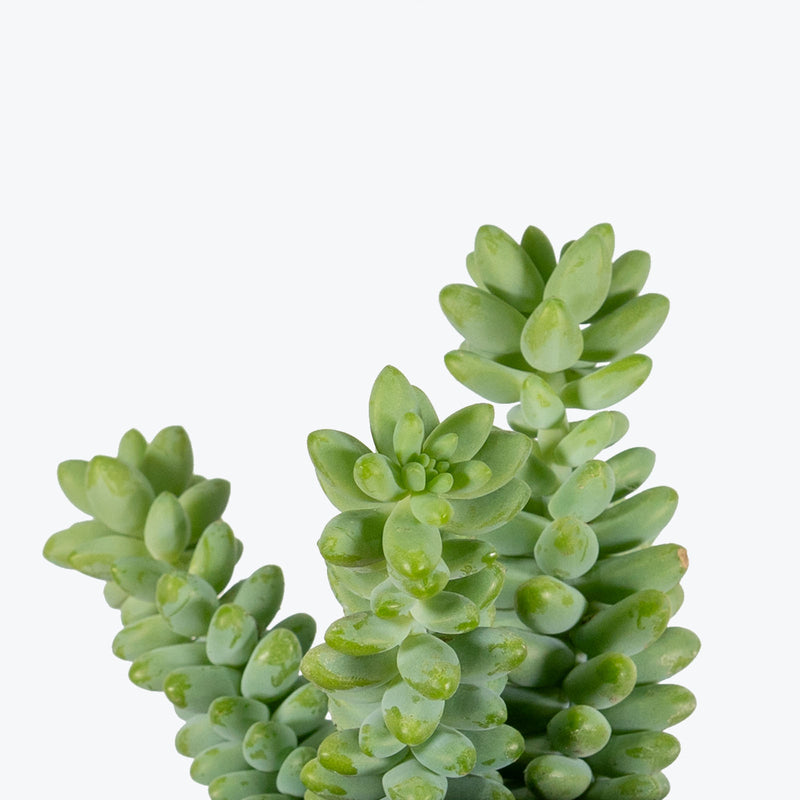
How to care for Sedum Burrito
Sedum Burrito loves as much sun as possible. The best spot for them is where they can see the sun during the majority of the day.
Sedum Burrito will do best in bright light. A nice bright place inside your home would be on the window sill or a stool that is right next to a window, either with or without blinds, depending on if the plant can handle sun. Remember that plants will grow based on how much light they receive.
Sedum Burrito likes the soil to be completely dry before the next watering. That usually takes about 4 weeks in an average home environment. It will vary depending on the time of year, your environment and lighting conditions, but for them, it's always safer to underwater or water when you see signs of lack of water (i.e. wrinkly or soft leaves). Water a little more often in the warmer months.
Their humidity requirement is low, so do not mist Sedum Burrito or put them in a terrarium.
Avoid touching Sedum Burrito too much as that will wipe off the farina, or wax coating, on them, which helps with water-repelling. Their leaves are also very sensitive and can dislodge with the simplest bump.
You can feel comfortable having Sedum Burrito around your home in the potential case where your pet feels like nibbling on it. However, we typically recommend keeping your pets from eating any of your houseplants..
Learn MoreView PlantSedum Lemon Coral

How to care for Sedum Lemon Coral
They enjoy some direct sun, but they'll also do well in bright, indirect light. It is best to place this plant somewhere where it will receive some nice morning sun, or a couple hours of afternoon sun, and then indirect light the rest of the day.
They will do best in bright light. A nice bright place inside your home would be on the window sill or a stool that is right next to a window, either with or without blinds, depending on if the plant can handle sun. Remember that plants will grow based on how much light they receive.
They like the soil to be relatively dry before the next watering. That usually takes about 2 weeks in an average home environment. It will vary depending on the time of year, your environment and lighting conditions, but for them, it's always safer to underwater or water when you see signs of lack of water (i.e. droopy, floppy, or soft leaves). Expect to water more often in brighter light and less often in lower light.
Their humidity requirement is low, so do not mist them or put them in a terrarium.
Although you should be careful not to overwater your plant, neglecting the watering routine can be harmful to them. To check if your plant needs water, put your finger in the soil up to your knuckle - if the soil sticks to your fingers, the soil is still moist, if the soil doesn’t stick to your finger, you should water your plant. When in doubt, don’t water your plant as they are susceptible to being overwatered.
You can feel comfortable having this plant around your home in the potential case where your pet feels like nibbling on it. However, we typically recommend keeping your pets from eating any of your houseplants..
Learn MoreView PlantSedum Lineare Variegatum
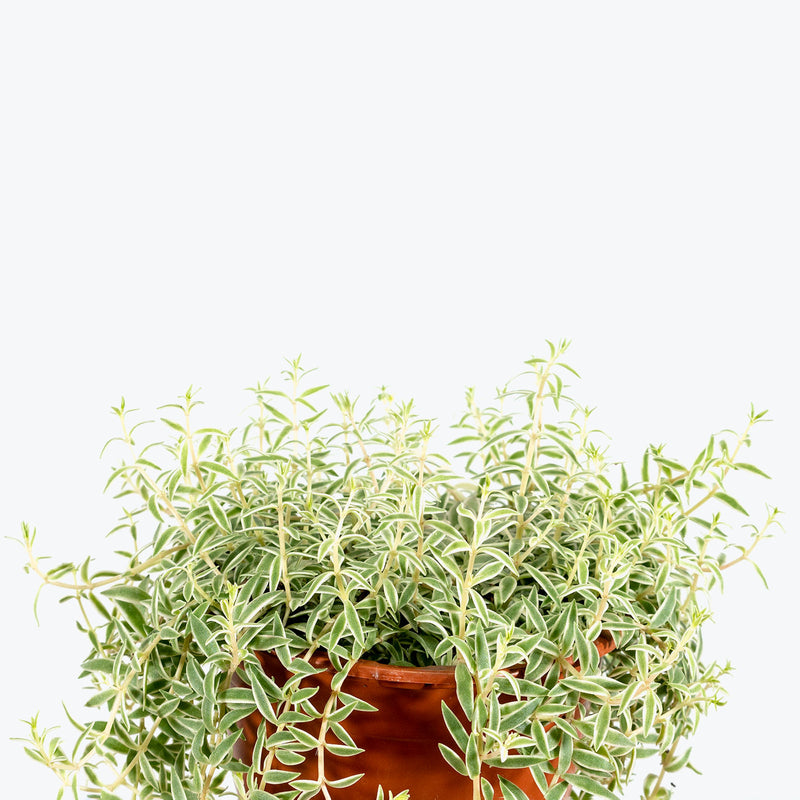
How to care for Sedum Lineare Variegatum
They love as much sun as possible. The best spot for them is where they can see the sun during the majority of the day.
They will do best in bright light. A nice bright place inside your home would be on the window sill or a stool that is right next to a window, either with or without blinds, depending on if the plant can handle sun. Remember that plants will grow based on how much light they receive.
They like the soil to be completely dry before the next watering. This can take up to 4 weeks in an average home environment but it will vary depending on the time of year, your environment and lighting conditions. For them, it's always safer to underwater or water when you see signs of lack of water (i.e. wrinkly or soft leaves). Water a little more often in the warmer months.
Their humidity requirement is low, so do not mist them or put them in a terrarium.
They need very little attention and care, as long as they are receiving bright light. To propagate, they will send out roots anywhere the stem is touching, hence the name "Carpet Sedum", so lay the stem on some soil and keep your plant in bright light in order to encourage rooting.
This plant is moderately toxic and can cause some adverse reactions when ingested so it is best to not let your pets eat it, which we advise for all plants in general. The severity of the reaction will depend on how much of the plant is ingested but, if you know your pet typically does not eat your plants, this plant will be suitable for your home..
Learn MoreView PlantSedum Morganianum
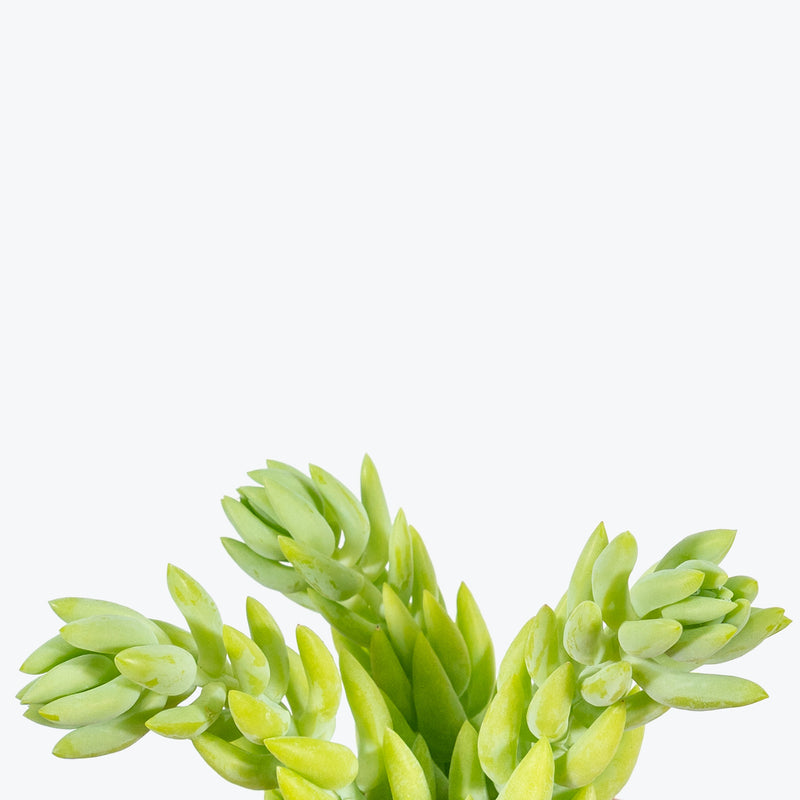
How to care for Sedum Morganianum
They love as much sun as possible. The best spot for them is where they can see the sun during the majority of the day.
They will do best in bright light. A nice bright place inside your home would be on the window sill or a stool that is right next to a window, either with or without blinds, depending on if the plant can handle sun. Remember that plants will grow based on how much light they receive.
They like the soil to be completely dry before the next watering. That usually takes about 4 weeks in an average home environment. It will vary depending on the time of year, your environment and lighting conditions, but for them, it's always safer to underwater or water when you see signs of lack of water (i.e. wrinkly or soft leaves). Water a little more often in the warmer months.
Their humidity requirement is low, so do not mist them or put them in a terrarium.
Avoid touching the leaves too much as that will wipe off the farina, or wax coating, on them, which helps with water-repelling. Their leaves are also very sensitive and can dislodge with the simplest bump.
This plant is moderately toxic and can cause some adverse reactions when ingested so it is best to not let your pets eat it, which we advise for all plants in general. The severity of the reaction will depend on how much of the plant is ingested but, if you know your pet typically does not eat your plants, this plant will be suitable for your home..
Learn MoreView PlantSelenicereus Chrysocardium Fern Leaf Cactus
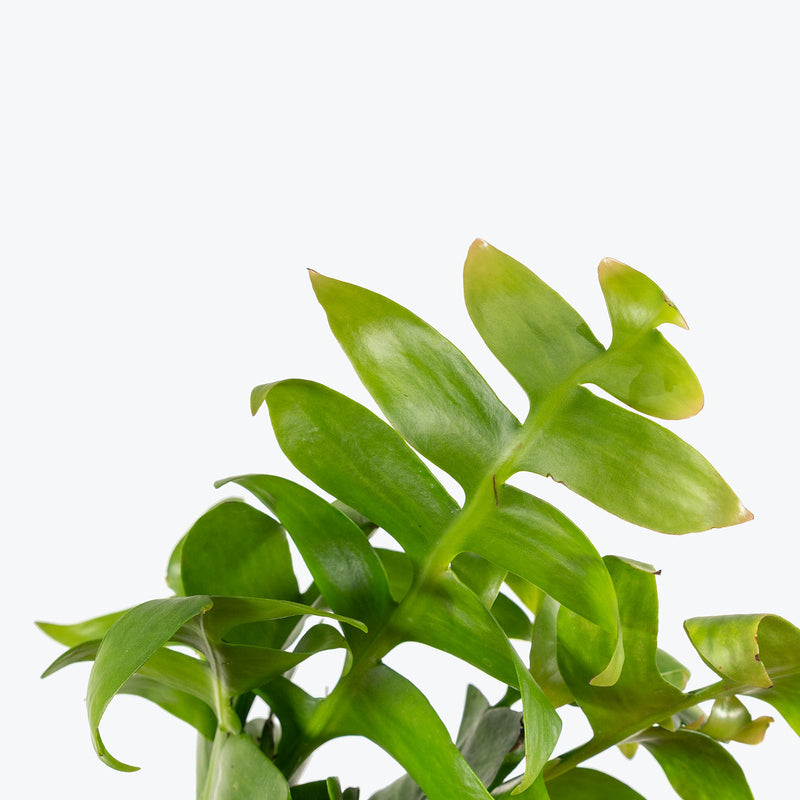
How to care for Selenicereus Chrysocardium Fern Leaf Cactus
Selenicereus Chrysocardium Fern Leaf Cactus prefers indirect sunlight, as direct sunlight can cause sunburn or scorching on its leaves. Early morning or late evening sun is acceptable, but filtered sunlight through a sheer curtain is ideal.
Selenicereus Chrysocardium Fern Leaf Cactus will thrive in bright light, but also can tolerate medium light. A good medium-light place in your home would be in the middle of a room that has a regular size window. They can be placed anywhere between the middle of the room and the window. Remember that plants will grow based on how much light they receive.
Water Selenicereus Chrysocardium Fern Leaf Cactus when the top half of the soil is dry to the touch. In an average home environment, this typically takes about 1 week. It's always safer to underwater or check the soil before watering again. Expect to water more often in brighter light and less often in lower light.
Selenicereus Chrysocardium Fern Leaf Cactus will do well in average humidity environments but will appreciate a little extra humidity if provided. Consider misting the plant daily or using a humidifier to create a more comfortable environment.
Provide Selenicereus Chrysocardium Fern Leaf Cactus with a well-draining soil mix and repot only when necessary. Keep an eye out for any signs of pests. Due to its epiphytic nature, this plant will appreciate being mounted on a piece of wood, bark, or grown in a hanging basket, allowing it to mimic its natural growing conditions.
Selenicereus Chrysocardium Fern Leaf Cactus is moderately toxic and can cause some adverse reactions when ingested so it is best to not let your pets eat it, which we advise for all plants in general. The severity of the reaction will depend on how much of the plant is ingested but, if you know your pet typically does not eat your plants, this plant will be suitable for your home..
Learn MoreView PlantSenecio Crassissimus
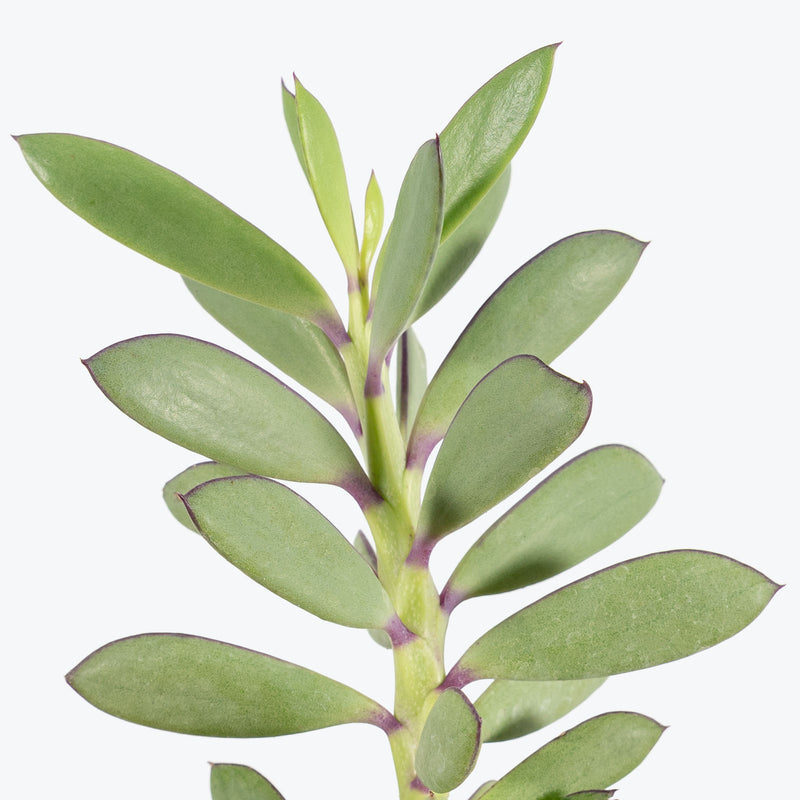
How to care for Senecio Crassissimus
They love as much sun as possible. The best spot for them is where they can see the sun during the majority of the day.
They will do best in bright light. A nice bright place inside your home would be on the window sill or a stool that is right next to a window, either with or without blinds, depending on if the plant can handle sun. Remember that plants will grow based on how much light they receive.
They like the soil to be completely dry before the next watering. That usually takes about 4 weeks in an average home environment. It will vary depending on the time of year, your environment and lighting conditions, but for them, it's always safer to underwater or water when you see signs of lack of water (i.e. wrinkly or soft leaves).
Their humidity requirement is low, so do not mist them or put them in a terrarium.
If your Senecio starts to get "leggy" as it grows, where the new growth is stretched out or floppy, and the leaves are not very dense, consider pruning it back to encourage more growth points, and place it in brighter spot than it was before!
This plant is moderately toxic and can cause some adverse reactions when ingested so it is best to not let your pets eat it, which we advise for all plants in general. The severity of the reaction will depend on how much of the plant is ingested but, if you know your pet typically does not eat your plants, this plant will be suitable for your home..
View PlantSenecio Haworthii
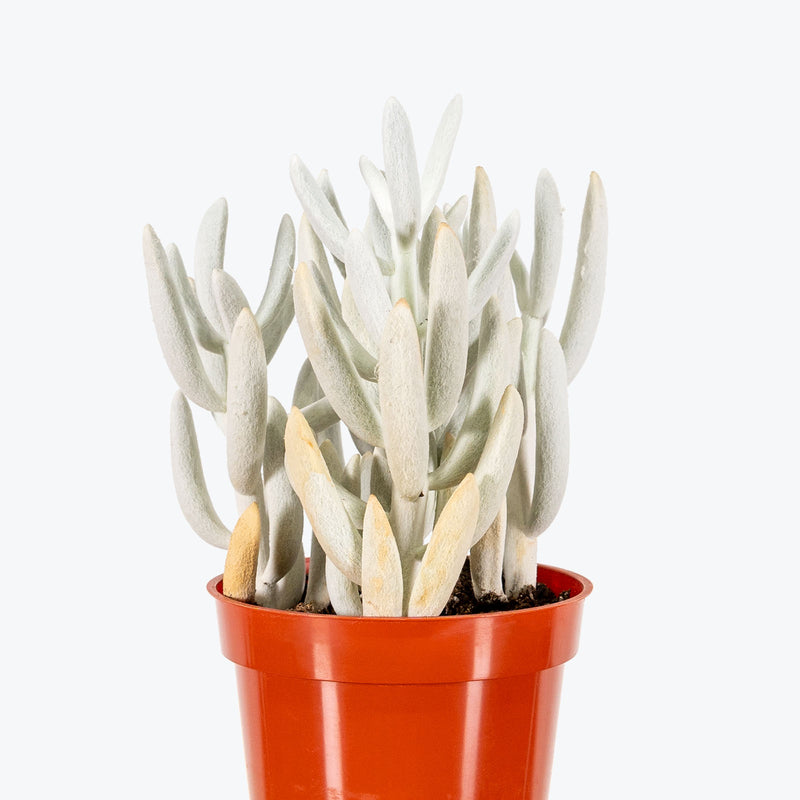
How to care for Senecio Haworthii
They enjoy some direct sun, but they'll also do well in bright, indirect light. It is best to place this plant somewhere where it will receive some nice morning sun, or a couple hours of afternoon sun, and then indirect light the rest of the day.
They will do best in bright light. A nice bright place inside your home would be on the window sill or a stool that is right next to a window, either with or without blinds, depending on if the plant can handle sun. Remember that plants will grow based on how much light they receive.
They like the soil to be completely dry before the next watering. This can take up to 4 weeks in an average home environment but it will vary depending on the time of year, your environment and lighting conditions. For them, it's always safer to underwater or water when you see signs of lack of water (i.e. wrinkly or soft leaves). Water a little more often in the warmer months.
Their humidity requirement is low, so do not mist them or put them in a terrarium.
They do dormant in the summer, reduce watering in the summer and resume watering in early fall when the temperature cools down. They can be propagated via leaf or stem cuttings.
This plant is moderately toxic and can cause some adverse reactions when ingested so it is best to not let your pets eat it, which we advise for all plants in general. The severity of the reaction will depend on how much of the plant is ingested but, if you know your pet typically does not eat your plants, this plant will be suitable for your home..
View PlantSenecio Mikanoides
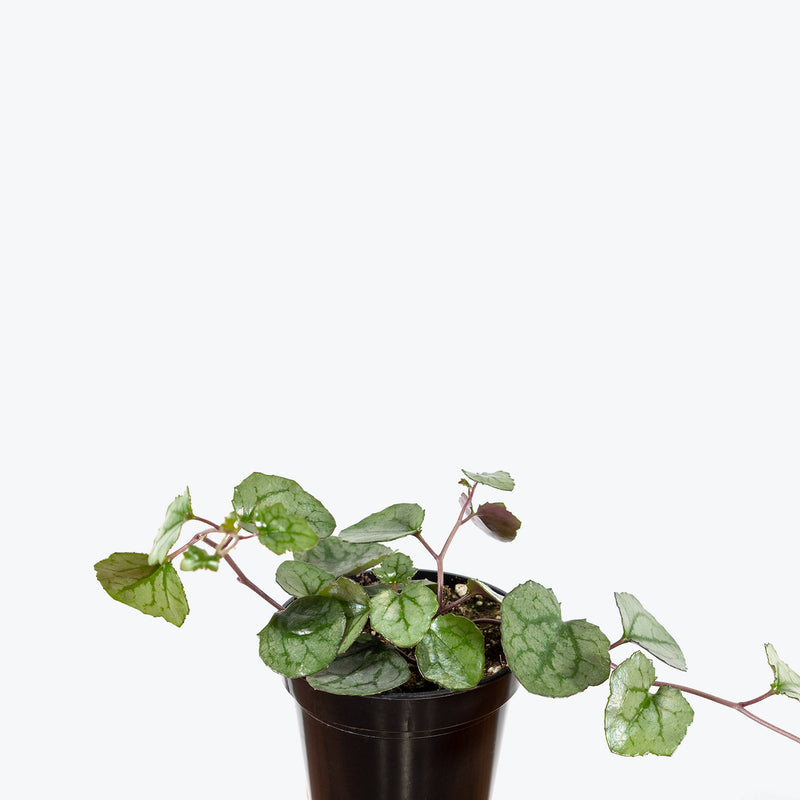
How to care for Senecio Mikanoides
They enjoy some direct sun, but they'll also do well in bright, indirect light. It is best to place this plant somewhere where it will receive some nice morning sun, or a couple hours of afternoon sun, and then indirect light the rest of the day.
They will thrive in bright light, but also can tolerate medium light. A good medium-light place in your home would be in the middle of a room that has a regular size window. They can be placed anywhere between the middle of the room and the window. Remember that plants will grow based on how much light they receive.
They like the soil to be completely dry before the next watering. That usually takes about 4 weeks in an average home environment. It will vary depending on the time of year, your environment and lighting conditions, but for them, it's always safer to underwater or water when you see signs of lack of water (i.e. wrinkly or soft leaves). Water a little more often in the warmer months.
Their humidity requirement is low, so do not mist them or put them in a terrarium.
It can be propagated via clippings, simply allow the cut end to callous over and insert into the dirt. Keep them in warmer temperatures and avoid letting them sit where there are drafts, as this can cause leaf drop.
This plant is moderately toxic and can cause some adverse reactions when ingested so it is best to not let your pets eat it, which we advise for all plants in general. The severity of the reaction will depend on how much of the plant is ingested but, if you know your pet typically does not eat your plants, this plant will be suitable for your home..
View PlantSenecio Serpens Blue Dolphin
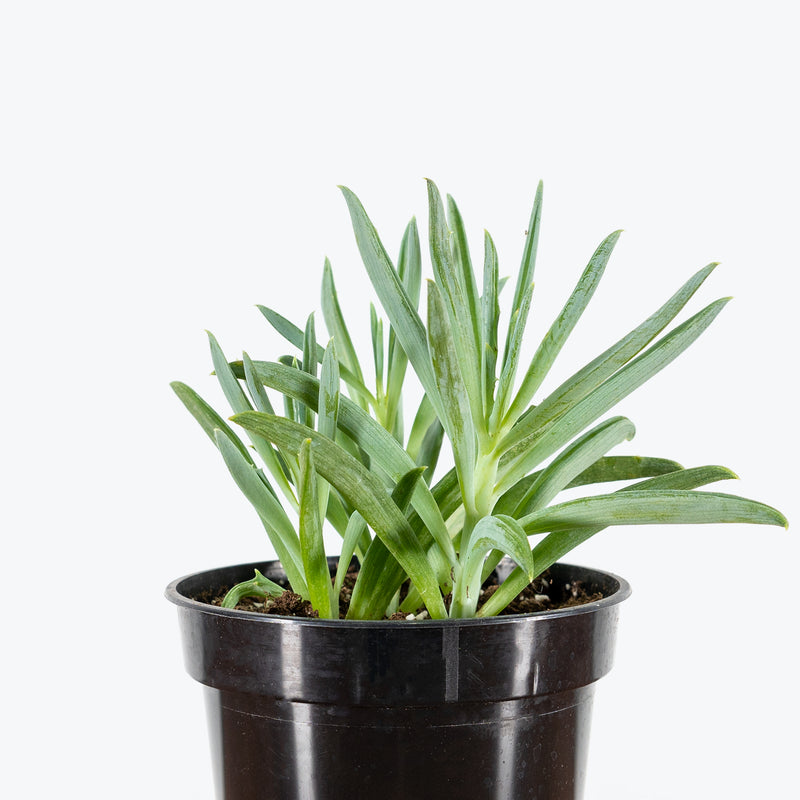
How to care for Senecio Serpens Blue Dolphin
They enjoy some direct sun, but they'll also do well in bright, indirect light. It is best to place this plant somewhere where it will receive some nice morning sun, or a couple hours of afternoon sun, and then indirect light the rest of the day.
They will do best in bright light. A nice bright place inside your home would be on the window sill or a stool that is right next to a window, either with or without blinds, depending on if the plant can handle sun. Remember that plants will grow based on how much light they receive.
They like the soil to be completely dry before the next watering. This can take up to 4 weeks in an average home environment but it will vary depending on the time of year, your environment and lighting conditions. For them, it's always safer to underwater or water when you see signs of lack of water (i.e. wrinkly or soft leaves). Water a little more often in the warmer months.
Their humidity requirement is low, so do not mist them or put them in a terrarium.
It can be propagated via clippings, simply allow the cut end to callous over and insert into the dirt. They also prefer slightly crowded conditions, so make sure not to give them too much space when repotting. Finally, keep them in warmer temperatures and avoid letting them sit where there are drafts, as this can cause leaf drop.
This plant is moderately toxic and can cause some adverse reactions when ingested so it is best to not let your pets eat it, which we advise for all plants in general. The severity of the reaction will depend on how much of the plant is ingested but, if you know your pet typically does not eat your plants, this plant will be suitable for your home..
View PlantSensitive Plant
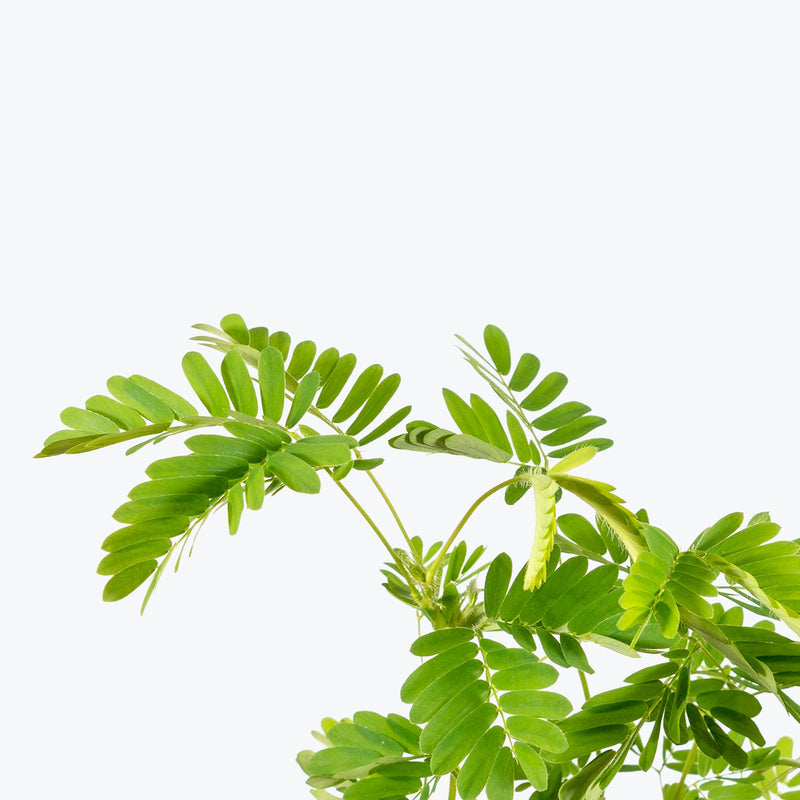
How to care for Sensitive Plant
Sensitive Plant enjoys some direct sun, but they'll also do well in bright, indirect light. It is best to place this plant somewhere where it will receive some nice morning sun, or a couple hours of afternoon sun, and then indirect light the rest of the day.
Sensitive Plant will do best in bright light. A nice bright place inside your home would be on the window sill or a stool that is right next to a window, either with or without blinds, depending on if the plant can handle sun. Remember that plants will grow based on how much light they receive.
Sensitive Plant likes the soil to stay consistently moist, but not soaking wet. Give them water whenever just the surface of the soil is starting to get dry. Expect to water more often in brighter light and less often in lower light.
Sensitive Plant will do well in average humidity environments but will appreciate a little bit of humidity if provided, give them a mist daily or get a humidifier.
In its natural environment, the Sensitive Plant lives in soils that are low in nutrients. Therefore, it does not require overly rich soil or frequent fertilizing. If the leaflets remain closed during the day, it indicates that the plant is not receiving enough light. Since the Sensitive Plant is a creeping plant, trim off trailing stems or train them to climb a trellis to keep the plant looking nice.
You can feel comfortable having Sensitive Plant around your home in the potential case where your pet feels like nibbling on it. However, we typically recommend keeping your pets from eating any of your houseplants..
View PlantSerissa Japonica Bonsai
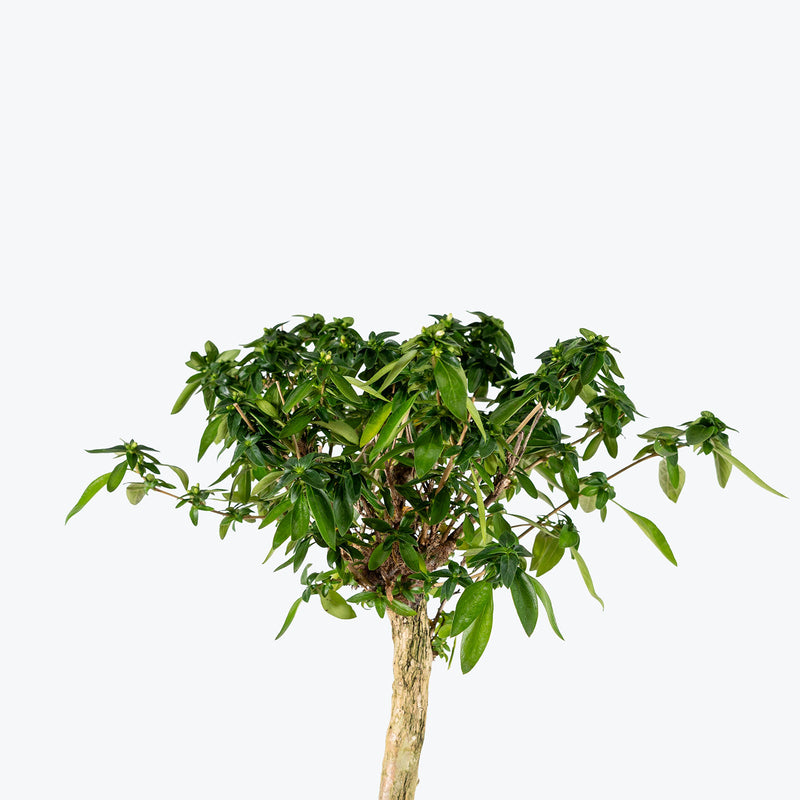
How to care for Serissa Japonica Bonsai
Serissa Japonica should not be in a position to see the sun directly, although early morning or late evening sun is fine. Filtered sunlight through a sheer curtain is best and most homes are comprised primarily of indirect sunlight. The best spot for them is where they do not see the sun during the majority of the day but still get bright, indirect light.
Serissa Japonica will thrive in bright light, but also can tolerate medium light. A good medium-light place in your home would be in the middle of a room that has a regular size window. They can be placed anywhere between the middle of the room and the window. Remember that plants will grow based on how much light they receive.
Allow the top quarter of the soil to dry before watering Serissa Japonica again. This usually takes about 3 - 4 days in an average home environment. It will vary depending on the time of year, your environment and lighting conditions. Expect to water more often in brighter light and less often in lower light.
Serissa Japonica will do well in average humidity environments but will appreciate a little bit of humidity if provided, give them a mist daily or get a humidifier.
Serissa Japonica is sensitive to changes in environment—avoid moving it frequently. Regular pruning maintains its compact form and encourages branching. Fertilize lightly every 2–3 weeks during the growing season to support foliage and flowering. Protect from cold drafts, as it prefers stable, warm conditions.
Serissa Japonica is moderately toxic and can cause some adverse reactions when ingested so it is best to not let your pets eat it, which we advise for all plants in general. The severity of the reaction will depend on how much of the plant is ingested but, if you know your pet typically does not eat your plants, this plant will be suitable for your home..
View PlantShingle Plant
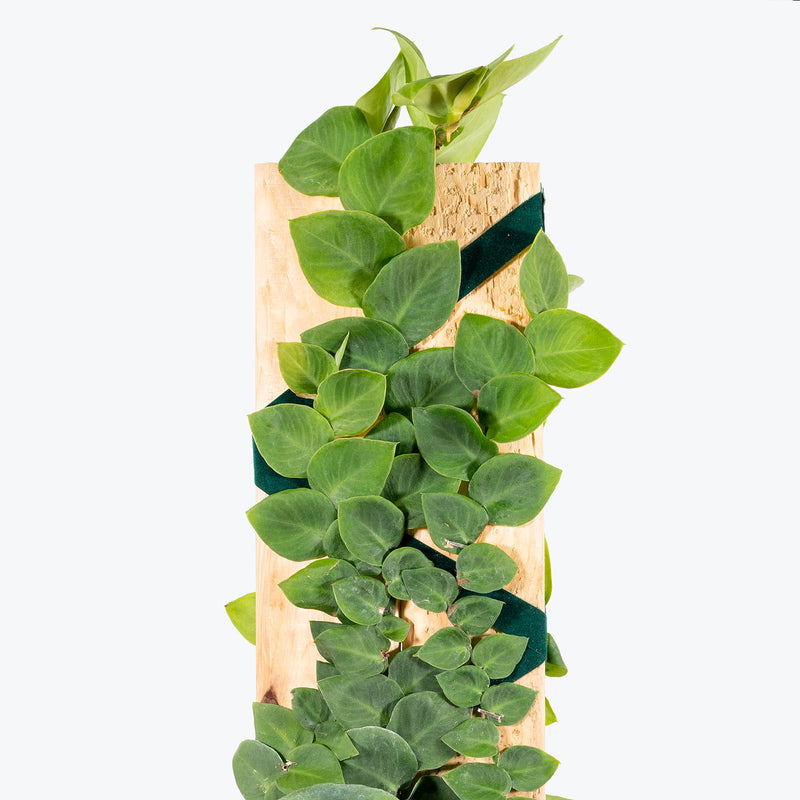
How to care for Shingle Plant
They should not be in a position to see the sun directly, although early morning or late evening sun is fine. Filtered sunlight through a sheer curtain is best and most homes are comprised primarily of indirect sunlight. The best spot for them is where they do not see the sun during the majority of the day but still get bright, indirect light.
They will do well in medium light but will grow faster with brighter light. A good medium-light place in your home would be in the middle of a room that has a regular size window. Remember that plants will grow based on how much light they receive.
Allow the top quarter of the soil to dry before watering again. This usually takes about 3 - 4 days in an average home environment. It will vary depending on the time of year, your environment and lighting conditions. Expect to water more often in brighter light and less often in lower light.
They like a high humidity environment, give them a mist daily or as often as possible. Alternatively, you can put them around a humidifier. Although they won't die if they don't receive enough humidity, their leaves may have some dry, crunchy, or yellow edges.
Shingle plant will grow happily with natural or artificial light. If you don't have a bright window to grow it near, it can thrive under fluorescent or LED lights.
This plant is moderately toxic and can cause some adverse reactions when ingested so it is best to not let your pets eat it, which we advise for all plants in general. The severity of the reaction will depend on how much of the plant is ingested but, if you know your pet typically does not eat your plants, this plant will be suitable for your home..
View PlantShrimp Plant
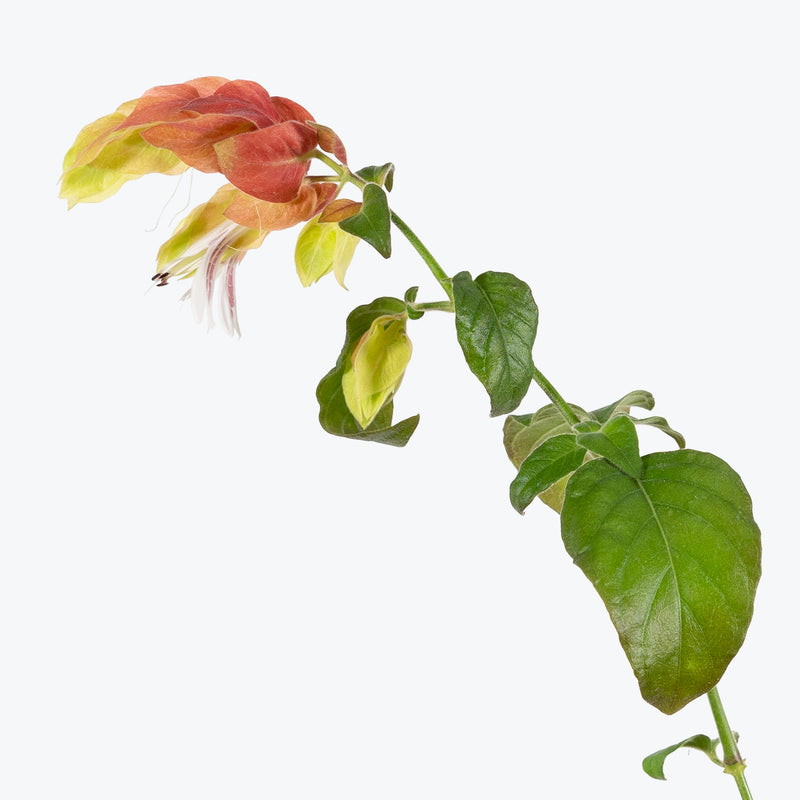
How to care for Shrimp Plant
They should not be in a position to see the sun directly, although early morning or late evening sun is fine. Filtered sunlight through a sheer curtain is best and most homes are comprised primarily of indirect sunlight. The best spot for them is where they do not see the sun during the majority of the day but still get bright, indirect light.
They will do best in bright light. A nice bright place inside your home would be on the window sill or a stool that is right next to a window, either with or without blinds, depending on if the plant can handle sun. Remember that plants will grow based on how much light they receive.
Allow the top quarter of the soil to dry before watering again. This usually takes about 3 - 4 days in an average home environment. It will vary depending on the time of year, your environment and lighting conditions. Expect to water more often in brighter light and less often in lower light.
They can live in any average home humidity condition and are fairly hardy.
Shrimp plants are temperature sensitive. They will yellow or brown in temperatures below about 55 F, especially in arid conditions. However, they will readily grow back as soon as the temperatures increase.
This plant is moderately toxic and can cause some adverse reactions when ingested so it is best to not let your pets eat it, which we advise for all plants in general. The severity of the reaction will depend on how much of the plant is ingested but, if you know your pet typically does not eat your plants, this plant will be suitable for your home..
View PlantSoleirolia Soleirolii
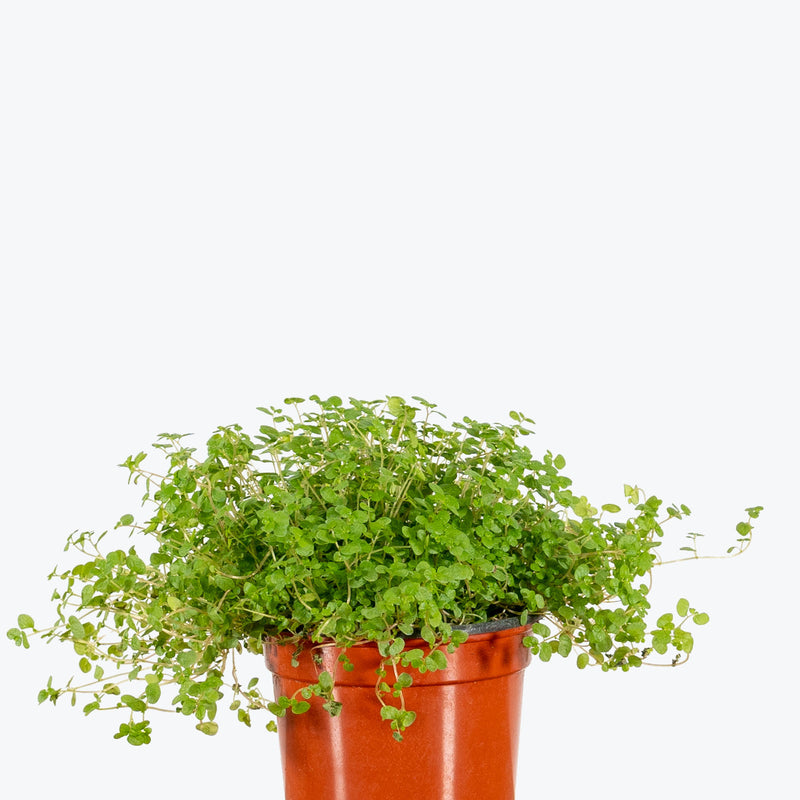
How to care for Soleirolia Soleirolii
They should not be in a position to see the sun directly, although early morning or late evening sun is fine. Filtered sunlight through a sheer curtain is best and most homes are comprised primarily of indirect sunlight. The best spot for them is where they do not see the sun during the majority of the day but still get bright, indirect light.
They will do well in medium light but will grow faster with brighter light. A good medium-light place in your home would be in the middle of a room that has a regular size window. Remember that plants will grow based on how much light they receive.
Allow the top quarter of the soil to dry before watering again. This usually takes about 3 - 4 days in an average home environment. It will vary depending on the time of year, your environment and lighting conditions. Expect to water more often in brighter light and less often in lower light.
They like a high humidity environment, give them a mist daily or as often as possible. Alternatively, you can put them around a humidifier. Although they won't die if they don't receive enough humidity, their leaves may have some dry, crunchy, or yellow edges.
These little guys truly need high humidity in order to look their best, so keep them in terrariums or near a humidifier to bump up the moisture in the air around them.
You can feel comfortable having this plant around your home in the potential case where your pet feels like nibbling on it. However, we typically recommend keeping your pets from eating any of your houseplants..
View PlantSpanish Moss
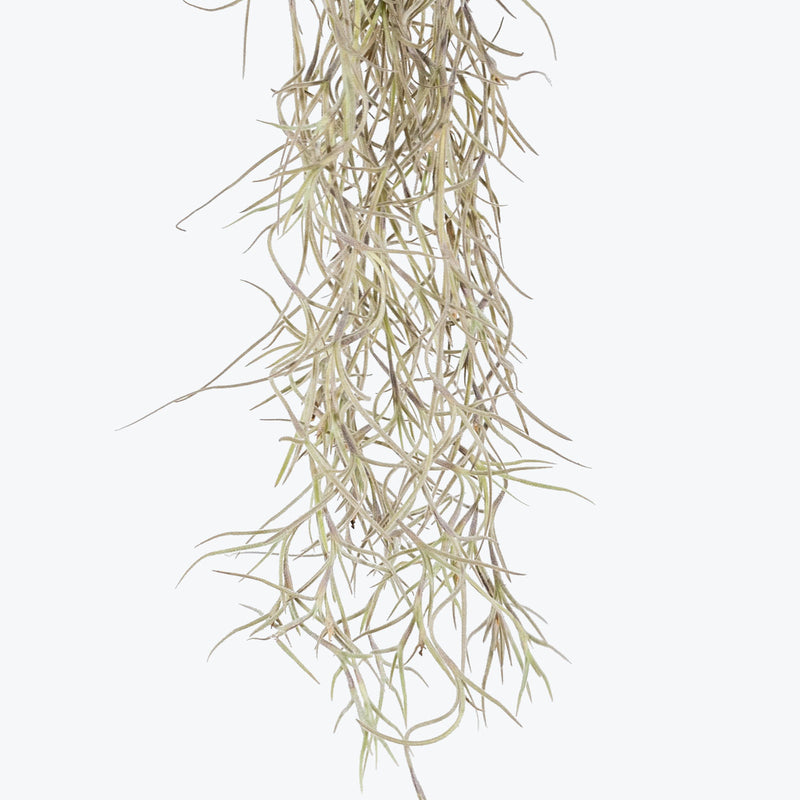
How to care for Spanish Moss
They should not be in a position to see the sun directly, although early morning or late evening sun is fine. Filtered sunlight through a sheer curtain is best and most homes are comprised primarily of indirect sunlight. The best spot for them is where they do not see the sun during the majority of the day but still get bright, indirect light.
They will do best in bright light. A nice bright place inside your home would be on the window sill or a stool that is right next to a window, either with or without blinds, depending on if the plant can handle sun. Remember that plants will grow based on how much light they receive.
Soak them in a bowl of room temperature water for an hour every week. Shake excess water off afterward and lay your plant upside down on a towel in a bright spot to dry.
They like a high humidity environment, give them a mist daily or as often as possible. Alternatively, you can put them around a humidifier. Although they won't die if they don't receive enough humidity, their leaves may have some dry, crunchy, or yellow edges.
Increase humidity with increased light to avoid dry out. Make sure they are in an area with good air circulation, do not put them in completely enclosed containers. Avoid letting water sit between the leaves for very long periods of time after watering, as this can lead to them rotting at the centre.
You can feel comfortable having this plant around your home in the potential case where your pet feels like nibbling on it. However, we typically recommend keeping your pets from eating any of your houseplants..
View PlantSpider Plant Curly Bonnie
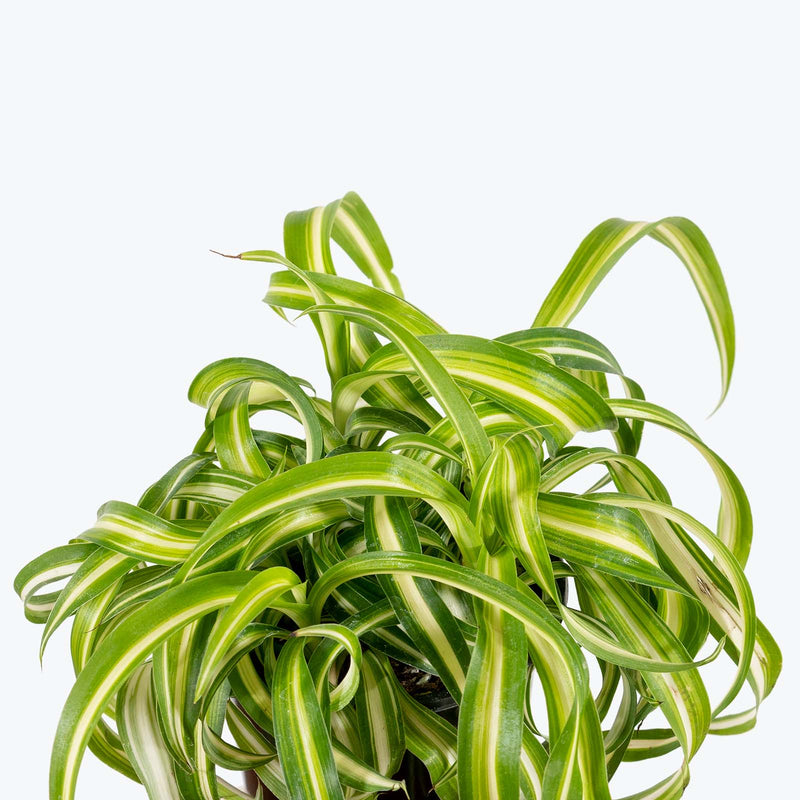
How to care for Spider Plant Curly Bonnie
Spider Plant Curly Bonnie should not be in a position to see the sun directly, although early morning or late evening sun is fine. Filtered sunlight through a sheer curtain is best and most homes are comprised primarily of indirect sunlight. The best spot for them is where they do not see the sun during the majority of the day but still get bright, indirect light.
Spider Plant Curly Bonnie will thrive in medium to bright light, but also can tolerate low light. A good medium-light place in your home would be in the middle of a room that has a regular size window. They can be placed almost anywhere in the room but remember, plants will grow based on how much light they receive.
Spider Plant Curly Bonnie likes the soil to be relatively dry before the next watering. That usually takes about 2 weeks in an average home environment. It will vary depending on the time of year, your environment and lighting conditions, but for them, it's always safer to underwater or water when you see signs of lack of water (i.e. droopy, floppy, or soft leaves). Expect to water more often in brighter light and less often in lower light.
Spider Plant Curly Bonnie can live in any average home humidity condition and is fairly hardy.
Feed Spider Plant Curly Bonnie with a balanced liquid fertilizer every 4-6 weeks during the growing season (spring through early fall), or follow the instructions provided on the fertilizer packaging. Pruning isn't usually necessary, but you can trim off any brown tips with clean scissors. This is often the result of either lower humidity or fluoride found in water, which causes a salt buildup in the soil. If this is the case, allow the water to sit out overnight before watering, or use rain or distilled water. To encourage more curls and maintain plant health, occasionally shower the plant to remove dust and prevent pests.
You can feel comfortable having Spider Plant Curly Bonnie around your home in the potential case where your pet feels like nibbling on it. However, we typically recommend keeping your pets from eating any of your houseplants..
Learn MoreView PlantSpider Plant Green

How to care for Spider Plant Green
They should not be in a position to see the sun directly, as it is too intense for them. Filtered sunlight through a sheer curtain is fine and most homes are comprised primarily of indirect sunlight. The best spot for them is where they do not see the sun during the majority of the day but still get bright, indirect light.
They can handle low light, but will grow faster and fuller with brighter light. A low light plant can pretty much survive any place inside your home as long as you have a window in the room. Remember, low light does not mean no light and plants will grow based on how much light they receive.
They like the soil to be relatively dry before the next watering. That usually takes about two weeks in an average home environment. It may vary depending on the time of year, your environment and lighting conditions, but for them, it's always safer to underwater or water when you see signs of lack of water (i.e. droopy, floppy, or soft leaves). Water more often in the warmer months.
They can live in any average home humidity condition and are fairly hardy.
The green variety is more suited to lower light conditions compared to the variegated variety as it has more chlorophyll, which helps the plant absorb more light. Browning of leaf tips is quite normal and will not harm the plant. This is often the result of fluoride found in water, which causes salt buildup in the soil. If this is the case, allow the water to sit out overnight before watering, or use rain or distilled water.
You can feel comfortable having this plant around your home in the potential case where your pet feels like nibbling on it. However, we typically recommend keeping your pets from eating any of your houseplants..
Learn MoreView PlantSpider Plant Green Bonnie
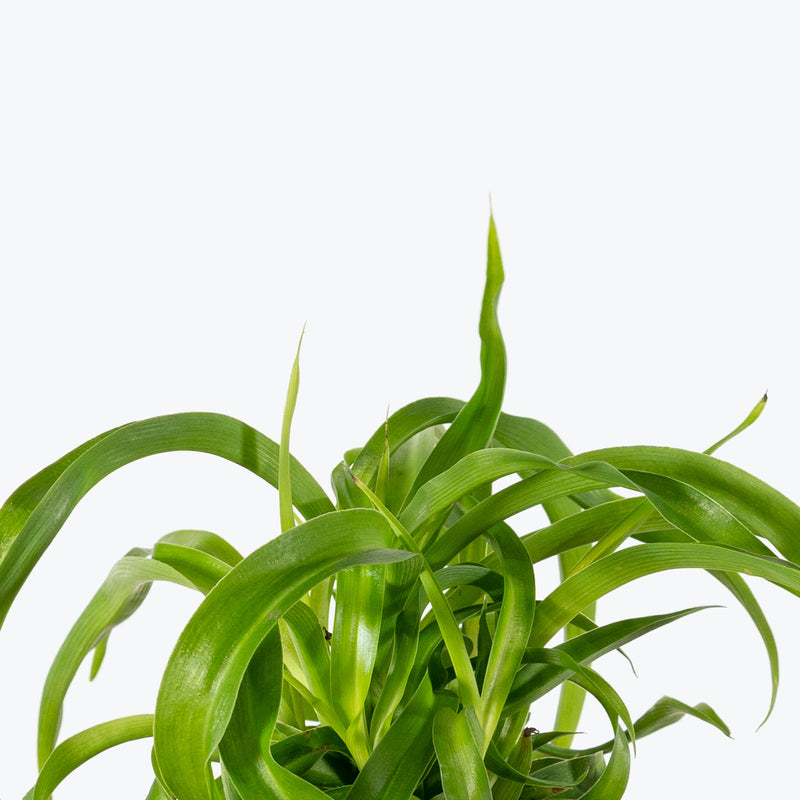
How to care for Spider Plant Green Bonnie
Spider Plant Green Bonnie should not be in a position to see the sun directly, although early morning or late evening sun is fine. Filtered sunlight through a sheer curtain is best and most homes are comprised primarily of indirect sunlight. The best spot for them is where they do not see the sun during the majority of the day but still get bright, indirect light.
Spider Plant Green Bonnie will thrive in medium to bright light, but also can tolerate low light. A good medium-light place in your home would be in the middle of a room that has a regular size window. They can be placed almost anywhere in the room but remember, plants will grow based on how much light they receive.
Spider Plant Green Bonnie likes the soil to be relatively dry before the next watering. That usually takes about 2 weeks in an average home environment. It will vary depending on the time of year, your environment and lighting conditions, but for them, it's always safer to underwater or water when you see signs of lack of water (i.e. droopy, floppy, or soft leaves). Expect to water more often in brighter light and less often in lower light.
Spider Plant Green Bonnie can live in any average home humidity condition and is fairly hardy.
Fertilize Spider Plant Green Bonnie every 4-6 weeks during the growing season with a balanced, water-soluble houseplant fertilizer, diluted to half the recommended strength. During winter, reduce fertilization as growth slows down. Pruning is not typically necessary, but you can trim off brown leaf tips or remove old leaves to keep the plant looking tidy.
You can feel comfortable having Spider Plant Green Bonnie around your home in the potential case where your pet feels like nibbling on it. However, we typically recommend keeping your pets from eating any of your houseplants..
Learn MoreView PlantSpider Plant Reverse
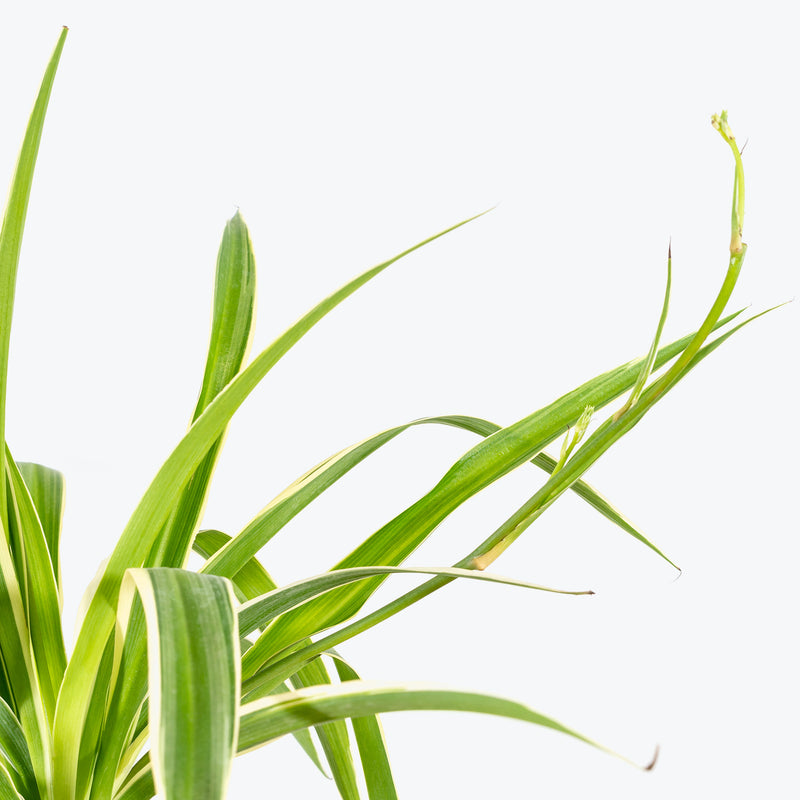
How to care for Spider Plant Reverse
Spider Plant Reverse should not be in a position to see the sun directly, although early morning or late evening sun is fine. Filtered sunlight through a sheer curtain is best and most homes are comprised primarily of indirect sunlight. The best spot for them is where they do not see the sun during the majority of the day but still get bright, indirect light.
Spider Plant Reverse will thrive in medium to bright light, but also can tolerate low light. A good medium-light place in your home would be in the middle of a room that has a regular size window. They can be placed almost anywhere in the room but remember, plants will grow based on how much light they receive.
Spider Plant Reverse likes the soil to be relatively dry before the next watering. That usually takes about two weeks in an average home environment. It may vary depending on the time of year, your environment and lighting conditions, but for them, it's always safer to underwater or water when you see signs of lack of water (i.e. droopy, floppy, or soft leaves). Water more often in the warmer months!
Spider Plant Reverse can live in any average home humidity condition and is fairly hardy.
Feed Spider Plant Reverse with a balanced liquid fertilizer every 4-6 weeks during the growing season (spring through early fall), or follow the instructions provided on the fertilizer packaging. Pruning is rarely necessary, but trimming brown tips can keep the plant looking neat. This is often the result of either lower humidity or fluoride found in water, which causes a salt buildup in the soil. If this is the case, allow the water to sit out overnight before watering, or use rain or distilled water. Spider Plants are known for producing baby plants or "spiderettes" that can be propagated easily by placing them in soil or water until they root.
You can feel comfortable having Spider Plant Reverse around your home in the potential case where your pet feels like nibbling on it. However, we typically recommend keeping your pets from eating any of your houseplants..
Learn MoreView PlantSpider Plant Variegated
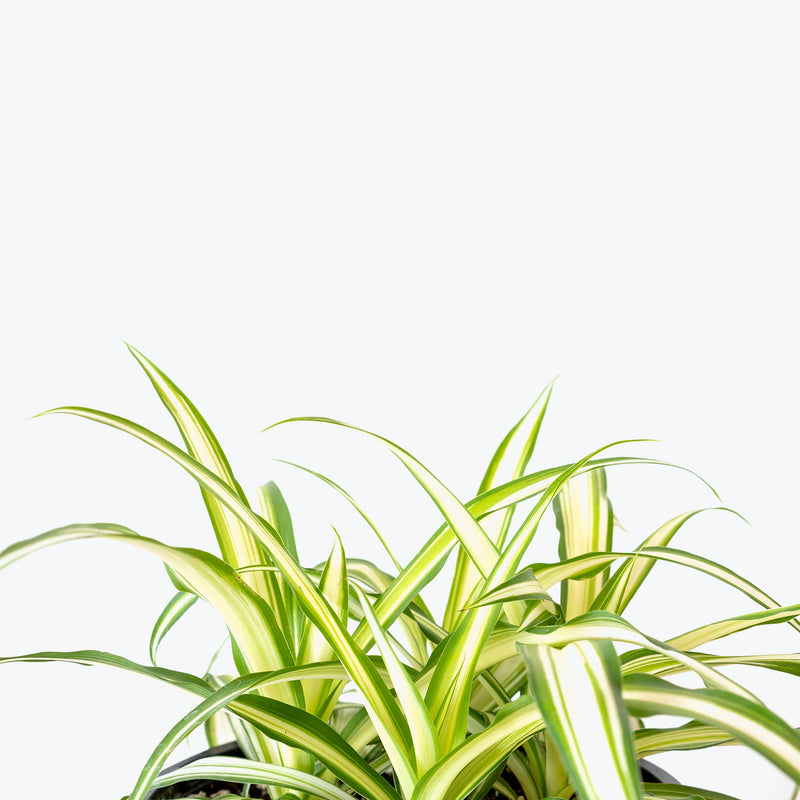
How to care for Spider Plant Variegated
Variegated Spider Plant should not be in a position to see the sun directly, although early morning or late evening sun is fine. Filtered sunlight through a sheer curtain is best and most homes are comprised primarily of indirect sunlight. The best spot for them is where they do not see the sun during the majority of the day but still get bright, indirect light.
Variegated Spider Plant will thrive in medium to bright light, but also can tolerate low light. A good medium-light place in your home would be in the middle of a room that has a regular size window. They can be placed almost anywhere in the room but remember, plants will grow based on how much light they receive.
Variegated Spider Plant likes the soil to be relatively dry before the next watering. That usually takes about two weeks in an average home environment. It may vary depending on the time of year, your environment and lighting conditions, but for them, it's always safer to underwater or water when you see signs of lack of water (i.e. droopy, floppy, or soft leaves). Water more often in the warmer months!
Variegated Spider Plant can live in any average home humidity condition and are fairly hardy.
Fertilize your Variegated Spider Plant every month during the spring and summer with a balanced, water-soluble fertilizer. Browning of leaf tips is quite normal and will not harm the plant. This is often the result of either lower humidity or fluoride found in water, which causes a salt buildup in the soil. If this is the case, allow the water to sit out overnight before watering, or use rain or distilled water. Repotting is rarely needed, but you can do so if the plant becomes root-bound or the pups overcrowd the pot.
You can feel comfortable having Variegated Spider Plant around your home in the potential case where your pet feels like nibbling on it. However, we typically recommend keeping your pets from eating any of your houseplants..
Learn MoreView PlantSpiral Cactus
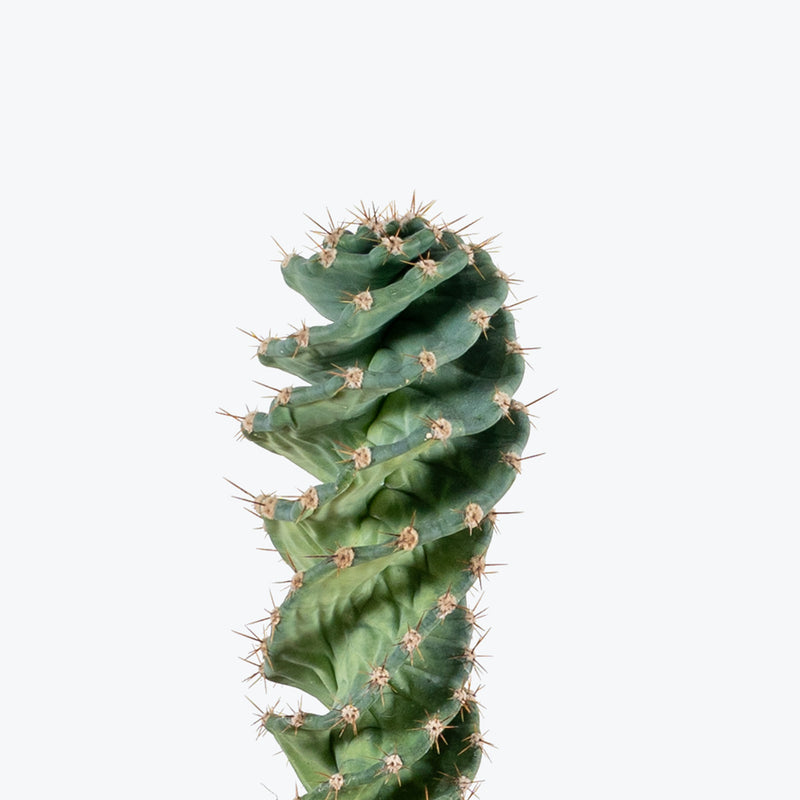
How to care for Spiral Cactus
Spiral Cactus enjoys some direct sun, but they'll also do well in bright, indirect light. It is best to place this plant somewhere where it will receive some nice morning sun, or a couple hours of afternoon sun, and then indirect light the rest of the day.
Spiral Cactus will do best in bright light. A nice bright place inside your home would be on the window sill or a stool that is right next to a window, either with or without blinds, depending on if the plant can handle sun. Remember that plants will grow based on how much light they receive.
Spiral Cactus likes the soil to be completely dry before the next watering. That usually takes about 4 weeks in an average home environment. It will vary depending on the time of year, your environment and lighting conditions, but for them, it's always safer to underwater or water when you see signs of lack of water (i.e. wrinkly or soft leaves). Water a little more often in the warmer months.
Their humidity requirement is low, so do not mist Spiral Cactus or put them in an enclosed terrarium.
Fertilize Spiral Cactus with a liquid fertilizer during the growing season (spring and summer) about once a month to support healthy growth. Do not fertilize in the winter. If the cactus becomes top-heavy or grows very tall, consider staking it or providing a support structure to prevent tipping. Be cautious with handling due to its spines.
While the Spiral Cactus is not toxic to pets, its sharp spines can pose a physical hazard to curious pets who might try to touch or nibble at it. It's best to keep this plant out of reach of pets to avoid injuries..
Learn MoreView PlantStaghorn Fern
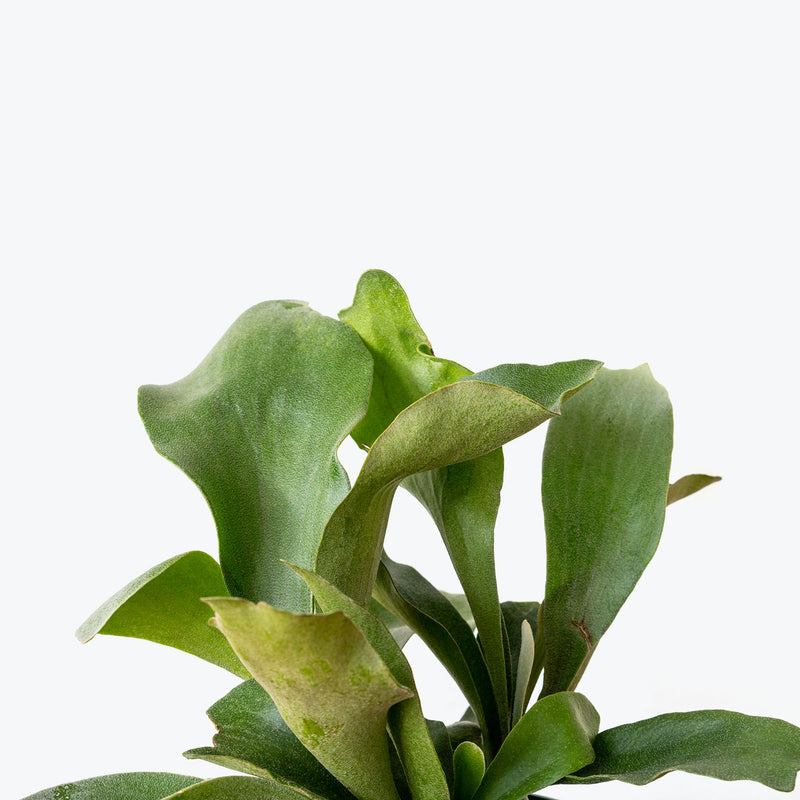
How to care for Staghorn Fern
Staghorn Fern should not be in a position to see the sun directly, although early morning or late evening sun is fine. Filtered sunlight through a sheer curtain is best and most homes are comprised primarily of indirect sunlight. The best spot for them is where they do not see the sun during the majority of the day but still get bright, indirect light.
Staghorn Fern will thrive in bright light, but also can tolerate medium light. A good medium-light place in your home would be in the middle of a room that has a regular size window. They can be placed anywhere between the middle of the room and the window. Remember that plants will grow based on how much light they receive.
Staghorn Fern likes the soil to be relatively dry before the next watering. That usually takes about 2 weeks in an average home environment. It will vary depending on the time of year, your environment and lighting conditions, but for them, it's always safer to underwater or water when you see signs of lack of water (i.e. droopy, floppy, or soft leaves). Expect to water more often in brighter light and less often in lower light.
Staghorn Fern likes a high humidity environment, give them a mist daily or as often as possible. Alternatively, you can put them around a humidifier. Although they won't die if they don't receive enough humidity, their leaves may have some dry, crunchy, or yellow edges.
Fertilize Staghorn Fern lightly during the growing season with a diluted, balanced fertilizer every month. Avoid over-fertilization to prevent harm. Remove any brown or dead fronds to keep the plant healthy and aesthetically pleasing. Support the weight of mature plants adequately if mounted or hung.
You can feel comfortable having Staghorn Fern around your home in the potential case where your pet feels like nibbling on it. However, we typically recommend keeping your pets from eating any of your houseplants..
View PlantStaghorn Fern Netherlands
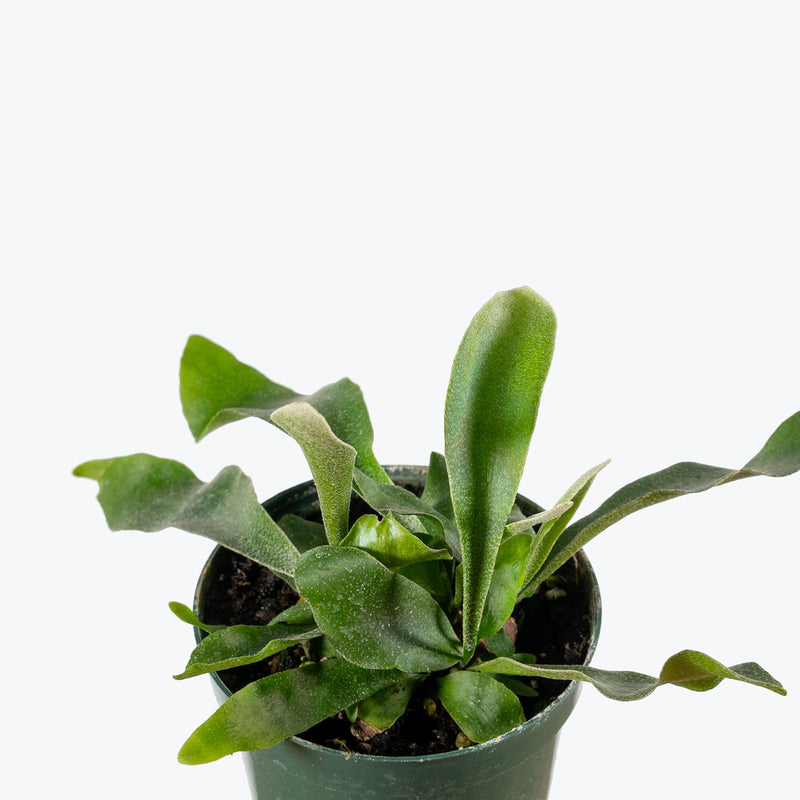
How to care for Staghorn Fern Netherlands
Staghorn Fern Netherlands should not be in a position to see the sun directly, although early morning or late evening sun is fine. Filtered sunlight through a sheer curtain is best and most homes are comprised primarily of indirect sunlight. The best spot for them is where they do not see the sun during the majority of the day but still get bright, indirect light.
Staghorn Fern Netherlands will thrive in bright light, but also can tolerate medium light. A good medium-light place in your home would be in the middle of a room that has a regular size window. They can be placed anywhere between the middle of the room and the window. Remember that plants will grow based on how much light they receive.
Staghorn Fern Netherlands likes the soil to be relatively dry before the next watering. That usually takes about 2 weeks in an average home environment. It will vary depending on the time of year, your environment and lighting conditions, but for them, it's always safer to underwater or water when you see signs of lack of water (i.e. droopy, floppy, or soft leaves). Expect to water more often in brighter light and less often in lower light.
Staghorn Fern Netherlands will do well in average humidity environments but will appreciate a little bit of humidity if provided, give them a mist daily or get a humidifier.
Mounted or potted, Staghorn Fern Netherlands thrives best in airy conditions with good airflow. Use sphagnum moss or a well-draining potting mix if grown in a container. Mist regularly to keep humidity up, especially in drier climates or during winter. Clean dust from fronds gently with a soft brush — avoid wiping or breaking the delicate surface. Rotate occasionally for even growth. Feed lightly once a month during the growing season with a diluted liquid fertilizer suitable for epiphytic plants.
You can feel comfortable having Staghorn Fern Netherlands around your home in the potential case where your pet feels like nibbling on it. However, we typically recommend keeping your pets from eating any of your houseplants..
View PlantStapelia Hirsuta
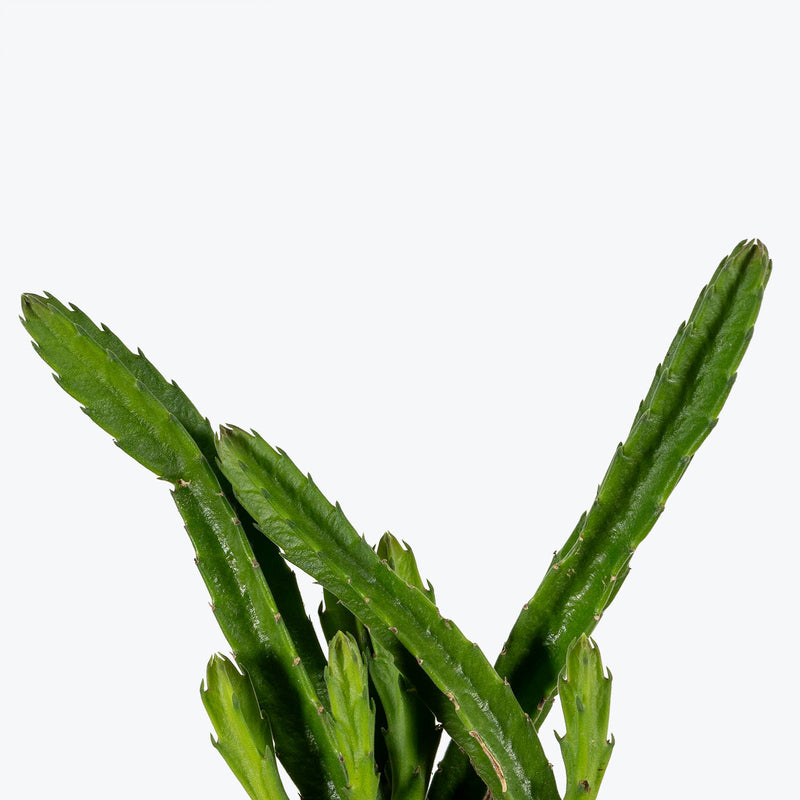
How to care for Stapelia Hirsuta
Stapelia Hirsuta enjoys some direct sun, but they'll also do well in bright, indirect light. It is best to place this plant somewhere where it will receive some nice morning sun, or a couple hours of afternoon sun, and then indirect light the rest of the day.
Stapelia Hirsuta will thrive in bright light, but also can tolerate medium light. A good medium-light place in your home would be in the middle of a room that has a regular size window. They can be placed anywhere between the middle of the room and the window. Remember that plants will grow based on how much light they receive.
Stapelia Hirsuta likes the soil to be completely dry before the next watering. That usually takes about 4 weeks in an average home environment. It will vary depending on the time of year, your environment and lighting conditions, but for them, it's always safer to underwater or water when you see signs of lack of water (i.e. wrinkly or soft leaves). Water a little more often in the warmer months.
Their humidity requirement is low, so do not mist Stapelia Hirsuta or put them in an enclosed terrarium.
Ensure Stapelia Hirsuta is potted in well-draining soil and does not sit in water. Additionally, this plant prefers a warmer climate, so avoid exposure to temperatures below 50°F.
Stapelia Hirsuta is moderately toxic and can cause some adverse reactions when ingested so it is best to not let your pets eat it, which we advise for all plants in general. The severity of the reaction will depend on how much of the plant is ingested but, if you know your pet typically does not eat your plants, this plant will be suitable for your home..
View PlantStar Jasmine
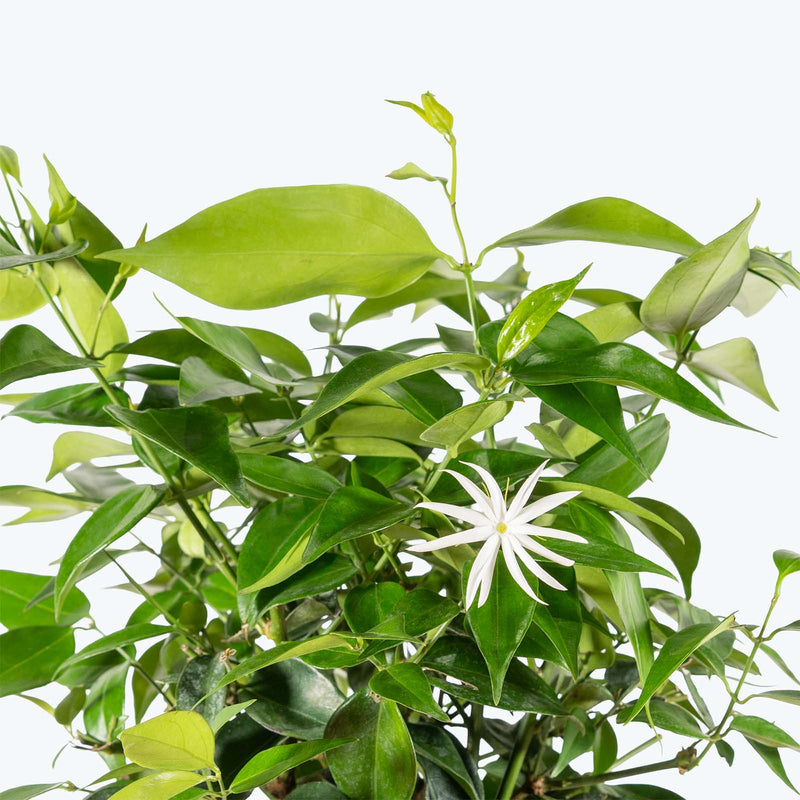
How to care for Star Jasmine
Star Jasmine enjoys some direct sun, but they'll also do well in bright, indirect light. It is best to place this plant somewhere where it will receive some nice morning sun, or a couple hours of afternoon sun, and then indirect light the rest of the day.
Star Jasmine will do best in bright light. A nice bright place inside your home would be on the window sill or a stool that is right next to a window, either with or without blinds, depending on if the plant can handle sun. Remember that plants will grow based on how much light they receive.
Star Jasmine needs to be watered when the top half of the soil is dry to the touch. That usually takes about 1 week in an average home environment. It will vary depending on the time of year, your environment and lighting conditions, but it's always safer to underwater or give the soil a check before you water again. Expect to water more often in brighter light and less often in lower light.
Star Jasmine will do well in average humidity environments but will appreciate a little bit of humidity if provided, give them a mist daily or get a humidifier.
Provide Star Jasmine a sturdy support such as a trellis or pergola for climbing growth. Prune lightly after flowering to maintain shape and encourage bushiness. Fertilize in spring and mid-summer with a balanced fertilizer to promote strong foliage and abundant blooms. Mulch around the base outdoors to help retain soil moisture.
Star Jasmine is moderately toxic and can cause some adverse reactions when ingested so it is best to not let your pets eat it, which we advise for all plants in general. The severity of the reaction will depend on how much of the plant is ingested but, if you know your pet typically does not eat your plants, this plant will be suitable for your home..
View PlantStone Pine
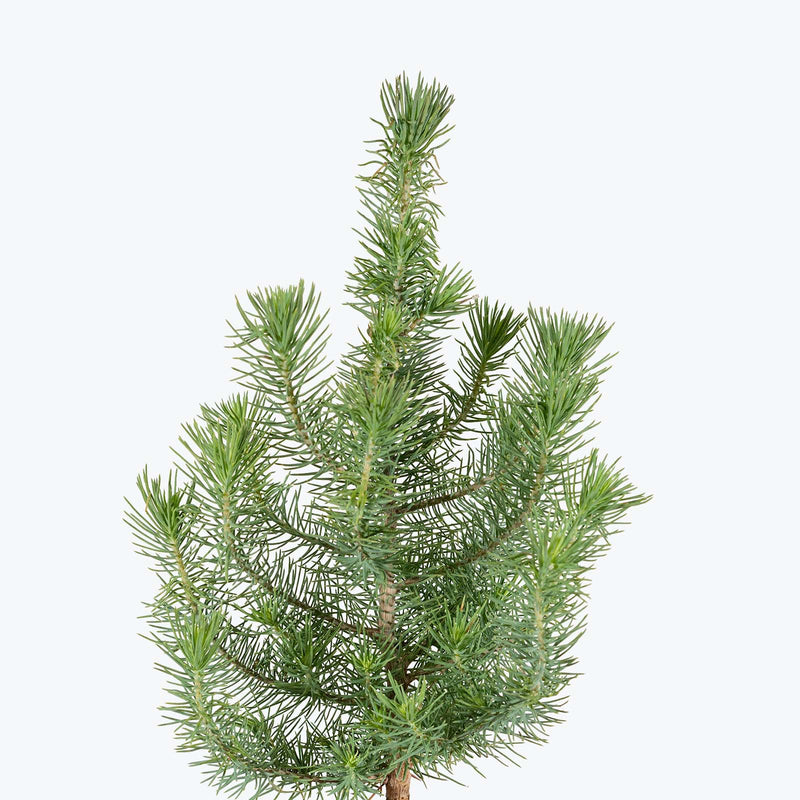
How to care for Stone Pine
They enjoy some direct sun, but they'll also do well in bright, indirect light. It is best to place this plant somewhere where it will receive some nice morning sun, or a couple hours of afternoon sun, and then indirect light the rest of the day.
They will do best in bright light. A nice bright place inside your home would be on the window sill or a stool that is right next to a window, either with or without blinds, depending on if the plant can handle sun. Remember that plants will grow based on how much light they receive.
They need to be watered when the top half of the soil is dry to the touch. That usually takes about 1 week in an average home environment. It will vary depending on the time of year, your environment and lighting conditions, but it's always safer to underwater or give the soil a check before you water again. Expect to water more often in brighter light and less often in lower light.
They can live in any average home humidity condition and are fairly hardy.
Stone pine likes lots of bright, even direct light, so a spot in a south or west window is perfect. Prune branch tips to maintain shape and size as it grows and note that the lower branches tend to shed with maturity, gradually transforming the plant from a rounded shrub into a towering umbrella-shaped tree.
This plant is moderately toxic and can cause some adverse reactions when ingested so it is best to not let your pets eat it, which we advise for all plants in general. The severity of the reaction will depend on how much of the plant is ingested but, if you know your pet typically does not eat your plants, this plant will be suitable for your home..
View PlantStrawberry Begonia
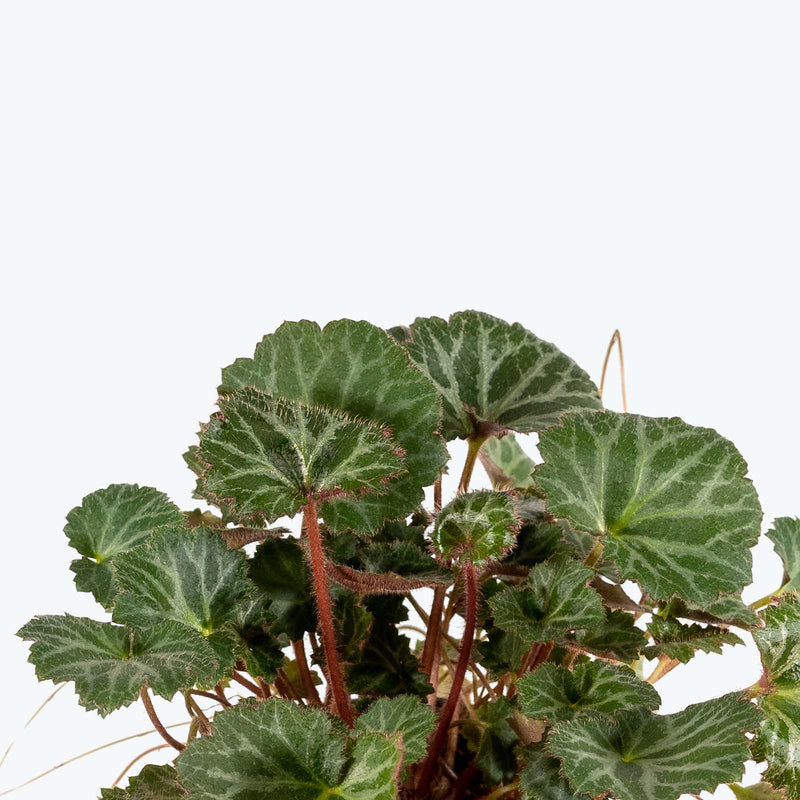
How to care for Strawberry Begonia
They should not be in a position to see the sun directly, although early morning or late evening sun is fine. Filtered sunlight through a sheer curtain is best and most homes are comprised primarily of indirect sunlight. The best spot for them is where they do not see the sun during the majority of the day but still get bright, indirect light.
They will do best in bright light. A nice bright place inside your home would be on the window sill or a stool that is right next to a window, either with or without blinds, depending on if the plant can handle sun. Remember that plants will grow based on how much light they receive.
They need to be watered when the top half of the soil is dry to the touch. That usually takes about 1 week in an average home environment. It will vary depending on the time of year, your environment and lighting conditions, but it's always safer to underwater or give the soil a check before you water again. Expect to water more often in brighter light and less often in lower light.
They can live in any average home humidity condition and are fairly hardy. Avoid misting the leaves directly.
As with other hairy-leaved plants, avoid getting water on their leaves to reduce the risk of fungal disorders. During winter, reduce watering but don't let it dry out completely. Also, don't be alarmed if growth dramatically slows down or stops during the winter.
You can feel comfortable having this plant around your home in the potential case where your pet feels like nibbling on it. However, we typically recommend keeping your pets from eating any of your houseplants..
View PlantStrawberry Begonia Variegated
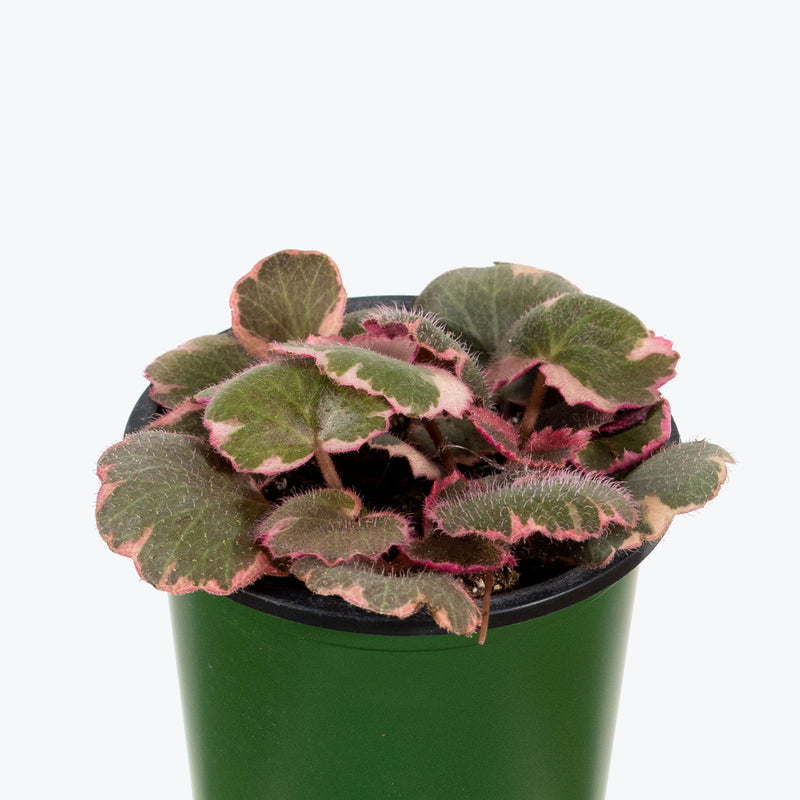
How to care for Strawberry Begonia Variegated
They should not be in a position to see the sun directly, although early morning or late evening sun is fine. Filtered sunlight through a sheer curtain is best and most homes are comprised primarily of indirect sunlight. The best spot for them is where they do not see the sun during the majority of the day but still get bright, indirect light.
They will do best in bright light. A nice bright place inside your home would be on the window sill or a stool that is right next to a window, either with or without blinds, depending on if the plant can handle sun. Remember that plants will grow based on how much light they receive.
They need to be watered when the top half of the soil is dry to the touch. That usually takes about 1 week in an average home environment. It will vary depending on the time of year, your environment and lighting conditions, but it's always safer to underwater or give the soil a check before you water again. Expect to water more often in brighter light and less often in lower light.
They can live in any average home humidity condition and are fairly hardy. Avoid misting the leaves directly.
As with other hairy-leaved plants, avoid getting water on their leaves to reduce the risk of fungal disorders. During winter, reduce watering but don't let it dry out completely. Also, don't be alarmed if growth dramatically slows down or stops during the winter.
You can feel comfortable having this plant around your home in the potential case where your pet feels like nibbling on it. However, we typically recommend keeping your pets from eating any of your houseplants..
View PlantStreptocarpus Pretty Turtle
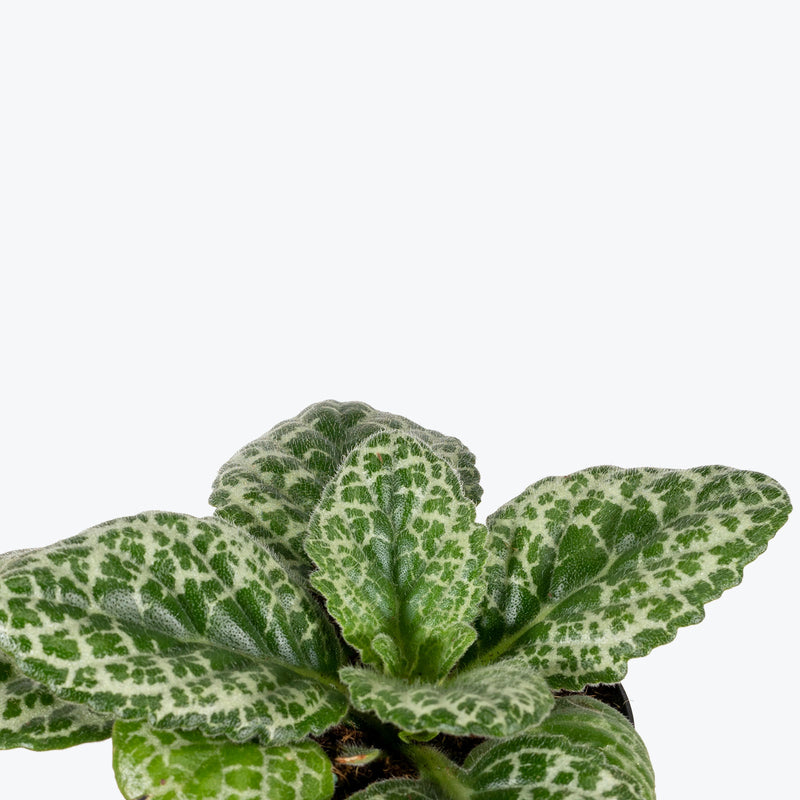
How to care for Streptocarpus Pretty Turtle
They should not be in a position to see the sun directly, although early morning or late evening sun is fine. Filtered sunlight through a sheer curtain is best and most homes are comprised primarily of indirect sunlight. The best spot for them is where they do not see the sun during the majority of the day but still get bright, indirect light.
They will do best in bright light. A nice bright place inside your home would be on the window sill or a stool that is right next to a window, either with or without blinds, depending on if the plant can handle sun. Remember that plants will grow based on how much light they receive.
They need to be watered when the top half of the soil is dry to the touch. That usually takes about 1 week in an average home environment. It will vary depending on the time of year, your environment and lighting conditions, but it's always safer to underwater or give the soil a check before you water again. Expect to water more often in brighter light and less often in lower light.
They will do well in average humidity environments but will appreciate a little bit of humidity if provided, give them a mist daily or get a humidifier.
Rotate the plant every once in a while to ensure even growth. To encourage blooming, deadhead spent flowers to redirect the plant's energy into producing new blossoms.
You can feel comfortable having this plant around your home in the potential case where your pet feels like nibbling on it. However, we typically recommend keeping your pets from eating any of your houseplants..
View PlantString of Arrows
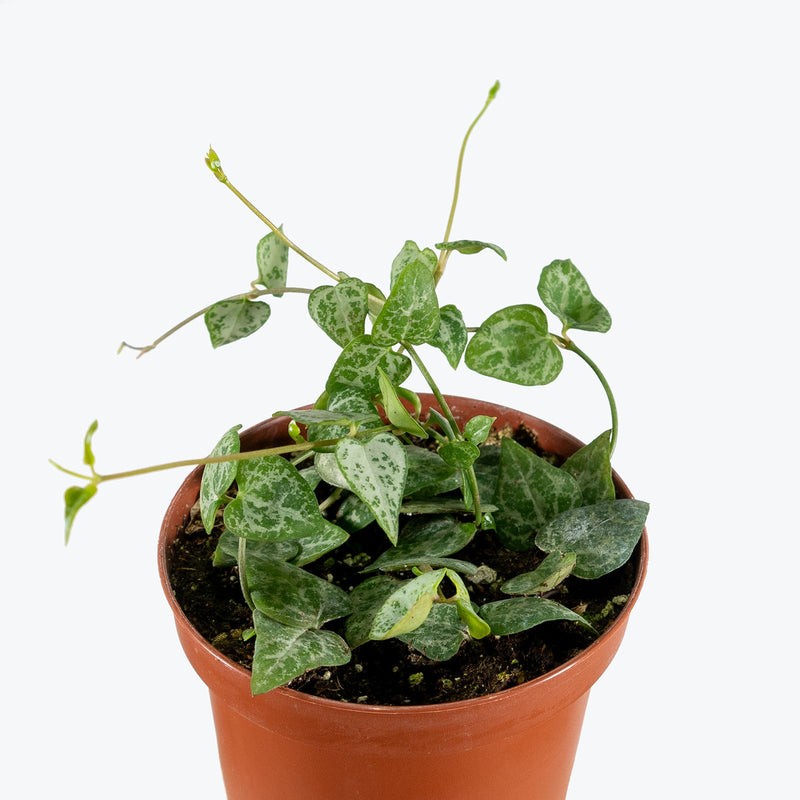
How to care for String of Arrows
String of Arrows should not be in a position to see the sun directly, although early morning or late evening sun is fine. Filtered sunlight through a sheer curtain is best and most homes are comprised primarily of indirect sunlight. The best spot for them is where they do not see the sun during the majority of the day but still get bright, indirect light.
String of Arrows will do best in bright light. A nice bright place inside your home would be on the window sill or a stool that is right next to a window, either with or without blinds, depending on if the plant can handle sun. Remember that plants will grow based on how much light they receive.
String of Arrows likes the soil to be completely dry before the next watering. This can take up to 4 weeks in an average home environment but it will vary depending on the time of year, your environment and lighting conditions. For them, it's always safer to underwater or water when you see signs of lack of water (i.e. wrinkly or soft leaves). Water a little more often in the warmer months.
Their humidity requirement is low, so do not mist String of Arrows or put them in a terrarium.
If there is less marbling on the leaves, and the gaps between the leaves on the stems are wide, this is often an indicator that the plant is receiving lower light. If you want the growth to be more dense, where the leaves are closer together, move your plant to a spot where it will receive brighter light. String of Arrows store water in their leaves, so a good indicator to watch for is the leaves beginning to soften and look a little wilted and deflated. Regularly prune back the vines to encourage fuller, bushier growth and to keep the plant looking tidy. Check periodically for pests such as spider mites and treat them with appropriate measures if necessary.
You can feel comfortable having String of Arrows around your home in the potential case where your pet feels like nibbling on it. However, we typically recommend keeping your pets from eating any of your houseplants..
View PlantString of Arrows Variegata
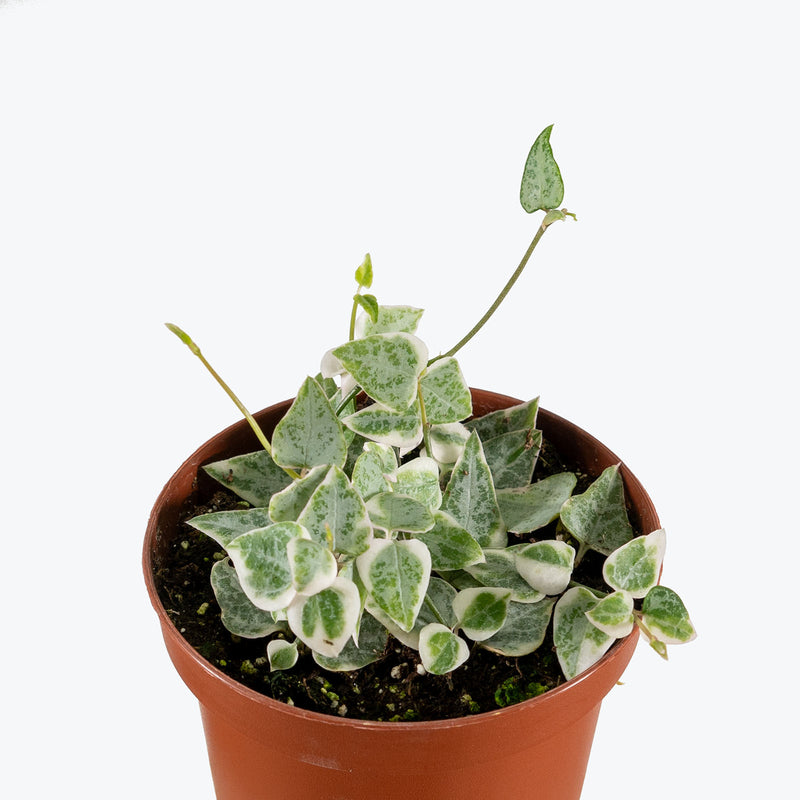
How to care for String of Arrows Variegata
String of Arrows Variegata should not be in a position to see the sun directly, although early morning or late evening sun is fine. Filtered sunlight through a sheer curtain is best and most homes are comprised primarily of indirect sunlight. The best spot for them is where they do not see the sun during the majority of the day but still get bright, indirect light.
String of Arrows Variegata will do best in bright light. A nice bright place inside your home would be on the window sill or a stool that is right next to a window, either with or without blinds, depending on if the plant can handle sun. Remember that plants will grow based on how much light they receive.
String of Arrows Variegata likes the soil to be completely dry before the next watering. This can take up to 4 weeks in an average home environment but it will vary depending on the time of year, your environment and lighting conditions. For them, it's always safer to underwater or water when you see signs of lack of water (i.e. wrinkly or soft leaves). Water a little more often in the warmer months.
Their humidity requirement is low, so do not mist String of Arrows Variegata or put them in a terrarium.
If there is less marbling on the leaves, and the gaps between the leaves on the stems are wide, this is often an indicator that the plant is receiving lower light. If you want the growth to be more dense, where the leaves are closer together, move your plant to a spot where it will receive brighter light. String of Arrows Variegata store water in their leaves, so a good indicator to watch for is the leaves beginning to soften and look a little wilted and deflated. Regularly prune back the vines to encourage fuller, bushier growth and to keep the plant looking tidy. Check periodically for pests such as spider mites and treat them with appropriate measures if necessary.
You can feel comfortable having String of Arrows Variegata around your home in the potential case where your pet feels like nibbling on it. However, we typically recommend keeping your pets from eating any of your houseplants..
View PlantString of Dolphins
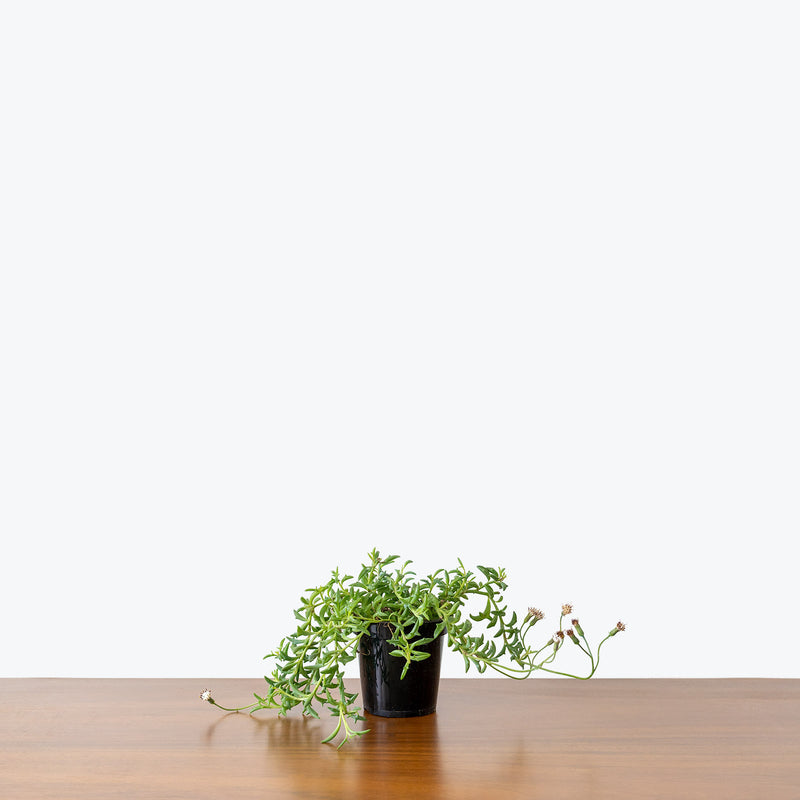
How to care for String of Dolphins
They enjoy some direct sun, but they'll also do well in bright, indirect light. It is best to place this plant somewhere where it will receive some nice morning sun, or a couple hours of afternoon sun, and then indirect light the rest of the day.
They will do best in bright light. A nice bright place inside your home would be on the window sill or a stool that is right next to a window, either with or without blinds, depending on if the plant can handle sun. Remember that plants will grow based on how much light they receive.
They like the soil to be completely dry before the next watering. This can take up to 4 weeks in an average home environment but it will vary depending on the time of year, your environment and lighting conditions. For them, it's always safer to underwater or water when you see signs of lack of water (i.e. wrinkly or soft leaves). Water a little more often in the warmer months.
Their humidity requirement is low, so do not mist them or put them in a terrarium.
It can be propagated via clippings, simply allow the cut end to callous over and insert into the dirt. They also prefer slightly crowded conditions, so make sure not to give them too much space when repotting. Finally, keep them in warmer temperatures and avoid letting them sit where there are drafts, as this can cause leaf drop.
This plant is moderately toxic and can cause some adverse reactions when ingested so it is best to not let your pets eat it, which we advise for all plants in general. The severity of the reaction will depend on how much of the plant is ingested but, if you know your pet typically does not eat your plants, this plant will be suitable for your home..
View PlantString of Hearts
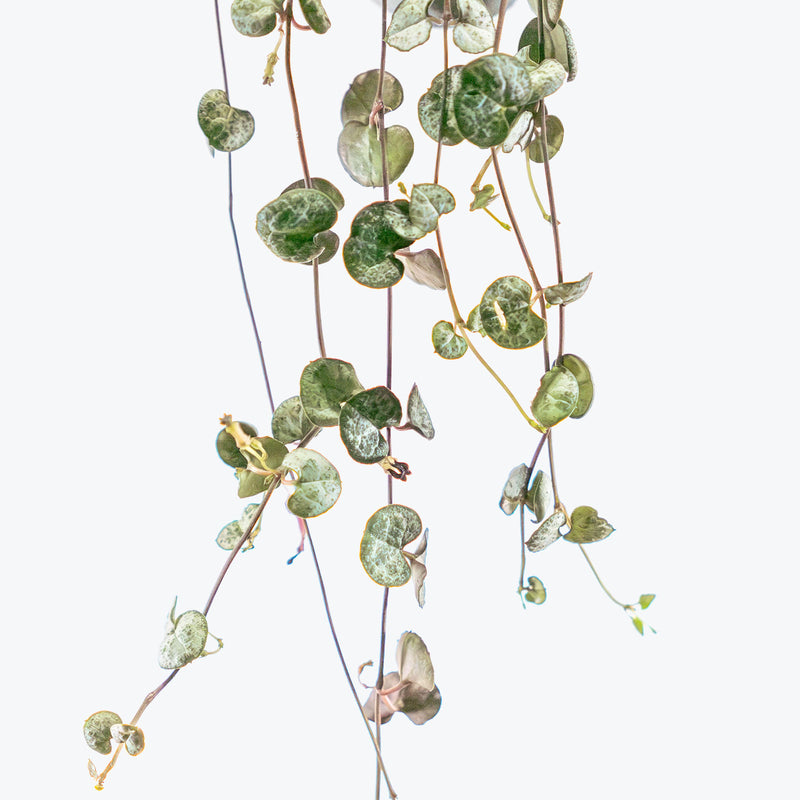
How to care for String of Hearts
String of Hearts should not be in a position to see the sun directly, although early morning or late evening sun is fine. Filtered sunlight through a sheer curtain is best and most homes are comprised primarily of indirect sunlight. The best spot for them is where they do not see the sun during the majority of the day but still get bright, indirect light.
String of Hearts will do best in bright light. A nice bright place inside your home would be on the window sill or a stool that is right next to a window, either with or without blinds, depending on if the plant can handle sun. Remember that plants will grow based on how much light they receive.
String of Hearts likes the soil to be completely dry before the next watering. This can take up to 4 weeks in an average home environment but it will vary depending on the time of year, your environment and lighting conditions. For them, it's always safer to underwater or water when you see signs of lack of water (i.e. wrinkly or soft leaves). Water a little more often in the warmer months.
String of Hearts humidity requirement is low, so do not mist them or put them in a terrarium.
If there is less marbling on the leaves, and the gaps between the leaves on the stems are wide, this is often an indicator that the String of Hearts is receiving lower light. If you want the growth to more dense, where the leaves are closer together, move your plant to a spot where it will receive brighter light.
You can feel comfortable having String of Hearts plant around your home in the potential case where your pet feels like nibbling on it. However, we typically recommend keeping your pets from eating any of your houseplants..
View PlantString of Hearts Silver Glory
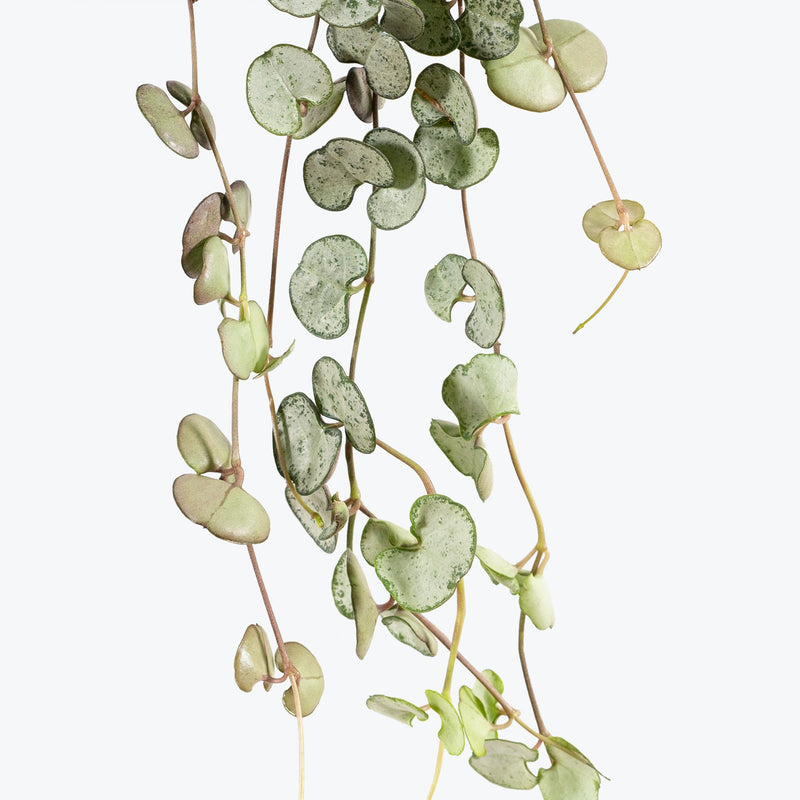
How to care for String of Hearts Silver Glory
String of Hearts Silver Glory enjoys some direct sun, but they'll also do well in bright, indirect light. It is best to place this plant somewhere where it will receive some nice morning sun, or a couple hours of afternoon sun, and then indirect light the rest of the day.
String of Hearts Silver Glory will do best in bright light. A nice bright place inside your home would be on the window sill or a stool that is right next to a window, either with or without blinds, depending on if the plant can handle sun. Remember that plants will grow based on how much light they receive.
String of Hearts Silver Glory likes the soil to be completely dry before the next watering. That usually takes about two weeks in an average home environment. It may vary depending on the time of year, your environment and lighting conditions, but for them, it's always safer to underwater or water when you see signs of lack of water (i.e. wrinkly or soft leaves).
Their humidity requirement is low, so do not put String of Hearts Silver Glory in an enclosed terrarium.
String of Hearts Silver Glory stores water in their leaves, so a good indicator to know when to water your plant again is to watch for the leaves beginning to soften and start to look a little wilted. If you want a more full and lush plant, you can take cuttings of the your plant and re-plant them back into the pot! Just make sure there is a node (where the a leaf used to meet the stem) inserted into the soil.
You can feel comfortable having String of Hearts Silver Glory around your home in the potential case where your pet feels like nibbling on it. However, we typically recommend keeping your pets from eating any of your houseplants..
View PlantString of Hearts Variegata
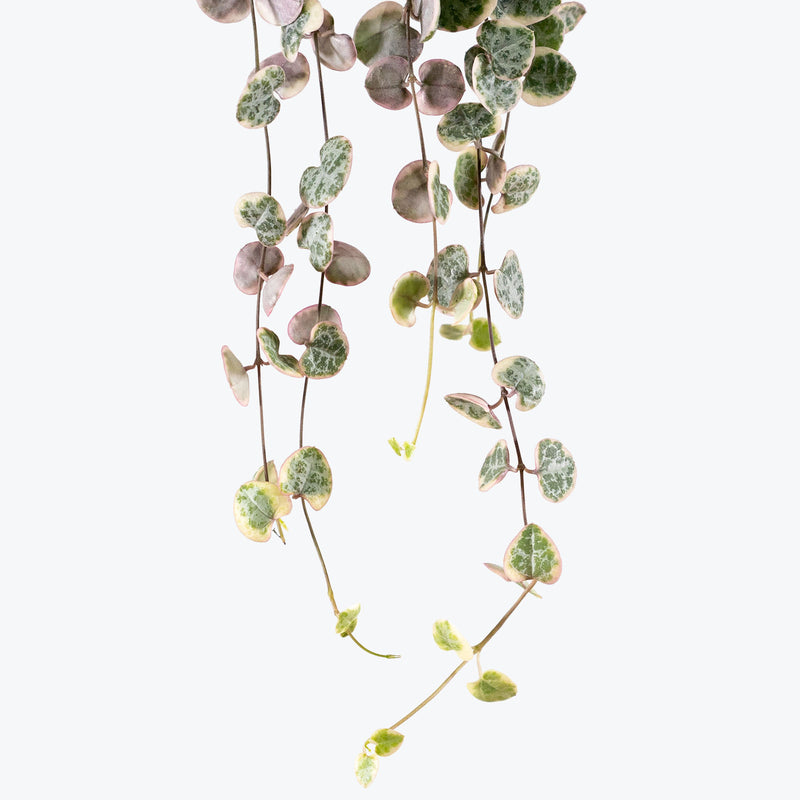
How to care for String of Hearts Variegata
String of Hearts Variegata enjoys some direct sun, but they'll also do well in bright, indirect light. It is best to place this plant somewhere where it will receive some nice morning sun, or a couple hours of afternoon sun, and then indirect light the rest of the day.
String of Hearts Variegata will do best in bright light. A nice bright place inside your home would be on the window sill or a stool that is right next to a window, either with or without blinds, depending on if the plant can handle sun. Remember that plants will grow based on how much light they receive.
String of Hearts Variegata likes the soil to be relatively dry before the next watering. That usually takes about 2 weeks in an average home environment. It will vary depending on the time of year, your environment and lighting conditions, but for them, it's always safer to underwater or water when you see signs of lack of water (i.e. droopy, floppy, or soft leaves). Expect to water more often in brighter light and less often in lower light.
Their humidity requirement is low, so do not mist String of Hearts Variegata or put them in a terrarium.
String of Hearts Variegata benefits from being slightly pot-bound, so repotting should only be done when absolutely necessary, typically every few years. All varieties of String of Hearts plants store water in their leaves, so a good indicator to watch for, when determining the next time to water your plant, is the leaves beginning to soften and look a little wilted and deflated.
You can feel comfortable having String of Hearts Variegata around your home in the potential case where your pet feels like nibbling on it. However, we typically recommend keeping your pets from eating any of your houseplants..
View PlantString of Needles
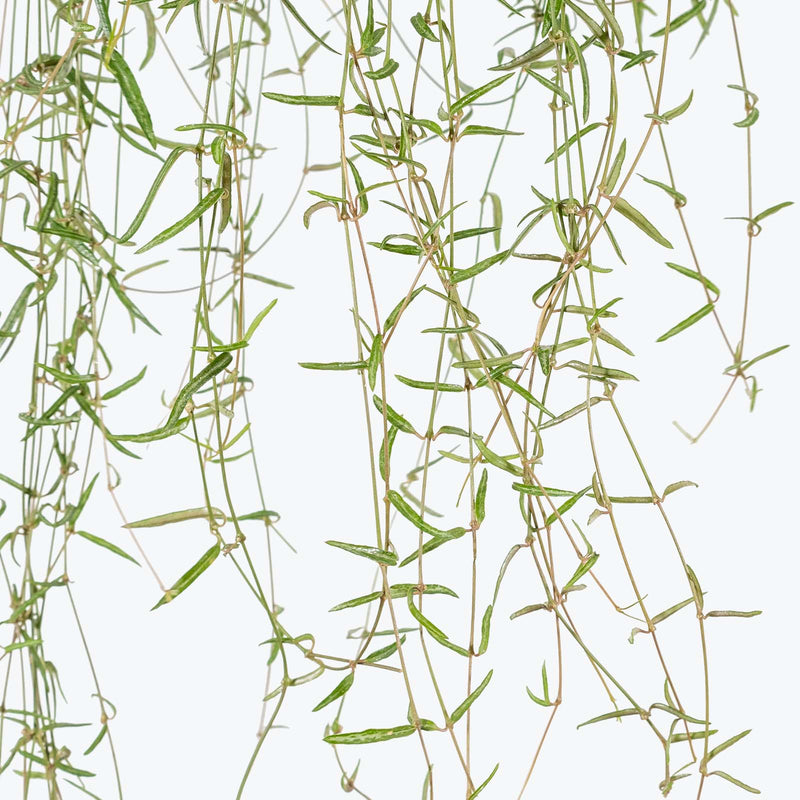
How to care for String of Needles
They should not be in a position to see the sun directly, although early morning or late evening sun is fine. Filtered sunlight through a sheer curtain is best and most homes are comprised primarily of indirect sunlight. The best spot for them is where they do not see the sun during the majority of the day but still get bright, indirect light.
They will do best in bright light. A nice bright place inside your home would be on the window sill or a stool that is right next to a window, either with or without blinds, depending on if the plant can handle sun. Remember that plants will grow based on how much light they receive.
They like the soil to be completely dry before the next watering. This can take up to 4 weeks in an average home environment but it will vary depending on the time of year, your environment and lighting conditions. For them, it's always safer to underwater or water when you see signs of lack of water (i.e. wrinkly or soft leaves). Water a little more often in the warmer months.
Their humidity requirement is low, so do not mist them or put them in a terrarium.
If the gaps between the leaves on the stems are wide, this is often an indicator that the plant is receiving lower light. If you want the growth to more dense, where the leaves are closer together, move your plant to a spot where it will receive brighter light.
You can feel comfortable having this plant around your home in the potential case where your pet feels like nibbling on it. However, we typically recommend keeping your pets from eating any of your houseplants..
View PlantString of Nickels
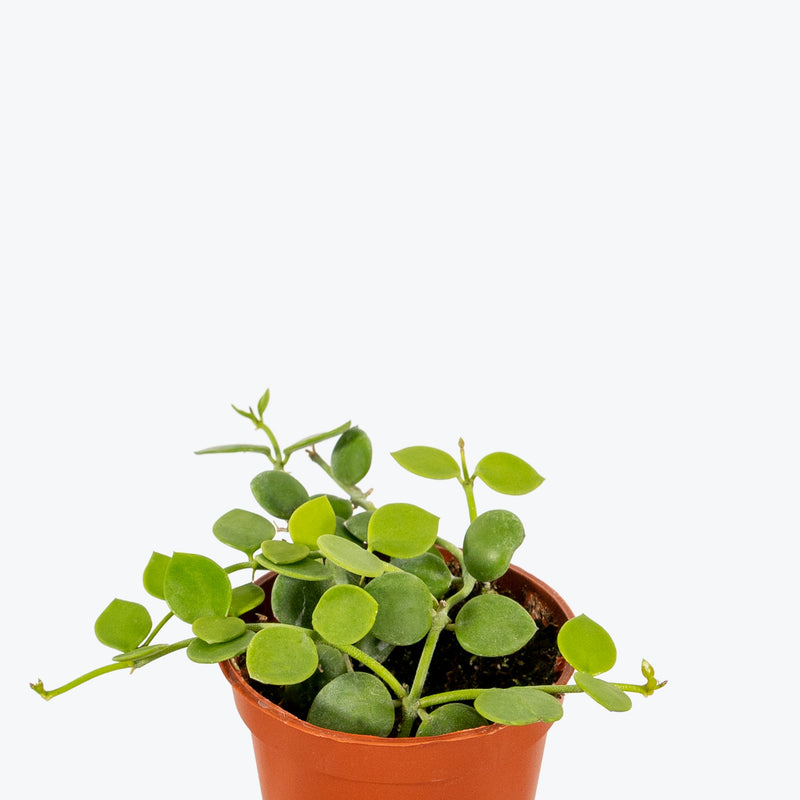
How to care for String of Nickels
They should not be in a position to see the sun directly, although early morning or late evening sun is fine. Filtered sunlight through a sheer curtain is best and most homes are comprised primarily of indirect sunlight. The best spot for them is where they do not see the sun during the majority of the day but still get bright, indirect light.
They will thrive in bright light, but also can tolerate medium light. A good medium-light place in your home would be in the middle of a room that has a regular size window. They can be placed anywhere between the middle of the room and the window. Remember that plants will grow based on how much light they receive.
They like the soil to be relatively dry before the next watering. That usually takes about 2 weeks in an average home environment. It will vary depending on the time of year, your environment and lighting conditions, but for them, it's always safer to underwater or water when you see signs of lack of water (i.e. droopy, floppy, or soft leaves). Expect to water more often in brighter light and less often in lower light.
They will do well in average humidity environments but will appreciate a little bit of humidity if provided, give them a mist daily or get a humidifier.
They are fairly drought tolerant, so don't be too alarmed if you forget to water now and then. They also have a relatively shallow root system, which means that frequent repottings are not necessary at all. To encourage a fuller plant, lay some trailing stems on the soil, lightly pressing the leaf nodes into the soil so that they are making contact but not completely buried, this is where new roots and growth will form if the plant is kept in bright light!
This plant is moderately toxic and can cause some adverse reactions when ingested so it is best to not let your pets eat it, which we advise for all plants in general. The severity of the reaction will depend on how much of the plant is ingested but, if you know your pet typically does not eat your plants, this plant will be suitable for your home..
View PlantString of Pearls
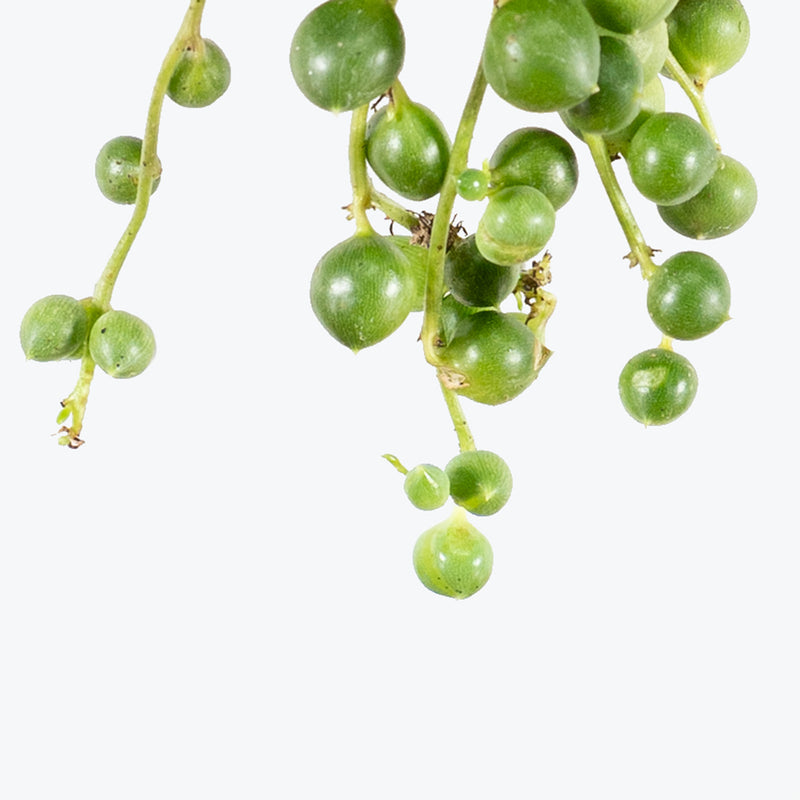
How to care for String of Pearls
String of Pearls enjoys some direct sun, but they'll also do well in bright, indirect light. It is best to place this plant somewhere where it will receive some nice morning sun, or a couple hours of afternoon sun, and then indirect light the rest of the day.
String of Pearls will do best in bright light. A nice bright place inside your home would be on the window sill or a stool that is right next to a window, either with or without blinds, depending on if the plant can handle sun. Remember that plants will grow based on how much light they receive.
String of Pearls likes the soil to be completely dry before the next watering. This can take up to 4 weeks in an average home environment but it will vary depending on the time of year, your environment and lighting conditions. For them, it's always safer to underwater or water when you see signs of lack of water (i.e. wrinkly or soft leaves). Water a little more often in the warmer months.
Their humidity requirement is low, so do not mist String of Pearls or put them in an enclosed terrarium.
String of Pearls benefits from being slightly pot-bound, so only repot every few years or when absolutely necessary. Handle the plant gently as the pearls can easily detach from the stem. To encourage fullness on top of the pot, lay the some trailing stems on the soil so that they are touching the soil and they will grow roots (as long as they are getting bright light directly on top of the soil).
String of Pearls is moderately toxic and can cause some adverse reactions when ingested so it is best to not let your pets eat it, which we advise for all plants in general. The severity of the reaction will depend on how much of the plant is ingested but, if you know your pet typically does not eat your plants, this plant will be suitable for your home..
View PlantString of Pearls Variegata
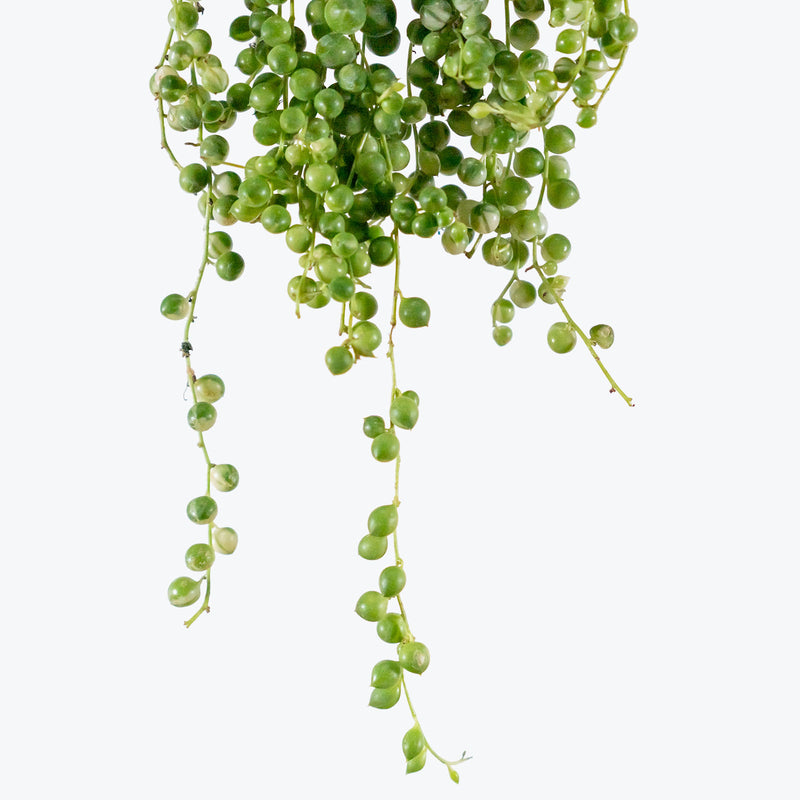
How to care for String of Pearls Variegata
String of Pearls Variegata enjoys some direct sun, but they'll also do well in bright, indirect light. It is best to place this plant somewhere where it will receive some nice morning sun, or a couple hours of afternoon sun, and then indirect light the rest of the day.
String of Pearls Variegata will do best in bright light. A nice bright place inside your home would be on the window sill or a stool that is right next to a window, either with or without blinds, depending on if the plant can handle sun. Remember that plants will grow based on how much light they receive.
String of Pearls Variegata likes the soil to be completely dry before the next watering. This can take up to 4 weeks in an average home environment but it will vary depending on the time of year, your environment and lighting conditions. For them, it's always safer to underwater or water when you see signs of lack of water (i.e. wrinkly or soft leaves). Water a little more often in the warmer months.
Their humidity requirement is low, so do not mist String of Pearls Variegata or put them in an enclosed terrarium.
String of Pearls Variegata can be sensitive to chemicals in tap water; if possible, use rainwater or distilled water for watering. Be gentle when handling as the pearls are delicate and can detach easily. To encourage fullness on top of the pot, lay the some trailing stems on the soil so that they are touching the soil and they will grow roots (as long as they are getting bright light directly on top of the soil). This variety will need slightly brighter light, compared to the original String of Pearls, in order to support the variegation.
String of Pearls Variegata is moderately toxic and can cause some adverse reactions when ingested so it is best to not let your pets eat it, which we advise for all plants in general. The severity of the reaction will depend on how much of the plant is ingested but, if you know your pet typically does not eat your plants, this plant will be suitable for your home..
View PlantString of Pickles
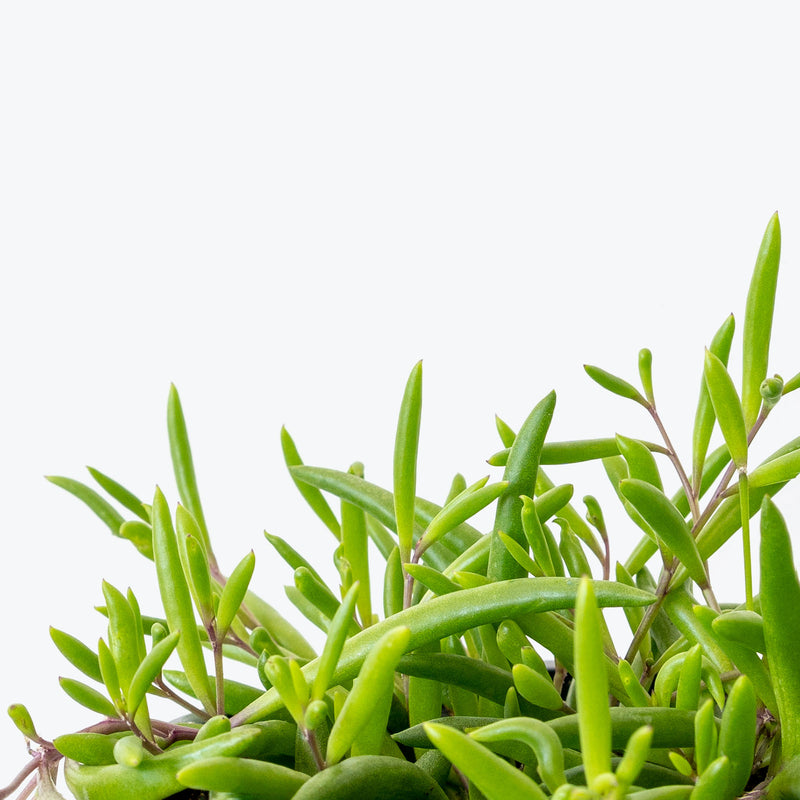
How to care for String of Pickles
They enjoy some direct sun, but they'll also do well in bright, indirect light. It is best to place this plant somewhere where it will receive some nice morning sun, or a couple hours of afternoon sun, and then indirect light the rest of the day.
They will do best in bright light. A nice bright place inside your home would be on the window sill or a stool that is right next to a window, either with or without blinds, depending on if the plant can handle sun. Remember that plants will grow based on how much light they receive.
They like the soil to be completely dry before the next watering. This can take up to 4 weeks in an average home environment but it will vary depending on the time of year, your environment and lighting conditions. For them, it's always safer to underwater or water when you see signs of lack of water (i.e. wrinkly or soft leaves). Water a little more often in the warmer months.
Their humidity requirement is low, so do not mist them or put them in a terrarium.
To encourage fullness on top of the pot, lay the some trailing stems on the soil so that they are touching the soil and they will grow roots (as long as they are getting bright light directly on top of the soil).
This plant is moderately toxic and can cause some adverse reactions when ingested so it is best to not let your pets eat it, which we advise for all plants in general. The severity of the reaction will depend on how much of the plant is ingested but, if you know your pet typically does not eat your plants, this plant will be suitable for your home..
View PlantString of Spades
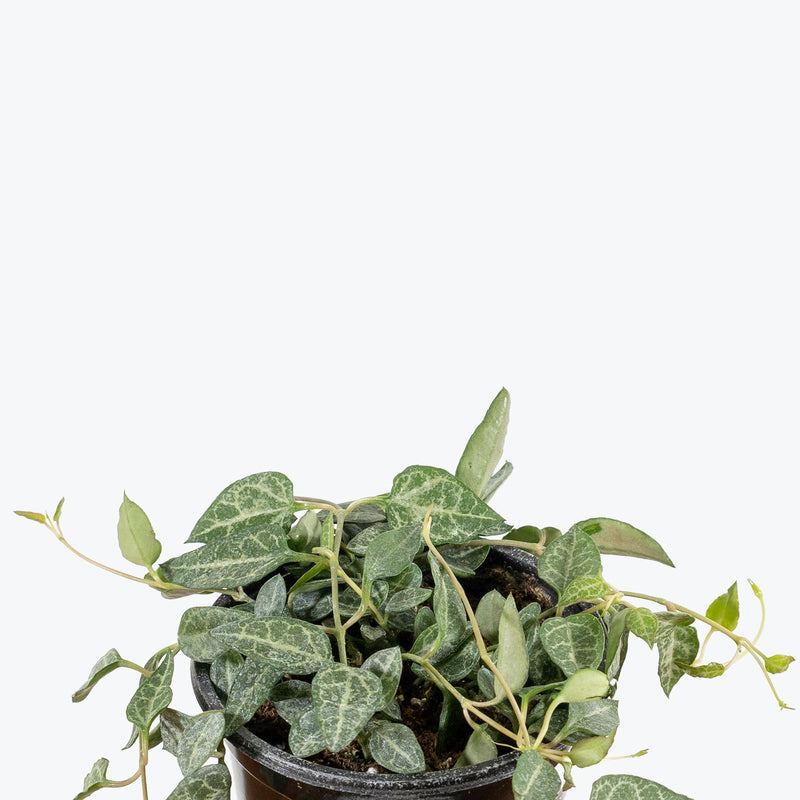
How to care for String of Spades
String of Spades should not be in a position to see the sun directly, although early morning or late evening sun is fine. Filtered sunlight through a sheer curtain is best and most homes are comprised primarily of indirect sunlight. The best spot for them is where they do not see the sun during the majority of the day but still get bright, indirect light.
String of Spades will do best in bright light. A nice bright place inside your home would be on the window sill or a stool that is right next to a window, either with or without blinds, depending on if the plant can handle sun. Remember that plants will grow based on how much light they receive.
String of Spades likes the soil to be completely dry before the next watering. This can take up to 4 weeks in an average home environment but it will vary depending on the time of year, your environment and lighting conditions. For them, it's always safer to underwater or water when you see signs of lack of water (i.e. wrinkly or soft leaves). Water a little more often in the warmer months.
Their humidity requirement is low, so do not mist String of Spades or put them in a terrarium.
If there is less marbling on the leaves, and the gaps between the leaves on the stems are wide, this is often an indicator that the plant is receiving lower light. If you want the growth to be more dense, where the leaves are closer together, move your plant to a spot where it will receive brighter light. String of Spades store water in their leaves, so a good indicator to watch for is the leaves beginning to soften and look a little wilted and deflated.
You can feel comfortable having String of Spades around your home in the potential case where your pet feels like nibbling on it. However, we typically recommend keeping your pets from eating any of your houseplants..
View PlantString of Spades Variegated
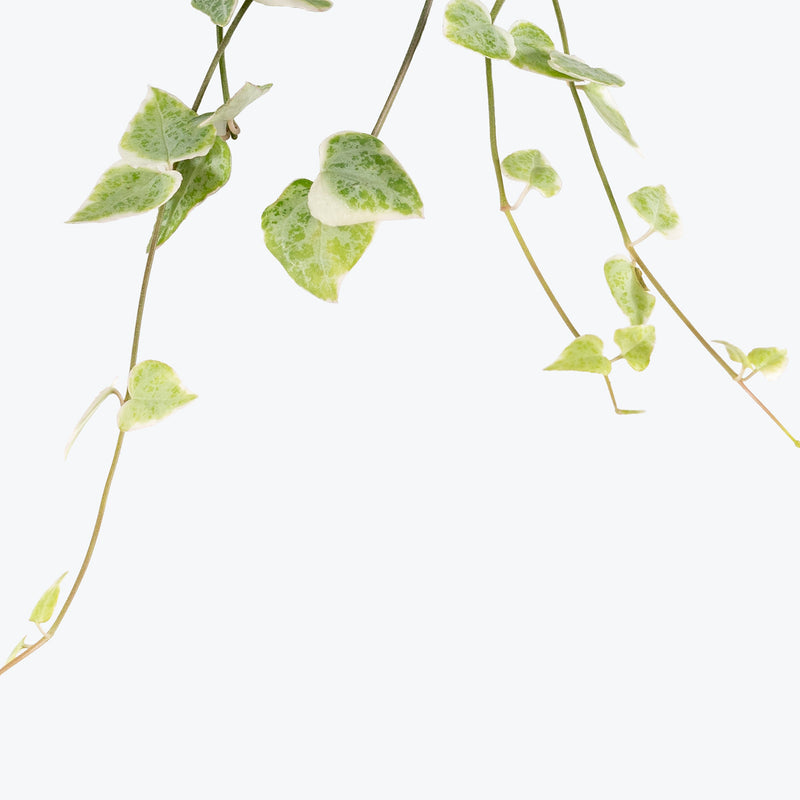
How to care for String of Spades Variegated
String of Spades Variegated should not be in a position to see the sun directly, although early morning or late evening sun is fine. Filtered sunlight through a sheer curtain is best and most homes are comprised primarily of indirect sunlight. The best spot for them is where they do not see the sun during the majority of the day but still get bright, indirect light.
String of Spades Variegated will do best in bright light. A nice bright place inside your home would be on the window sill or a stool that is right next to a window, either with or without blinds, depending on if the plant can handle sun. Remember that plants will grow based on how much light they receive.
String of Spades Variegated likes the soil to be completely dry before the next watering. This can take up to 4 weeks in an average home environment but it will vary depending on the time of year, your environment and lighting conditions. For them, it's always safer to underwater or water when you see signs of lack of water (i.e. wrinkly or soft leaves). Water a little more often in the warmer months.
Their humidity requirement is low, so do not mist String of Spades Variegated or put them in a terrarium.
String of Spades Variegated store water in their leaves, so a good indicator to watch for is the leaves beginning to soften and look a little wilted and deflated. If there is less marbling on the leaves, and the gaps between the leaves on the stems are wide, this is often an indicator that the plant is receiving lower light. If you want the growth to be more dense, where the leaves are closer together, move your plant to a spot where it will receive brighter light.
You can feel comfortable having String of Spades Variegated around your home in the potential case where your pet feels like nibbling on it. However, we typically recommend keeping your pets from eating any of your houseplants..
View PlantString of Turtles
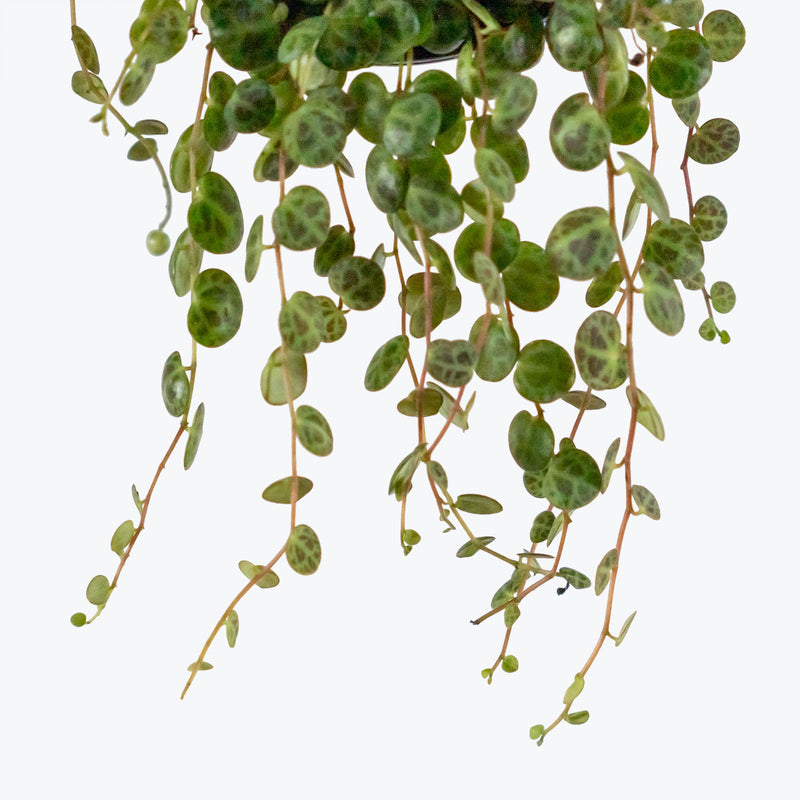
How to care for String of Turtles
String of Turtles should not be in a position to see the sun directly, although early morning or late evening sun is fine. Filtered sunlight through a sheer curtain is best and most homes are comprised primarily of indirect sunlight. The best spot for them is where they do not see the sun during the majority of the day but still get bright, indirect light.
String of Turtles will do best in bright light. A nice bright place inside your home would be on the window sill or a stool that is right next to a window, either with or without blinds, depending on if the plant can handle sun. Remember that plants will grow based on how much light they receive.
String of Turtles needs to be watered when the top half of the soil is dry to the touch. That usually takes about 1 week in an average home environment. It will vary depending on the time of year, your environment and lighting conditions, but it's always safer to underwater or give the soil a check before you water again. Expect to water more often in brighter light and less often in lower light.
String of Turtles humidity requirement is low, so do not mist them or put them in a terrarium.
Succulent leaves make String of Turtles especially sensitive to soggy soil, so avoid overwatering. Use a loose, well-draining mix.
You can feel comfortable having String of Turtles around your home in the potential case where your pet feels like nibbling on it. However, we typically recommend keeping your pets from eating any of your houseplants..
View PlantStromanthe Magic Star
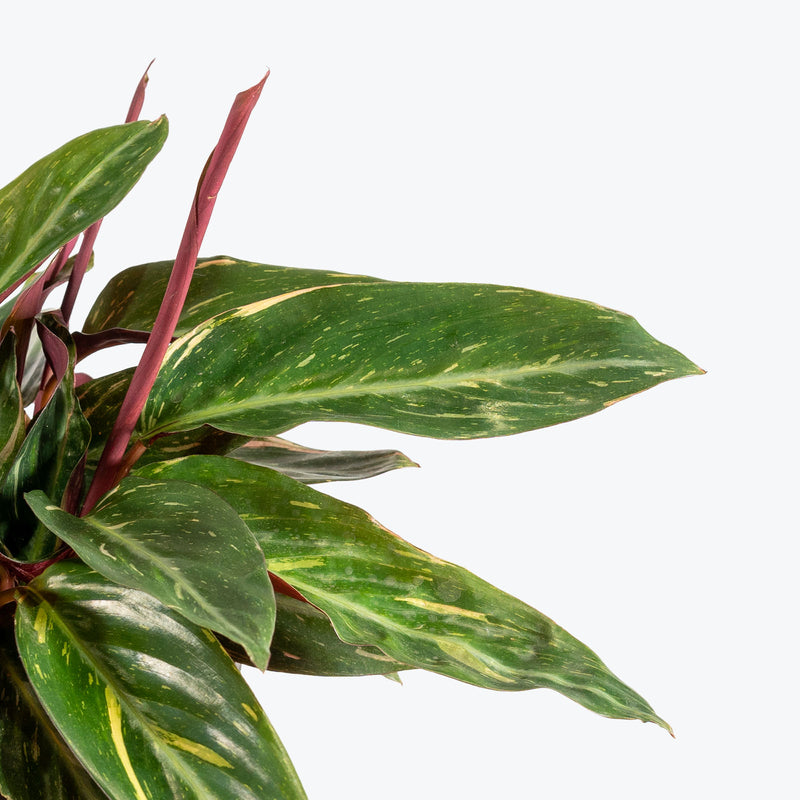
How to care for Stromanthe Magic Star
They should not be in a position to see the sun directly, although early morning or late evening sun is fine. Filtered sunlight through a sheer curtain is best and most homes are comprised primarily of indirect sunlight. The best spot for them is where they do not see the sun during the majority of the day but still get bright, indirect light.
They will do well in medium light but will grow faster with brighter light. A good medium-light place in your home would be in the middle of a room that has a regular size window. Remember that plants will grow based on how much light they receive.
They need to be watered when the top half of the soil is dry to the touch. That usually takes about 1 week in an average home environment. It will vary depending on the time of year, your environment and lighting conditions, but it's always safer to underwater or give the soil a check before you water again. Expect to water more often in brighter light and less often in lower light.
They like a high humidity environment, give them a mist daily or as often as possible. Alternatively, you can put them around a humidifier. Although they won't die if they don't receive enough humidity, their leaves may have some dry, crunchy, or yellow edges.
The more indirect light the plant receives, the more variegation you will see on the leaves. Never expose it to prolonged direct sunlight, as you will see burn spots on the leaves, but a couple of hours of morning sun or late afternoon sun will be just fine. The leaves will turn brown and crispy when the air is too dry.
You can feel comfortable having this plant around your home in the potential case where your pet feels like nibbling on it. However, we typically recommend keeping your pets from eating any of your houseplants..
View PlantStromanthe Sanguinea
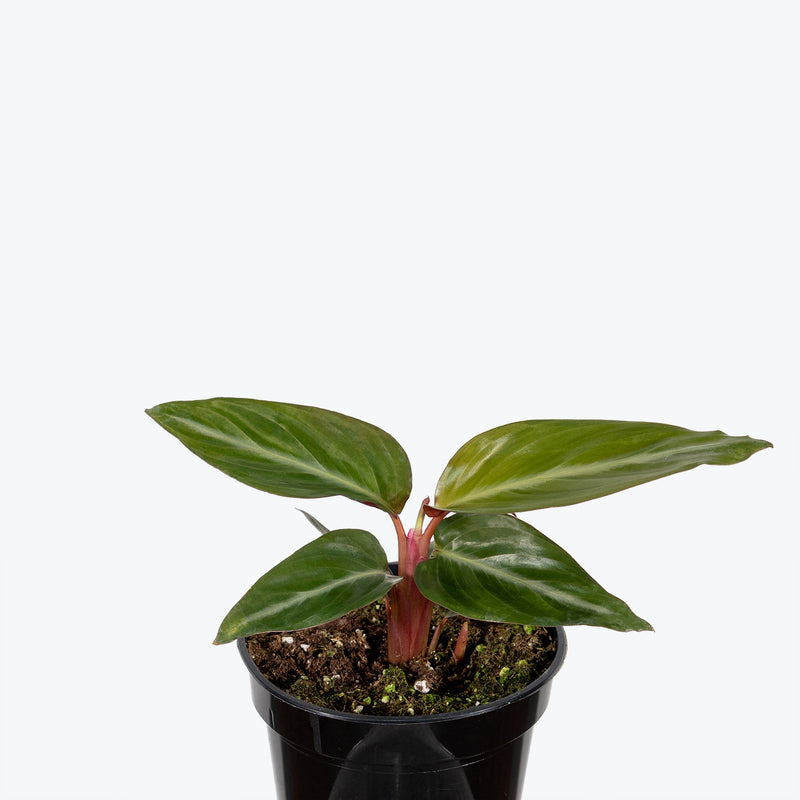
How to care for Stromanthe Sanguinea
They should not be in a position to see the sun directly, although early morning or late evening sun is fine. Filtered sunlight through a sheer curtain is best and most homes are comprised primarily of indirect sunlight. The best spot for them is where they do not see the sun during the majority of the day but still get bright, indirect light.
They will do well in medium light but will grow faster with brighter light. A good medium-light place in your home would be in the middle of a room that has a regular size window. Remember that plants will grow based on how much light they receive.
They need to be watered when the top half of the soil is dry to the touch. That usually takes about 1 week in an average home environment. It will vary depending on the time of year, your environment and lighting conditions, but it's always safer to underwater or give the soil a check before you water again. Expect to water more often in brighter light and less often in lower light.
They like a high humidity environment, give them a mist daily or as often as possible. Alternatively, you can put them around a humidifier. Although they won't die if they don't receive enough humidity, their leaves may have some dry, crunchy, or yellow edges.
The more indirect light the plant receives, the more variegation you will see on the leaves. Never expose it to prolonged direct sunlight, as you will see burn spots on the leaves, but a couple of hours of morning sun or late afternoon sun will be just fine. The leaves will turn brown and crispy when the air is too dry.
You can feel comfortable having this plant around your home in the potential case where your pet feels like nibbling on it. However, we typically recommend keeping your pets from eating any of your houseplants..
View PlantStromanthe Triostar
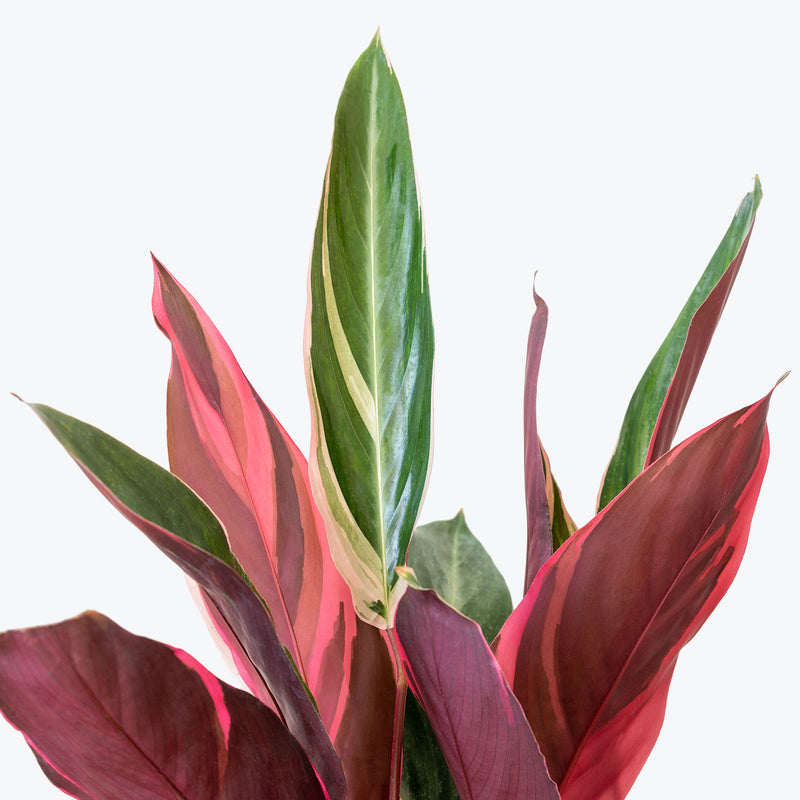
How to care for Stromanthe Triostar
Stromanthe Triostar should not be in a position to see the sun directly, although early morning or late evening sun is fine. Filtered sunlight through a sheer curtain is best and most homes are comprised primarily of indirect sunlight. The best spot for them is where they do not see the sun during the majority of the day but still get bright, indirect light.
Stromanthe Triostar will do well in medium light but will grow faster with brighter light. A good medium-light place in your home would be in the middle of a room that has a regular size window. Remember that plants will grow based on how much light they receive.
Stromanthe Triostar needs to be watered when the top half of the soil is dry to the touch. That usually takes about 1 week in an average home environment. It will vary depending on the time of year, your environment and lighting conditions, but it's always safer to underwater or give the soil a check before you water again. Expect to water more often in brighter light and less often in lower light.
Stromanthe Triostar likes a high humidity environment, give them a mist daily or as often as possible. Alternatively, you can put them around a humidifier. Although they won't die if they don't receive enough humidity, their leaves may have some dry, crunchy, or yellow edges.
The more indirect light the Stromanthe Triostar receives, the more variegation you will see on the leaves. Never expose it to prolonged direct sunlight, as you will see burn spots on the leaves, but a couple of hours of morning sun or late afternoon sun will be just fine. The leaves will turn brown and crispy when the air is too dry.
You can feel comfortable having Stromanthe Triostar plant around your home in the potential case where your pet feels like nibbling on it. However, we typically recommend keeping your pets from eating any of your houseplants..
View PlantSyngonium Albo Variegatum
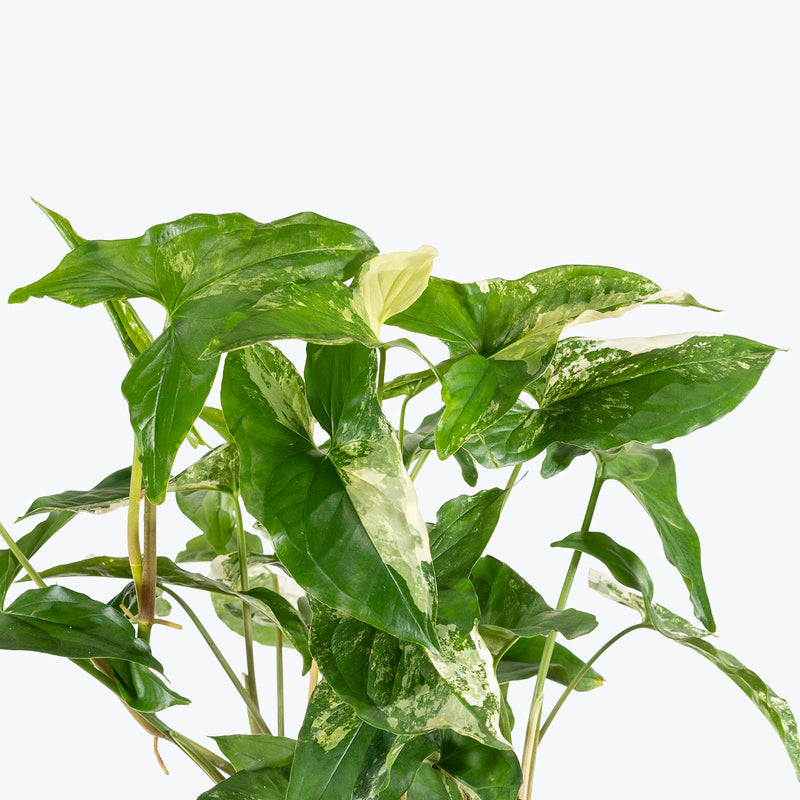
How to care for Syngonium Albo Variegatum
They should not be in a position to see the sun directly, although early morning or late evening sun is fine. Filtered sunlight through a sheer curtain is best and most homes are comprised primarily of indirect sunlight. The best spot for them is where they do not see the sun during the majority of the day but still get bright, indirect light.
They will thrive in bright light, but also can tolerate medium light. A good medium-light place in your home would be in the middle of a room that has a regular size window. They can be placed anywhere between the middle of the room and the window. Remember that plants will grow based on how much light they receive.
They need to be watered when the top half of the soil is dry to the touch. That usually takes about 1 week in an average home environment. It will vary depending on the time of year, your environment and lighting conditions, but it's always safer to underwater or give the soil a check before you water again. Expect to water more often in brighter light and less often in lower light.
They will do well in average humidity environments but will appreciate a little bit of humidity if provided, give them a mist daily or get a humidifier.
Maintain a stable environment and avoid sudden temperature changes. Pruning older leaves will encourage a bushier growth habit. If you notice the variegation fading, it might be an indication that the plant needs more light.
This plant is moderately toxic and can cause some adverse reactions when ingested so it is best to not let your pets eat it, which we advise for all plants in general. The severity of the reaction will depend on how much of the plant is ingested but, if you know your pet typically does not eat your plants, this plant will be suitable for your home..
Learn MoreView PlantSyngonium Batik
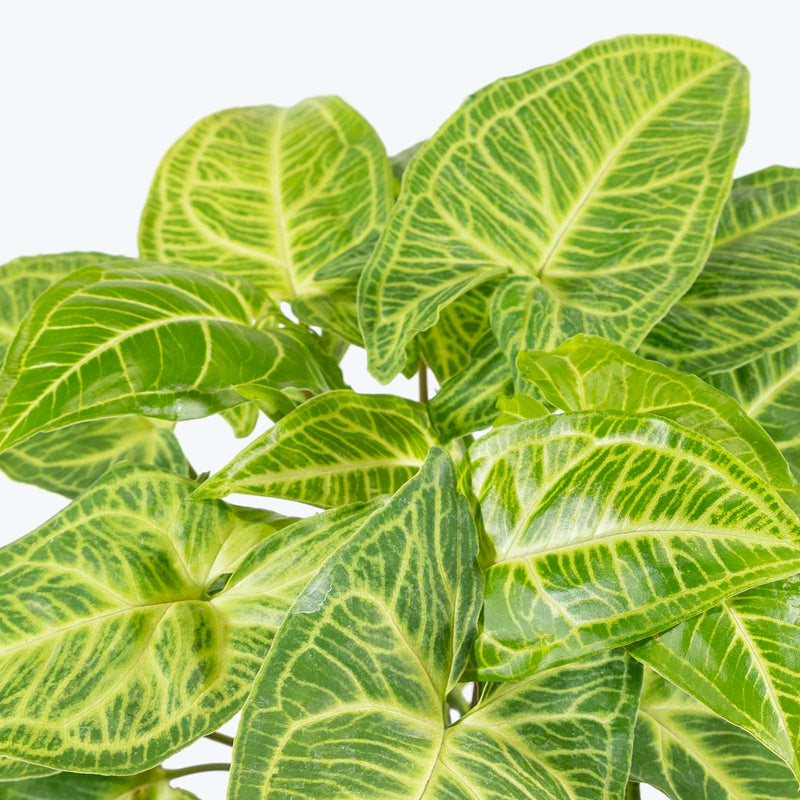
How to care for Syngonium Batik
Syngonium Batik should not be in a position to see the sun directly, although early morning or late evening sun is fine. Filtered sunlight through a sheer curtain is best and most homes are comprised primarily of indirect sunlight. The best spot for them is where they do not see the sun during the majority of the day but still get bright, indirect light.
Syngonium Batik will thrive in medium to bright light, but also can tolerate low light. A good medium-light place in your home would be in the middle of a room that has a regular size window. They can be placed almost anywhere in the room but remember, plants will grow based on how much light they receive.
Syngonium Batik needs to be watered when the top half of the soil is dry to the touch. That usually takes about 1 week in an average home environment. It will vary depending on the time of year, your environment and lighting conditions, but it's always safer to under water or give the soil a check before you water again. Expect to water more often in brighter light and less often in lower light.
Syngonium Batik can live in any average home humidity condition and is fairly hardy.
Syngonium Batik is an aggressive, rapid-growing vine, so the frequency of repotting depends somewhat on how big you want the vine to get. Repot yearly for a larger vine. Otherwise, refresh potting media every spring and repot every other year.
Syngonium Batik is moderately toxic and can cause some adverse reactions when ingested so it is best to not let your pets eat it, which we advise for all plants in general. The severity of the reaction will depend on how much of the plant is ingested but, if you know your pet typically does not eat your plants, this plant will be suitable for your home..
Learn MoreView PlantSyngonium Confetti Tricolor
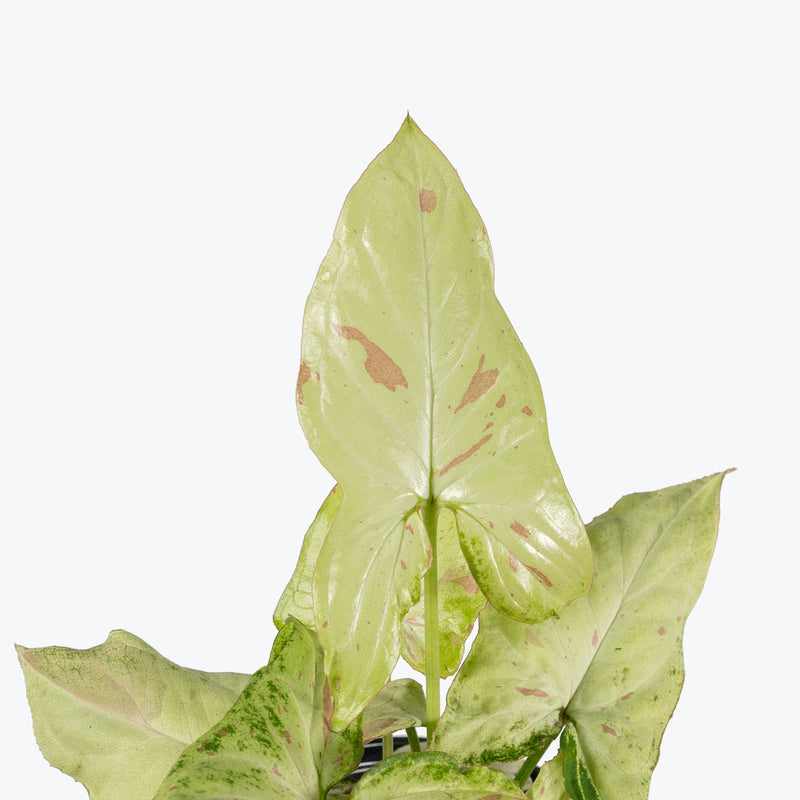
How to care for Syngonium Confetti Tricolor
Syngonium Confetti Tricolor should not be in a position to see the sun directly, although early morning or late evening sun is fine. Filtered sunlight through a sheer curtain is best and most homes are comprised primarily of indirect sunlight. The best spot for them is where they do not see the sun during the majority of the day but still get bright, indirect light.
Syngonium Confetti Tricolor will thrive in medium to bright light, but also can tolerate low light. A good medium-light place in your home would be in the middle of a room that has a regular size window. They can be placed almost anywhere in the room but remember, plants will grow based on how much light they receive.
Syngonium Confetti Tricolor needs to be watered when the top half of the soil is dry to the touch. That usually takes about 1 week in an average home environment. It will vary depending on the time of year, your environment and lighting conditions, but it's always safer to underwater or give the soil a check before you water again. Expect to water more often in brighter light and less often in lower light.
Syngonium Confetti Tricolor can live in any average home humidity condition and are fairly hardy.
Syngonium Confetti Tricolor is an aggressive, rapid-growing vine, so the frequency of repotting depends somewhat on how big you want the vine to get. Repot yearly for a larger vine. Otherwise, refresh potting media every spring and repot every other year.
Syngonium Confetti Tricolor is moderately toxic and can cause some adverse reactions when ingested so it is best to not let your pets eat it, which we advise for all plants in general. The severity of the reaction will depend on how much of the plant is ingested but, if you know your pet typically does not eat your plants, this plant will be suitable for your home..
Learn MoreView PlantSyngonium Cream Allusion
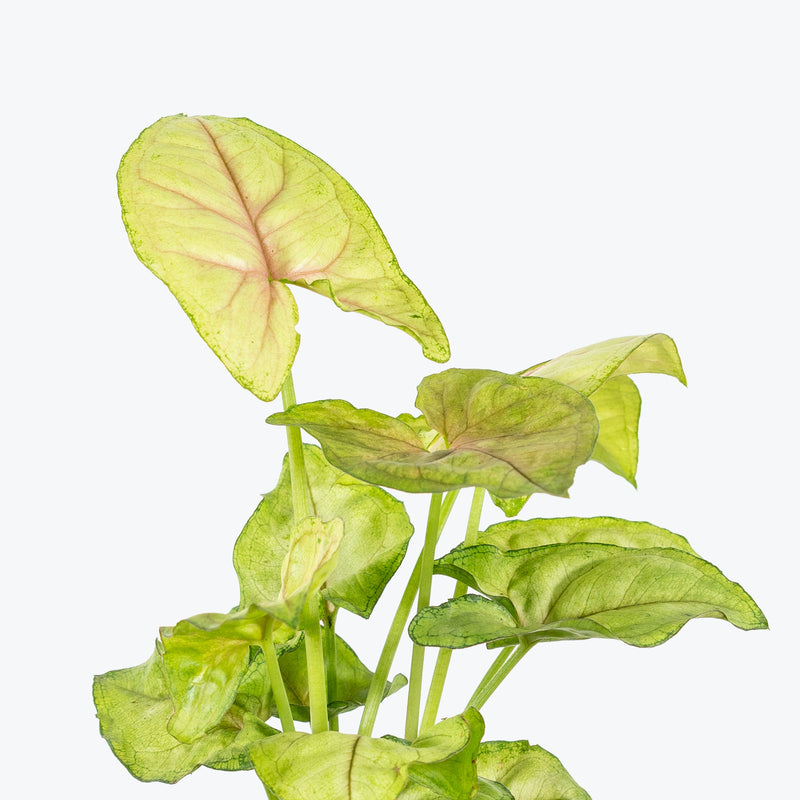
How to care for Syngonium Cream Allusion
They should not be in a position to see the sun directly, although early morning or late evening sun is fine. Filtered sunlight through a sheer curtain is best and most homes are comprised primarily of indirect sunlight. The best spot for them is where they do not see the sun during the majority of the day but still get bright, indirect light.
They will thrive in medium to bright light, but also can tolerate low light. A good medium-light place in your home would be in the middle of a room that has a regular size window. They can be placed almost anywhere in the room but remember, plants will grow based on how much light they receive.
They need to be watered when the top half of the soil is dry to the touch. That usually takes about 1 week in an average home environment. It will vary depending on the time of year, your environment and lighting conditions, but it's always safer to underwater or give the soil a check before you water again. Expect to water more often in brighter light and less often in lower light.
They can live in any average home humidity condition and are fairly hardy.
Syngonium is an aggressive, rapid-growing vine, so the frequency of repotting depends somewhat on how big you want the vine to get. Repot yearly for a larger vine. Otherwise, refresh potting media every spring and repot every other year.
This plant is moderately toxic and can cause some adverse reactions when ingested so it is best to not let your pets eat it, which we advise for all plants in general. The severity of the reaction will depend on how much of the plant is ingested but, if you know your pet typically does not eat your plants, this plant will be suitable for your home..
Learn MoreView PlantSyngonium Glo Go
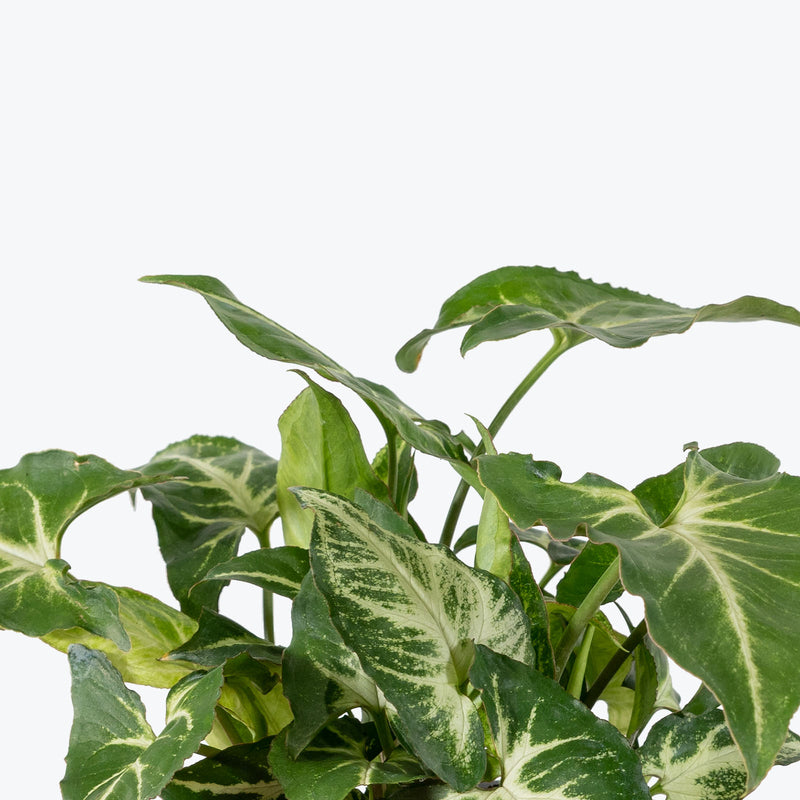
How to care for Syngonium Glo Go
They should not be in a position to see the sun directly, although early morning or late evening sun is fine. Filtered sunlight through a sheer curtain is best and most homes are comprised primarily of indirect sunlight. The best spot for them is where they do not see the sun during the majority of the day but still get bright, indirect light.
They will thrive in medium to bright light, but also can tolerate low light. A good medium-light place in your home would be in the middle of a room that has a regular size window. They can be placed almost anywhere in the room but remember, plants will grow based on how much light they receive.
They need to be watered when the top half of the soil is dry to the touch. That usually takes about 1 week in an average home environment. It will vary depending on the time of year, your environment and lighting conditions, but it's always safer to underwater or give the soil a check before you water again. Expect to water more often in brighter light and less often in lower light.
They can live in any average home humidity condition and are fairly hardy.
Syngonium is an aggressive, rapid-growing vine, so the frequency of repotting depends somewhat on how big you want the vine to get. Repot yearly for a larger vine. Otherwise, refresh potting media every spring and repot every other year.
This plant is moderately toxic and can cause some adverse reactions when ingested so it is best to not let your pets eat it, which we advise for all plants in general. The severity of the reaction will depend on how much of the plant is ingested but, if you know your pet typically does not eat your plants, this plant will be suitable for your home..
Learn MoreView PlantSyngonium Godzilla
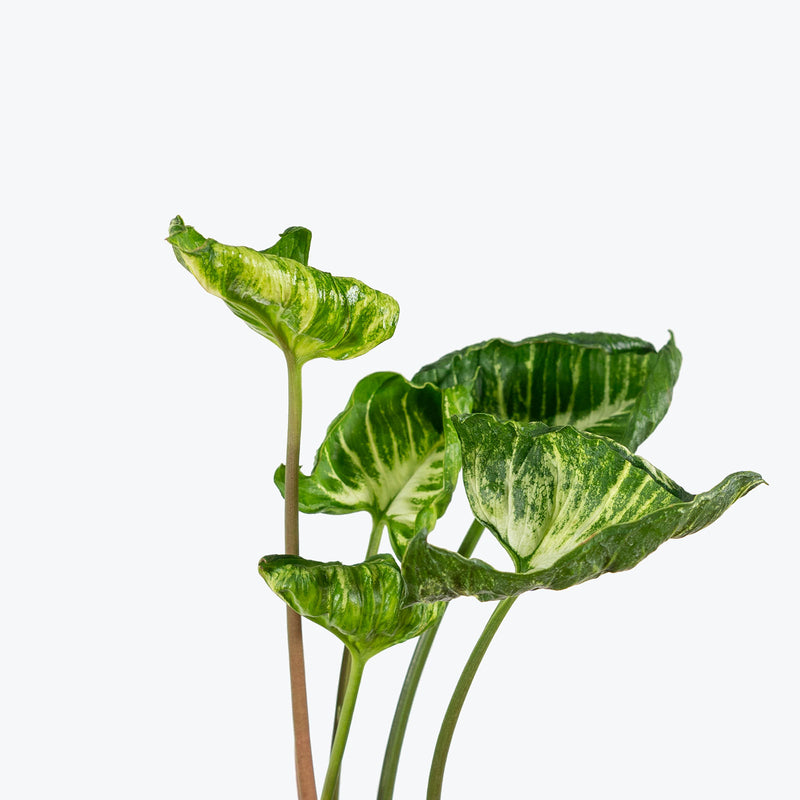
How to care for Syngonium Godzilla
Syngonium Godzilla should not be in a position to see the sun directly, although early morning or late evening sun is fine. Filtered sunlight through a sheer curtain is best and most homes are comprised primarily of indirect sunlight. The best spot for them is where they do not see the sun during the majority of the day but still get bright, indirect light.
Syngonium Godzilla will thrive in bright light, but also can tolerate medium light. A good medium-light place in your home would be in the middle of a room that has a regular size window. They can be placed anywhere between the middle of the room and the window. Remember that plants will grow based on how much light they receive.
Syngonium Godzilla needs to be watered when the top half of the soil is dry to the touch. That usually takes about 1 week in an average home environment. It will vary depending on the time of year, your environment and lighting conditions, but it's always safer to underwater or give the soil a check before you water again. Expect to water more often in brighter light and less often in lower light.
Syngonium Godzilla will do well in average humidity environments but will appreciate a little bit of humidity if provided, give them a mist daily or get a humidifier.
Fertilize your Syngonium Godzilla every month during the growing season with a diluted, balanced liquid fertilizer. Reduce feeding in the winter months. Regular pruning can help maintain a bushy appearance and encourage fuller growth. If you prefer a more compact plant, pinch back the new growth regularly.
Syngonium Godzilla is moderately toxic and can cause some adverse reactions when ingested so it is best to not let your pets eat it, which we advise for all plants in general. The severity of the reaction will depend on how much of the plant is ingested but, if you know your pet typically does not eat your plants, this plant will be suitable for your home..
Learn MoreView PlantSyngonium Green Fantasy
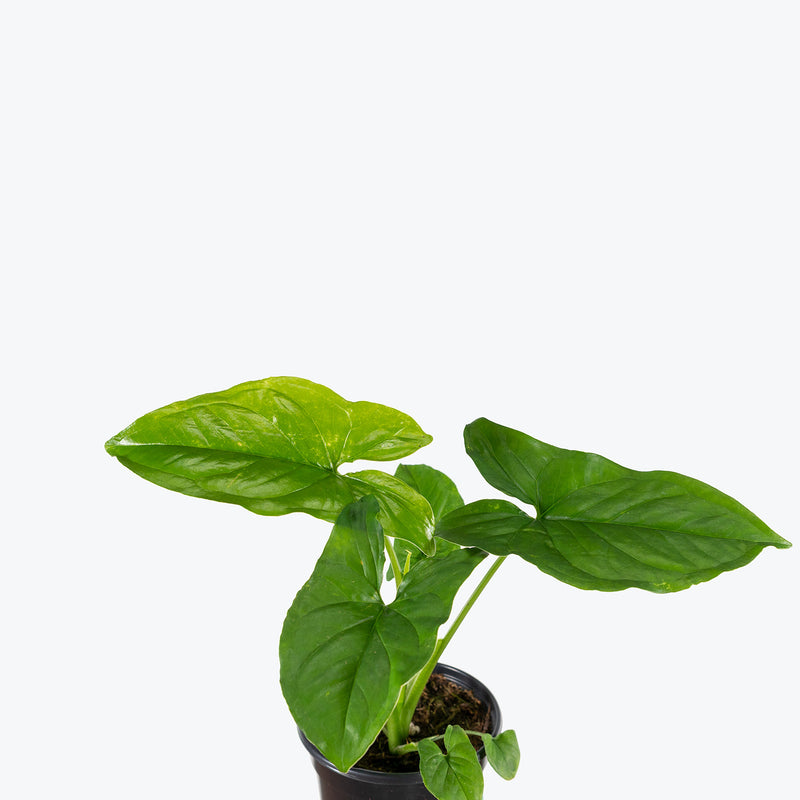
How to care for Syngonium Green Fantasy
Syngonium Green Fantasy should not be in a position to see the sun directly, although early morning or late evening sun is fine. Filtered sunlight through a sheer curtain is best and most homes are comprised primarily of indirect sunlight. The best spot for them is where they do not see the sun during the majority of the day but still get bright, indirect light.
Syngonium Green Fantasy will do well in medium light but will grow faster with brighter light. A good medium-light place in your home would be in the middle of a room that has a regular size window. Remember that plants will grow based on how much light they receive.
Syngonium Green Fantasy needs to be watered when the top half of the soil is dry to the touch. That usually takes about 1 week in an average home environment. It will vary depending on the time of year, your environment and lighting conditions, but it's always safer to underwater or give the soil a check before you water again. Expect to water more often in brighter light and less often in lower light.
Syngonium Green Fantasy can live in any average home humidity condition and are fairly hardy.
Fertilize Syngonium Green Fantasy every 4-6 weeks during the growing season with a balanced, water-soluble fertilizer diluted to half strength. During the winter, reduce fertilization as the plant's growth slows. Regular pruning can help maintain a bushier appearance and prevent legginess. Provide a trellis or support for climbing if desired, or let it trail naturally from a hanging planter.
Syngonium Green Fantasy is moderately toxic and can cause some adverse reactions when ingested so it is best to not let your pets eat it, which we advise for all plants in general. The severity of the reaction will depend on how much of the plant is ingested but, if you know your pet typically does not eat your plants, this plant will be suitable for your home..
Learn MoreView PlantSyngonium Green Star
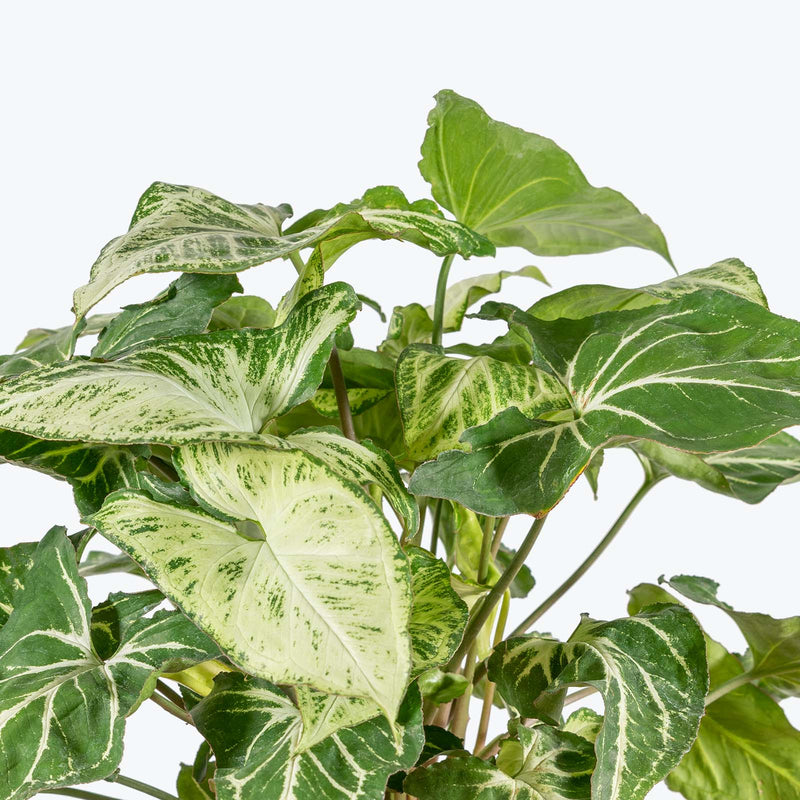
How to care for Syngonium Green Star
They should not be in a position to see the sun directly, although early morning or late evening sun is fine. Filtered sunlight through a sheer curtain is best and most homes are comprised primarily of indirect sunlight. The best spot for them is where they do not see the sun during the majority of the day but still get bright, indirect light.
They will thrive in medium to bright light, but also can tolerate low light. A good medium-light place in your home would be in the middle of a room that has a regular size window. They can be placed almost anywhere in the room but remember, plants will grow based on how much light they receive.
They need to be watered when the top half of the soil is dry to the touch. That usually takes about 1 week in an average home environment. It will vary depending on the time of year, your environment and lighting conditions, but it's always safer to underwater or give the soil a check before you water again. Expect to water more often in brighter light and less often in lower light.
They can live in any average home humidity condition and are fairly hardy.
Syngonium is an aggressive, rapid-growing vine, so the frequency of repotting depends somewhat on how big you want the vine to get. Repot yearly for a larger vine. Otherwise, refresh potting media every spring and repot every other year. Keep in mind that colouring will change based on the light levels so keep your plant in bright, indirect light if you wish to promote strong colouring as well as the healthiest growth.
This plant is moderately toxic and can cause some adverse reactions when ingested so it is best to not let your pets eat it, which we advise for all plants in general. The severity of the reaction will depend on how much of the plant is ingested but, if you know your pet typically does not eat your plants, this plant will be suitable for your home..
Learn MoreView PlantSyngonium Holly
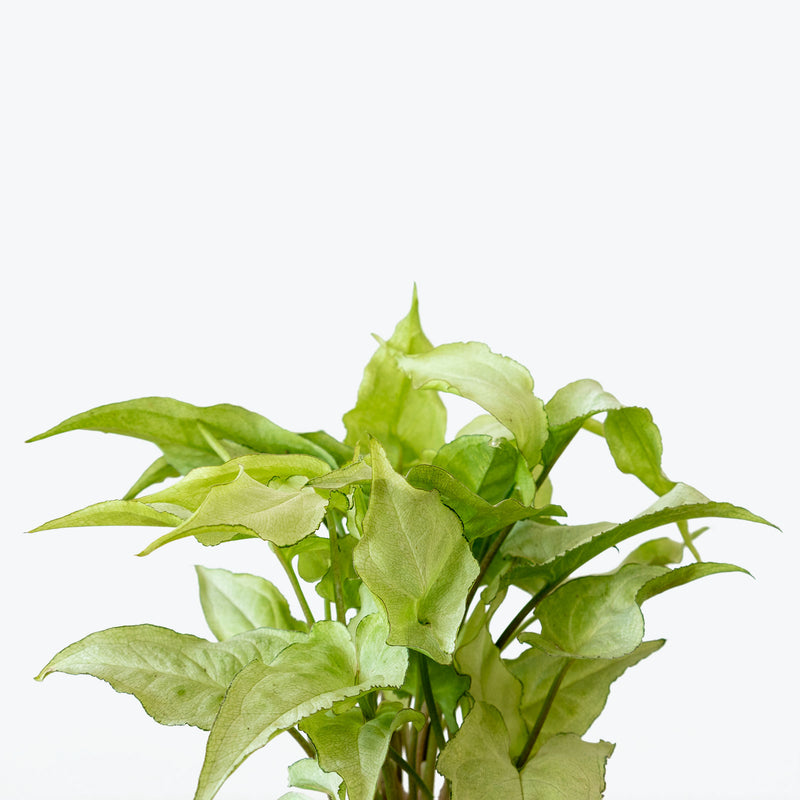
How to care for Syngonium Holly
They should not be in a position to see the sun directly, although early morning or late evening sun is fine. Filtered sunlight through a sheer curtain is best and most homes are comprised primarily of indirect sunlight. The best spot for them is where they do not see the sun during the majority of the day but still get bright, indirect light.
They will thrive in medium to bright light, but also can tolerate low light. A good medium-light place in your home would be in the middle of a room that has a regular size window. They can be placed almost anywhere in the room but remember, plants will grow based on how much light they receive.
They need to be watered when the top half of the soil is dry to the touch. That usually takes about 1 week in an average home environment. It will vary depending on the time of year, your environment and lighting conditions, but it's always safer to underwater or give the soil a check before you water again. Expect to water more often in brighter light and less often in lower light.
They can live in any average home humidity condition and are fairly hardy.
Syngonium is an aggressive, rapid-growing vine, so the frequency of repotting depends somewhat on how big you want the vine to get. Repot yearly for a larger vine. Otherwise, refresh potting media every spring and repot every other year.
This plant is moderately toxic and can cause some adverse reactions when ingested so it is best to not let your pets eat it, which we advise for all plants in general. The severity of the reaction will depend on how much of the plant is ingested but, if you know your pet typically does not eat your plants, this plant will be suitable for your home..
Learn MoreView PlantSyngonium Mango Allusion
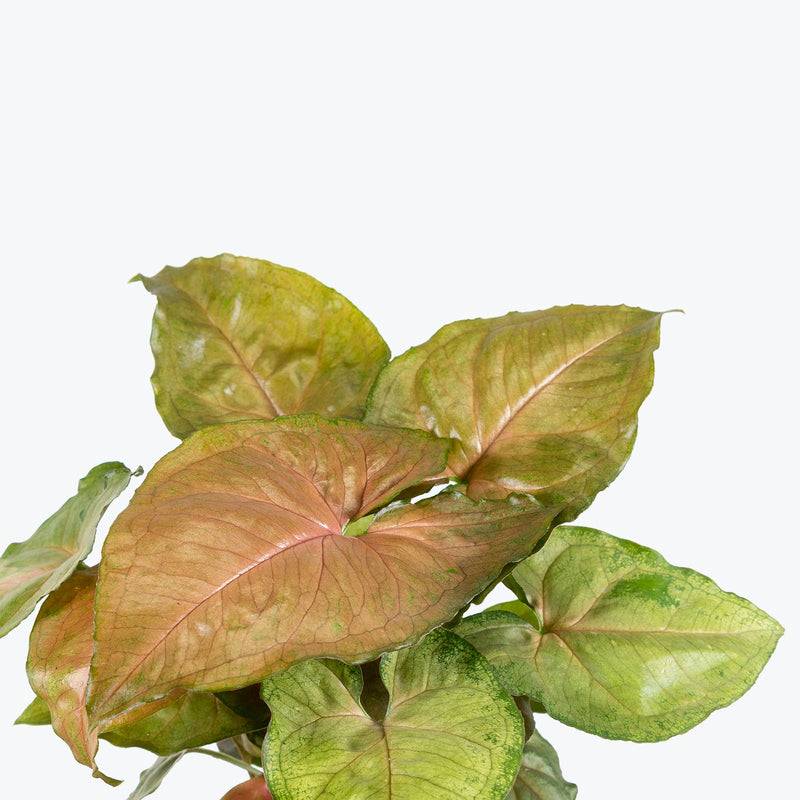
How to care for Syngonium Mango Allusion
They should not be in a position to see the sun directly, although early morning or late evening sun is fine. Filtered sunlight through a sheer curtain is best and most homes are comprised primarily of indirect sunlight. The best spot for them is where they do not see the sun during the majority of the day but still get bright, indirect light.
They will do well in medium light but will grow faster with brighter light. A good medium-light place in your home would be in the middle of a room that has a regular size window. Remember that plants will grow based on how much light they receive.
They need to be watered when the top half of the soil is dry to the touch. That usually takes about 1 week in an average home environment. It will vary depending on the time of year, your environment and lighting conditions, but it's always safer to underwater or give the soil a check before you water again. Expect to water more often in brighter light and less often in lower light.
They can live in any average home humidity condition and are fairly hardy.
Syngonium are aggressive, rapid-growing vines, so the frequency of repotting depends somewhat on how big you want the plant to get. Check yearly for a larger vine to see if it needs to be repotted. Otherwise, refresh potting media every spring and repot every other year.
This plant is moderately toxic and can cause some adverse reactions when ingested so it is best to not let your pets eat it, which we advise for all plants in general. The severity of the reaction will depend on how much of the plant is ingested but, if you know your pet typically does not eat your plants, this plant will be suitable for your home..
Learn MoreView PlantSyngonium Milk Confetti
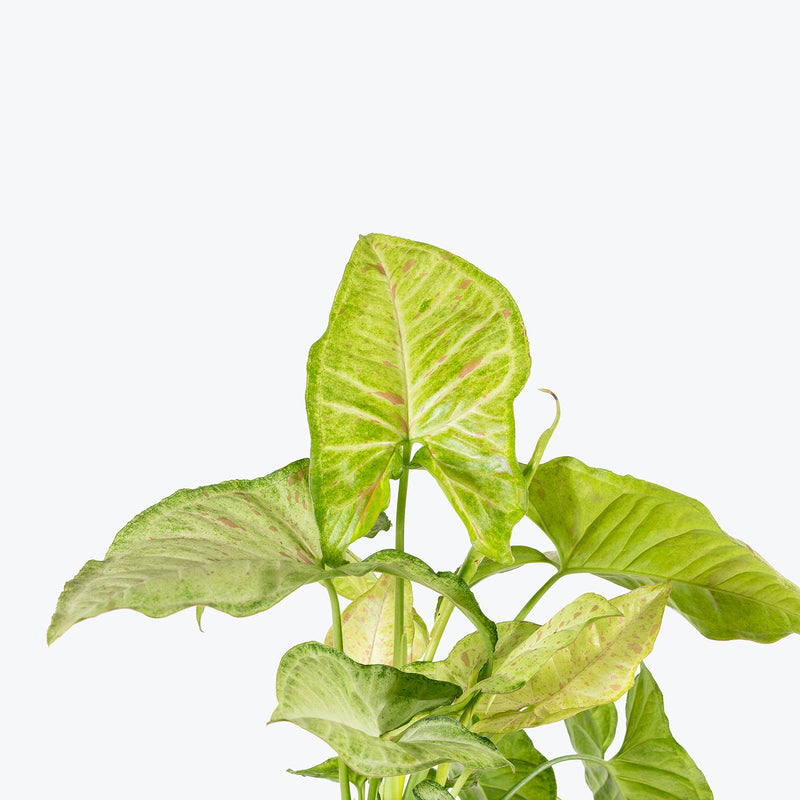
How to care for Syngonium Milk Confetti
Syngonium Milk Confetti should not be in a position to see the sun directly, although early morning or late evening sun is fine. Filtered sunlight through a sheer curtain is best and most homes are comprised primarily of indirect sunlight. The best spot for them is where they do not see the sun during the majority of the day but still get bright, indirect light.
Syngonium Milk Confetti will thrive in medium to bright light, but also can tolerate low light. A good medium-light place in your home would be in the middle of a room that has a regular size window. They can be placed almost anywhere in the room but remember, plants will grow based on how much light they receive.
Syngonium Milk Confetti needs to be watered when the top half of the soil is dry to the touch. That usually takes about 1 week in an average home environment. It will vary depending on the time of year, your environment and lighting conditions, but it's always safer to under water or give the soil a check before you water again. Expect to water more often in brighter light and less often in lower light.
Syngonium Milk Confetti can live in any average home humidity condition and are fairly hardy.
Syngonium Milk Confetti is an aggressive, rapid-growing vine, so the frequency of repotting depends somewhat on how big you want the vine to get. Repot yearly for a larger vine. Otherwise, refresh potting media every spring and repot every other year. Prune regularly to control growth and encourage a bushier appearance if the plant becomes too leggy. Provide a support like a small trellis or moss pole if you prefer a more vertical growth pattern.
Syngonium Milk Confetti is moderately toxic and can cause some adverse reactions when ingested so it is best to not let your pets eat it, which we advise for all plants in general. The severity of the reaction will depend on how much of the plant is ingested but, if you know your pet typically does not eat your plants, this plant will be suitable for your home..
Learn MoreView PlantSyngonium Moonlight
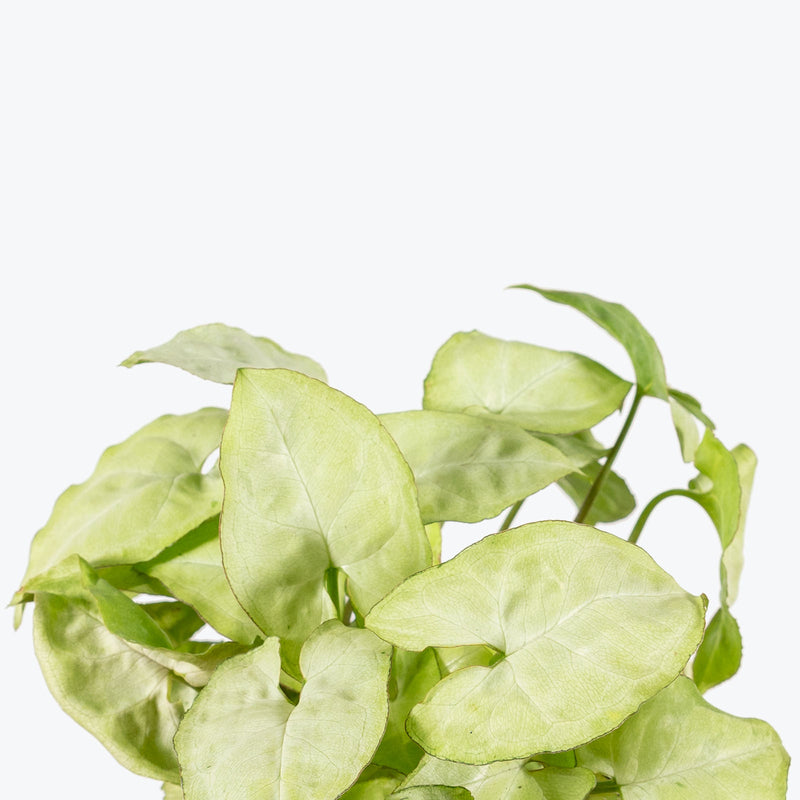
How to care for Syngonium Moonlight
They should not be in a position to see the sun directly, although early morning or late evening sun is fine. Filtered sunlight through a sheer curtain is best and most homes are comprised primarily of indirect sunlight. The best spot for them is where they do not see the sun during the majority of the day but still get bright, indirect light.
They will thrive in medium to bright light, but also can tolerate low light. A good medium-light place in your home would be in the middle of a room that has a regular size window. They can be placed almost anywhere in the room but remember, plants will grow based on how much light they receive.
They need to be watered when the top half of the soil is dry to the touch. That usually takes about 1 week in an average home environment. It will vary depending on the time of year, your environment and lighting conditions, but it's always safer to underwater or give the soil a check before you water again. Expect to water more often in brighter light and less often in lower light.
They can live in any average home humidity condition and are fairly hardy.
Syngonium is an aggressive, rapid-growing vine, so the frequency of repotting depends somewhat on how big you want the vine to get. Repot yearly for a larger vine. Otherwise, refresh potting media every spring and repot every other year.
This plant is moderately toxic and can cause some adverse reactions when ingested so it is best to not let your pets eat it, which we advise for all plants in general. The severity of the reaction will depend on how much of the plant is ingested but, if you know your pet typically does not eat your plants, this plant will be suitable for your home..
Learn MoreView PlantSyngonium Neon
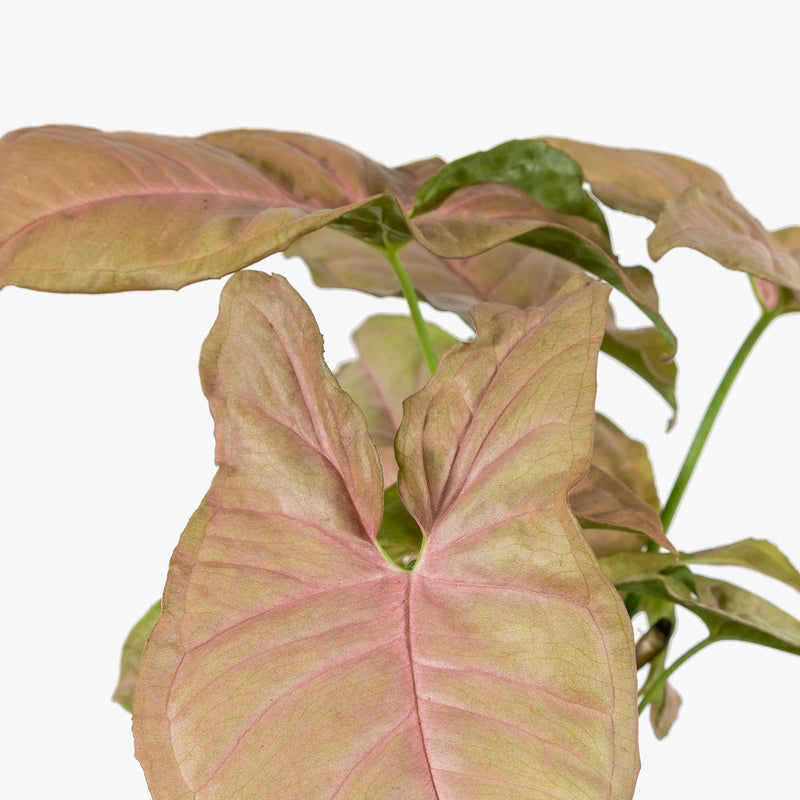
How to care for Syngonium Neon
They should not be in a position to see the sun directly, although early morning or late evening sun is fine. Filtered sunlight through a sheer curtain is best and most homes are comprised primarily of indirect sunlight. The best spot for them is where they do not see the sun during the majority of the day but still get bright, indirect light.
They will do well in medium light but will grow faster with brighter light. A good medium-light place in your home would be in the middle of a room that has a regular size window. Remember that plants will grow based on how much light they receive.
They need to be watered when the top half of the soil is dry to the touch. That usually takes about 1 week in an average home environment. It will vary depending on the time of year, your environment and lighting conditions, but it's always safer to underwater or give the soil a check before you water again. Expect to water more often in brighter light and less often in lower light.
They can live in any average home humidity condition and are fairly hardy.
Syngonium are aggressive, rapid-growing vines, so the frequency of repotting depends somewhat on how big you want the plant to get. Repot yearly for a larger vine. Otherwise, refresh potting media every spring and repot every other year.
This plant is moderately toxic and can cause some adverse reactions when ingested so it is best to not let your pets eat it, which we advise for all plants in general. The severity of the reaction will depend on how much of the plant is ingested but, if you know your pet typically does not eat your plants, this plant will be suitable for your home..
Learn MoreView PlantSyngonium Pink Perfection
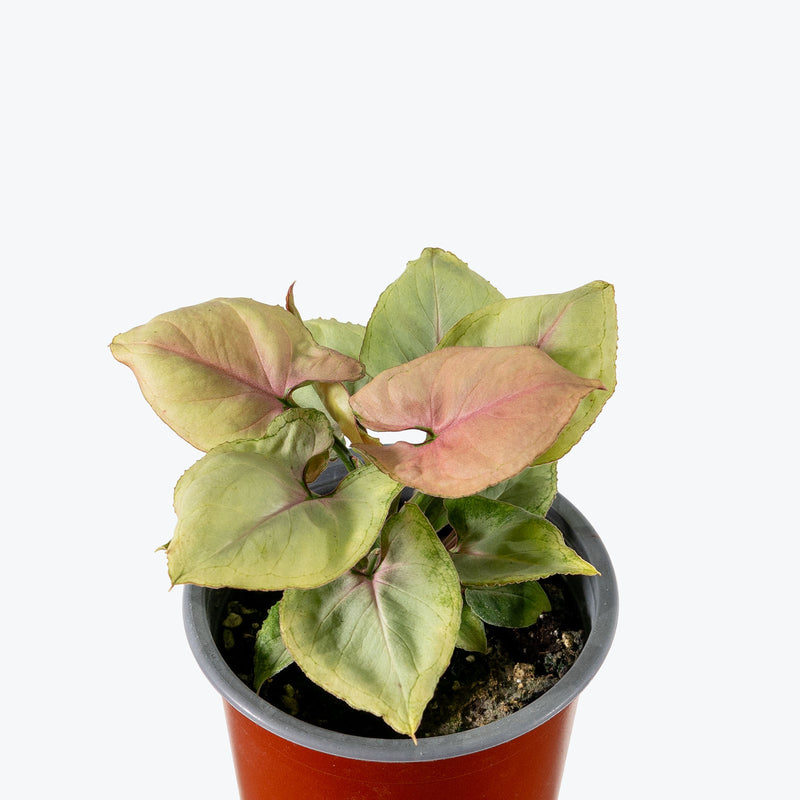
How to care for Syngonium Pink Perfection
Syngonium Pink Perfection should not be in a position to see the sun directly, although early morning or late evening sun is fine. Filtered sunlight through a sheer curtain is best and most homes are comprised primarily of indirect sunlight. The best spot for them is where they do not see the sun during the majority of the day but still get bright, indirect light.
Syngonium Pink Perfection will thrive in bright light, but also can tolerate medium light. A good medium-light place in your home would be in the middle of a room that has a regular size window. They can be placed anywhere between the middle of the room and the window. Remember that plants will grow based on how much light they receive.
Syngonium Pink Perfection needs to be watered when the top half of the soil is dry to the touch. That usually takes about 1 week in an average home environment. It will vary depending on the time of year, your environment and lighting conditions, but it's always safer to underwater or give the soil a check before you water again. Expect to water more often in brighter light and less often in lower light.
Syngonium Pink Perfection can live in any average home humidity condition and are fairly hardy.
Syngonium Pink Perfection is an aggressive, rapid-growing vine, so the frequency of repotting depends somewhat on how big you want the vine to get. Regularly clean the leaves with a damp cloth to remove dust and enhance the plant’s health and appearance. Trim back any leggy growth to encourage a bushier appearance and more vibrant foliage.
Syngonium Pink Perfection is moderately toxic and can cause some adverse reactions when ingested so it is best to not let your pets eat it, which we advise for all plants in general. The severity of the reaction will depend on how much of the plant is ingested but, if you know your pet typically does not eat your plants, this plant will be suitable for your home..
Learn MoreView PlantSyngonium Pink Splash
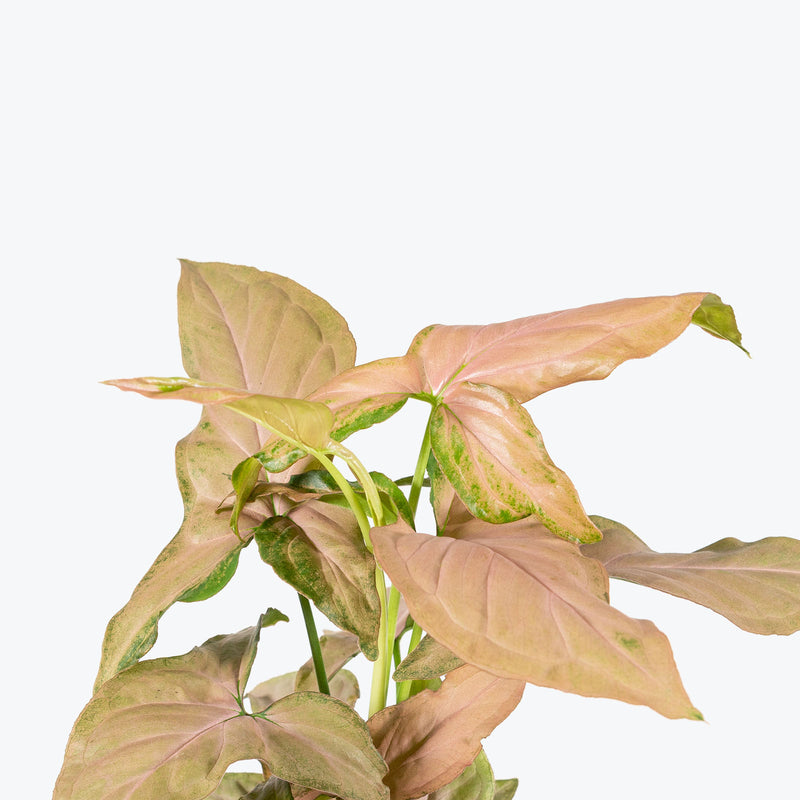
How to care for Syngonium Pink Splash
They should not be in a position to see the sun directly, although early morning or late evening sun is fine. Filtered sunlight through a sheer curtain is best and most homes are comprised primarily of indirect sunlight. The best spot for them is where they do not see the sun during the majority of the day but still get bright, indirect light.
They will thrive in medium to bright light, but also can tolerate low light. A good medium-light place in your home would be in the middle of a room that has a regular size window. They can be placed almost anywhere in the room but remember, plants will grow based on how much light they receive.
They need to be watered when the top half of the soil is dry to the touch. That usually takes about 1 week in an average home environment. It will vary depending on the time of year, your environment and lighting conditions, but it's always safer to underwater or give the soil a check before you water again. Expect to water more often in brighter light and less often in lower light.
They can live in any average home humidity condition and are fairly hardy.
Syngonium is an aggressive, rapid-growing vine, so the frequency of repotting depends somewhat on how big you want the vine to get. Repot yearly for a larger vine. Otherwise, refresh potting media every spring and repot every other year.
This plant is moderately toxic and can cause some adverse reactions when ingested so it is best to not let your pets eat it, which we advise for all plants in general. The severity of the reaction will depend on how much of the plant is ingested but, if you know your pet typically does not eat your plants, this plant will be suitable for your home..
Learn MoreView PlantSyngonium Pixie
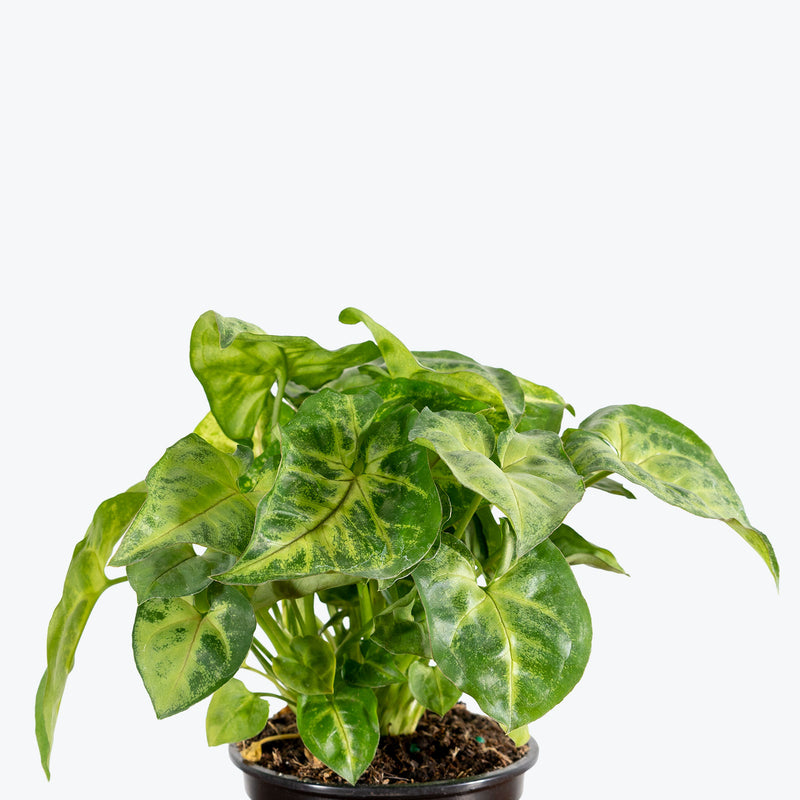
How to care for Syngonium Pixie
They should not be in a position to see the sun directly, although early morning or late evening sun is fine. Filtered sunlight through a sheer curtain is best and most homes are comprised primarily of indirect sunlight. The best spot for them is where they do not see the sun during the majority of the day but still get bright, indirect light.
They will thrive in medium to bright light, but also can tolerate low light. A good medium-light place in your home would be in the middle of a room that has a regular size window. They can be placed almost anywhere in the room but remember, plants will grow based on how much light they receive.
They need to be watered when the top half of the soil is dry to the touch. That usually takes about 1 week in an average home environment. It will vary depending on the time of year, your environment and lighting conditions, but it's always safer to underwater or give the soil a check before you water again. Expect to water more often in brighter light and less often in lower light.
They can live in any average home humidity condition and are fairly hardy.
Syngonium is an aggressive, rapid-growing vine, so the frequency of repotting depends somewhat on how big you want the vine to get. Repot yearly for a larger vine. Otherwise, refresh potting media every spring and repot every other year.
This plant is moderately toxic and can cause some adverse reactions when ingested so it is best to not let your pets eat it, which we advise for all plants in general. The severity of the reaction will depend on how much of the plant is ingested but, if you know your pet typically does not eat your plants, this plant will be suitable for your home..
Learn MoreView PlantSyngonium Randy
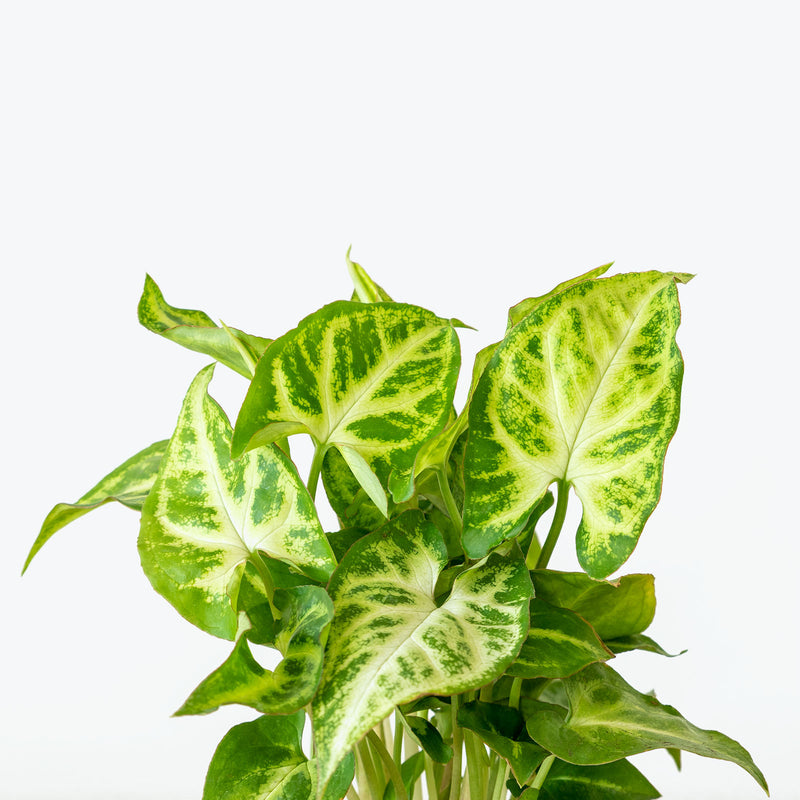
How to care for Syngonium Randy
They should not be in a position to see the sun directly, although early morning or late evening sun is fine. Filtered sunlight through a sheer curtain is best and most homes are comprised primarily of indirect sunlight. The best spot for them is where they do not see the sun during the majority of the day but still get bright, indirect light.
They will thrive in medium to bright light, but also can tolerate low light. A good medium-light place in your home would be in the middle of a room that has a regular size window. They can be placed almost anywhere in the room but remember, plants will grow based on how much light they receive.
They need to be watered when the top half of the soil is dry to the touch. That usually takes about 1 week in an average home environment. It will vary depending on the time of year, your environment and lighting conditions, but it's always safer to underwater or give the soil a check before you water again. Expect to water more often in brighter light and less often in lower light.
They can live in any average home humidity condition and are fairly hardy.
Syngonium is an aggressive, rapid-growing vine, so the frequency of repotting depends somewhat on how big you want the vine to get. Repot yearly for a larger vine. Otherwise, refresh potting media every spring and repot every other year.
This plant is moderately toxic and can cause some adverse reactions when ingested so it is best to not let your pets eat it, which we advise for all plants in general. The severity of the reaction will depend on how much of the plant is ingested but, if you know your pet typically does not eat your plants, this plant will be suitable for your home..
Learn MoreView PlantSyngonium Red Arrow
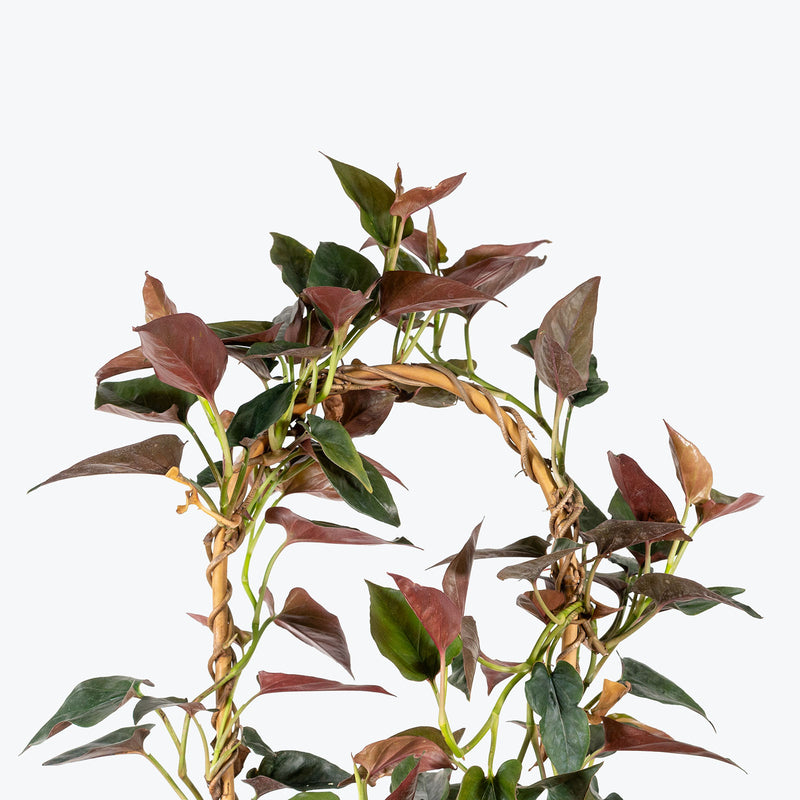
How to care for Syngonium Red Arrow
Syngonium Red Arrow should not be in a position to see the sun directly, although early morning or late evening sun is fine. Filtered sunlight through a sheer curtain is best and most homes are comprised primarily of indirect sunlight. The best spot for them is where they do not see the sun during the majority of the day but still get bright, indirect light.
Syngonium Red Arrow will do well in medium light but will grow faster with brighter light. A good medium-light place in your home would be in the middle of a room that has a regular size window. Remember that plants will grow based on how much light they receive.
Syngonium Red Arrow needs to be watered when the top half of the soil is dry to the touch. That usually takes about 1 week in an average home environment. It will vary depending on the time of year, your environment and lighting conditions, but it's always safer to underwater or give the soil a check before you water again. Expect to water more often in brighter light and less often in lower light.
Syngonium Red Arrow can live in any average home humidity condition and are fairly hardy.
Avoid putting Syngonium Red Arrow in direct sunlight, as too much direct sunlight will scorch the leaves, while shade will result in leggy growth and discolouration. Having it placed in bright or medium, indirect light is perfect. The easiest way to propagate Syngonium is through stem cuttings. You can use this method in spring or early summer when the plant is actively growing. Also, if you're pruning your Syngonium, try saving the stems for propagation.
Syngonium Red Arrow is moderately toxic and can cause some adverse reactions when ingested so it is best to not let your pets eat it, which we advise for all plants in general. The severity of the reaction will depend on how much of the plant is ingested but, if you know your pet typically does not eat your plants, this plant will be suitable for your home..
Learn MoreView PlantSyngonium Strawberry Cream
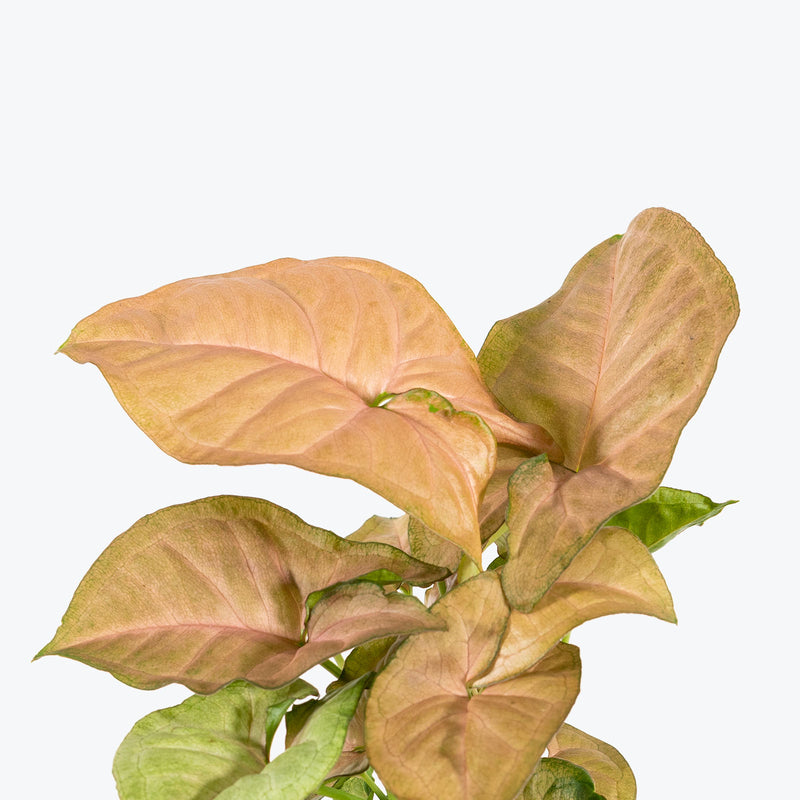
How to care for Syngonium Strawberry Cream
They should not be in a position to see the sun directly, although early morning or late evening sun is fine. Filtered sunlight through a sheer curtain is best and most homes are comprised primarily of indirect sunlight. The best spot for them is where they do not see the sun during the majority of the day but still get bright, indirect light.
They will do well in medium light but will grow faster, with better colouring, in brighter light. A good medium-light place in your home would be in the middle of a room that has a regular size window. Remember that plants will grow based on how much light they receive.
They need to be watered when the top half of the soil is dry to the touch. That usually takes about 1 week in an average home environment. It will vary depending on the time of year, your environment and lighting conditions, but it's always safer to underwater or give the soil a check before you water again. Expect to water more often in brighter light and less often in lower light.
They can live in any average home humidity condition and are fairly hardy.
Syngonium are aggressive, rapid-growing vines, so the frequency of repotting depends somewhat on how big you want the plant to get. Repot yearly for a larger vine. Otherwise, refresh potting media every spring and repot every other year.
This plant is moderately toxic and can cause some adverse reactions when ingested so it is best to not let your pets eat it, which we advise for all plants in general. The severity of the reaction will depend on how much of the plant is ingested but, if you know your pet typically does not eat your plants, this plant will be suitable for your home..
Learn MoreView PlantSyngonium Three Kings
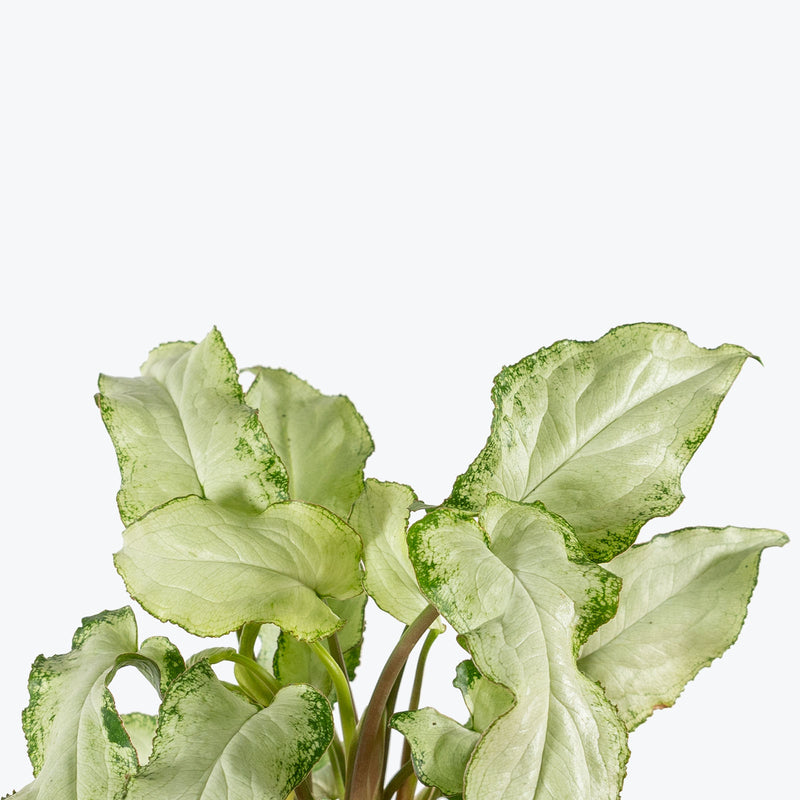
How to care for Syngonium Three Kings
Syngonium Three Kings should not be in a position to see the sun directly, although early morning or late evening sun is fine. Filtered sunlight through a sheer curtain is best and most homes are comprised primarily of indirect sunlight. The best spot for them is where they do not see the sun during the majority of the day but still get bright, indirect light.
Syngonium Three Kings will thrive in bright light, but also can tolerate medium light. A good medium-light place in your home would be in the middle of a room that has a regular size window. They can be placed anywhere between the middle of the room and the window. Remember that plants will grow based on how much light they receive.
Syngonium Three Kings needs to be watered when the top half of the soil is dry to the touch. That usually takes about 1 week in an average home environment. It will vary depending on the time of year, your environment and lighting conditions, but it's always safer to underwater or give the soil a check before you water again. Expect to water more often in brighter light and less often in lower light.
Syngonium Three Kings will do well in average humidity environments but will appreciate a little bit of humidity if provided, give them a mist daily or get a humidifier.
Fertilize Syngonium Three Kings every 4-6 weeks during the growing season with a diluted, balanced liquid fertilizer. Reduce feeding in the winter months. Regular pruning can help maintain a bushy appearance and encourage more vigorous growth. Clean the leaves periodically to remove dust and enhance the plant's ability to photosynthesize effectively.
Syngonium Three Kings is moderately toxic and can cause some adverse reactions when ingested so it is best to not let your pets eat it, which we advise for all plants in general. The severity of the reaction will depend on how much of the plant is ingested but, if you know your pet typically does not eat your plants, this plant will be suitable for your home..
Learn MoreView PlantSyngonium Wendlandii
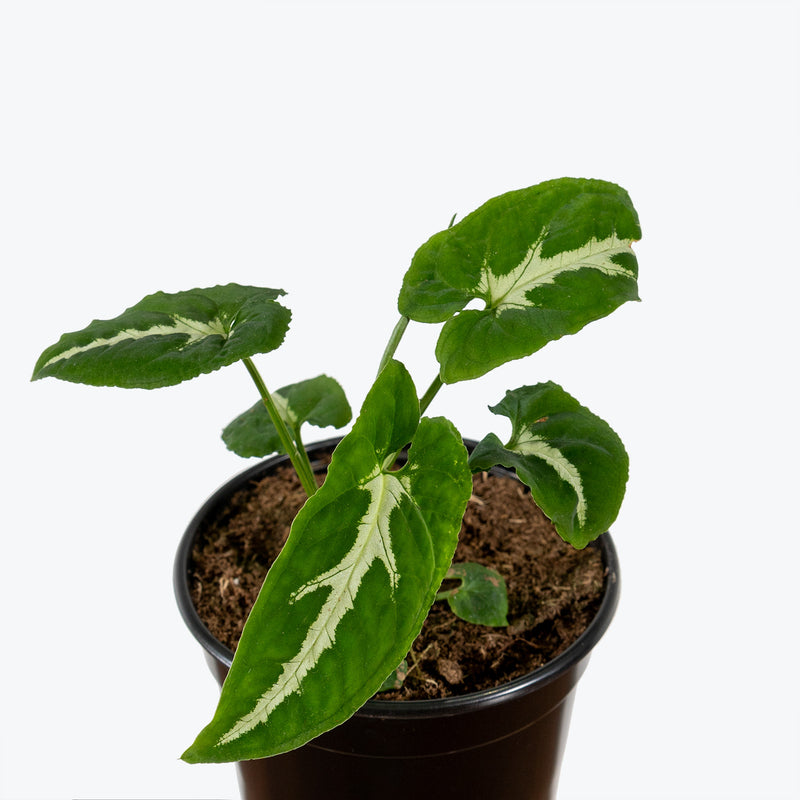
How to care for Syngonium Wendlandii
They should not be in a position to see the sun directly, although early morning or late evening sun is fine. Filtered sunlight through a sheer curtain is best and most homes are comprised primarily of indirect sunlight. The best spot for them is where they do not see the sun during the majority of the day but still get bright, indirect light.
They will do well in medium light but will grow faster with brighter light. A good medium-light place in your home would be in the middle of a room that has a regular size window. Remember that plants will grow based on how much light they receive.
They need to be watered when the top half of the soil is dry to the touch. That usually takes about 1 week in an average home environment. It will vary depending on the time of year, your environment and lighting conditions, but it's always safer to underwater or give the soil a check before you water again. Expect to water more often in brighter light and less often in lower light.
They can live in any average home humidity condition and are fairly hardy.
Syngonium are often aggressive, rapid-growing vines, so the frequency of repotting depends somewhat on how big you want the plant to get. Repot yearly for a larger vine. Otherwise, refresh potting media every spring and repot every other year.
This plant is moderately toxic and can cause some adverse reactions when ingested so it is best to not let your pets eat it, which we advise for all plants in general. The severity of the reaction will depend on how much of the plant is ingested but, if you know your pet typically does not eat your plants, this plant will be suitable for your home..
Learn MoreView PlantSyngonium White Butterfly
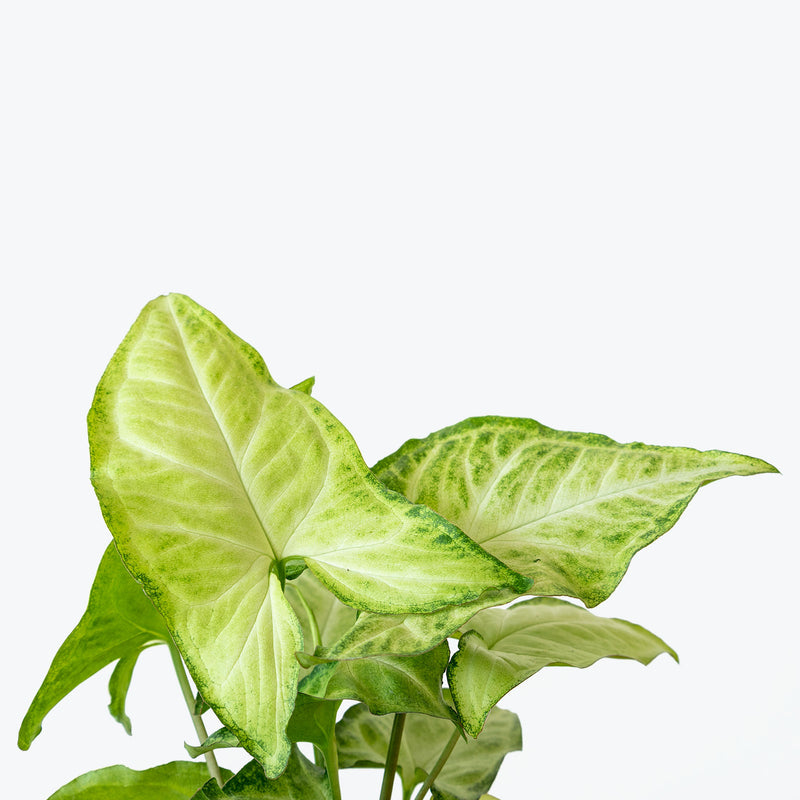
How to care for Syngonium White Butterfly
They should not be in a position to see the sun directly, although early morning or late evening sun is fine. Filtered sunlight through a sheer curtain is best and most homes are comprised primarily of indirect sunlight. The best spot for them is where they do not see the sun during the majority of the day but still get bright, indirect light.
They will thrive in medium to bright light, but also can tolerate low light. A good medium-light place in your home would be in the middle of a room that has a regular size window. They can be placed almost anywhere in the room but remember, plants will grow based on how much light they receive.
They need to be watered when the top half of the soil is dry to the touch. That usually takes about 1 week in an average home environment. It will vary depending on the time of year, your environment and lighting conditions, but it's always safer to underwater or give the soil a check before you water again. Expect to water more often in brighter light and less often in lower light.
They can live in any average home humidity condition and are fairly hardy.
Syngonium is an aggressive, rapid-growing vine, so the frequency of repotting depends somewhat on how big you want the vine to get. Repot yearly for a larger vine. Otherwise, refresh potting media every spring and repot every other year.
This plant is moderately toxic and can cause some adverse reactions when ingested so it is best to not let your pets eat it, which we advise for all plants in general. The severity of the reaction will depend on how much of the plant is ingested but, if you know your pet typically does not eat your plants, this plant will be suitable for your home..
Learn MoreView Plant



